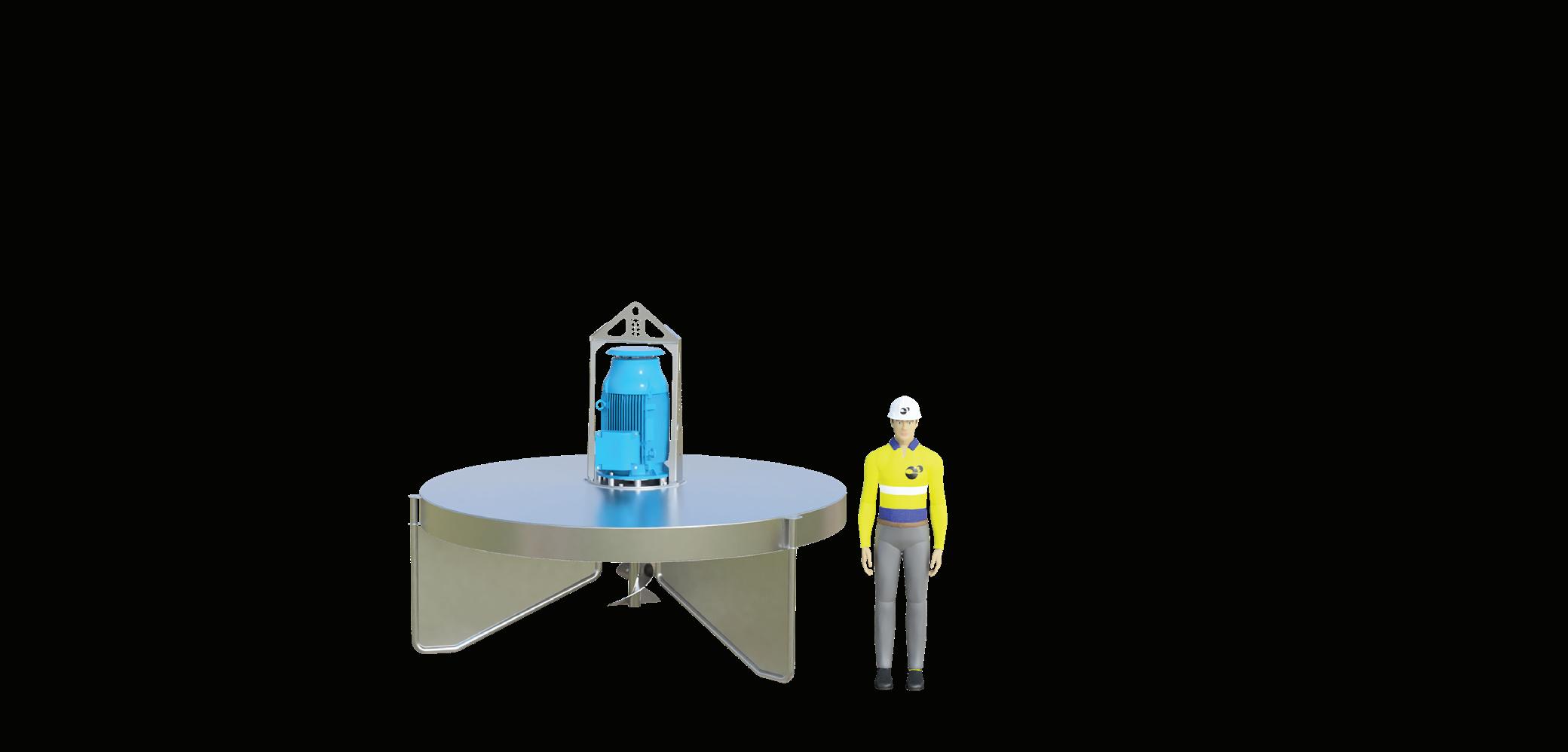

Building a better environment
Improving flood resilience and stormwater treatment
Future proofing pipes, water treatment and wastewater plants
Protecting and healing our lakes
PLUS: 10th IWA-ASPIRE and Water New Zealand Conference & Expo 2025 preview




President: Tim Gibson
Board Members: Bruce Balaei, Tim Gibson, David Hogg, Lorraine Kendrick, Paddy McNamara, Soltice Morrison, Suzanne Naylor, Priyan Perera
Chief Executive: Gillian Blythe
Internal Events and Logistics Co-ordinator: Katrina Guy
Corporate and Membership Services
Manager: Mumtaz Parker
Membership Administrator/Office Manager: Pip Donnelly
Technical Lead – Regulatory and Catchments: Nicci Wood
Technical Lead – Projects and Sustainability: Lesley Smith
Technical lead – Drinking Water Quality and Education: Belinda Cridge
Communications Manager: Debra Harrington
Marketing Lead: Frances Sheriff
Executive Assistant to the CE and Association Secretary: Caroline Lewin
Accounts Administrator: Sweety Gangreddiwar
OUR SPECIAL INTEREST GROUPS
Backflow
Climate Change
Drinking Water Quality
Diversity, Equity and Inclusion
Smart Water Infrastructure
Modelling
Onsite Waste Water Management
Stormwater
Te Ama | Aukaha te Wai
Water Service Managers’ Group
Water Efficiency and Conservation Action Network (WeCan)
Wastewater
Young Water Professionals: Chapters in Auckland, Wellington and Christchurch.
For information contact: Katrina Guy 04 495 0891, email: Katrina.guy@waternz.org.nz
WATER JOURNAL
Editor: Mary Searle Bell, Contrafed Publishing
M: +64 21 676 034
Advertising Sales: Debbie Laing
M: +64 27 455 0223
Design: Jonathan Whittaker
M: +64 21 147 5591
Publishing: Contrafed Publishing, General Manager: David Penny, 1 Grange Road, Mount Eden, Auckland 1024
PO Box 67131, Mt Eden, Auckland, 1349
P: +64 21 190 4078
www.contrafed.co.nz
Distribution: Pip Donnelly, enquiries@waternz.org.nz
P: +64 4 472 8925
DISCLAIMER: Water New Zealand reserves the right to accept or reject any editorial or advertising material submitted for publication. The opinions expressed in contributions to Water are not necessarily those of Water New Zealand. The information contained in this publication is given in good faith and has been derived from sources believed to be reliable and accurate. However, neither Water New Zealand, nor any person(s) involved in the preparation of this publication accept any form of liability whatsoever for its content including advertisements, editorials, opinions, advice or information. This extends to any consequences from its use. No part of this publication may be reproduced, stored in any retrieval system, or transmitted in any form or by any means electronic, mechanical, photocopying, recording or ink–jet printing without prior written permission of the publishers.
ISSN 1179-2949 (Print)
ISSN 2382-1906 (Online)
www.waternz.org.nz

INSIDE
04 President’s comment
06 Water New Zealand’s submission on Government reform and legislation
14 Building a more resilient workforce
15 Celebrating 50 years of Māori Language Week
18 Building a circular and regenerative future for wastewater
20 Conference champion Marion Savill
22 Conference keynote speakers
28 Insights from the UK Flood and Coast 2025 Conference
CASE STUDIES AND COMMENT PIECES
46 Legal update
60 How to future-proof water treatment plants: Transitioning to a 50-year planning horizon
72 Eastland Port industrial stormwater innovation
94 Three types of drought, and why there’s no such thing as a global water crisis
102 Renewed focus on protecting marine systems
106 Better together: How relationships can transform infrastructure delivery
108 Turning the tide: smarter procurement for the water sector

FEATURES
32 Profile: Sarah Nolan
34 Profile: David Romilly
42 Water works: Tracing investment over time
48 Preparing for emergencies deep underground
58 Award-winning topsoil project redefines treatment waste as a circular asset
62 Inside Sydney Water’s capital works momentum
68 AI in the water sector: opportunities, challenges and what comes next
76 From Ahr Valley to Esk Valley: Lessons in water resilience
80 Moving forward to improve flood resilience in Wairau
92 Experts highlight challenges and priorities for restoring Waikato lakes
104 Ancient sea creature’s DNA links oceans around the world
114 Stalagmites reveal duration and severity of drought during the Maya collapse
122 Recycling water in space
124 Are drug-resistant bugs in the water?
126 Is mineral water ‘natural’ if it’s filtered?
132 Why increased demand for supply and water efficiency forces a rethink on pipeline condition assessment
128 Driving a step change in drinking water safety 32 48 114 106 126


‘Ka ora





A new phase of water service delivery has begun
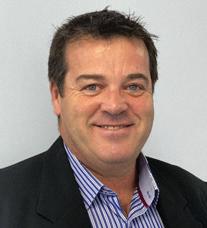
Gibson President Water New Zealand
This publication went into production as we were hitting the deadline for councils to submit their Water Services Delivery Plans. The plans form a blueprint of how councils will deliver drinking water, wastewater, and stormwater services in a financially sustainable way while complying with new government regulations.
Delving into the plans will also provide the clearest picture yet of the state of our water assets and the long term costs of maintenance, renewals and meeting growth. Earlier estimates have varied widely – from $120 to $180 billion over the next 30 years, or, as former Local Government Minister Simeon Brown suggested, around $40 billion over the next decade.
For many ratepayers, the reality of the need to catch up with long overdue maintenance is now sinking in, as councils indicate massive rates rises.
In preparing their plans, councils have had to weigh up the costs, opportunities, and trade-offs of different delivery models. Many have chosen to collaborate with neighbouring councils.
But even for those that have been left on their own, either by choice or failure to find a willing partner, one thing is clear –business as usual is no longer an option. We have entered a new phase of water services delivery. The new entities will be subject to greater scrutiny and tougher regulatory requirements.
At this stage, we are looking at the creation of around 40 new organisations – far more than the government had originally envisaged. Over time, we can expect to see further amalgamations as councils work to balance compliance demands with customer expectations, or as a last resort, the government uses leverage to bring recalcitrant councils into line.
Strong governance and leadership will be key to ensuring the success of the new entities. Well-regulated, independently governed water companies will deliver better outcomes for both customers and communities.
Fortunately, our water sector has huge depth of expertise and capability, both within councils and across the wider supply chain. Yet often progress has been hampered by short-term thinking and weak regulation.
Local Water Done Well offers the opportunity to break that cycle by lifting our focus to long-term investment and future resilience. The framework is now in place. Access to funding through improved borrowing arrangements is available to new council controlled organisations (CCOs).
But the new regulatory environment can’t deliver results on its own. We need to move urgently to get contracts underway and build a long-term pipeline of investment and maintenance. Long term certainty is essential if we are to retain and grow the skills and expertise we need here in Aotearoa New Zealand.
Later this month, we’ll see our talent and expertise on full display at one of our most ambitious events yet – the 10th IWA-ASPIRE and Water New Zealand Conference & Expo 2025. For the first time, we are hosting a truly global water sector event here.
The programme is extensive, and if you attend only one event this year, make it this one. If you haven’t yet registered, I encourage you to explore the programme on our website –you’ll quickly see why this is a must-attend gathering.
This conference will be a platform for us to join with the international community around common themes and challenges, including climate change, resilience, flooding, water scarcity and quality.
We’ll be highlighting where we have special expertise and knowledge to share such as indigenous knowledge and approaches.
Ahead of the conference, our pre-conference symposium will unpack the detail of the Local Water Done Well reforms. With an impressive line-up of experts, this is the perfect chance to get up to speed on the legislation, the reform process, and what it means for you.
I look forward to seeing you there.
Ngā mihi nui.
Tim Gibson President
Tim



Empowering tomorrow – smart water solutions for resilient communities
Empowering tomorrow – smart water solutions for resilient communities
Empowering tomorrow – smart water solutions for resilient communities
Not registered yet? There’s still time, but be quick!
Empowering tomorrow – smart water solutions for resilient communities
Not registered yet? There’s still time, but be quick!
Not registered yet? There’s still time, but be quick!
Not registered yet? There’s still time, but be quick!
Water New Zealand is partnering with the International Water Association (IWA) to bring a truly international event to Aotearoa New Zealand. Don’t miss this unique opportunity to connect with leading water professionals, practitioners, scientists, and experts from throughout the country and around the world.
Water New Zealand is partnering with the International Water Association (IWA) to bring a truly international event to Aotearoa New Zealand. Don’t miss this unique opportunity to connect with leading water professionals, practitioners, scientists, and experts from throughout the country and around the world.
Water New Zealand is partnering with the International Water Association (IWA) to bring a truly international event to Aotearoa New Zealand. Don’t miss this unique opportunity to connect with leading water professionals, practitioners, scientists, and experts from throughout the country and around the world.
Water New Zealand is partnering with the International Water Association (IWA) to bring a truly international event to Aotearoa New Zealand. Don’t miss this unique opportunity to connect with leading water professionals, practitioners, scientists, and experts from throughout the country and around the world.
Join the conversation on the critical challenges we face here and globally –environmental sustainability, climate change, smart water solutions, infrastructure affordability, innovation, indigenous knowledge and more
Join the conversation on the critical challenges we face here and globally –environmental sustainability, climate change, smart water solutions, infrastructure affordability, innovation, indigenous knowledge and more
10th IWA-ASPIRE
Join the conversation on the critical challenges we face here and globally –environmental sustainability, climate change, smart water solutions, infrastructure affordability, innovation, indigenous knowledge and more
Find out more and register
Join the conversation on the critical challenges we face here and globally –environmental sustainability, climate change, smart water solutions, infrastructure affordability, innovation, indigenous knowledge and more
10th
Find out more and register www.waternzconference.org.nz www.iwaaspire2025.org
Find out more and register www.waternzconference.org.nz www.iwaaspire2025.org
www.waternzconference.org.nz www.iwaaspire2025.org
Find out more and register www.waternzconference.org.nz www.iwaaspire2025.org
Implementing Local Water Done Well –what you need to know
Implementing Local Water Done Well –what you need to know
Christchurch Ōtautahi
Implementing Local Water Done Well –what you need to know
Christchurch Ōtautahi 29 September–3October 2025
Implementing Local Water Done Well –what you need to know
29 September–3October 2025
Preconference symposium, Monday 29 September 2025
Preconference symposium, Monday 29 September 2025
29 September–3October 2025
Preconference symposium, Monday 29 September 2025
Preconference symposium, Monday 29 September 2025
29 September–3October
Are you a Council CEO or chief financial officer? Are y ou a potential director of a Water Services CCO? Or do you have a role in the water supply chain?
Are you a Council CEO or chief financial officer? Are y ou a potential director of a Water Services CCO? Or do you have a role in the water supply chain?
Are you a Council CEO or chief financial officer? Are y ou a potential director of a Water Services CCO? Or do you have a role in the water supply chain?
If so this is a must attend event – we’ll be shining a light on the decisions and issues that need to be addressed in the implementation phase.
Are you a Council CEO or chief financial officer? Are y ou a potential director of a Water Services CCO? Or do you have a role in the water supply chain?
If so this is a must attend event – we’ll be shining a light on the decisions and issues that need to be addressed in the implementation phase.
If so this is a must attend event – we’ll be shining a light on the decisions and issues that need to be addressed in the implementation phase.
If so this is a must attend event – we’ll be shining a light on the decisions and issues that need to be addressed in the implementation phase.
Find out more and register www.waternzconference.org.nz/preconference/
Find out more and register www.waternzconference.org.nz/preconference/
Find out more and register
Find out more and register www.waternzconference.org.nz/preconference/
www.waternzconference.org.nz/preconference/

Submissions on Government reform and legislation
As part of ongoing advice and advocacy on behalf of the water sector, Water New Zealand recently submitted feedback on three proposed changes to legislation and policies that will impact the environment, infrastructure and vocational education and training.
RM(Consenting and Other system Changes) Amendment Act
The Resource Management (Consenting and Other System Changes) Amendment Act 2024 received Royal Ascent in August. Significant changes after the committee report back, include pausing council plan and policy development until 2027, expanding permitted water discharge rules under Section 70 of the RMA if councils can show ongoing water quality improvement, and removing the need to consider floatable or suspended materials for permitted activities.
The Bill also increases housing capacity around Auckland’s City Rail Link.
Read further comments in Helen Atkins’ column on page 46.
National Direction packages
The consultation centres on three packages: infrastructure and development, the primary sector, and freshwater. The Ministry of Housing and Urban Development and the Ministry for the Environment also consulted on Going for Housing Growth policy proposals (the ‘fourth’ package).
The breadth of changes proposed represent not merely a technical recalibration but a serious shift in direction. Water service delivery is closely connected to many areas of national policy and direction and it is disappointing and concerning that the sector has not been properly acknowledged.
We are also concerned about the potential effect on freshwater quality through the proposed amendments to the national direction under the RMA. The national direction informs how councils develop and implement local plans and rules. As a result, we have recommended:
• The government halt new or revised national direction work until the replacement legislation is in place.
• We do not support the proposal to rebalance freshwater policy including removing the Te Mana o te Wai framework and the hierarchy of obligations.
• We recommend a national spatial planning approach features more strongly in the national direction instruments- particularly the NPS-Infrastructure.
• A National Environmental Standard for Water Infrastructure should be considered.
• Clearer national direction, whose policies are well integrated, consistent and aligned.
Draft National Infrastructure Plan
Te Waihanga – The Infrastructure Commission prepared a thorough, detailed draft plan, which we generally support.
We endorse the plan’s recognition of the need to continue maintaining and renewing existing assets as well as investing in new or improved assets.
However, the plan lacks specific guidance on its implementation. We also have concerns that the plan alone will not address the underlying causes, infrastructure deficits, or process deficiencies contributing to the infrastructure shortfall and efficiency gap (amount invested versus infrastructure delivered).
Vocational and training select committee submission
We believe the proposed reforms to vocational education and training system (VET) present both risks and opportunities to the water sector. We have six recommendations:
1. Permit capable work-based learning divisions, such as Connexis, to transition directly to industry-owned Private Training Establishments (PTEs) in a single step, avoiding the proposed two-step process through Industry Skills Boards (ISBs). This will minimise disruption and maintain operational continuity for water sector training.
2. We support the establishment of an ISB focused on infrastructure which must preserve successful infrastructure training models, support workforce planning, enable cross-subsidisation of specialised water sector programmes and support national consistency in qualifications.
3. Restore the requirement for the Tertiary Education Commission (TEC) to ‘give effect’ to ISB advice, rather than merely ‘have regard’ to it, ensuring industry priorities are reflected in training investment decisions.
4. Ensure financial viability for all providers, including ‘by Māori, for Māori’ organisations, through flexible and sustainable funding models that support high-cost, low-volume training in niche infrastructure fields, maintaining learner flexibility and equitable access.
5. Preserve and adequately fund existing effective standards-setting arrangements, such as Vocational Engineering Education, New Zealand (VEE.NZ), and support robust, transparent monitoring and evaluation processes relevant to water sector training outcomes.
6. Provide clear, sustainable funding frameworks that protect highcost, low-volume training essential to water sector capability, including clarification of levy collection and application processes to reduce uncertainty for employers.
You can read more about these and earlier key submissions section of our website www.waternz.org.nz.


Local Water Done Well, a journey of consistent improvement
Headline to go here
By Nicci Wood, technical
lead, regulatory and catchments, Water New
Zealand
The Local Government (Water Services) Bill, fondly referred to as Bill Three, was passed in August, structured in two:
Box copy to go here
• Local Government (Water Services) Act 2024 (Parts 1 to 4 and 6, and Schedules 1 to 4 of Bill 3),
• Local Government (Water Services) (Repeals and Amendments) Act 2024 (Part 5 and Schedules 5 to 12 of Bill 3).
In July the Finance and Expenditure Committee report on Bill Three proposed more than 360 amendments. Most were technical in nature but also changes improving the workability of the legislation. We were pleased that many of our submission’s recommendations were included in the amendments.
Enactment provides water service providers certainty and enables regulators to begin fulfilling their obligations.
• Decisions are currently underway on future service delivery models that will rationalise around 65 delivery entities to around 40.
• In September, as well as Water Service Delivery Plans being submitted, work on a host of new regulatory requirements and standards is expected. The Commerce Commission’s information disclosure (draft determination) and national environmental standards for wastewater are expected first up.
• The implementation of Water Services Delivery Plans may see an enormous uplift in capital expenditure from 2026 onwards.
Our technical team is proactively identifying opportunities where we can provide consistent guidance and practices to support Local Water Done Well implementation, including the associated regulatory regime.
Collaborate, connect and lead change
An explanation of Water New Zealand’s Special Interest Groups (SIGs)
Water New Zealand Special Interest Groups bring together professionals working across specialist areas of water services delivery. They provide a vehicle for members to extend their network and collaborate to advance their specialist topic or topic of interest.
This article outlines how the Special Interest Groups work and how members can get involved.
We have 11 groups now operating, shown in the graphic. Each of these groups has been initiated by members and subsequently supported by our board. Each group is organised slightly differently and offer a range of options to get involved.
Who is involved in SIGs
The groups are driven by a committee of up to 15 members, with a chair and sometimes a co-chair or deputy providing direction. Many of the committees draw in contributions from a wider network, hosting workstreams led by a subgroup or work groups – known as friends of committee, or Ropū Manaaki.
They also have access to a wider mailing list of members, who are registered to receive updates and newsletters from the SIGs. Members can opt in to receive these notifications, when logged into your members directory.
What SIGs do
Objectives and activities to achieve them are determined by committees. There are several platforms and resources that can be used to support delivery. Typical activities include:
• Knowledge Sharing for example, through this journal, the Water New Zealand podcast ‘Tāwara o te Wai’, e-newsletter Pipeline, and SIG newsletters.
• Events, including both in-person, such as regional meetings, conference workshops and symposia, and online events and workshops.
• Development of technical resources, such as training material, standards working groups, and sector guidelines.
• Advocacy contributing to submissions or direct engagement with policy makers, issuing press releases or thought pieces for the public.
How the SIGs operate
Guided by terms of reference, their objectives and actions are determined by the committee.

Via monthly online meetings committees convene to develop and deliver an annual programme, led by a chair. Water New Zealand appoint a staff member to support the SIG administration and operations. Our staff also provide a conduit to the rest of the Water New Zealand network. How to get involved
Committees are the engine room of our SIGs. Committees are refreshed annually, with new members invited to apply and confirmed at the AGM. Membership and chairmanship is agreed by group committees, which are confirmed at the groups AGM.
However, you don’t need to join a committee to participate in activities organised by the group. To receive updates, including events information and calls for committee membership updates, login to our website, head to MY INFO >> MY DASHBOARD >> MAILING LISTS, or contact our membership co-ordinator, Pip Donnelly, for help: enquiries@waternz.org.nz.
If you want to learn more about our Special Interest Groups, including workplans and committee make up, further detail is available at waternz.org.nz/specialinterestgroups.

Building a more inclusive and diverse water sector
Water New Zealand has recently established a new Diversity, Equity, and Inclusion (DE&I) Special Interest Group (SIG) to help ensure that the water sector is a welcoming, inclusive
Observed Barriers
Observed no barriers (63%)
Language (20%) Cultural (17%)
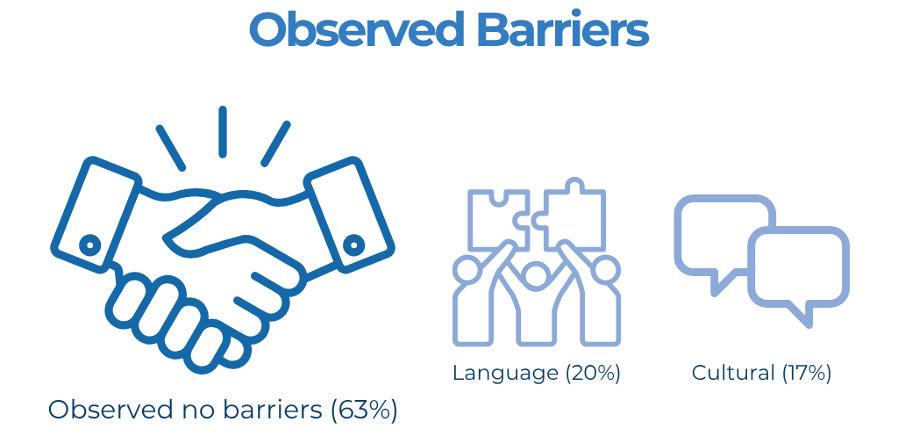
1
workshop show that event timing, childcare needs, and accessibility all influence participation. Activities outside standard work hours, alcoholfocused networking, and limited event format diversity can exclude people with different responsibilities, preferences, or mobility needs.
Professional and social inclusion: Some felt informal networking overshadowed technical or developmental content. Cost was also a barrier as noted by participants, particularly for students, early-career professionals, and those from smaller organisations.
Sector-wide challenges: The findings show that persistent issues include gender imbalance in operational roles, perceptions of ageism toward younger professionals, and a lack of structured mentoring pathways. Addressing these will require sustained, targeted action.
Opportunities for improvement
Survey response suggestions included:
Representation: Increase diversity in leadership, panels, and event speakers. Support structures: Strengthen inclusive SIGs, mentoring schemes, and Young Water Professional initiatives.
Accessibility: Improve event logistics, digital access, physical accessibility.
Language: Provide resources to support and accessible communications for non-native English speakers.
Event culture: Create inclusive networking
Figure
spaces and address inappropriate behaviour promptly.
Workshop suggestions:
• Make Te Mana o Te Wai principles accessible with free resources, embed tikanga Māori into daily practice, and share case studies of Māori frameworks in action.
• Create inclusive technical guidance, advocate for underrepresented voices, and provide safe spaces for discussion.
• Expand mentoring, deliver cultural competency training, and link professional development to inclusive workplace practices.
• Design events with accessibility in mind, offer varied formats, involve youth, track diversity in speakers and awardees, and introduce buddy systems for newcomers.
Personal Barriers

• Use interactive networking, maintain consistent relationship managers, engage schools and government, and connect regions via digital tools.
Key findings summary
Both survey and workshop show that inclusion in the water sector is not experienced equally. While many feel welcomed, others encounter barriers, often unnoticed by those unaffected. Cultural diversity remains limited, with Māori, Pasifika, and Asian voices underrepresented, suggesting possible disengagement or systemic obstacles.
Events are valued but can unintentionally exclude through timing, cost, or social focus. While DE&I initiatives are visible, participants cautioned that without meaningful, sustained action, these efforts risk becoming symbolic.
The group is currently working on a draft action plan and intend to do a follow-up survey across all Water New Zealand membership organisations including consultants, contractors and suppliers. Please encourage your organisation to take part.
Leading by example: Backing the next generation
By Mumtaz Parker, corporate and membership services manager, Water New Zealand.
The water sector is changing fast; whether it’s through reform, climate pressures, or technological disruption, the only constant seems to be change. And as we navigate this shifting landscape, one thing is clear: our future depends on people. That includes not only the deep experience of those who’ve been in the sector for decades, but also the fresh perspectives and energy of those just starting out.
Young water professionals (YWPs) and people new to the sector bring new ways of thinking, enthusiasm, and a genuine desire to make a difference. The question is, are we, as leaders, showing up in ways that help them succeed?
Good leadership isn’t just about big decisions, it’s about setting the tone for how others feel, act, and grow. When we talk about ‘role-modelling’, we’re talking about leaders who walk the talk. Those who show, not just tell, that young professionals matter.
That could mean turning up to a YWP event, inviting a new team member to sit in on a project meeting, or simply making the time to ask someone about their career goals. It might feel like a small gesture, but it signals something powerful: “You’re seen, and you belong here.”
Why supporting new professionals matters
Let’s be honest, it can be intimidating coming into a sector like ours. There’s a lot of history, plenty of acronyms, and a fair share of big personalities.
But that’s exactly why leadership support makes such a difference.
Young professionals bring ideas we may not have considered. Many are comfortable with digital tools, data, and systems thinking. They’re asking bold questions; about equity, climate action, and how we serve communities better. That’s the kind of thinking we need. What they often need in return is a bit of guidance, a chance to be heard, and room to grow. And here’s something worth reflecting on: if a young or new employee doesn’t feel confident enough to ask their manager for permission to attend an event that could grow their career, then we have a problem far greater than water leaks and infrastructure deficits. That’s a culture problem, and it falls to leadership to fix it.
What leadership in action looks like
It’s easy to say we support the next generation, but how do we show it?
• Be visible: Turn up to events. Offer feedback. Be approachable.
• Create space: Invite newer team members to the table when decisions are being made.
• Mentor don’t micromanage: Encourage growth by trusting people with responsibility and being available for support.
• Celebrate contribution: Recognise innovation and impact, not just years in the job.
It’s also about what happens behind the scenes. The way we talk about our colleagues, the way we distribute opportunities, and who we choose to lift up – all of these things matter. Support for new professionals shouldn’t be
left to chance. Leaders can help build structures that make this support part of everyday practice. That might include structured mentoring or buddy systems; professional development funding; rotation or secondment opportunities; involving YWPs in planning, policy, or strategy work; and making it standard practice to have diverse voices in workshops, panels, and project teams.
At Water New Zealand, initiatives like the Young Water Professionals network and mentoring programmes have already helped foster a strong community. But their impact grows when leaders actively back them, not just in principle, but with time, budget, and presence.
Why it’s worth it
The payoff is huge. You’re not just helping someone build their career, you’re building the bench strength of your team, your organisation, and the sector as a whole.
The people we invest in today will be the ones driving innovation, leading reform, and supporting communities tomorrow. When they see good leadership in action early in their careers, they carry those behaviours forward. That ripple effect is real and it starts with us.
In a sector like ours, people don’t just stay for the work, they stay for the culture, the purpose, and the leadership. If we want to attract and retain great people, we need to make sure they feel welcome and valued from the start.
So whether you’re a senior leader, a team manager, or someone who’s been in the game a while, think about the example you’re setting. Supporting the next generation isn’t extra work, it is the work.

Reflections from the flood frontline
Engineers working in flood management are well-versed in the technical aspects of flooding. But what happens when you talk to distressed people who have just lived through deeply traumatic experiences?
In the latest episode of Tāwara o te Wai, flood assessor Tom Nikkel and Auckland Council flood risk manager Fiona Macdonald, working in the aftermath of the 2023 Auckland anniversary floods, reflect on the tension between the need to make robust technical decisions and supporting the many traumatised people whose homes and lives have been upended.
They shared their thoughts with co-hosts Jon Reed and Hannah Edmond.
Find the Tāwara o te Wai podcasts on Spotify, the Water New Zealand website or wherever you get your podcasts.

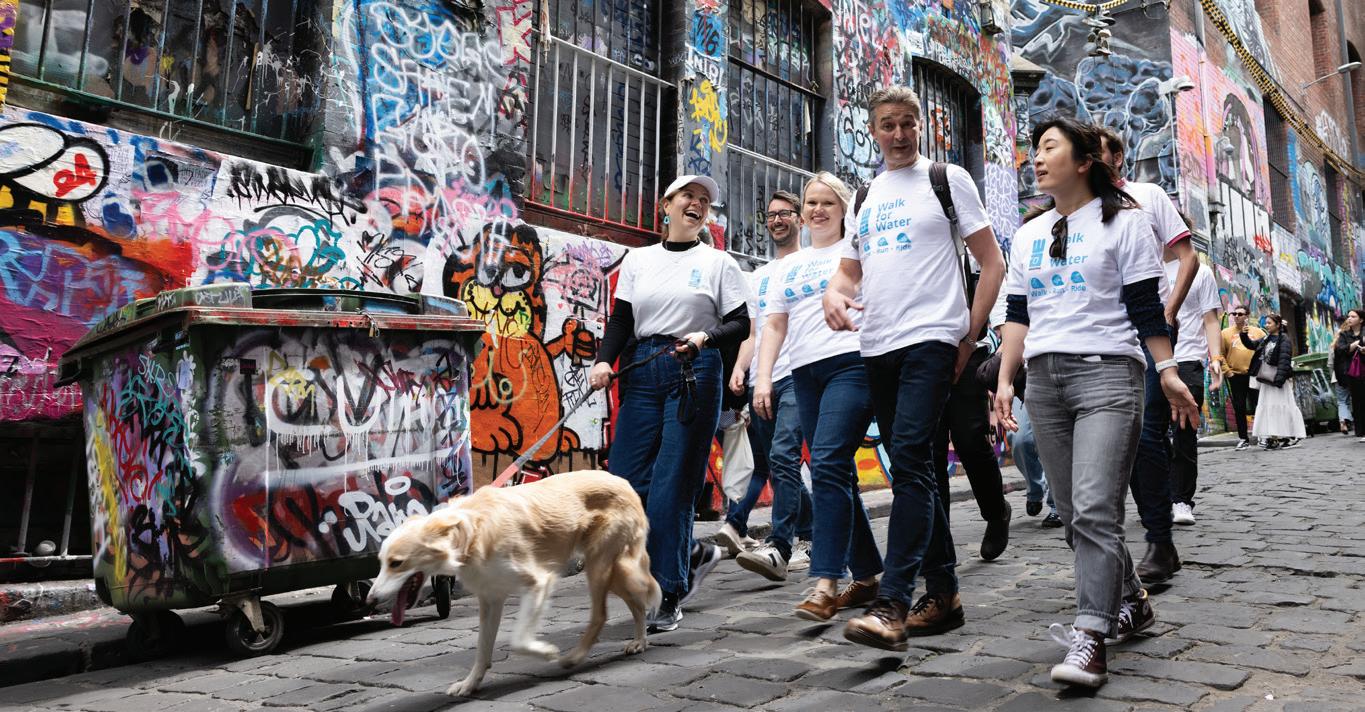
Water New Zealand supports Walk for Water
We’re supporting WaterAid Australia’s Walk for Water campaign. You can join us and help to raise awareness about the millions of people around the world who don’t get access to clean, safe water close to home.
For the third year running, chief executive Gillian Blythe will lead a team from Aotearoa New Zealand who will be walking to show their support. The international fundraising and awareness event takes place between 6 and 10 October.
“Every day, women and children walk long distances to collect and carry water for their families. Girls and boys often begin collecting water as children and girls continue to collect and carry water throughout their lives,” says Gillian.
“Walk for Water provides us with the chance to step into their shoes and raise vital funds to help communities access clean water, sanitation and hygiene.”
If you want to get involved, you can support Gillian and go to her sponsorship page: fundraise. wateraid.org.au/fundraisers/gillianblythe/walkforwater-2025, or you can sign up and walk, run or cycle yourself: fundraise.wateraid.org.au/event/walkforwater-2025/home.
Last year, WaterAid directly reached over 1.1 million people with clean water, decent toilets, and good hygiene, across households, communities, healthcare centres, and schools.
Local Water Done Well update
Councils have been under pressure to meet the September deadline for Water Services delivery plans and as part of that, finalise decisions about their future organisations – whether form new Council Controlled Organisations (CCOs) either on their own or across regional boundaries, or go it alone and continue to provide services in-house.
But whatever the decision, there won’t be a business as usual option.
New requirements around financial ring fencing, transparency, regulation and service delivery means that they will be under scrutiny to meet new requirements and standards.
In the latest Water New Zealand podcast, hosts Jon Reed and Emily Afoa discuss impact of the Local Water Done Well reforms with Water New Zealand chief executive Gillian Blythe and Nick Davis, an economist and partner with the advisory firm MartinJenkins.
Listen to the podcasts on Spotify, the Water New Zealand website or wherever you get your podcasts.
Tāwara o te Wai – Mahurangi river during Auckland anniversary flooding.
Walk for water WaterAID.
MORE FLUID THINKING

The world of water is evolving faster than ever, and every challenge is unique.

We are a fluid-thinking team of engineers, scientists, project designers, and sustainability specialists, committed to protecting our most valuable resources. We deliver tailored flexibility with innovative agility across the ANZ-Pacific water sector.
Whether you’re a local municipality or a global manufacturer, think of us as your performance partner. Here to help you maximise project lifecycle value and drive sustainable change.
Our in-depth hydro expertise, world-leading technology, and carbon-neutral services enable us to achieve exactly this—together.
Discover what more fluid thinking can do for you | hydroflux.nz
WATER WASTEWATER RENEWABLE ENERGY
HYDROGEN TRANSITION
ENVIRONMENTAL PROTECTION
New resources to explore water careers
As part of our wider Careers in the Water Sector initiative, Water New Zealand has released two brand-new resources: Exploring Careers in the Water Sector and How to Join the Water Sector. Both are now available in English and Te Reo Māori.
This release follows the launch of Careers in the Water Sector, a video series produced with support from the Waihanga Ara Rau Workforce Development Council and funding from the Infrastructure Education & Training Charitable Trust.
The series showcases 14 people from across the industry, from plant operators
and engineers to scientists and environmental planners, sharing their stories and highlighting the breadth of opportunities the sector offers.
The new guides expand on that vision, providing practical information on how to get started in water, pathways into different roles, and insights into emerging areas like climate change adaptation, smart water technologies, and Māori co-governance models.
They outline the skills employers look for, training options available, and the diversity of work, from hands-on operations and trades to science, management, and governance. Whether you’re a school leaver, career
changer, or simply exploring new opportunities, the resources show how your skills could help shape the future of water in Aotearoa New Zealand.
Members can print these resources free of charge to support your initiatives in schools and local communities. If you’d like to get involved by attending a school science fair in your area, simply check the events calendar on the CATE website (cate.co.nz/events/).
Both resources can be downloaded for free from the Schools and Communities page on the Water New Zealand website: waternz.org.nz/learnersandjobseekers
Greenhouse gas emissions in focus
Water New Zealand promotes the sustainable management and development of the water environment. Given water infrastructure is on the front line of the impacts of climate change, a key plank of this is championing efforts to reduce greenhouse gas emissions.
As an industry association we are in the business of bringing people together and this has unavoidable environmental impacts, predominantly travel related. To understand our impacts and opportunities for improvement we have been on a journey to account for our greenhouse gas emissions.
From 2021 to 2024, we undertook emissions assessments of our office operations and found travel accounted for 95 percent of this. Over the past two years, with the support of our event partner, Avenues, we turned our attention to our conferences.
In 2024 we partnered with Ekos and Toitu, to measure and assess, and offset the impact of our two major events – the Stormwater Conference and Water Conference and Expo. Again, travel emissions dominated. The figure here shows a breakdown of travel and non-related travel emissions across these conferences.
Operations for both these conferences were offset, through purchase of international carbon credits to achieve net zero status. The behind-the-scenes accounting was significant

Water New Zealand Greenhouse Gas Emissions
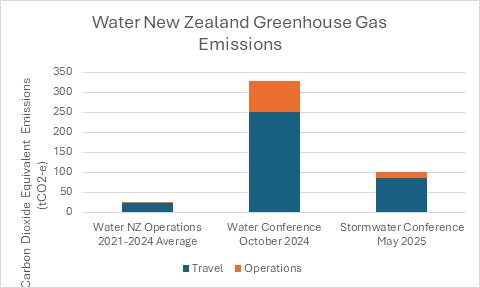
with lots to learn on the journey. We are grateful to our event partners, Avenues, for their willingness and effort invested.
Taking the learnings from our 2024 conferences, in 2025 we chose to calculate emissions ourselves. Rather than purchase international offsets we have made a proportional contribution to the Piako Catchment Restoration Project (piakocatchmentforum.co.nz/), a community group in the heart of Matamata-Piako and Hauraki Plains.
While the Piako Catchment Forum is not a
registered offset provider, their emissions are much closer to our area of impact, and their work revitalising riparian areas, wetlands, and undertaking water monitoring more closely aligns with the mahi of Water New Zealand.
We intend to look for opportunities to embed sustainability into our operations and events, partner with local providers, and focus on waste minimisation and recycling.
If you have suggestions or initiatives you think we could be looking at, we’d love to hear from you. Send your comments and suggestions to technical@waternz.org.nz.
Empowering young professionals: A new wave of water sector events
By Tom Porter, chair CIWEM
New Zealand branch
In a sector where innovation and collaboration are key, creating opportunities for young professionals to grow and share their ideas is essential. That’s why Water New Zealand’s Young Water Professionals (YWPs) and the Chartered Institution of Water and Environmental Management (CIWEM) teamed up to hold a dynamic new event series for emerging talent in the water and environmental industries.
These events were held in July 2025 and were successfully run by the YWP chairs for each location. Thanks go out to Lauren Carter in Pōneke Wellington, Urshula Johnson in Tāmaki Makaurau Auckland, and Bradley Jervis in Ōtautahi Christchurch.
The primary goal of these events was to give young professionals a safe, supportive space to present their work to obtain experience presenting to peers. The events enabled professional development, networking and knowledge exchange and sparked collaborations that will help shape the sector’s future.
Each session featured three to five speakers with presentations tackling key issues across the water and environmental sector whether it be a public/private sector project, volunteering experience, or academic research. The presentation series challenged speakers to share their insights and perspectives and practice in handling audience questions.
The events drew strong attendance, with a healthy mix of YWPs and senior professionals and fostered meaningful dialogue between generations of water practitioners.
A total of 14 presentations were delivered nationwide, addressing a range of subjects including policy and regulation, demand management, capital works delivery, sustainable and innovative approaches and a philosophical view of water values.
Presenters reported that the event format gave them valuable experience in public speaking, helped sharpen their communication skills and boosted their confidence in conveying complex ideas to industry peers.
To recognise participants’ efforts, three prizes were awarded to the presentations that judges felt showed a deep understanding of

their topic, clear communication and strong audience engagement.
Olivia Calvert from Vitruvius won the prize to present at the Young Water Professionals preconference workshop with her presentation, ‘Wastewater solids disposal to land’. The YWP preconference workshop will be held on 29 September, just ahead of the IWA-ASPIRE and Water New Zealand Conference & Expo 2025.
Judges described Olivia as an ‘engaging speaker, whose passion held the audience’s attention and brought innovative ideas’.
Sarah Innes (Watercare) and Sepideh Ansari (post-grad student at University of Canterbury) won access to a CIWEM CPD-accredited training course.
Senior water experts provided personalised feedback to all presenters, delivered one-onone in the days following the event to allow for constructive and thoughtful discussions.
One of the event judges, Angela Pratt, senior associate, Jacobs, and Stormwater Group committee member, says that “the presentations were all well prepared and presented and they handled some tricky questions which showed that our presenters really knew their topics well”.
The events were praised for the quality of

presentations and the welcoming environment they created.
Beca business director and CIWEM Aotearoa Committee member Dan Stevens, one of the judges at the Christchurch event, says, “the presenters did really well and showed their passion for their subject. I was really impressed by the engagement from the audience too – there were some excellent questions.”
Bradley Jervis, chair of the YWP Christchurch branch, expressed enthusiasm for the initiative’s future. He highlighted the potential for more frequent informal YWP sharing sessions and online events to allow more attendees from across the motu.
These events align well with the YWP pre-conference workshop, which aims to provide opportunities for YWPs to develop expertise, build networks and gain a broader understanding of the field.
Given the success of this inaugural event, the YWP committee is hoping to make the speaker series an annual fixture in their events calendar.
For more information on the YWP, go to waternz.org.nz/youngwaterprofessionals, and for Water New Zealand events near you, see waternz.org.nz/events.
Olivia Calvert's presentation on 'Wastewater solids disposal to land’ won the prize to present at the Young Water Professionals conference.

Building a future-ready workforce
By Belinda Cridge, Water New Zealand technical lead (drinking water quality and education)
The sweeping water reforms and the need for infrastructure investment, along with rising expectations for water quality and compliance will demand a workforce that is ready to meet the challenges ahead.
Traditional training models which have focused on time spent rather than skills gained, are no longer sufficient. The sector’s future success will depend on strategic upskilling, competency-based development, and innovative recognition of staff achievements.
Scale of change
Our water workforce is projected to grow from approximately 15,400 full-time equivalents (FTEs) in 2021 to around 26,900 FTEs by 2031 – an 80 percent increase over a decade.
Around 10 percent of roles are currently vacant, highlighting ongoing difficulties in attracting and retaining skilled staff. Only 27 percent of water supply workers are female, pointing to the need for greater diversity and inclusion.
The sector will require an additional 6000–9000 skilled workers over the next 30 years to meet national standards for safe drinking water and environmental outcomes.
To address these challenges, leading organisations are turning to key performance indicators (KPIs) and competency frameworks as the backbone of their workforce strategies. KPIs clarify what success looks like, whether that’s reducing water loss, improving response times, or achieving compliance targets. Competency frameworks map out the skills required for each role, enabling organisations to identify gaps and target training where it will have the most impact.
By aligning training initiatives with these frameworks, organisations ensure that learning directly supports business objectives and regulatory requirements. This approach enables leaders to:
• Conduct targeted gap analyses and prioritise upskilling in critical areas.
• Support structured career progression, helping to retain and motivate talent.
• Demonstrate measurable outcomes and return on investment for training spend.
International best practice recommends that organisations allocate three to five percent of their total salary spend to training and development each year. This benchmark reflects the strategic importance of ongoing upskilling in building a resilient, future-ready workforce.
The ongoing water reforms are raising the bar for operational standards and public accountability. Staff must now understand and implement updated regulations, adopt digital tools, and continuously improve their skills to remain agile and effective. The sector is inadequately prepared to operate new, technologically advanced systems, making structured upskilling and competency frameworks essential.
Recognition and motivation: The role of digital badges
Recognition is a powerful motivator for professional development. Digital badges, such as those offered by Water New Zealand, have become increasingly popular with learners and employers alike. While not micro-credentials, these badges offer several advantages:
• Visibility and shareability: Staff can showcase their achievements on LinkedIn, email signatures, and personal websites, increasing their profile within the sector.
• Verifiable recognition: Each badge provides a credible, easily verifiable record of achievement.
• Motivation and engagement: Instant recognition fosters a sense of accomplishment and encourages further learning.
• Accessibility: Online delivery makes badges accessible to learners across the country, regardless of location or schedule.
Feedback from learners highlights the value of flexibility, recognition, and the ability to demonstrate up-to-date knowledge.
One participant noted, “The availability of a digital badge allows you to learn in an online environment at a time that is convenient for you. A digital badge also provides you an opportunity to share your achievement and learning via digital platforms such as LinkedIn.”
This sentiment is echoed across the sector,
with leaders encouraging staff to upskill through digital badge offerings.
Practical steps for water sector leaders
To build a workforce capable of meeting the demands of reform and ongoing operational excellence, leaders should consider the following steps:
1. Define and align: Identify your organisation’s most critical KPIs and align all training initiatives to these outcomes. Ensure every learning activity directly supports business objectives and compliance needs.
2. Map and prioritise: Use competency frameworks to map required skills for each role. Conduct a gap analysis to determine where current capabilities fall short, and prioritise training in areas with the greatest impact.
3. Integrate real-world learning: Design training that includes scenario-based and hands-on learning, mirroring actual job challenges to help staff build confidence and apply skills immediately.
4. Measure impact: Track training effectiveness by measuring both engagement and business outcomes. Use data to demonstrate return on investment and inform future development initiatives.
5. Recognise and motivate. Leverage digital badges and other recognition tools to celebrate staff achievements. Visible, portable credentials keep people motivated and invested in their professional growth. The transformation underway in the water sector presents both challenges and opportunities. By investing in structured, outcomes-focused upskilling – anchored by KPIs, competency frameworks, and innovative recognition tools like digital badges – leaders can build a workforce that is not only compliant but also confident, capable, and ready to meet the demands of reform.
A strategic commitment to training, supported by appropriate budget allocation, will ensure the sector thrives now and into the future.
Celebrating 50 Years of Te Wiki o te reo Māori
By Troy Brockbank (Te Rarawa, Ngāti Hine, Ngāpuhi, Ngātiwai, Ngāti Kahu)
for Water New Zealand Waiora Aotearoa.
Water New Zealand Waiora Aotearoa is proud to celebrate the 50th anniversary of Te Wiki o te Reo Māori (Māori Language Week).
This milestone represents five decades of collective commitment to revitalising and normalising te reo Māori – a taonga that preserves the stories, values, and worldview of tangata whenua.
To commemorate the occasion, we have developed a poster titled “Ngā Momo Ua – The types of rain” (see page 17). The kaupapa invites people to engage with te reo and te ao Māori through the lens of one of our most life-giving forces: wai.
Rain is far more than condensation falling from the sky. It is waiora, the purest, life-affirming form of water that sustains land, people, and wairua.
Rain is a living connection between Ranginui, the Sky Father,
and Papatūānuku, the Earth Mother, a reminder of their enduring relationship and the balance of natural cycles that bind us. It heals the whenua, replenishes rivers, nourishes mahinga kai, and cleanses both our bodies and the spaces we inhabit.
Rain is also a tohu, a sign that informs tikanga, rituals, decision-making, and seasonal activities. Through rain, we remember whakapapa and our interdependence with all living things, and we are called to uphold our responsibilities as kaitiaki to protect and respect wai as a taonga.
Among the many expressions that reflect the deep relationship between people and rain is the whakataukī, “He roimata ua, he roimata tangata”, when the tears of rain fall, so too do the tears of people. This saying acknowledges the spiritual and emotional resonance of rain.
Continued on page16 ›

• Design and supply of digester and large tank mixing systems for major cities across NZ & Australia. Each system is performance guaranteed.
• Centrifugal and positive displacement solids handling pumps for municipal, industrial and agricultural wastewater sludges.
• Rotary drum screens
• Sludge heat-exchangers
• Macerators & chopper pumps
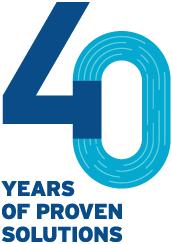


‹ continued from page 15
Just as Ranginui’s tears fall upon Papatūānuku, human emotions often mirror the moods of the weather. Rain can soothe, cleanse, and bring renewal, but it can also evoke sadness or introspection. Conversely, our collective essence and energy can feel reflected in the skies above. This reciprocity reminds us that the natural world and human experience are intertwined, each influencing the other in subtle yet profound ways.
The poster encourages viewers to encounter rain as it is understood within te ao Māori: animate, personified, and guided by atua who actively shape the taiao (natural world). Ranginui is said to weep, his tears falling as rain, a symbol of his longing for Papatūānuku.
Hineteihorangi, the celestial teardrop, embodies the emotional and spiritual essence of rain. Hinewai, atua of rain, brings nourishment and healing to the land. Wainuiatea, the great expanse of water in the sky, is a life-giving reservoir from which our oceans descend.
Tāwhirimātea and Huru a te Rangi, atua of winds, shape and carry rain across the landscapes of Aotearoa. These atua are not distant abstractions: they are active participants in the rhythms of weather, seasons, and life. Their presence within the poster underscores the sacredness of rain and its vital role in maintaining mauri, balance, and harmony.
A central aim of the poster is to offer a vivid glimpse into the Māori worldview while expanding the pātaka kupu – the storehouse of words – through a rich lexicon of rain-related kupu in te reo Māori.
Beginning with the four main forms of precipitation, waiwaha (sleet), puaheiri (snow), ua (rain), and huka waitara (hail), the poster moves into subtler expressions that capture variations in rain’s form, intensity, and effect. There is kōpatapata (light rain) and ua kōnehunehu (drizzle), as well as ua hūkerikeri (violent rain).
Each kupu carries its own tohu, its own sign or instruction that historically guided ceremony, planting and harvesting cycles, journey planning, and gathering kai. In naming and knowing these words, we weave together the spiritual and physical realms and strengthen our sense of whakapapa, while reaffirming our responsibilities as kaitiaki of water and land.
The theme seeks to capture the full spectrum of rain’s presence, from its softest caress to its most forceful expression. In doing so, it also acknowledges the many ways rain shapes our environment and our relationship with it.
Tauraki, the absence of rain, can lead to drought, water restrictions, and hardship. The right balance of rain nourishes the whenua, promoting growth, resilience, and abundance. Conversely, waipuke – flooding – can bring damage and loss.
These realities are reflected in te reo Māori, which not only records meteorological observations but encodes cultural responses and adaptive practices. By naming and describing rain through te reo, the poster supports language revitalisation in a context that is deeply meaningful and grounded in lived experience.
It invites people to learn new kupu, to speak them, and to see the world through them, making te reo accessible and engaging whether one is fluent, a learner, or just beginning their reo journey.
Alongside the poster, we encourage people to seek out rerenga
kupu – handy everyday sentences – that embed te reo Māori in daily life. These simple, practical phrases help normalise the language and make it part of our everyday interactions, especially when speaking about the weather:
E heke ana te ua. The rain is falling.
E heke ana te ua kāore he mutunga. The rain’s coming down with no end in sight.
E ua ana. It’s raining.
E ua ana ki waho. It’s raining outside.
He rangi ua tēnei. This is a rainy day.
Kei te mākū. It’s wet.
Kei te ua. It’s raining.
Kua mao te ua. The rain has stopped..
Kua tae mai te ua. The rain has arrived.
Kei hea tāku hamarara? Where is my umbrella?
Kei hea wāku kamuputu? Where are my gumboots?
These phrases are easy to remember and, when woven into daily kōrero, they become a natural part of conversation, embedding te reo Māori into our lived experience.
This is one of the most powerful ways to keep the language alive: not isolated in classrooms or ceremonies alone, but present and breathing in our homes, workplaces, and communities.
Through Ngā Momo Ua, Water New Zealand Waiora Aotearoa is not only celebrating the diversity and beauty of rain; we are honouring the depth of meaning rain holds in te ao Māori and reaffirming the importance of wai as a taonga.
Rain is a healer, a nourisher, a cleanser, and a guide. It is at once practical and symbolic, reminding us of our responsibilities as kaitiaki to protect, respect, and uphold the mana o te wai.
As we mark 50 years of Te Wiki o te Reo Māori, we are reminded that language and environment are inseparable.
Language emerges from the land, waters, and skies; it shapes how we understand them and, in turn, how we care for them. Every word we speak carries the weight and wisdom of generations who lived in deep relationship with the taiao, and each new speaker adds to that legacy.
By learning, using, and teaching these kupu, we are not only protecting te reo Māori, we are also strengthening our collective bond with the natural world.
This year’s kaupapa calls to us – fluent speakers, learners, and supporters alike – to embrace rain as both teacher and connector. It invites us to listen to the stories rain tells, to feel its presence as a gift and a responsibility, and to carry forward the knowledge and values it embodies.
As we celebrate this milestone, Water New Zealand Waiora Aotearoa invites everyone to honour the past, celebrate the present, and shape the future, together. Let rain remind us that revitalisation is possible, renewal is constant, and our relationship with wai is grounded in reciprocity, respect, and reverence.
In each falling drop, there is a story waiting to be spoken, a word ready to be remembered, and a connection ready to be renewed.
“E heke ana te ua, e rere ana te reo – the rain falls, the language flows. Two natural forces, each vital to life. As rain nourishes the whenua, te reo Māori nourishes our identity, culture, and connection to place.
Hineteihorangi Celestial tear drop
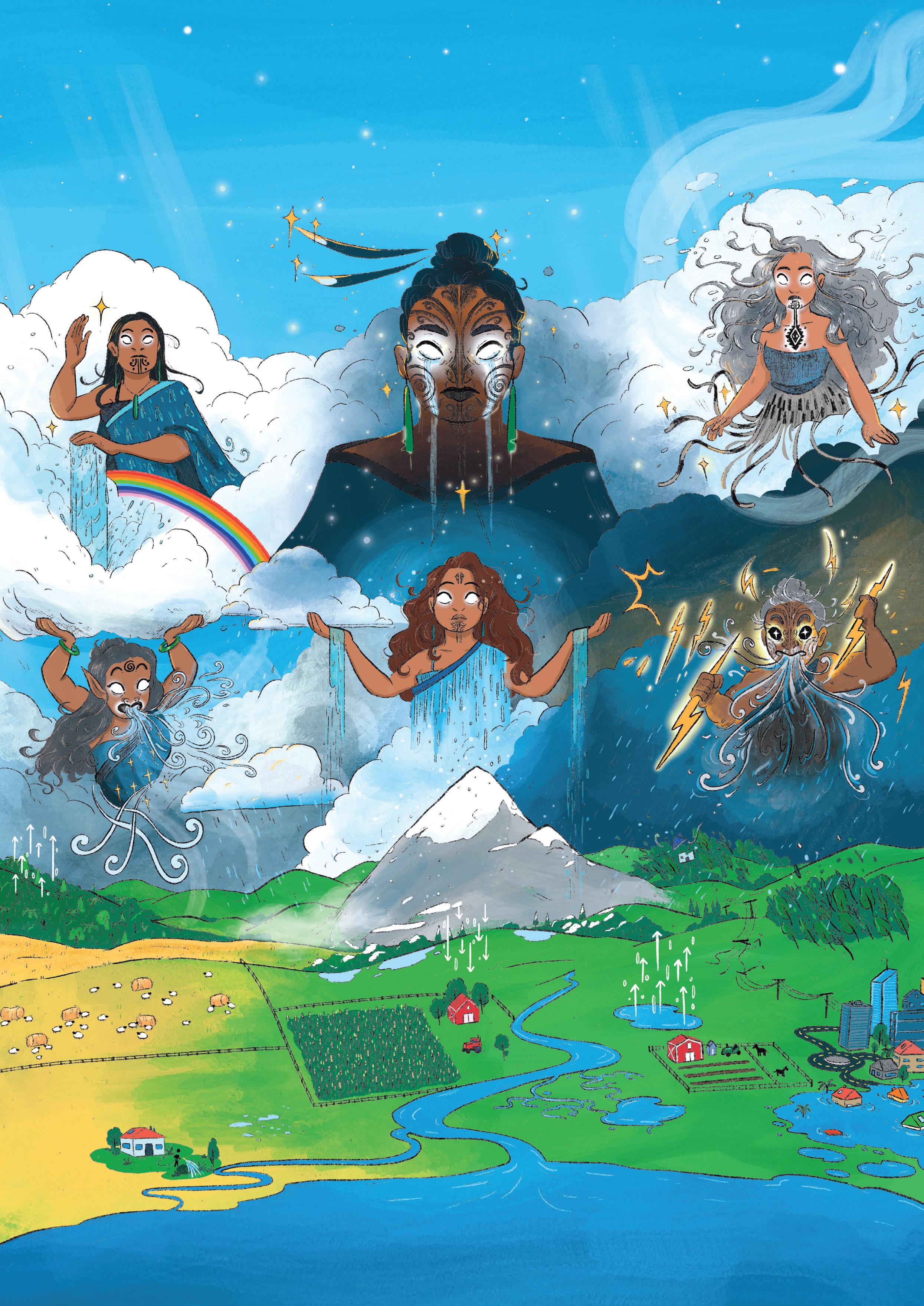
Huru a te rangi Atua of winds
Kapua Cloud
Ngā Momo UA Types of Rain
Wainuiatea Expanse of water in the sky
Ranginui Sky father
Atua of rain
Pata ua Raindrops Āniwaniwa Rainbow
Kōpatapata Light rain
Tūāua Shower
Huka Waitara Hail
Puaheiri Snow Waiwaha Sleet UA Rain
Waitōtā Condensation Tukuwai Transpiration
Pūkohu Mist
Ua kōnehunehu Drizzle
Uira Lightning Whatitiri Thunder
Storm
Tawhirimātea Atua of winds
UA hūkerikeri Violent rain
Whakaeto Evaporation
Tauraki Drought Haukū Dew
Kōpuapua Temporary pools of water
Flood
Waipuke
Āwhā
Hinewai

Charting a path towards a circular, resilient, and regenerative future for wastewater
A perspective from the Water New Zealand Wastewater Special Interest Group
Wastewater management is central to protecting our health and environment. Yet, in Aotearoa New Zealand, it remains underfunded and undervalued.
Across the country, people working in this essential service are not only engineers, scientists, and operators but also parents, siblings, and members of our communities. They share a commitment to protecting public health, caring for the environment, and ensuring a safe and resilient future for all New Zealanders.
They believe in facts and scratch their heads 24/7 around what can be done about the challenges the country faces when it comes to aging infrastructure, increasing environmental pressures, and rising community expectations, which are often not much higher than keeping turds out of our roads and gardens and keeping our waters healthy.
This article sets out a case for wastewater transformation. A rebranding if you want. From burden to resource, from compliance to innovation, we can reimagine the role of wastewater in shaping a circular and climate-resilient Aotearoa. The question is no longer whether change is necessary, but how swiftly and effectively we can act.
The current state: Infrastructure under strain, rising risk
Much of the infrastructure is aging and, in many regions, no longer fit for purpose. Wastewater overflow events, untreated discharges, and system failures are too frequent.
Urgent investment is needed to meet rising environmental and human health standards and to prepare for climate impacts such as flooding and drought.
Currently there is no clearly-defined, robust data on the asset value for three waters (drinking water, stormwater, wastewater). The most recent National Performance Review (2021-22) estimated the value to be between $40 and $50 billion. Likewise, until the councils’ Water Services Delivery Plans are published, there is no up to date information on the projected capital investment needed.
The Water Services Commission of Scotland (WICS)) report estimated that it would require $120–$185 billion investment to meet minimum standards over the next 30 years. We would expect these numbers to be, either similar or higher, once we see what the councils' plans are saying. Whatever the outcome, it’s clear that a lot of new funding is going to be needed.
On average, wastewater treatment plants collectively process an estimated 520 billion litres of wastewater each year; roughly the volume of lake Rotorua at mid volume.
Wastewater is not just water: Water is a transport medium for a wide range of constituents, both pollutants and resources. Every year, we manage around 300,000 tonnes of sludge rich in organic matter, nitrogen, and phosphorus.
Around 6000 New Zealanders operate and maintain wastewater networks serving more than 1.5 million connections (over 80 percent of New Zealand’s population).
Beyond treatment: Wastewater as a strategic resource
Wastewater contains the same building blocks that sustain all life: carbon, nitrogen, and phosphorus among others. Correctly produced wastewater
biosolids are nothing other than your NPK fertiliser or your bag of compost you get at your local garden centre.
But when Wastewater gets discharged untreated, it can pollute our waterways. When recovered, these constituents can strengthen our soils, support food production systems, and generate renewable energy to benefit our communities.
In many parts of the world, utilities are transforming treatment plants into resource recovery hubs. We have an opportunity to do the same while defining a pathway to transition to a circular economy and low emissions future.
• Energy recovery: Anaerobic digestion of sludge can produce biogas, a clean, renewable energy source. Globally, the trend is towards energy positive and carbon neutral treatment plants, turning treatment into power plants.
• Nutrient capture: Five million New Zealanders collectively generate an estimated 22,000 tonnes of nitrogen and 4500 tonnes of phosphorus each year. These nutrients, if captured and reused, could improve soil health, reduce fertiliser imports, and contribute to a more circular economy.
• Water reuse: As climate change intensifies, treated effluent becomes an increasingly valuable asset. Reuse for irrigation, industrial processes, or even supply for process water can extend water security – if infrastructure, policy, and public trust are aligned.
These opportunities are transformative. They are not speculative. The technologies are proven, the benefits are tangible, and the urgency is real.
They directly address global sustainability challenges identified in the Planetary Boundaries framework developed by the Stockholm Resilience Centre, which includes biogeochemical flows (nitrogen and phosphorus), freshwater use, climate change, and chemical pollution (e.g., persistent organic pollutants, plastics, endocrine disruptors).
Staying within planetary boundaries is critical to sustain human life on Earth – one of those facts we believe in.
Water is a scarce resource at times: soil and phosphorus are finite resources. Phosphorus mining is considered to peak in this century. Life cannot compromise on the elements it needs. Phosphorus cannot be replaced by innovation. Once we run out, life will end – no further questions asked.
What now? Six pillars for transformation
Our group is working on six essential pillars which we argue that the wastewater sector must embrace for a successful transformation:
1. Building and retaining a skilled workforce: We need more people entering the profession and staying in it.
Wastewater careers are essential, meaningful and central to community well-being. We must attract new professionals, support career pathways, and ensure pay equity for those safeguarding public health and the environment. We have developed a set of actions that we believe will help shift the dial, and we are keen on partnering to help deliver these.
2. Investing in resource recovery and circular solutions: Let’s make the most of what we have, reduce imports, and protect the environment. Capturing nutrients, producing biogas, enhancing biosolids and reusing water are proven, practical steps towards a circular economy. They are no brainers.
To catalyse conversations we are developing a white paper. We’ve also

released an industry survey to capture the state of play and sector perspectives. If you have an active interest, we’d love to hear from you.
3. Establishing stronger National Standards: An effective regulatory baseline is essential.
Consistency across the country is vital. Regulation should provide a clear baseline while recognising the sensitivity of local environments and the importance of Te Mana o te Wai and Te Ao Māori perspectives. To this end, we have been actively contributing to Taumata Arowai wastewater standards consultation to identify areas we think could be strengthened.
4. Building public engagement and awareness: Letting the public know what we do and why it matters.
Wastewater should not remain hidden or taboo. The public deserves to know the essential role we play in protecting the environment and human health. With greater transparency, we can foster pride in the sector and build the social licence for investment. We need to bring wastewater to public discourse.
5. Biosolids: 70 by 30. Biosolids are an important subset of our circular economy. So important, we have given them their own workstream, with the ambitious vision of 70 percent of our biosolids used by 2030. With landfills filling up and increasing contaminants entering our waste streams on the other hand, concern around emissions is driving the need for alternative disposal routes. There are more questions about the right way to manage the solid fraction of sewage sludge than ever. Our biosolids group is an active hub of conversation, bringing people together to look for solutions.
6. Driving innovation and collaboration: Let’s learn faster by working together.
Ef

An independent national wastewater innovation centre could accelerate research, testing, and knowledge-sharing, helping communities, councils, and water utilities learn faster and deploy solutions more effectively.
Wastewater treatment harnesses and enhances what Papatūānuku provides us. Together with her, we can integrate nature-based, adaptive solutions to tackle the challenges of climate change.
Wastewater treatment is an investment that benefits public health, protects the environment, and enables community growth, and gets us back to the top of the world as a benchmark for environmental care. We need secure funding and only a fair and transparent pricing for wastewater services will ensure lasting, sustainable investment.
From waste to value
Wastewater is not a cost to be managed; it is an investment that yields returns in public health, environmental protection, and community prosperity. The solutions it offers are scalable, adaptable, and aligned with global sustainability goals.
It is time to stop treating wastewater as a waste and see wastewater treatment plants for what they really are: resource recovery plants.
The time to reframe wastewater is now. We have the technology and carry the responsibility to protect and safeguard the people and the environment for generations to come.
Let us shift from disposal to resource recovery, from risk to resilience, from waste to value. With strategic investment, cohesive regulation, empowered operators, and public support, we can transform the sector into a cornerstone of a regenerative and equitable future.
The path is clear. It is time to act.

fective Wastewater Treatment & Discharge
2-Day October 2025 Training in Dunedin (9&10), Christchurch (16&17) and Hamilton (22&23)
For Local & Central Government , Processing Industry and Consultancy Professionals By
A great opportunity to attend one of the best wastewater treatment & discharge workshops attended by 12 regional councils, 3 government agencies, 8 companies & consultancies and 25 district/city councils to date
Treatment processes of wide-ranging WWTPs including the mysterious treatment ponds, discharge impacts, numerous case studies delivered at the highest standard.

Dr Selvarajah has >3 decades of regional council experience and >100 reports/technical publications including 6 national and international keynote presentations who will deliver the interactive workshop/training which will also include a well-researched, authoritative and comprehensive workshop manual with references Final date for registration: 3 October 2025 (seats are limited to 15 per venue).
For further info and the flyer www.enviroknowledge.co.nz/knowledge-sharing-and-education and all enquiries including registration directed to sustain@enviroknowledge.co.nz


Bringing the water world down under
With great skill and unwavering determination, Marion Savill has succeeded in getting the IWA-ASPIRE Conference to Aotearoa New Zealand. This year, the international event will run alongside the Water New Zealand Conference and Expo from September 29 to October 3.
“It’s taken eight years,” Marion says. “I attended major International Water Association (IWA) events around the world gathering ideas and promoting New Zealand to win the bid – it’s taken much work and effort, but we’ve pulled it off.”
Water New Zealand CEO Gillian Blythe says, “the reason we are preparing for what is set to be one of the biggest and most ambitious conferences to date is due in large part to Marion’s skills, tenacity, and her connections across the international water sector.
“She’s able to combine her strengths as a respected scientist and communicator to ensure that new ideas and innovation is shared across international boundaries.”
Marion has always seen the importance of networking and building relationships within the sector. She believes the willingness and ability to talk with others is a skill inherent in Kiwi engineers and scientists – thanks to our small size which often means we work in more than one water discipline over our careers – and we should use it to our advantage.
“In my role I mix with people from all aspects of the water sector from all over the world,” she says. “I get to hear their solutions to various problems and think, ‘Oh, that should be good for us’.
“The beauty of the IWA-APIRE and Water New Zealand Conference and Expo 2025 is that it will bring a big number of international experts right to us. I think the networking side of the conference is equally as important as the sessions, if not more.
“Meeting face-to-face is so important. You can read literature online, but you can’t easily meet people. At a conference you can meet people, have a beer, work out ‘do I like/trust you?’, and that develops into, ‘shall we work together?’”
Marion has always been a star networker, saying it has opened her up to many opportunities and given her many wonderful personal experiences.
“I used to make a list of the top men and women whose work I liked, and I’d target them to talk to at an event like this. I’d find out who they were and then approach them, and we’d chat and share information and go on to collaborate on various things.
“Now, conferences are where I go to meet old friends again.”
One of those old friends is Robert Bos, co-chair of the IWAASPIRE Conference committee. He says “because of her active role in the IWA’s Health-related Water Microbiology specialist group over many years, Marion maintained close working relations with the water, sanitation, and health programme of the World Health Organization.
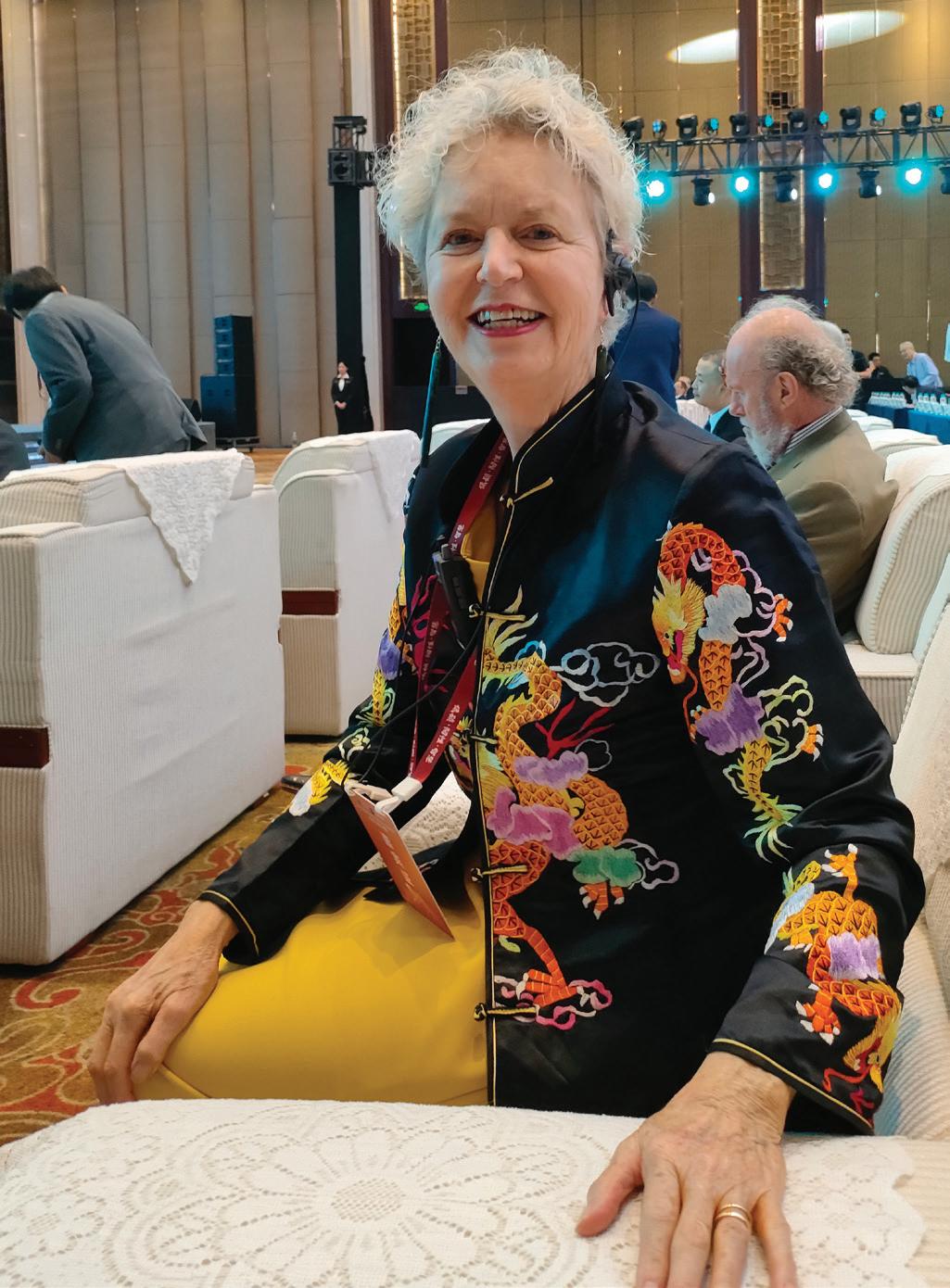
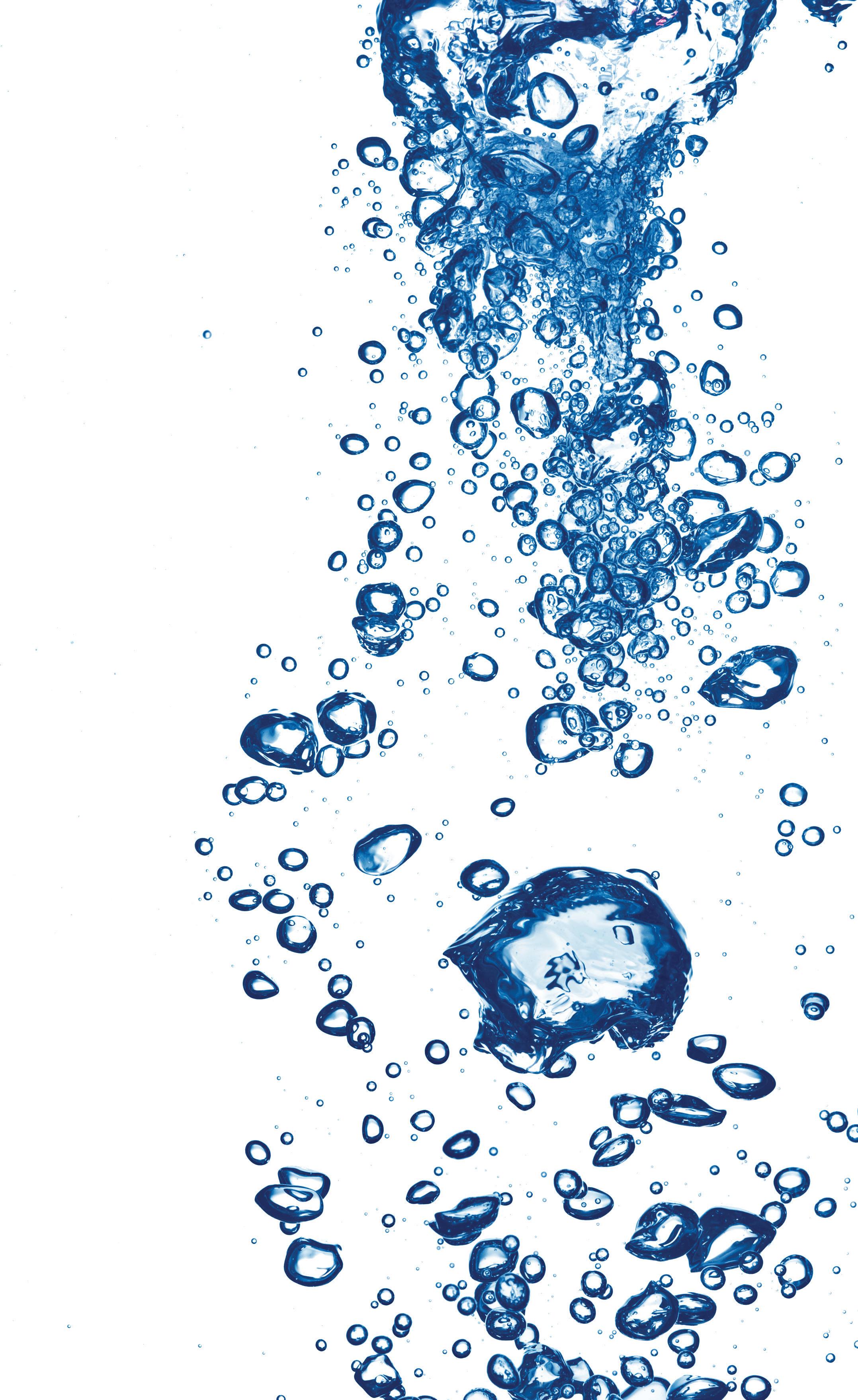
“In my role of coordinator WASH in WHO, we had many opportunities for fruitful cooperation.”
Marion’s career began as a forensic scientist, where she learnt DNA forensic techniques at FBI in Quantico. A few years later she was asked to establish DNA ID for microbes in food and water at DSIR Chemistry (now the New Zealand Institute for Public Health and Forensic Science).
“I was awarded a Fulbright and studied at Berkeley. This is where I was introduced to IWA and, specifically, health-related water microbiology.”
Over the years, Marion has worked on programme committees
Marion Savill photographed in May this year at a meeting with the water community in China.

for many IWA, as well as non-IWA, conferences. This experience means she knows what makes a good international conference, and she has the trust of the IWA to deliver an excellent programme.
Marion says it all began when she was approached by Tourism New Zealand back in 2017. They asked her to put a bid in for the conference, in a drive to help bring tourists to the country.
"At this point I approached Water New Zealand, who already host an amazing conference, to see if we could join forces and place our bid based on a combined IWA-ASPIRE and Water New Zealand Conference, with the support of Tourism New Zealand. We had to compete against other countries – pitching why we would be the better location for the event..
“We were fortunate in that we’d never held it before, which was appealing, and Australia supported us by kindly withdrawing their bid, which was extremely generous of them. Many of the Australians are now on my committees – I said they could be involved as much as they wanted to be.”
The IWA-ASPIRE Conference organising committee comprises people from all over the world, and they “do all the hard work”, says Marion. A programme committee – also working very hard – has finalised the papers to be presented and arranged the programme.
Plenary sessions will set the tone for each day, starting with indigenous communities and WASH governance models on day one, planetary health on day two, strengthening regulatory frameworks on day three, and closing with building resilience in the wake of natural disasters on the Thursday afternoon.
“We have some great keynote speakers lined up for our plenary sessions. I am particularly excited to hear what Kath Richardson from the University of Copenhagen has to say about planetary health – what we are doing to our waters and how we are protecting them.
“Another must see will be local keynote Te Maire Tau, who is speaking on indigenous communities at the first plenary on the Tuesday.
“In fact, it’s always worth getting to the plenary sessions – they’re such great speakers – even if it does mean dragging yourself out of bed a bit earlier!”
The conference programme is jammed with over 200 presentations covering the full range of water topics, from risk and resilience, and smart solutions, to people and communities, to wastewater, drinking water, climate change, sustainability, and asset management, to te ao Māori and global views, and everything in between.
Marion says one of the key attractions in their bid was Aotearoa New Zealand’s combination of western views of water with indigenous views, something that wasn’t considered much at the time, and since then has rapidly taken off and “is everywhere”.
“We’re better than most international countries at working with our indigenous people. We are good at collaborating with Māori to tackle our water issues together.
“The conference will also give us an opportunity to share what we’re good at.”
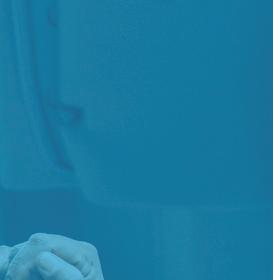
We’re Creating the Future of Water for our people, communities and the environment







Susheel Arora
As CEO of Atlantic First Nations Water Authority, Susheel leads Canada’s first indigenousowned and operated water service, improving water infrastructure and advocating for selfdetermination in First Nations communities.

Nina Braid
Nina is an Aboriginal woman from South Australia and has more than 15 years of experience in conservation and working in Aboriginal partnerships. She is currently managing Aboriginal partnerships at Yarra Valley Water and holds leadership roles in environmental organisations.

Susan Bell Chiblow
Susan is an Anishinaabe scholar with a PhD focused on water knowledge. She has worked with the First Nations on environmental issues and holds a faculty position at the University of Guelph.

Ahmad Faizal Abdul Rahman
Ahmad Faizal is the CEO of the National Water Services Commission (SPAN), the regulatory authority responsible for overseeing water services across Peninsular Malaysia and Labuan, ensuring sustainable, reliable, and affordable services for more than 34 million people.

Corinne Cheeseman
Corinne is CEO of the Australian Water Association (AWA). She has worked across environmental and water resources management, community engagement and education, asset management, policy, and data and analytics.

Karina Gin
Dr Karina Gin is a Provost Chair Professor at the Department of Civil and Environmental Engineering, National University of Singapore. Her research specialisation is in water quality and ecosystem processes. She has served on several WHO expert panels/meetings to address the issue of antimicrobial resistance, pathogens and microbial safety of water in food, drinking water and water reuse.


David Cunliffe
As a principal water quality specialist in South Australia, David has more than 40 years of experience in public health water regulation and has contributed significantly to WHO guidelines on water safety.

Stanislav Kim
Stanislav is team leader for the disaster resilience team at the UNDP Bangkok Regional Hub where he assists countries in Asia and Pacific to strengthen resilience against natural disasters response and recovery.

Jiuhui is a leading Chinese academic recognised for advancing water pollution technologies, holding prestigious memberships and awards including the Chinese Academy of Engineering and the Sustainability Award by the Nobel Sustainability Trust.

Nerina Di Lorenzo
Nerina is managing director of Melbourne Water, and brings extensive experience in water and local government sectors. She previously served as CEO of Merri-bek City Council.

Katherine Richardson
A professor of biological oceanography at the University of Copenhagen, Katherine specialises in Earth system science and leads research on ocean, climate, and sustainable futures, including the Planetary Boundaries framework.

Abdul Kadir is a professional engineer registered with the Board of Engineers, Malaysia (BEM), ASEAN Chartered Professional Engineer (ACPE) and chartered engineer with the Institution of Civil Engineers, UK (MICE). His expertise is in conceptual and strategic business planning and management in water, green technology, research and development, and environment.
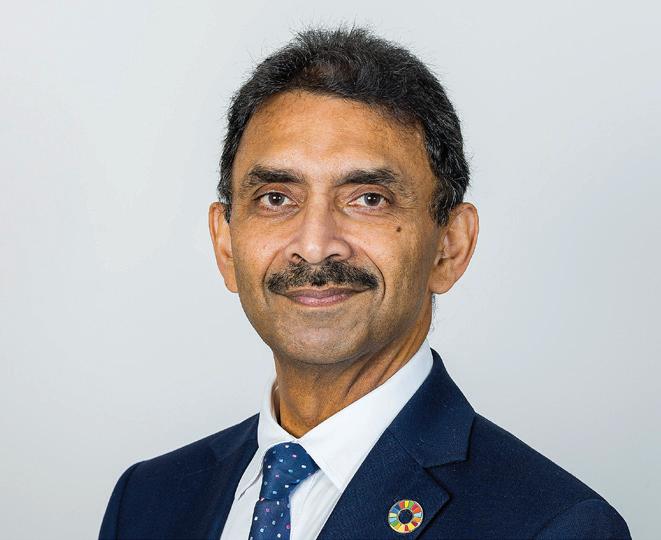
Raveen Jaduram
With 40 years in water and infrastructure sectors, Raveen chairs New Zealand’s Infrastructure Commission and Water Services Authority –Taumata Arowai. A former CEO of Watercare, Raveen has also held public and private executive roles in Australia and Aotearoa New Zealand.
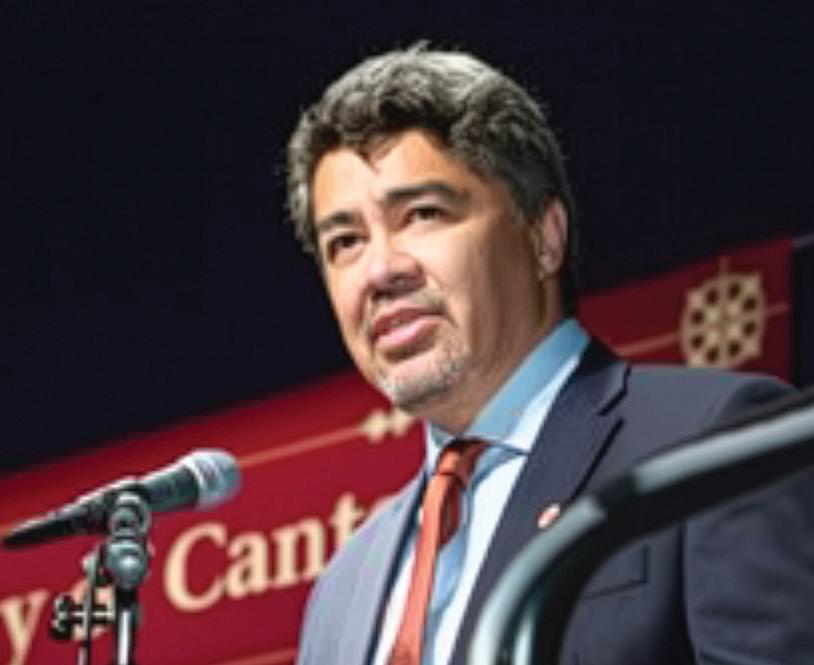
Te Maire Tau


Te Maire is the pou whakarae at the University of Canterbury and upoko of Ngāi Tūāhuriri (the tribal group of the Tuahiwi region). His focus is on indigenous knowledge systems, oral traditions, and water rights. He has played a key role in the Ngāi Tahu land claim settlement.
Abdul Kadir Mohd Din
Jiuhui Qu

Patrick Lester N. Ty
Patrick is the chief regulator at the Metropolitan Waterworks and Sewerage System Regulatory Office (MWSS RO) in the Philippines. He has also held positions at the Central Bank Board of Liquidators, UP Institute of Government and Law Reform, and Ocampo and Manalo Law Firm.

Alison is departmental chief science advisor – kaitohutohu mātanga pūtaiao matua at the Ministry for the Environment – Manatū Mō Te Taiao. A key focus of Alison’s work is understanding and applying environmental boundaries and limits – what we have, what is at risk, and what we need to do.

Meike Van Ginneken
Meike is the water envoy for the Kingdom of the Netherlands. She has served as UN assistant secretary general at the International Fund for Agricultural Development and CEO of SNV Netherlands Development Organization and has held leadership positions at the World Bank.

Jamie was appointed as the CEO of Watercare in 2025. He brings a combination of financial expertise and environmental management experience to lead the new water utility through significant transformation and investment.

global water infrastructure segment, bringing together all aspects of the company’s transport and treatment businesses. He brings a diverse range of cultural knowledge from living and working in countries across three different continents. Hayati volunteers with organisations providing education for children and professional support for disadvantaged and impoverished people around the world.



Craig Thew
Craig is the group manager of infrastructure for Hastings District Council. He has more than 30 years’ experience in civil engineering for local and central government and is involved in regional infrastructure recovery planning.

Dagmara Tyszler
Dagmara Tyszler has more than 20 years of experience in the water and wastewater industry, specialising in membrane filtration technologies. She has worked on projects across Canada, Europe, the Middle East and Sweden. Her expertise lies in bridging technical and commercial insights, project delivery, and ensuring customer commitments are met.

Liz holds the position of director – sustainability and slimate change at Aurecon. She has extensive experience in design, construction, and facilities management, particularly in managing sustainability frameworks for a range of entities, both public and private.
Liz Root
Hayati Yarkadas Hayati leads Xylem’s
Jamie Sinclair
Alison Collins
Leaders panel discussion

Andy Burgess


Allan Prangnell
Allan is CEO of the Water Services Authority –Taumata Arowai. He was executive director three waters at the Department of Internal Affairs where he led the department’s reform work, including the establishment of the Water Services Authority as a crown entity and the legislation underpinning the new regulatory regime.

David Ryan
David is chief executive of SA Water, one of Australia’s largest integrated water utilities, serving more than 1.8 million customers across urban, regional and remote areas. Previously, David was managing director of Melbourne’s City West Water and has held executive roles at Melbourne Water.

Nerina Di Lorenzo
Nerina is managing director of Melbourne Water, and brings extensive experience in water and local government sectors. She previously served as CEO of Merri-bek City Council.

Pat Dougherty
Andy is general manager, infrastructure regulation at the Commerce Commission. He is responsible for regulating electricity lines, gas pipelines, fibre broadband, the three main New Zealand airports, and in future water infrastructure. Across the many streams of the conference, delegates will have the opportunity to connect with other leading voices in the water sector. Our invited and thought leadership speakers will share fresh insights, ideas, and practical solutions—along with interactive workshops and many technical presentations. Explore the full lineup on our websites: waternzconference.org.nz/ and iwaaspire2025.org/
Pat is the CEO of Wellington Water. He has more than 35 years’ experience working in local government, including as CEO of the Kapiti Coast District Council and Nelson City Council. For more than four years he was on a series of advisory groups providing advice to the Department of Internal Affairs on the establishment of the Water Services AuthorityTaumata Arowai and water reform.

Jamie Sinclair
Jamie was appointed as the CEO of Watercare in 2025. He brings a combination of financial expertise and environmental management experience to lead the new water utility through significant transformation and investment.
Invited and thought leadership speakers

Preconference Symposium
NZ Regulatory – Local Water Done Well: Moving into implementation
In this full-day Preconference Symposium, to be held on Monday, 29 September 2025, we will dive into the next critical stage of the Local Water Done Well reforms.
Hear from leading experts and sector voices as they unpack the challenges and opportunities of implementation. With expert updates, real-world insights, and panel discussions, this symposium is essential for those navigating the transition to new water service delivery models.
From governance and regulatory requirements to funding, IT systems, and stakeholder engagement, the day offers a comprehensive look at what’s needed to build effective, locally-led water organisations.
The sessions are led by key industry experts including:
Sarah Baddeley, partner at New Zealand advisory firm, MartinJenkins.
Guy Beatson , general manager of the Governance Leadership Centre, and registrar leading the Institute of Directors’ research, advocacy, policy agenda, and governance support for directors and boards.
Andy Burgess , general manager, infrastructure regulation at the Commerce Commission.
Rebecca Chenery, director of Bluebeacon, supporting councils, utilities, NGOs, and water organisations to deliver complex business and technology programmes.
Mike Chatterley, infrastructure consultant, MartinJenkins.
Fiona Doddrell , head of financial institutions, public sector and healthcare, Westpac New Zealand.
Louise Dudley, strategic advisor – water, at Aurecon, formerly CEO Brisbane-based Urban Utilities, Australian Water Association president and chair of Water Services Association of Australia (WSAA).
Mair Brooks , KPMG local government leader supporting water Emma Brand, country director, Veolia NZ.
Tim Cadogan, engagement specialist at the Water Services Authority – Taumata Arowai, former-mayor of Central Otago.
Tim Davie, acting director of operations at Environment Canterbury.
Chris French , three waters consultant specialising in procurement.
Lori Hand , executive director, Water Reform Department of Internal Affairs.
Martin Hennessey, Stantec UK, former Welsh Water’s director of capital delivery.
Lorraine Kendrick , business director, Beca, and past-president Water New Zealand.
Deborah Lind, industry leader – water at Aurecon.
Padraig McNamara , local government and resource management lawyer, Water New Zealand board member.
Andrew Michl, senior manager credit & client relations at the New Zealand Local Government Funding Agency (LGFA).
Todd Moyle, kaihautū (chief executive) at Ngāi Tahu Holdings.
Julie Muir, regional three waters director, Central Otago District Council.
Jessica Niemack , Utilities Disputes (UDL) community and engagement officer.
Allan Prangnell, chief executive of the Water Services Authority – Taumata Arowai.
Murray Strong , chair of Selwyn Water CCO.
Ross Waugh , founder of Waugh Infrastructure Management and asset management and systems integration specialist with experience in municipal infrastructure asset management and engineering.
Scott Whyman , director, transactional solutions, Westpac New Zealand.
Meg Wiltshire, chief corporate affairs officer with Watercare.
Joanna Wong , public sector leader, Aon.
Go to our website to find out more: waternzconference.org.nz/ preconference/
10th IWA-ASPIRE C ONFERENCE AN D WATER NEW ZEALAND C ONFERENCE & EXPO
Christchurch Ōtautahi | 29 September –3 October 2025







Bridging continents: Insights from the UK Flood and Coast 2025 Conference
By Liam Foster, technical principal – Water, WSP New Zealand, and Fellow of CIWEM
Thanks to the generous support of the Water New Zealand travel scholarship, I had the privilege of attending and presenting at the UK Flood and Coast 2025 Conference, widely regarded as the UK’s premier gathering for professionals tackling flood risk, coastal erosion, and climate resilience.
Held in Telford, the event brought together a diverse mix of practitioners, researchers, policymakers, and community leaders, offering a rich platform for knowledge exchange and collaboration.
My presentation focused on our evolving approach to flood resilience, particularly through the lens of the MBIE Endeavourfunded Increasing Aotearoa’s Flood Resilience research programme ‘Mā te Haumaru’ and its support for building resilient communities. This sparked valuable conversations with UK peers who are navigating similar challenges, particularly around national-scale flood risk assessments and climate adaptation.
The UK’s second rollout of its National Flood Risk Assessment (NaFRA2) provided a timely case study. Discussions with Environment Agency staff and consultants revealed the importance of transparent methodologies, stakeholder engagement, scaling the outputs suitable for use at appropriate strategic levels, and the integration of climate projections.
These insights are directly relevant to our work here, where we are grappling with how to scale up localised flood risk understanding into a coherent national picture.
The UK’s experience underscored the need for strong governance frameworks and clear communication strategies to build public trust and policy alignment and the inevitable ‘battle of the models/maps’ that will emerge if poorly handled. Further linkages were made in relation to our collective approaches to adaptive planning and nature-based solution developments.

One of the standout sessions explored climate adaptation efforts across two separate projects, one for the Fens 2100+ scheme and one for the Upper Severn Valley water management scheme, where a Dynamic Adaptive Policy Pathways (DAPP) framework is being applied to manage long-term flood risk.
The parallels with DAPP applications underway in Aotearoa New Zealand were striking. I had the opportunity to speak with local authorities and catchment managers about how they are embedding flexibility into infrastructure planning, and how they are engaging communities in scenario planning. Their emphasis on co-design and iterative decision-making resonated strongly with our own adaptation pathways work.
Nature-based solutions (NbS) were a recurring theme throughout the conference. I was particularly drawn to the lessons from the ‘Slow the Flow’ initiatives across the country, demonstrating the power of community-led interventions to reduce peak flows and enhance catchment resilience.
These insights are highly relevant to the 21 Ministry for the Environment-funded NbS
feasibility pilots recently completed across Aotearoa New Zealand.
The UK experience highlighted the importance of capturing lessons collectively to avoid duplicating effort, alongside a commitment to long-term monitoring, cross-sector partnerships, and embedding NbS into statutory planning frameworks.
One of the more sobering discussions centred on the UK’s ongoing struggle to align the roles of multiple agencies responsible for land use, planning, flood risk, and emergency management. While progress is being made, the complexity of overlapping mandates and funding streams often hampers effective action.
These conversations reinforced the importance of clear central government direction, integrated policy settings, and targeted funding – lessons that are particularly pertinent as we seek to reform our resource management and emergency response systems.
A sobering thought has been the need for the UK to have flood advocates like Mary Dhonau OBE (known as ‘Flood Mary’) and the National Flood Forum acting
as champions of those affected through flooding. Mary has been a fearless advocate calling for change since long before I had the pleasure of working alongside her after the floods of 2007 and my time on the CIWEM Rivers and Coastal Group.
I encourage Aotearoa New Zealand to work with Mary and the National Flood Forum to decipher future approaches to ‘leaving no one behind’ as we determine our approach to managed retreat, planned relocation or other such term for hopefully, proactively moving out of harm’s way.
The exhibition hall was a showcase of both tried-and-tested tools and cutting-edge innovations. I engaged with suppliers offering property-level flood resilience products, advanced hydrological modelling platforms, and even participated in a beta test of a serious game for coastal management in development by the Environment Agency and Cornwall Council. These tools offer exciting potential for enhancing public engagement and decision-making in Aotearoa New Zealand. I was proud to share that we have similar examples already – like the
Township Flood Challenge and Future Coasts Aotearoa games.
I was taken by the UK’s growing commitment to community-led resilience. Initiatives like Resilient Roch in Greater Manchester exemplify how local partnerships – grounded in trust, equity, and shared purpose – can drive meaningful change.
Their model of inclusive governance, capacity-building and combining flood resilience with energy efficiency measure rollout, offers a compelling blueprint for similar efforts here to help us move further towards a recognition of needing to live with water as opposed to exclude it from our urban areas.
Following the conference, I had the opportunity to tour around the Mansfield Sustainable Flood Resilience Programme with an old colleague, Adam Boucher, of Severn Trent Water.
The programme is a large-scale initiative akin to our Jobs for Nature programme. This pilot has retrofitted urban areas with sustainable drainage systems (SuDS), green infrastructure, and community engagement strategies to reduce flood risk and enhance urban liveability.
The project’s goals included reducing surface water runoff from contributing to a wastewater sewer flooding and intermittent discharges to the environment to improve water quality, create green jobs and shift an urban landscape to deliberately blend green and grey infrastructure to create places that people want to live, work and play in.
Early outcomes show promising reductions in flood incidents and strong community support, offering a superb justification for similar initiatives back home, including the proof that scale of rollout can dramatically shift the cost envelope to target more for the same money.
This trip was a powerful reminder of the value of international collaboration. While there are lots of differences, the challenges we face – climate uncertainty, institutional complexity, and the need for inclusive resilience – are shared.
I return home energised by the connections made, the lessons learned, and the opportunities open to us to enhance our environment while reducing the socioeconomic impacts of flooding into an uncertain future.
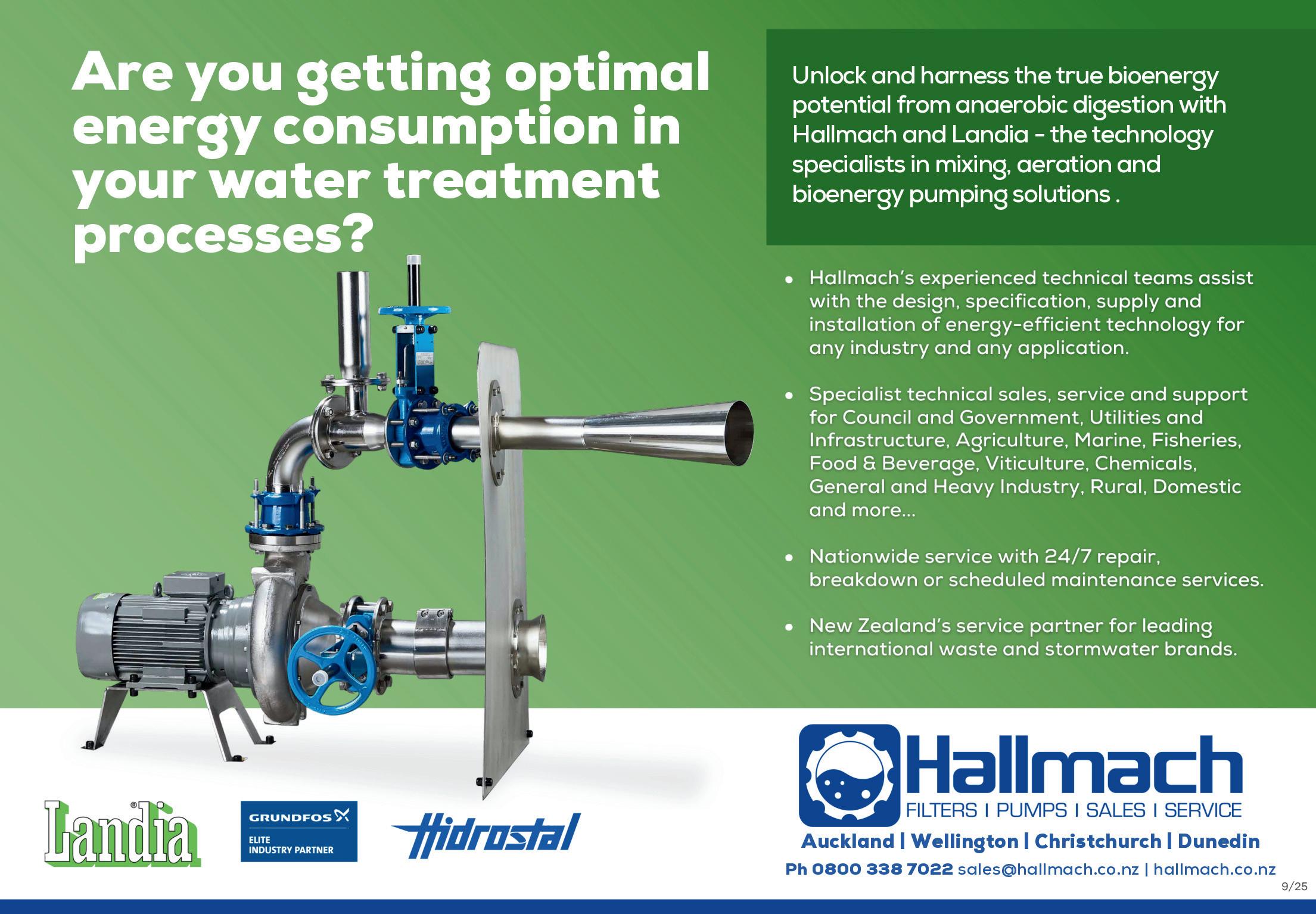

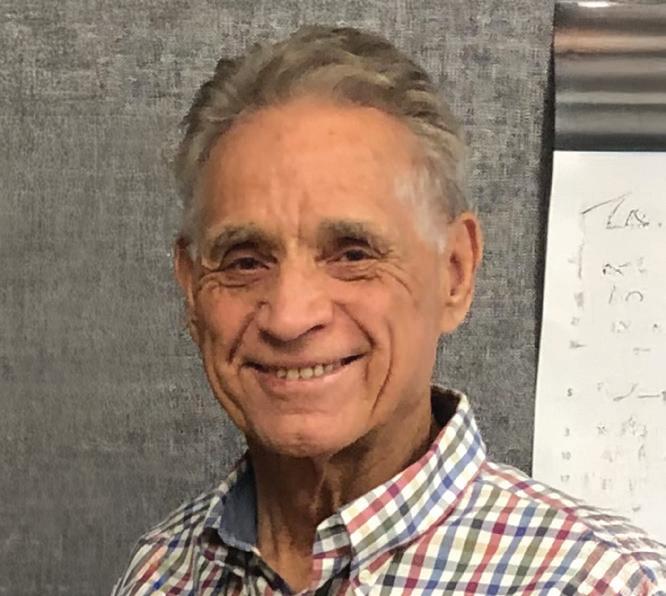
Lew was born into a family with over 100 years of drainage pipe manufacturing under their belts, and he started working in this industry with his father at just six years old. This paved the way for his first job after leaving school – working for a hydraulic engineering firm.
Here he learnt the fundamentals of water – pumping, irrigation, etc. He went on to install some of Canterbury’s first large irrigators.
Later, when Lew moved to a lifestyle block with his young family, he became concerned about the ground water implications from the old-style septic tank and domestic wells on his block.
Inspired by other ‘can-do’ Kiwis, Lew retreated to his garage workshop and tinkered with ideas around improving the performance of the wastewater system on his own property. This eventually led to the formation of his own wastewater treatment company, Oasis Clearwater, in 1992. Lew built this business into a highly
Lewis ‘Lew’ Austin
13/02/1949 – 27/03/2025
Lew Austin will be a name familiar to many in the onsite wastewater industry, having pioneered aerated systems during the 1990s and established two very successful companies designing and manufacturing onsite wastewater treatment systems.
successful national company, eventually selling to a major national corporate in 2011.
Lew’s journey through life wasn’t all plain sailing, he became very ill during the late 1980s and eventually required a liver transplant. At the time, these operations weren’t performed in New Zealand, so this necessitated a major fundraising effort and an eventual move to Australia to receive the surgery. The successful surgery was performed in 1991 and Lew returned to New Zealand with his family.
Never one to feel sorry for himself, he never let this hold him back despite the frequent doctors visits and loads of medication.
After the sale of Oasis Clearwater, Lew spent the following few years establishing a commercial development in Rolleston, and also starting a concrete precast business, Quality Precast Concepts.
Then Lew’s thoughts turned to wastewater treatment again and, in
2016, he opened a new company –Austin Bluewater. Initially intended to be just a small company, Lew’s industry connections and a new ground up product design incorporating his learnings over the previous decades played a major role in growing Austin Bluewater to the company it is today.
Lew passed away peacefully on the morning of the 27th March 2025 surrounded by family at the age of 76 years.
Lew was a friend and mentor to many, he was liked and respected by his staff and customers alike and he will be missed by many. Lew’s passing leaves a hole in the industry that will be hard to fill. There are few people with the knowledge and experience that Lew had.
Both Lew’s daughter Melissa and son Kirk are actively involved in the running of the company, and along with the team of loyal and dedicated staff this will ensure Lew’s legacy lives on in Austin Bluewater.





Doing what she loves
This year’s Young Stormwater Professional of the Year, Sarah Nolan, is a senior healthy waters specialist with the Auckland Council. Her passions for both the environment and te ao Māori means she is thriving in and absolutely loving her career. By Mary Searle Bell.

Sarah’s love of nature developed while growing up on dairy farms in rural Auckland, relishing in the streams and waterways on the land and building a love and knowledge of native flora and fauna. As a teen, she became involved with the South Kaipara Landcare community group, helping with riparian planting at South Head.
She started a degree in applied science at Unitec, with the dream of becoming a vet nurse but soon found that while she loved animals, she wasn’t built for nursing. So, she switched majors to biodiversity management.
“I really enjoyed it – the fact it was aligned with te ao Māori and that it was so hands on really spoke to me.”
One-and-a-half years into her degree she got a rather dull job at Healthy Waters, combining full-time work with full-time study.
“My job involved looking at drainage plans for residential properties to see if they had combined sewage or not. Let’s just say I listened to a lot of good podcasts!
“After six months of this, I went to my general manager and said I’d like a change, that I’d like to get out and about. He was impressed with my proactive approach and I transferred into waterways planning.”
In this role, Sarah was helping farmers fence off streams for planting – working out where the fences should be to protect the waterways without losing valuable grazing land.
Sarah then got involved in the Hōteo Sediment Reduction Project, helping restore the Hōteo catchment to reduce the amount of sediment flowing into the Kaipara Harbour. The Hōteo is Auckland region’s biggest river, meandering 28 kilometres through farmland and exotic forest, with only small areas of native forest and wetland remaining in protected areas and reserves. The river is a big contributor to sediment build-ups that stress the freshwater and marine environments.
Sarah was project manager and working with a team of geomorphologists in the US to trial new natural engineering solutions to reduce stream erosion called GEMS (Geomorphically Effective Management Solutions): “We were looking at stream bank erosion mitigations; not fencing and planting or concrete solutions, but seeing what else we could try that works with the stream.”
The council’s work is being done in partnership with landowners, mana whenua, and the community.
“The project started off very ‘science-y’ but as the partnership with mana whenua grew, it became more holistic, and the local iwi are now responsible for monitoring the catchment using both western techniques and cultural ones.”
This relationship with local Māori sparked Sarah’s interest in her own Māori heritage.
“I am of Ngāti Whakaue in Bay of Plenty/Rotorua but didn’t
really have much connection with my iwi growing up. It’s still a work in progress – I’m still a bit shy about it and have imposter syndrome – but the water industry is very encouraging, especially people like Troy Brockbank [Te Mana o te Wai lead at Beca] and Emily Afoa [pou whakarae at Tektus].”
Troy has worked alongside Sarah and describes her as an exceptional professional, demonstrating “remarkable leadership, dedication, and advocacy for te ao Māori, te mana o te wai, and kaupapa Māori.
“She has made an outstanding contribution to the stormwater sector, championing both technical excellence and cultural intelligence,” he writes in support of her award nomination.
“Her ability to engage meaningfully with iwi and hapū reflects her deep respect for tikanga and mātauranga Māori, and she actively integrates these principles into water management strategies.”
Scott Speed, principal integrated water management lead at Jacobs agrees.
“Sarah’s ability to engage with diverse partner agencies, including local iwi, the Ministry for the Environment, landowners, community groups, and industry stakeholders like NZ Beef and Lamb, was crucial to the project’s success,” he wrote in his endorsement of her nomination. “The methodologies she developed in collaboration with local iwi and hapu of the Hoteo are now recognised as best practices for implementing te mauri (mana) o te wai both within the Auckland region and nationally.”
He says that since she joined the Healthy Waters’ waterways

planning team in 2017, Sarah has demonstrated exceptional growth: “Her rapid progression within the department is a testament to her dedication and expertise.
Sarah has been with Healthy Waters for almost eight years now and says she feels so lucky to have found her ‘thing’ so early on in her career.
“I’m very passionate about the things I care about – like the environment and my culture. I love how my job allows me to work with iwi, farmers, and mana whenua. It adds richness to my work. And I love plants and native trees. I get to do everything I could possibly want!
“I feel very lucky to work in Healthy Waters – it has a staff of nearly 300 and they’re all so lovely, and we have a great leader in Craig Mcilroy.”
Craig also supported her nomination for Young Stormwater Professional of the Year, citing both her work on the Hōteo project as well as the Tāmata Hills restoration work. To date, this project is the largest native planting restoration project in the country, with over 750,000 native plants planted on highly eroding land, streams, and wetlands in one season, with all labour delivered by local iwi.
“These projects demonstrate [Sarah’s] ability to work in a highly effective and collaborative sense.”
As for Sarah, she is happy to have found her niche, although she admits that winning the award was one of the best moments of her life.

About Us
Steel Mains is a leading manufacturer and supplier of complete steel pipeline systems into the New Zealand market for the transportation of water and wastewater, offering a total solutions approach to our customers.
Contact Us
NEW ZEALAND SALES OFFICE
A: 59-63 Forge Road, Silverdale, Auckland 0932, New Zealand
Peter Summers (NZ Sales Manager)
P: +64 027 387 8619
E: petersummers@steelmains.com
Market Brochure Watercare
Approved Supplier



Bringing international expertise
The USA’s loss is our gain, as David Romilly leaves his native country to embrace all that’s great about Aotearoa New Zealand, bringing with him a wealth of international experience in both biosolids and water reform that can only benefit our water industry. By Mary Searle Bell.

David always wanted to be an engineer, so after finishing school he enrolled at Penn State University to study environmental systems engineering, completing his degree in 2002.
Describing the beginning of his career, he says he “landed in the soil and groundwater remediation space” but soon found it “didn’t scratch the itch”. So, he moved to a civil engineering firm where he did design work, but it, too, wasn’t exactly what he was after.
“I then came to work on a wastewater project and had an ah-ha moment – I don’t know if it was the people I was working with or the project itself, but I found myself really enjoying the work.”
At the time, Great Bay on the East Coast of the United States was going through a review of its wastewater discharge limits, particularly around nitrogen and phosphorus. Sixteen communities were moving from very generous permit limits to very tight ones, and David says he saw a lot of fighting between regulators and communities, saying the permit changes brought huge financial impacts to the communities.
As an engineer, however, the change in discharge limits meant a lot of big wastewater projects were put into action.
“It was fascinating to me, and I gained a huge amount of knowledge – it really jumpstarted my career.”
After nearly a decade consulting for wastewater engineering firms, David was shoulder tapped by a large water service provider in Portland, Oregon, on the West Coast. The role had him overseeing two of the district’s four large wastewater treatment facilities, where he implemented upgrades and optimised operations.
“This job also showed me the client side of things – I spent six years as a client rather than a consultant, which was super valuable.”
And this is where the desire to move to New Zealand evolved: “I was loving my role, but changes in the organisation had me pondering my options.
“Coming out of Covid, I saw three waters developing in New Zealand and wanted to be involved. I had seen some exciting projects come about through the Clean Water Act.
“I thought three waters would be the same for New Zealand. Tack on the beautiful location and the opportunities for my children, and we took a leap of faith.
“I found a job [with Aurecon], sold everything, and moved the family across in early 2023. Then in October of that year, three waters was repealed, changing everything as uncertainty came in.
“I have no regrets now, but there were difficult days and sleepless nights. The family has integrated well so we’re in no rush to move on. We’re permanent residents now and will become citizens in a few years, which we’re all very excited about.”
To fill the gap following the change in the three waters reform, David had to be nimble. He found work in Australia, which gave him a springboard into the biosolids space, an area he says he’s passionate about. He now chairs the biosolids sub-group for Water New Zealand’s wastewater special interest group.
“That Australian project was around the advanced thermal treatment of biosolids – a gasification process. Back in 2017 I was looking at that same technology in Portland to add as part of the wastewater treatment portfolio, specifically to target PFAS.”
He says advanced thermal treatment offers reductions in greenhouse gas emissions, it sequesters carbon and locks up heavy metals.
“Once we can unlock the economic side of things, we will see a greater uptake of this technology, and this is where regulator, consumer, and cultural buy-in comes in. It is coming in the US and Australia, and I think in 20 years time we’ll say, of course we do that – it’s standard practice.”
David brings a wealth of international experience to our water industry but also valuable reform experience and is very keen to help Aotearoa New Zealand raise the quality of its wastewater discharges.
“The Aotearoa New Zealand Standards have been unpacked, and it has been controversial. I can see both sides of the debate.
“Here, as well as around the world, we want the technological advancements and ideas, and we’re pushing the environment, but it’s important we don’t forget to do the basics well.
“I’d love to see a framework that continually improves on that baseline. Granted, a 35-year consent implies a stagnancy – it won’t

be reviewed – however, it does provide reliability for the community and protects against political change.”
David says we can learn a lot from overseas: “The UK, Australia, US, Denmark, Germany, and Singapore are all doing very cool things around emerging contaminates but in different ways.
“I would love to see a future with a simplified and unified approach, but at the same time, competition is good. It would be good if the world gathered around and said, this is the best approach, but I realise this is utopian and unrealistic.”
David says there are some great projects underway locally in this space.
“The cultural factor is a big influence on the way New Zealand does things and gives an added perspective. Finding a solution that’s best for both sides is key.
“It is important to get conversations going quickly so we can find solutions that are right for the environment, and right culturally and economically. We’re getting there, and I’m cautiously hopeful, but there are always unknown factors that can crop up, such as microplastics and PFAS.”
He says we need to assess our environmental ambitions against the economic aspects of that vision, and then, “let’s go plus one, because its better for the environment”.
“Innovation is key, as is getting public buy-in, and this requires good leadership. With the right people and the right chemistry, we can make real progress.”
In October, David will move to a new position with Lutra, as chief engineer leading their water and wastewater treatment specialists.
Ovarro Leads Global Automation Resilience with Kingfisher RTUs
Automating New Zealand’s water networks for nearly three decades, Kingfisher RTUs are now launching globally with Ovarro Technologies. Known for reliability, modularity and resilience, Kingfisher RTUs are widely deployed across local councils and utilities, supporting critical infrastructure in some of the harshest environments.
Designed for Rapid Response
Equipped with leading capabilities, Kingfisher RTUs enable critical industries to securely monitor and control assets and detect faults in real-time. With an OLED front display and no PC required, operators can quickly respond to issues directly in the field. From communication and power faults to module errors, operators can download service reports and take rapid action, minimising the risk of failure.
Tailored Solutions Engineered for Endurance
CSE WAF delivers cost effective solutions that safeguard individuals, protect valuable assets and optimise performance with leading RTU, Radio, HMI and SCADA technology.
Comprehensive redundancy
Supporting multiple DNP3 Masters
Low power operation
Operating range of -40 to 85°C
Compact IO processor cards
OLED local display for fast response
Large removable wiring terminal
SD card cloning for disaster recovery

With a team of specialist engineers harnessing over 90 years of experience, CSE WAF delivers specialised solution design, integration and installation to New Zealand’s water industry. Paired with tailored training and demonstration units, CSE WAF enhances operational efficiency and solution lifecycle.



OLED






Collaboration achieves financial wins for the Waikato
When Waikato Waters officially sprang to life on 24 July 2025, it didn’t arrive with the noise of bursting pipes. It came with the quiet confidence of a well-tuned pump, ready to move the region’s water services into a more financially-sustainable future.
The genesis of Waikato Waters began with a hui between iwi chairs and the councils of the Waikato in 2023 and emerged with a sevencouncil Heads of Agreement in December 2024. This early and sustained collaboration enabled a united and adaptable approach to the Government’s Local Water Done Well framework.
The largest grouping of councils in Aotearoa New Zealand, Waikato Waters will be operational on 1 July 2026, delivering water supply and wastewater services for the first three councils – Waipā, Waitomo and South Waikato – with three others completing the transfer of services by 1 July 2027*.
The new organisation has recently announced its Establishment Board, comprising chair Elena Trout and directors Jon Lamonte and Jaydene Kana.
Don Mcleod, independent chair of the Shareholders Representative Forum, says the forum looks forward to working with the chair and board over the next few years to ensure that the needs of the community are communicated and understood by the company in providing these essential services.
Waikato Waters establishment progamme director Vaughan Payne says Waikato Waters is more than an administrative shuffle.
“The Waikato Waters kaupapa provides a catchment-based approach, enables the region’s bargaining power to be strengthened and has a financial strategy designed to save ratepayers hundreds of millions.”
Meeting the mandate
Local Water Done Well set the bar high and timeframes have been tight.
Not only did councils have to articulate the ring-fencing of water and wastewater services, they needed to communicate and consult with their communities on preferred options – one of which was the proposed new waters entity called Waikato Waters.
Council decisions throughout June and July were largely premised on the benefits of being able to deliver a financially sustainable and regulatory-compliant service, as well as other benefits such as scaling up workforce and procurement opportunities.
Local mayors and council chief executives described the overhaul as the biggest, most important legacy decision they have had to make since council amalgamations in 1989.
Minister of Local Government Simon Watts called the Waikato collaboration a standout: “This collaboration means that cost increases necessary to fund vital infrastructure are more affordable for ratepayers.”
The Waikato Waters family
Waikato Water Done Well (WWDW) brought together Hauraki District, Matamata-Piako District, Ōtorohanga District, South Waikato District, Taupō District, Waipā District, and Waitomo District.
These councils represent about 40 percent of the Waikato region’s population – a bloc big enough to negotiate from strength, but small enough to focus on local priorities.
Waikato Waters Ltd will have more than $1.6 billion worth of water infrastructure assets and will own, manage, and maintain drinking and wastewater infrastructure for over 60,000 customers. It will generate $155 million in revenue by July 2028.
Hauraki mayor Toby Adams summed it up: “We crunched the numbers… the economies of scale and service efficiencies are what we need. Holistically, it’s also the right approach.”
Without collaboration, smaller councils risk higher procurement costs, workforce shortages, and reduced investment capacity. WWDW turns those risks into negotiating strength.
In isolation, these seven councils represent anywhere from two to 12 percent of the region’s population. Together, they control 40 percent,
giving them procurement muscle for better contractor pricing; workforce pull for a stronger ability to attract and retain skilled staff; and strategic leverage, for more influence regionally and nationally.
“The WWDW model recognises that there are both value and benefits with scale around provision of water and wastewater services and the door remains open to future collaboration with other councils and CCOs” says Waipa mayor Susan O’Regan.
The Brad Olsen review
Chief economist Brad Olsen from Infometrics gave the WWDW modelling an independent forensic once-over in July 2025. His verdict? The numbers stack up, and then some.
Lower immediate revenue needs: Under the status quo, individual councils would need higher immediate revenues (rates or water charges) to cover soaring infrastructure costs. The WWDW model allows for pooled debt-funding and efficiency gains, lowering the upfront burden on ratepayers.
Debt done right: Water assets last 40-100 years. Funding them with short-term rates punishes today’s residents for infrastructure they won’t wear out. Under WWDW, debt peaks at around 460 percent debt-to-revenue, below the Local Government Funding Agency’s 500 percent ceiling, then gradually declines – spreading costs across the generations who’ll actually use the assets.
Long-term household savings: By 2044, the modelling projects average per-connection savings of $940 per year compared with the ‘go it alone’ option. Regionally, that’s $580 million in cumulative savings. Over 20 years, each household saves about $8000.
These savings don’t magically appear overnight – efficiency gains are phased in over 15 years. As Olsen’s report notes, the 10-year view is modest, but “the sooner a change is made, the sooner benefits are realised.”
Built-in resilience: Sensitivity tests pushed setup costs 60 percent higher and trimmed efficiency gains by 10 percent, yet the model still held up financially.
Conclusion
For the water industry, Waikato Waters’ launch shows how regional CCOs can be tailored to local needs while meeting national reform requirements. It’s proof that Local Water Done Well can be more than compliance; it can be a competitive advantage.
The WWDW approach demonstrates that:
• Scale matters – both for cost savings and influence;
• Debt can be strategic – when used to spread asset costs fairly;
• Savings are real – even in conservative modelling scenarios;
• Collaboration is future-proofing – protecting smaller councils from being left behind.
While every region’s dynamics differ, the principle holds: bigger isn’t just better, it’s often cheaper.
Waikato Waters isn’t a silver bullet for all of our region’s water and wastewater challenges but it is a well-aimed shot at the heart of financial unsustainability.
The model takes the government’s LWDW requirements and turns them into a tangible win for councils and ratepayers.
Article supplied by Waikato Waters.



Hamilton-Waikato Joint Water Services Delivery Plan marks historic milestone
The water services landscape has reached a pivotal moment with the formal approval of the country’s first joint council Water Services Delivery Plan (WSDP), setting a precedent that could reshape how local authorities approach critical infrastructure challenges across the nation.
On 23 July 2025, the Secretary for Local Government formally approved the Hamilton City and Waikato District Councils’ joint WSDP, marking a significant achievement under the Government’s Local Water Done Well (LWDW) framework. This landmark decision establishes the foundation for IAWAI – Flowing Waters, Aotearoa New Zealand’s first joint council-controlled organisation (CCO) for water services, which will serve approximately 280,000 people across 91,000 connections.
A collaborative vision realised
The success of this initiative reflects exceptional leadership and vision from both councils, who recognised that collaborative approaches could deliver superior outcomes for their communities while maintaining local control over essential services.
The joint working group demonstrated that councils can work together effectively on complex infrastructure challenges, setting a new benchmark for inter-council cooperation in New Zealand.
Keith Martin, Waikato District Council three waters manager, emphasises the significance of this collaborative approach: “This represents a genuine step forward for collaborative local government in New Zealand. Our joint working group was determined to show that councils can work together effectively on complex infrastructure challenges.”
The development of the WSDP required extensive planning and coordination, bringing together technical asset management expertise with regulatory knowledge to deliver a comprehensive plan within demanding timelines. The plan was submitted in early July and approved within weeks, demonstrating both the quality of the submission and the councils’ proactive approach to meeting government requirements.
Maire Porter, Hamilton City Council unit director three waters, highlights the foundation this creates: “The approval of the plan is a direct result of the commitment, expertise, and collaboration of our teams. They navigated a complex process under tight timeframes, all while keeping our communities front of mind. This milestone is not just about compliance, it’s a testament to the skill, dedication, and teamwork that will shape the future of water services in our region.”
Comprehensive infrastructure investment framework
The approved WSDP encompasses a robust 10-year investment strategy totalling $3.6 billion in shared water services infrastructure. This substantial commitment addresses the critical need for infrastructure renewal and expansion, with 67 percent of the investment driven by growth requirements reflecting the region’s expanding population and economic development.
The plan’s comprehensive scope includes a detailed transition
strategy for establishing the joint CCO, ensuring seamless continuity of services during the organisational change.
A carefully developed financial sustainability framework addresses affordability concerns for ratepayers across both council areas, recognising that sustainable water services must remain accessible to all community members.
Growth-enablement planning forms a crucial component of the strategy, supporting new housing developments and business expansion while ensuring infrastructure capacity keeps pace with regional development.
Environmental protection measures specifically address the cultural and ecological significance of the Waikato River, demonstrating the councils’ commitment to environmental stewardship alongside infrastructure development.
Financial sustainability and enhanced capacity
One of the most significant advantages of the joint approach lies in its ability to make vital infrastructure investments more affordable for ratepayers while maintaining service quality and reliability. The collaborative model enables both authorities to access enhanced borrowing capacity through the Local Government Funding Agency, providing greater financial flexibility for essential infrastructure projects.
This improved financial position allows for more strategic longterm planning and investment, ensuring that critical infrastructure upgrades can be implemented without placing unsustainable financial pressure on individual councils or their ratepayers. The model demonstrates how collaborative approaches can unlock financial efficiencies that benefit all participating communities.
Setting the stage for regional expansion
The Hamilton-Waikato collaboration has been deliberately designed as a stepping stone toward potential regional expansion. Both councils have committed to considering a larger Waikato-wide model over time, recognising that further collaboration could deliver additional benefits for the broader region.
This forward-thinking approach acknowledges that water infrastructure challenges often transcend individual council boundaries, and that regional solutions may provide optimal outcomes for service delivery, environmental protection, and financial sustainability. The success of the initial two-council model provides a strong foundation for future expansion discussions.
Collaborative development process
The development process was supported by specialist technical and regulatory expertise, with the KPMG-Aurecon partnership providing essential support throughout, combining asset management planning
capabilities with regulatory knowledge to ensure the WSDP met all government requirements while delivering practical solutions for the councils.
Dr Deborah Lind, Aurecon water industry lead, notes the significance of the councils’ leadership: “We'd like to acknowledge the exceptional leaders from both councils for contributing to the success of the WSDP. The collaborative approach to one of New Zealand’s most complex infrastructure challenges demonstrates what’s possible when local government leaders commit to working together.”
National implications and growing momentum
The approval comes at a critical time for water infrastructure, with over $120 billion needed for aging water infrastructure upgrades over the next 30 years. The Hamilton-Waikato model provides a practical pathway for achieving these essential upgrades while keeping costs manageable for ratepayers across the country.
The momentum behind collaborative water services delivery is already building. Just days after the Hamilton-Waikato approval, Whangārei District Council voted unanimously to establish a Northland-wide CCO, bringing together three councils to serve over 100,000 consumers. This rapid adoption suggests that the collaborative model resonates with local authorities facing similar infrastructure challenges.
Operational implementation and future outlook
IAWAI – Flowing Waters will become fully operational from July 2026, taking responsibility for managing everything from wastewater
plant upgrades to long-term growth strategies. The new entity will oversee critical infrastructure projects while maintaining the local accountability and community connection that both councils prioritised in their planning process.
The successful implementation of this joint CCO will be closely watched by other local authorities, as it will provide practical insights into the operational realities of collaborative water services delivery. The lessons learned from this pioneering initiative will undoubtedly inform future collaborative efforts across the sector.
A new standard for water services delivery
The Hamilton City and Waikato District Councils’ achievement represents more than just regulatory compliance; it demonstrates a new paradigm for addressing water infrastructure challenges. By proving that collaborative approaches can deliver better services, more affordable costs, and stronger communities, these councils have established a benchmark that other authorities can aspire to achieve.
As Aotearoa New Zealand grapples with the substantial investment required to maintain and upgrade essential water infrastructure, the Hamilton-Waikato model offers hope that sustainable, affordable solutions are achievable through collaborative leadership and strategic planning.
The success of this initiative may well mark the beginning of a new era in the country’s approach to water services delivery, where collaboration becomes the foundation for resilient, sustainable infrastructure that serves communities for generations to come.
Article supplied by Aurecon



Water works: Tracing investment over time
Getting our infrastructure right is critical to success as a country and to the future we give for the next generation of Kiwis. The New Zealand Infrastructure Commission Te Waihanga is working to take this long-term view with the development of a National Infrastructure Plan, which we’ll provide to the Government at the end of the year. By Peter Nunns, general manager – strategy, New Zealand Infrastructure Commission
Already we’ve released a draft plan that shares where we’ve got to so far. The draft plan highlights the four areas where change can make the biggest impact in improving the way we invest in our infrastructure.
Those four areas include: establishing affordable and sustainable funding, clearing the way for infrastructure, starting with maintenance, and right-sizing new investment.
As part of getting those four areas right, we’ve looked across the entire system to develop a coordinated view of what we can afford and what we need.
Change will mean different things for different sectors. All infrastructure sectors will need to continue maintaining and renewing existing assets, as well as investing in new infrastructure. Individual sectors, however, each face different opportunities and challenges. The recently released draft Plan outlines our current view of challenges facing water networks, alongside other sectors.
In this article, I’d like to share some of the things we’re seeing and check to ensure that lines up with what those of you working in the sector are seeing.
Looking back
Access to clean drinking water and sanitation is a basic human need. New Zealanders think that it’s important to have enough clean water, particularly safe drinking water.
Kiwis have also seen investment in water networks as a key priority. As many as one in three dwellings had access to piped drinking water as early as the 1880s (Figure 1). Following a big push on drinking water and sewer construction in the first half of the twentieth century, piped drinking water and indoor toilets were near-universal by around 1970.
During this period, the country invested consistently, and sometimes at quite high levels relative to the size of our economy, in developing water networks.
To help develop our advice on future infrastructure investment demands for the National Infrastructure Plan, we have looked back to understand how we’ve historically responded to our investment needs.
For water networks, we compiled historical estimates of investment back to 1885, relative to the size of our economy. We’ve also made some high-level estimates of depreciation on infrastructure assets over this time. These show how fast we’re investing in our networks and how fast those networks are wearing out (Figure 2).
Water infrastructure investment declined after we finished
building networks in the early 1970s. By the 1980s, New Zealand was among the lowest-spending countries in the OECD when it came to water infrastructure.
Between the mid-1970s and mid-1990s, we estimate that depreciation on existing assets exceeded investment in new and replacement assets. Every year for almost 20 years, water networks were wearing out faster than we were reinvesting in them. Many of the challenges that we are currently facing in water networks started at this time.
Catching up
Past under-investment in maintaining and renewing our water networks is costing us today.
Starting in the late 1990s, however, water investment lifted substantially, back to what we were spending when we first built our water networks.
Over the past decade, we have been near the top of the OECD in terms of the share of our economy that we’re investing in water infrastructure. In dollar terms, we’ve been catching up on the backlog. That trend in investment appears to be continuing, with council long-term plans showing a substantial lift in renewals investment.
In the past, councils were planning to spend less on asset renewal and replacement than they were incurring in depreciation – meaning that networks would continue to deteriorate. Today, more councils are investing up to the required level or even getting ahead.
Where we are currently
To better understand how our existing water networks measure up, we benchmarked them against other OECD countries. We focused on eight comparator countries that are most similar in terms of income, population size, urbanisation rates, and terrain: Chile, Greece, Spain, Czechia, Canada, Finland, Sweden and Iceland.
Relative to our peers, our water networks are typical on most measures. In quantity terms, we have a slightly below-average share of population connected to public water and wastewater networks, slightly above-average drinking water pipe length per capita, and slightly below-average wastewater pipe length per capita.
In terms of network quality, consumers rate reliability of water supply as slightly below average, and mortality rates associated with poor water quality are below average.
While leakage from poorly maintained water pipes in some towns and cities has received some public attention, international comparisons suggest that our leakage rates are fairly typical. In New

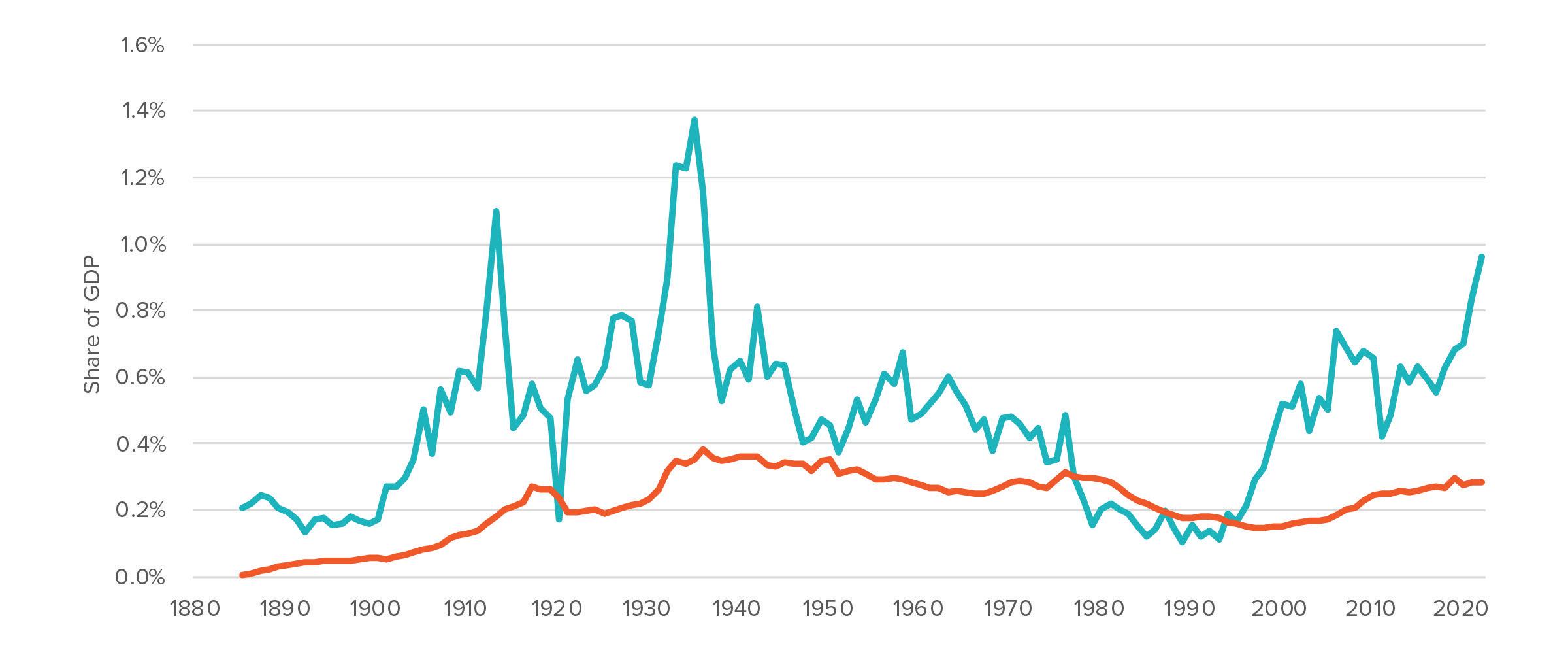
Zealand, non-revenue water accounts for 22 percent of total public water supply. Non-revenue water ranges from 17 to 30 percent in our comparator countries.
Water usage is where we stand out the most. Whether we compare ourselves based on total water use (including for agriculture) or water used for public water supply, Aotearoa New Zealand is among the highest users in the OECD (Figure 3).
We use 253 cubic metres of drinking water per person, per year, which is only exceeded by Iceland. In growing areas, this might mean that key aspects of our water networks, like water and wastewater treatment plants, hit capacity faster than they would in our peer countries.
The investment outlook
In the draft National Infrastructure Plan, we published forward guidance on future investment demands across several infrastructure sectors, including the water and waste sector, at the national level.
These projections are based on what we know about what we’ve invested in the past, how fast existing infrastructure assets are wearing
out, how rapidly network demand might grow given national-level population and economy projections, what costs we can expect to incur from natural hazard events, and how fast construction prices may rise based on historical trends.
We’ve compared our projections against planned spending in the water and waste sector, from councils’ 2024 long-term plans (Figure 4). These highlight some areas of similarity and some differences.
At a national level, planned renewal spending seems to be roughly in line with what we would expect given the size of the network and how fast water assets depreciate. This is good news – if this investment is delivered efficiently and on time, planned spending levels should enable us to stabilise and improve asset condition.
On the other hand, planned spending on demand growth and level of service is higher than we would expect, given international comparisons of water network coverage, national-level population growth projections, and income growth trends.
This could reflect the impact of factors that are not captured in our modelling, like concentrated population growth that is driving high investment needs in specific places or the need for significant
Figure 1. Water network coverage over time, 1885-2022. Source: New Zealand Infrastructure Commission estimates. Estimates for 1886 and 1906 are derived from various historical data sources and should be treated as less reliable. Estimates from 1945-1971 and 2018-2023 are based on Census data, but the wording of questions changed between 1971 and 2018.
Figure 2: Estimated capital investment in and depreciation on water and waste infrastructure assets, 1885–2022. Source: New Zealand Infrastructure Commission estimates based on data from the NZ Official Yearbook (1885-1971) and Statistics New Zealand National Accounts (1972-2022). Pre-1972 estimates should be treated as less reliable than post-1972 estimates.

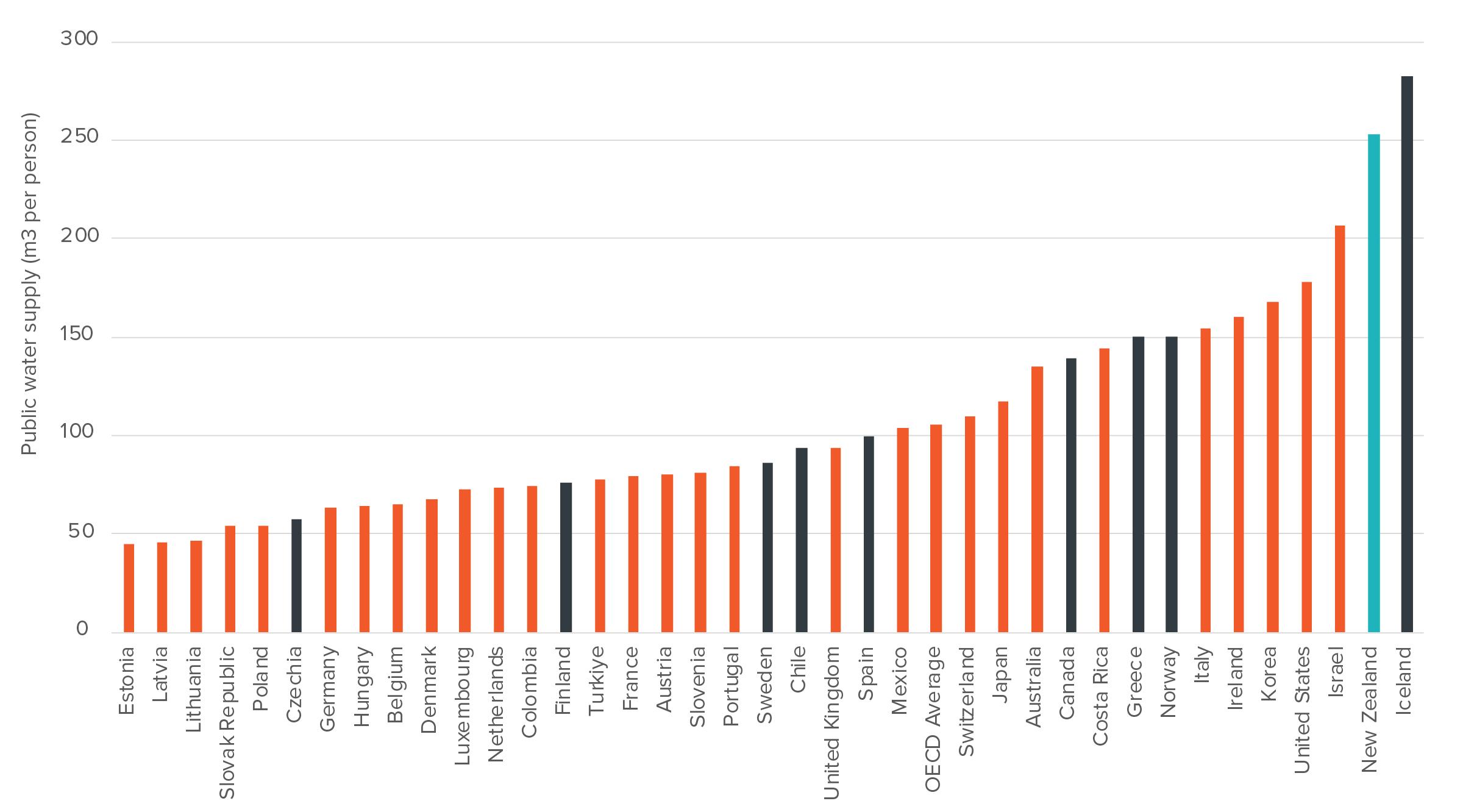
Public water supply (m3 per person)

Demand growth
Level of service changes
Construction price inflation
4: Comparison of our forward guidance on water and waste investment with council long term plans for 2025-2034. Source: New Zealand Infrastructure Commission analysis. We have standardised the categories we use for reporting investment demand drivers to roughly align with the categories used for council long-term plan reporting. We consider the ‘demographic change’ demand driver to relate to the ‘demand growth’ category, and the ‘income change’ and ‘natural hazard risk’ categories to relate to the ‘level of service category’. Councils do not separately report on expected inflationary pressures over long term plan periods.
investment to address asset ‘backlogs’ that are leading to poor environmental or health outcomes in specific places.
Alternatively, it could highlight opportunities to ‘work smarter, not harder’, for instance by using demand management measures to defer major growth investment or by growing in places with spare capacity on existing networks.
Looking beyond the near term, our forward guidance paints a positive story for people who use and pay for water networks. Right now, water charges and water rates are rising faster than incomes to pay for catching up on a backlog that was decades in the making.
But we’re not going to be catching up forever. Our outlook is for water investment to normalise once we have caught up. At this point, water bills should be getting more affordable relative to incomes.
We can’t afford to return to the artificially low spending we saw
between the mid-1970s and mid-1990s. But if we can plan and deliver investment efficiently, the spending levels we sustained through the 1950s, 1960s, 2000s, and 2010s should be enough to meet our future water needs.
We’re interested in your views
We’re currently drafting the final National Infrastructure Plan and are keen to ensure we’ve got it right when it comes to understanding the needs, challenges and opportunities in the water sector.
Although our feedback period has finished on the draft plan, you can read it at tewaihanga.govt.nz/national-infrastructure-plan/ feedback-on-draft-national-infrastructure-plan, and please feel free to contact our team at info@tewaihanga.govt.nz if you’d like to share your insights or if you’d like to learn more.
Figure
Te Waihanga forward guidance
Council Long Term Plans
Figure 3: Public water supply use per capita in OECD countries. Source: OECD, World Bank Development Indicators


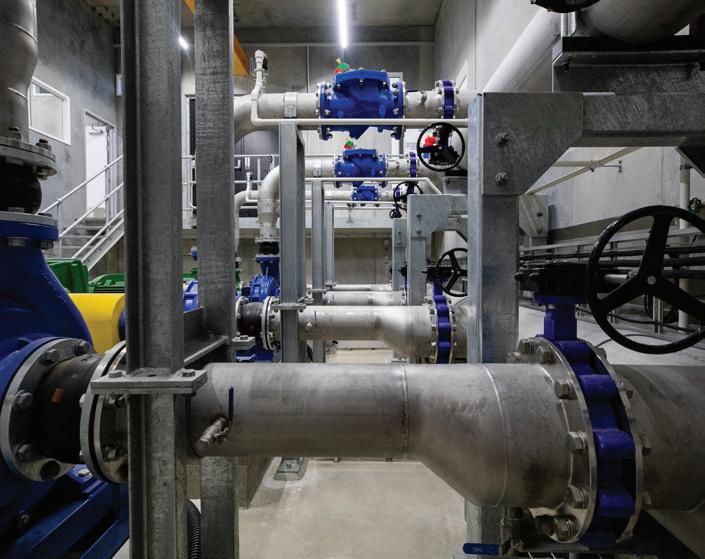
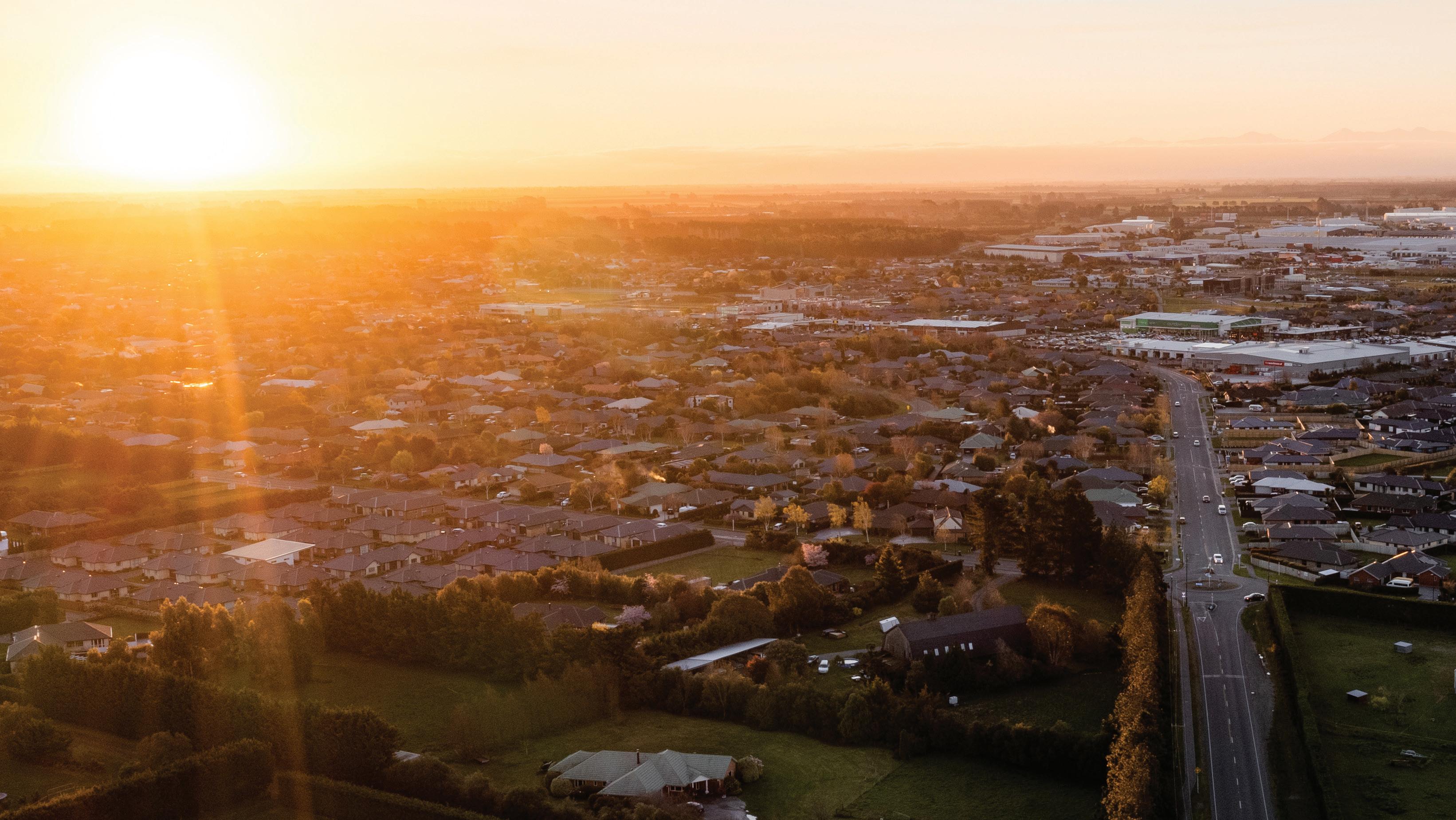

Legal update
In line with other articles this year, this piece continues to provide a brief update on where applications are up to under the Fast-Track Approvals Act 2024. It also reflects on the submission made by Water New Zealand on the Government’s National Direction and re-looks at the environmental policy world a little further. By Helen Atkins.
Fast-Track Approvals Act 2024
Since June, there has been some progress with applications under the Fast-track Approvals Act, which are listed here to provide a snapshot of what is happening in this space and to demonstrate how much has changed since the April journal.
Bledisloe North Wharf and Ferguson North Berth Extension (Auckland Port). This application was referred to in the April article. The project has now been decided and the decision is publicly available.
Delmore (residential development in Auckland). This application is at the panel stage with the decision due 17 September 2025.
Maitahi (Nelson mixed use development). This application was referred to in the April article. The project is now at the decision phase with a draft decision and proposed conditions now being publicly available. A final decision is imminent.
Milldale (residential development in Auckland). This application is at the panel stage with the decision due 7 October 2025.
Sunfield (mixed use development in Auckland). This application is at the panel stage with the decision due 12 November 2025 (note the application is currently on hold so the dates will shift).
Drury Metropolitan Centre (mixed use development in Auckland). This application is at the panel stage with the decision due 20 October 2025 (note a suspension in the timeframe means the decision is now due 27 October).
Waihi North (expansion of the existing gold and silver mining operations, including establishing new open pit and underground mines, and extending the life of the mine from expiry in 2030 to 2040). This application is now at the panel stage with the decision due 18 December 2025.
Tekapo Power Scheme (renewal of consents to continue to use, operate, and maintain the power scheme of Tekapo A and B power stations and substations). This application is now at the panel stage with the decision due 4 November 2025.
Ryans Road Industrial (industrial activity in Christchurch). This application is at the panel stage with the decision due 16 December 2025.
Drury Quarry expansion (Auckland). This application is at the panel stage with the decision due 27 November 2025.
Kings Quarry expansion (Auckland). This application is at the panel stage with the decision due 19 December 2025.
Rangitoopuni (mixed use development Auckland). This application is at the panel stage with the decision due 27 November 2025.
Taranaki VTM (Trans-Tasman Resources iron sands mining in the EEZ). The application is at the panel stage with a decision due 18 March 2026.
In addition to these projects there are also the following projects in the pre-panel appointment phase – Homestead Bay, residential development in Queenstown (panel setup is imminent) and Port of Tauranga – Stella Passage Development (panel setup is imminent). There is also a steady stream of referred projects that have passed through the Ministerial gateway – his approval phase. Once these projects have formally applied under the FTAA they will enter the same system as the listed projects.
RMA – National direction
The RMA national direction mentioned in the last article was submitted on by Water New Zealand in July. Next steps in the development are that the policy work will continue and make its way into legislation where there will be a further opportunity to make submissions.
Update on the new Resource Management Bill
The Resource Management (Consenting and Other System Changes) Amendment Bill (Bill) was being debated in Parliament on 12 August. A previous article has covered this Bill. An Amendment Paper was included in the matters to be debated.
This Paper has not been the subject of Select Committee scrutiny or public submissions and the Environmental Defence Society (EDS) had this to say about it (in a media release dated 12 August 2025):
“The Bill is bad enough, but the changes proposed in the Amendment Paper represent an egregious aggregation of power by Minister Bishop aimed at disempowering councils which protect the environment,” said EDS chief operating officer and lawyer Shay Schlaepfer.
“The proposed ability to override local democracy by the Minister is free from constraints, such as meaningful criteria, and is heavily biased towards development imperatives.“There’s nothing balanced here. The Government is systematically dismantling our environmental laws.
“The changes are unprecedented and challenge our constitutional norms and sense of fair play. It has to stop.”
In summary, the Amendment Paper (and some changes to the Bill proposes the following: Amendment or modification of policy statement and plans
A new regulation making power to the Minister allowing him to modify or remove provisions of a Regional Policy Statement or regional or district plan provided he is satisfied that:
• The provisions have a negative impact on economic growth, development capacity, or employment.
• They aren’t there because they recognise Treaty settlements (and other commitments like mana Whakahono a rohe).
• They don’t stop the plan giving effect to national policy statements or make it inconsistent with national environmental standards.
The Minister must go through a process, including an investigation to gather evidence, report on its findings, feedback from councils and consultation with parties likely to be affected. This power is singled to last until the end of 2027.
No new or changed policy statements or plans
There are to be no proposed plans and policy statements, changes to plans and policy statements, or any variations of those until the end of December 2027, unless an exemption applies or is obtained.
Where a proposed planning instrument
has already been notified and heard, this requirement will not apply but where the proposed planning instrument has been notified but not been heard or has a hearing set to begin more than 5 days after commencement of the legislative changes, the instrument must be withdrawn unless an exemption applies.
Some exemptions are automatic, instruments including:
• The streamlined planning process.
• The intensification streamlined planning process.
• Those that implement new national direction (after the legislation commences) if it requires it.
• The freshwater planning process to give effect to the National Policy Statement for Freshwater Management 2020 (NPS FM).
• Those called in or directed for changes by the Minister under s 25A/B.
• Those relating to natural hazards.
• Those giving effect to Treaty settlements, Kermadecs, Sub-antarctic islands.
Private plan changes are excluded too – but only if they haven’t been adopted by councils.
Councils can also apply for exemptions, with the Minister determining these based
on criteria, which include the following: to better enable water services; addressing unworkable and inefficient provisions; responding to RMA amendments; better managing climate change; managing erosion risk; upholding Treaty settlements; responding to a recommendation of the Environment Court; or to “Enable work to be progressed that, for any other reason, the Minister considers appropriate”.
Permitted discharges
There are changes proposed to allow a rule in a regional plan to permit a discharge that gives rise to a significant adverse effect on aquatic life where the regional council is satisfied those effects are already present in the receiving waters and the standards for the permitted rule would reduce those effects over a period of 10 years.
There is also an amendment to allow permitted rules for discharges that give rise to a conspicuous change in colour or visual clarity, and render fresh water unsuitable for consumption by farm animals, subject to regional council being satisfied of the same criteria (i.e. those effects already exist
and the standards will lead to a reduction in effects). Additionally, conspicuous floatable or suspended materials have been removed from the effects which prohibit a rule permitting a discharge.
Energy activity amendments
The Paper also includes an expanded definition of a ‘specified energy activity’ to include the establishment, operation, maintenance, or upgrade of thermal electricity generation facilities.
This means that the Bill will include new or upgraded fossil fuel generation facilities which is of concerns to NGOs, such as EDS.
The timing of these changes is that they will come into force the day after the Bill received Royal Assent, which is expected to occur in the last week of August.
With so much activity in the government sphere, including the fast-track regime the environmental work of the Courts has taken a back seat. The Courts are obviously still busy but there are no particular cases of note.
A snap-shot of relevant cases – some past but mostly present – will follow in the next journal article.

New Zealand's Pressure Sewer market leader since 2007
Residential and commercial grinder pump stations
Remote monitoring and control options
Feasibility and hydraulic design
Ownership, policy, and bylaw consultation
Installation and operations training
Lifecycle cost analysis
System health and condition assessment
In-house service and support
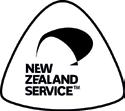
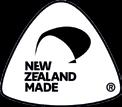



Preparing for emergencies deep underground

In September last year, the emergency sirens on Watercare’s Central Interceptor project sounded the alert as thick white smoke filled the tunnel constructed beneath Auckland city. As the workers made their escape, it became apparent that three people were missing, possibly injured, deep underground and would need to be rescued. Mary Searle Bell explains.
Fortunately, the emergency was just a training exercise, albeit a complex one involving a high level of coordination and cooperation between the many parties involved.
First, there was the asset owner, Watercare, for whom the massive tunnel will form its new wastewater pipeline, collecting sewage/stormwater from the existing old combined network and taking it to the Māngere Wastewater Treatment Plant.
Second, the workers from Ghella Abergeldie Joint Venture (GAJV), the tunnelling specialists charged with constructing nearly 20 kilometres of tunnels, more than 17 shafts, a major pump station and substantial wastewater management and network infrastructure works.
And third, an array of emergency services, including Mines Rescue Service, Fire and Emergency, St John, and Police.
GAJV’s site senior executive for the Central Interceptor, Paul Miles, says the project is being constructed under the mining and quarry regulations, which requires a particular level of emergency preparedness.
“Watercare and GAJV are working together to ensure we are well prepared and well-resourced for any incident, although our focus is always on prevention. However, given the specifics of the project – its scale and complexity, its tunnels and shafts – we have to have a certain amount of self-reliance and capability as the traditional rescue organisation, Fire & Emergency, has limitations in dealing with an incident in an underground mine or tunnel.
“We worked with Mines Rescue, which is the specialist emergency service to the mining and tunnelling industries, to develop a training plan specifically for the project, including a bespoke First Aid course that had an emphasis on likely scenarios for our work sites, plus rescue from long tunnels using specialist breathing apparatus.”
Paul says an emergency management plan and training were undertaken before any tunnel work began. The training includes routine emergency practice, and Paul says they have undertaken more than 50 exercises per year across the project, with two or three per site (there are 17 along the tunnel route) each year.
Every two or three years, they run a large-scale emergency exercise, with all emergency services working together.
“It took four to six months to prepare for last year’s emergency exercise, starting with what the drill will be, and who will participate, etc. We had a planning group made up of members from each organisation involved.”
The exercise was designed so that each emergency service had a role to play, but the most challenging response would be the one that took place inside the tunnel, and the emergency response here would rely on the expertise of Mines Rescue.
Fire & Emergency rescuing an injured worker in the tunnel.


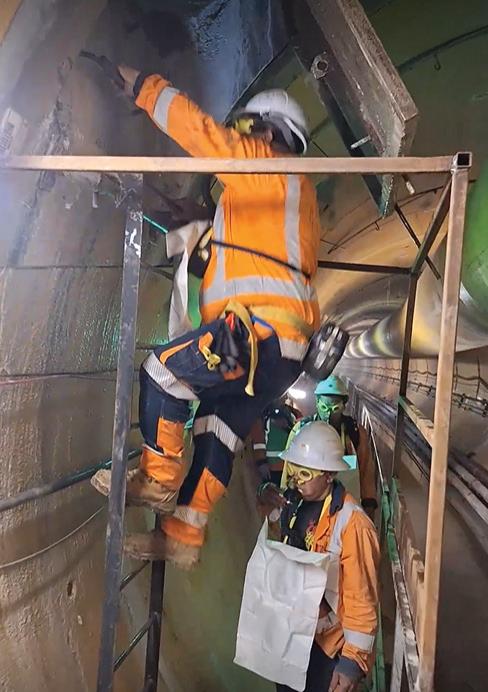
The scenario was to be a fire in the tunnel, and three victims would be unable to evacuate; one trapped deep underground, and two injured during the evacuation in different sections of the tunnel.
“Our challenge was to keep it dynamic, interesting, and challenging for all involved.”
Around 150 people were involved in the exercise, with only a small group of facilitators and observers knowing what was going on, says Paul.
Three St John response vehicles were deployed to the selfevacuation sites, five fire appliances, including a specialist breathing support unit, around five Police, 20 specialists from Mines Rescue, 35 workers in the tunnels, plus more above ground, and various response management teams with eight to ten people in each. WorkSafe was also informed as the drill played out.
Paul says the ‘Level 3’ emergency drill management was based on the Coordinated Incident Management System (CIMS) and was aligned with the Emergency Response Protocol for Underground Mines and Tunnels, albeit modified to suit the Central Interceptor’s construction environment.
The drama played out in the 4.5-metre-diameter main tunnel, which varies from 15 to 110 metres deep along its 16-kilometre length.
As the tunnel filled with a non-toxic white smoke, simulating a fire, and the emergency sirens blared, the workers underground knew what to do, donning breathing apparatus and either selfevacuating to assembly points at the main tunnel access point
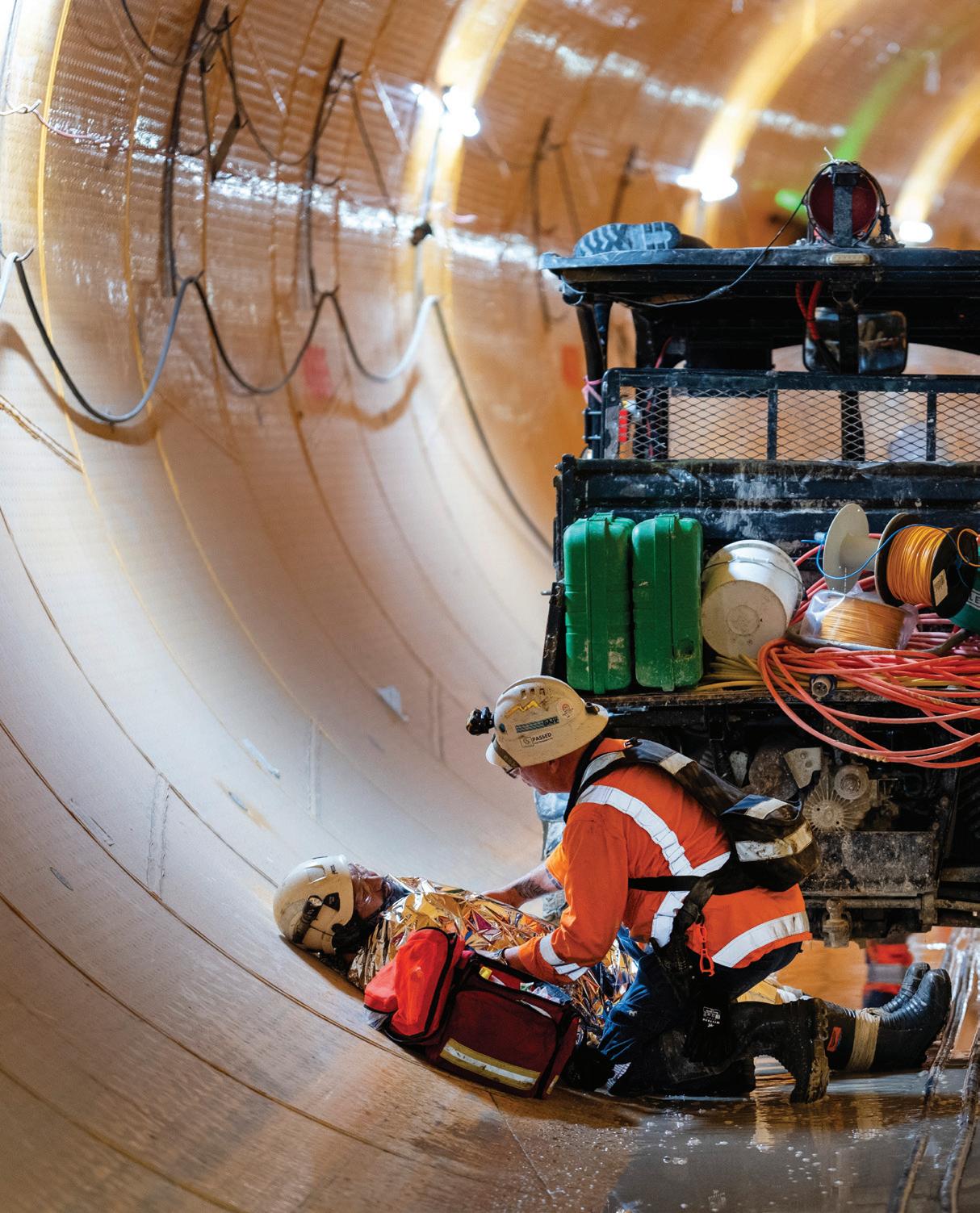
Tunnel workers self escaping with self contained breathing apparatus
Using the escapeway to leave the tunnel
at May Road in Mt Roskill, or at the tunnel escapeway at Lyon Ave in St Lukes, or taking shelter in one of two refuge chambers in the tunnel boring machine.
These refuge chambers deep in the tunnel provide a safe shelter for up to 36 hours until an emergency is resolved.
Meanwhile, emergency services were called above ground as the incident management team assembled at the May Road operations site to coordinate the response. Cameras in the tunnel provided the team with a live view of locations along the tunnel as the incident played out.
At the same time, an incident support group was assembled at GAJV’s head office in Onehunga, while an incident governance group was assembled at Watercare’s head office to provide support.
It soon becomes apparent that three workers are unaccounted for underground.
Once on the scene, the firefighters quickly prepared to enter the access shaft to locate the first injured worker, who was a short distance into the tunnel, and removed him using a stretcher. Further underground, Mines Rescue located the other two workers – one sheltering inside a fresh air base and the other collapsed beside the tunnel boring machine.
Both were carefully transported from the tunnel by electric locomotive, with the five-kilometre journey taking half an hour.
“The length of the tunnel tested Mines Rescue, their equipment, and how they would respond – the time it


THE FUTURE OF PIPELINE ASSET MANAGEMENT IS HERE
IPS Alliance empowers clients by identifying critical pipeline assets and using advanced, cost-effective analysis to deliver condition assessment and actionable plans for remediation or maintenance.This approach focuses resources on urgent renewals, maximising value and minimising waste.
Our approach leverages cutting-edge technology, data-driven insights, and a unified strategy through collaboration between industry leaders—Intergroup, Assetlife, Pipeline & Civil, and ProjectMax—to streamline processes, reduce complexity, and deliver tailored solutions at every stage of a project.
With IPS Alliance as your partner, you can expect innovative solutions that respect your time, optimise costs, and ensure sustainable success.
For more information please visit our website: ipsalliance.co.nz
Come and see the IPS partners Pipeline & Civil, Assetlife Alliance and ProjectMax at the Water NZ Conference & Expo 29 Sept to 3 Oct.
Tunnel supervisor treating injured worker

took to deploy was particularly challenging,” says Mines Rescue operations manager Paul Moffitt.
Paul Miles says that one of the lessons from the exercise was around alternative entry points, such as entering through the escape route and using a mobile rescue chamber. This means the rescue team doesn’t have to use their personal air while travelling to reach trapped workers, which has been practised and demonstrated in subsequent emergency exercises.
Paul says the exercise was a great learning opportunity for everyone.
“It’s one thing to work it out on paper, another to test it in real life.
“There’s always room for improvement and we tried to pinpoint areas where it is critical that an issue is addressed. For example, understanding the respective capabilities of various services. We were not aware of the full capability each organisation can provide, but now we do, we can find the best response for each situation.
“The other thing we did, which we haven’t before, was to have ‘family members’ and ‘media’ showing up on site to stress test the staff working on the gates at the operations site, as well as providing a side challenge for the emergency management teams.”
As a part of the scenario, several ‘distraught family members’, played by Watercare staff, showed up at the gate after ‘hearing’ about the incident on social media. Paul says they went to town with their roles, convincingly demanding answers around what was happening and access to the site. One ‘family member’
didn’t speak English, adding to the confusion.
A ‘media team’, played by a real journalist and camera operator, also showed up asking question after question, heightening tensions at the gates.
“We wanted to see how staff responded to these visitors during a major emergency and see what lessons could be learned.
“It’s one thing to talk about various scenarios, but to actually have a news crew pushing you to the limits is another,” says camera operator Murray Milne.
“The focus of the emergency needs to be primarily about rescuing people injured or trapped underground, but these incidents associated with the rescue add extra challenges for the incident management team, and that is where the off-site JV and Watercare incident support teams can provide assistance to the site-based team,” Paul says.
It is not often emergency services combine to participate in drills on this scale. Still, Paul says they all welcomed the opportunity to expose their staff to the challenges of underground rescue.
“The whole exercise was a large undertaking and disrupted workflow on the project. We’re appreciative of GAJV for giving us the time to do this.
“We’re also fortunate that Watercare has a really good comms team who captured fantastic videos of the event, and these have been shared with all rescue agencies as well as industry to maximise the learning opportunity from the exercise.
“It was a big effort but definitely worthwhile.”

Tunnel workers evacuating

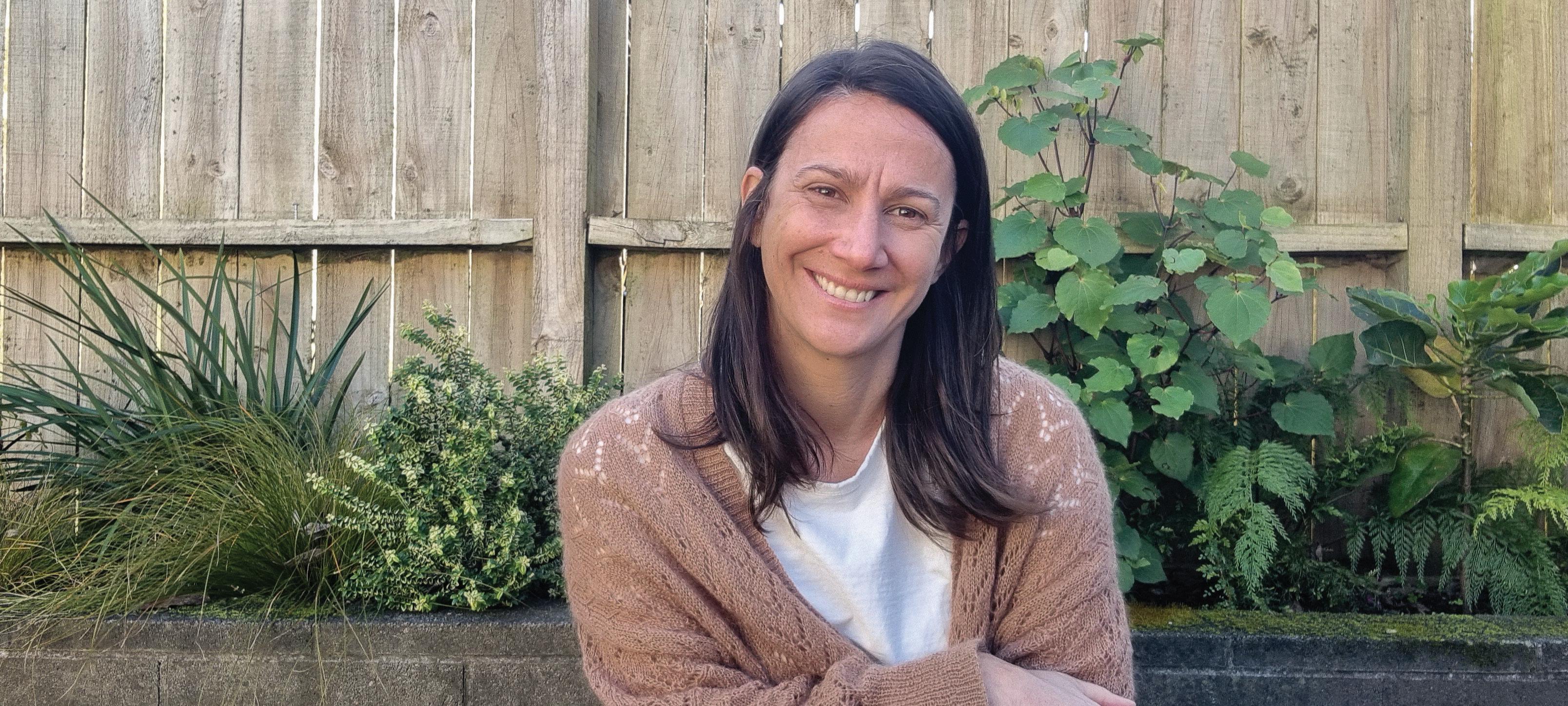
Tell us about your role at GHD
I’m a Panel Lead and Project Manager based in Taranaki, where I look after the delivery of water infrastructure projects. A big part of my role is really about listeningunderstanding what clients need, then guiding our teams to deliver solutions that are practical, technically strong and cost-effective. I also have the privilege of leading our water team across Bay of Plenty, Waikato, and Taranaki, which is about supporting capability in the regions, encouraging collaboration, and making sure the outcomes we deliver reflect both local priorities and the bigger national picture
What inspired you to pursue a career in engineering and how has that passion evolved over time?
I’ve always been drawn to problem-solving and the idea of making a lasting impact through infrastructure that supports communities for generations With a background in civil engineering, I naturally found myself working on water projects, where the technical challenges are closely tied to real outcomes for people Over time, my role has shifted from hands-on problem-solving to focusing more on leadership, strategic planning, and building strong partnerships – especially in regional areas, where the work we do is deeply connected to the communities and places we ’ re supporting
What do you love about working on projects in your community?
It gives me a real sense of purpose! I get to see firsthand how our work makes a difference, whether that’s through improving water resilience, smarter infrastructure planning, or projects that support growth in a sustainable way What I enjoy most is being part of the long-term planning, helping shape the future in ways that are thoughtful, sustainable and genuinely responsive to local needs
The relationships we build along the way are really important too They’re stronger because they’re based on shared goals and a genuine commitment to the communities we serve
Maria Buzzella
Maria is our Panel Lead and Project Manager based in Taranaki.
With a career shaped by her passion for problem-solving and community impact, Maria shares what first drew her to the world of water, what she values most about making a difference and the shifts she sees shaping the industry.
What is the most satisfying thing about working as a consultant?
More and more, clients are looking for real value for money, but also for projects that are resilient and future-focused. Collaboration plays a big part in that – working with consultants who take the time to really understand their needs and shape solutions that fit. Building trust and keeping communication open right through the project is key, because clients want partners who can deliver technically strong outcomes while still being flexible and responsive as things change
In terms of the future of the engineering industry, what trends or innovations are you most excited about?
I get excited about innovations that help us work more efficiently – whether that’s through digital tools, smarter design, or new delivery models These kinds of advancements make it easier to work effectively and support better decision-making As our regional footprint continues to grow, they’ll be really important in helping us deliver outcomes that are high-quality, scalable and tailored to local needs
“
I feel fortunate to be part of a team that brings together strong local connections with national expertise. It means we’re not just delivering projects – we’re building lasting relationships and making a real difference in the communities we work with.”

Scan the QR code to find her on LinkedIn Get to know
Connect with Maria

Tunnelling begins in Queen Street for $115 million wastewater upgrade
Watercare’s micro-tunnel boring machine (m-TBM) began its 600-metre journey under a stretch of Queen Street in Auckland in late July to lay a new wastewater pipe as part of the Midtown Wastewater Diversion project.
Watercare acting chief programme delivery officer David White says the new 1.2-metre diameter pipe will connect to the Ōrākei Main Sewer and capture wastewater flows from the city centre.
“The start of tunnelling today is an important milestone in our $115 million wastewater upgrade for the city centre. This project will reduce wet weather overflows into the Waitematā Harbour, improve the resilience of our network and allow for growth.
“We began construction in October last year and it’s good to see tunnelling getting underway. We chose this method of construction as opposed to open trenching to minimise disruption to pedestrians and businesses.”
The m-TBM was launched from a shaft at the junction of Queen Street and Mayoral Drive. Tunnelling will be done in two drives. It will bore through the ground at depths of 15 metres to a shaft at the corner of Wellesley Street East.
“Then, once we’ve inspected the cutterhead, the m-TBM will continue on, reaching the final shaft at the junction of Victoria Street East towards the end of the year.”
The m-TBM will lay the glass-reinforced plastic pipe in sixmetre-long sections. A pipe-jacking method of tunnelling is being used in which hydraulic jacks braced against a shaft wall push pipes through the ground.
“We’re doing everything we can to minimise disruption for residents and local businesses. All the activity will take place behind solid fencing, designed to minimise noise and dust, as well as keep pedestrians, motorists and construction crews safe.
“We’ve retained pedestrian access and installed signage to let people know businesses are still open.”
Tunnelling is part of the first stage of the Midtown Wastewater Diversion project. Stage two of works is in design and will involve laying new wastewater pipes from Vincent Street to Greys Avenue carpark. The work is due to be completed in 2027.
The project is part of Watercare’s $13.8 billion infrastructure investment programme being delivered over the next decade to enable new housing, improve the reliability of services and protect the environment.
It forms part of the Auckland Council group’s midtown regeneration programme which is transforming the streets, spaces and underground infrastructure in midtown ready for when the City Rail Link opens and brings many more people into the city centre.
Article provided by Watercare
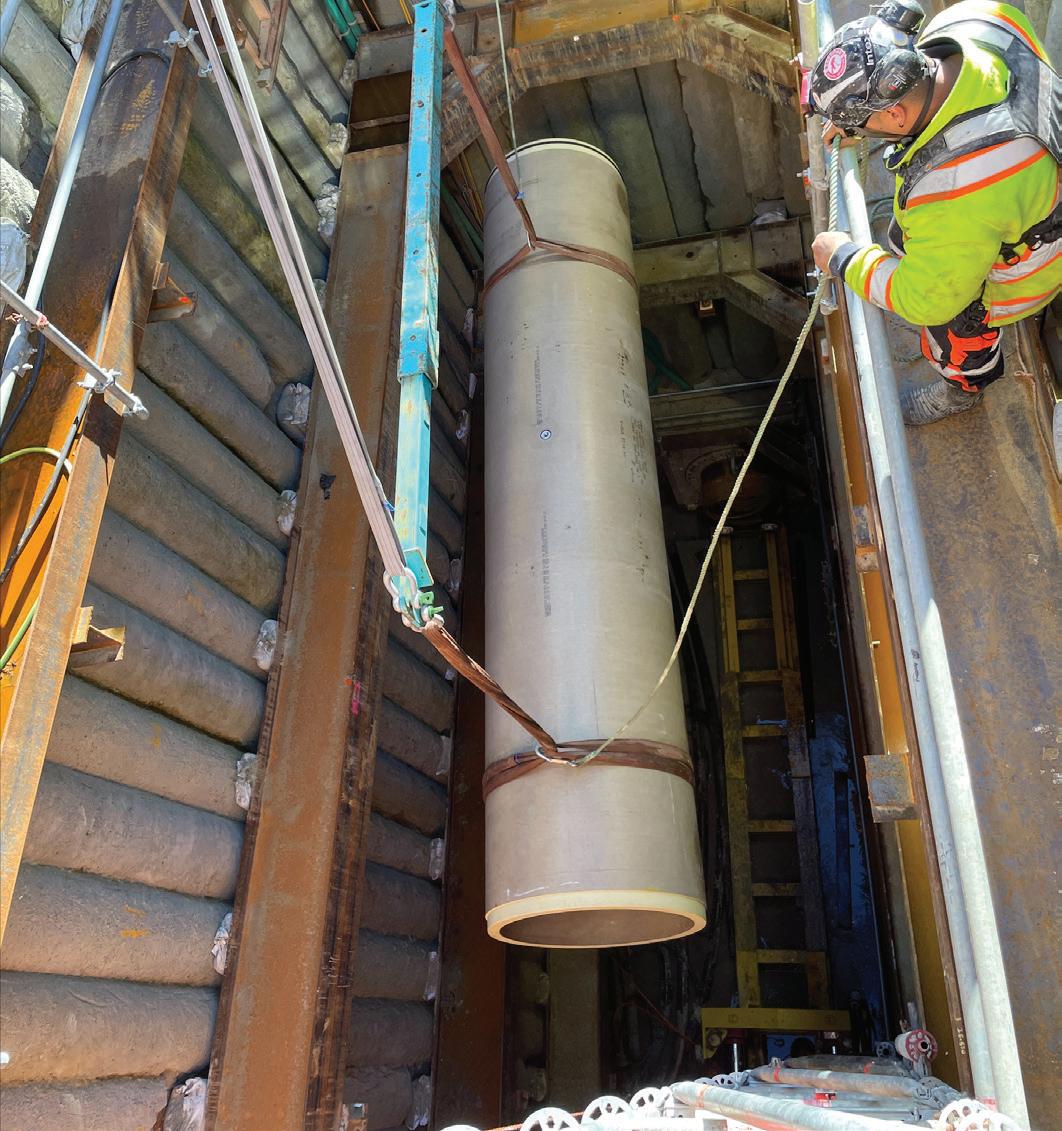
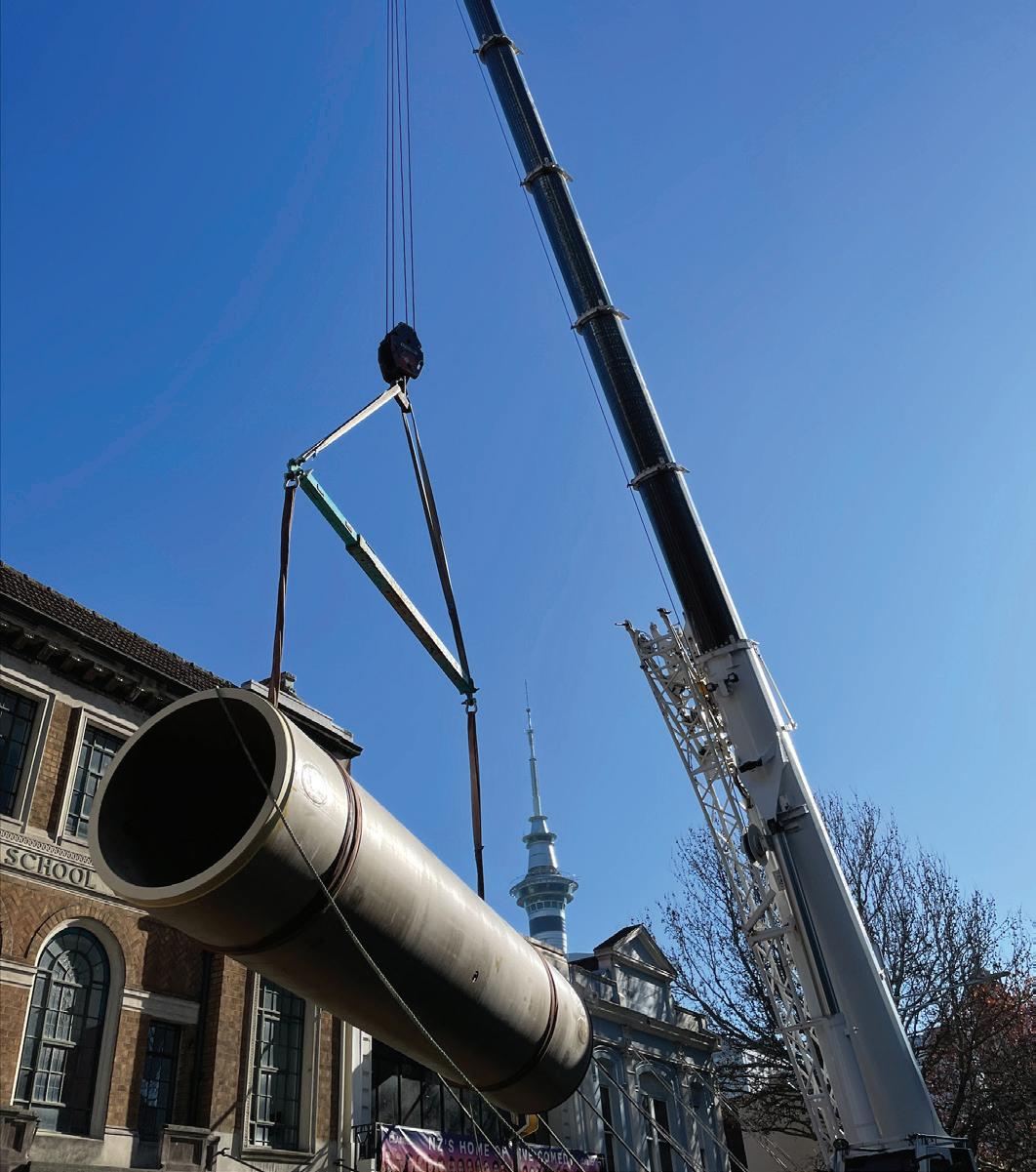
First pipe goes into the ground as tunnelling gets underway in Queen Street.
Up up and away! First wastewater pipe is lowered into a shaft in Queen Street.
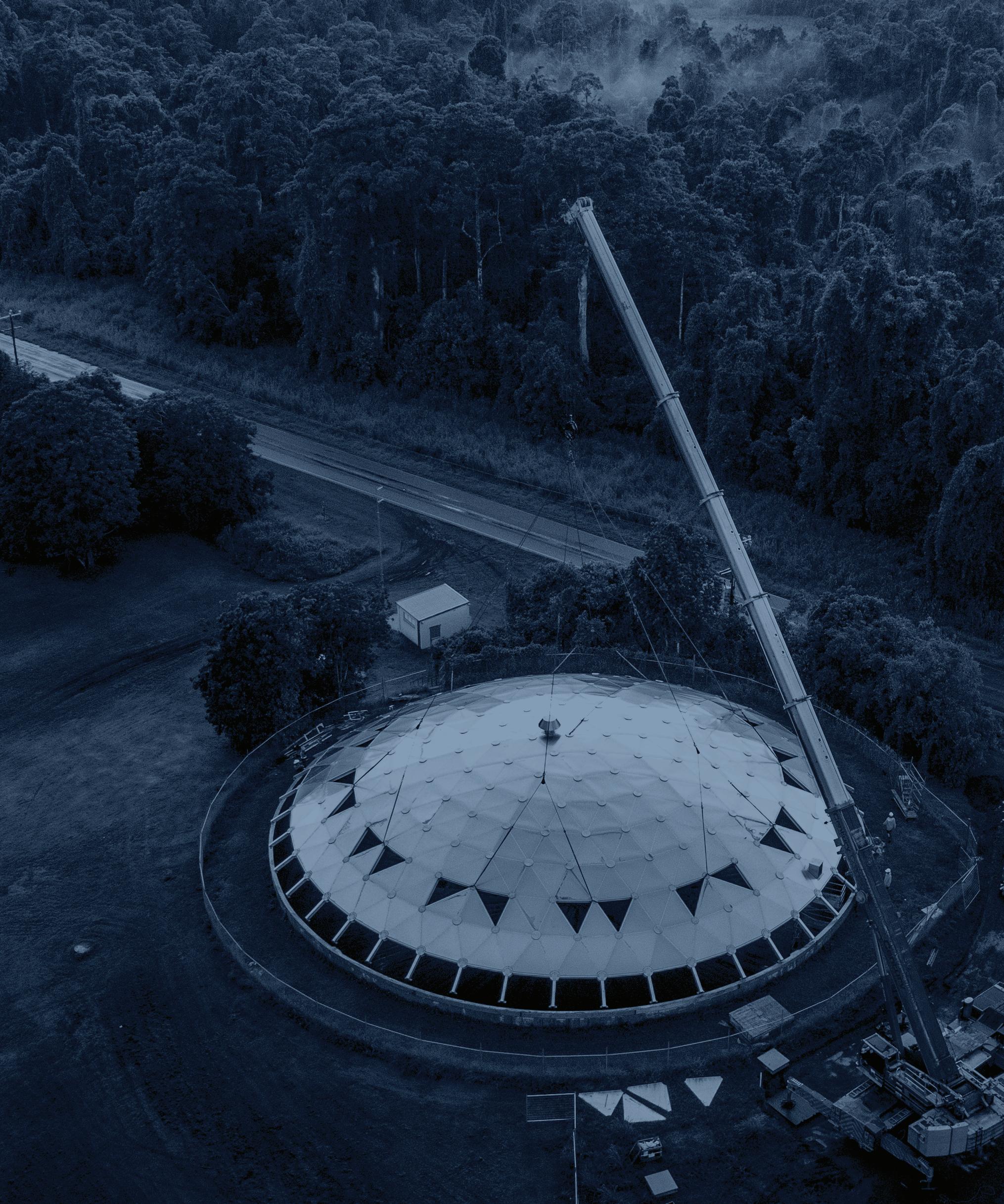
Effortless Collaboration, Exceptional Results

Breathing new life into wastewater treatment
Aeration systems across the country are undergoing a quiet revolution, one that’s reducing energy use, cutting costs, and making treatment plants cleaner, quieter, and more resilient.
For decades, aeration, the process of pumping air into wastewater to support biological treatment, has been one of the most energyhungry parts of the system, often accounting for more than half of a plant’s total electricity bill. Now, with growing concern over operational costs, carbon emissions, and community impact, councils are rethinking how they deliver this essential step.
From Rotorua to Dunedin, a new generation of aeration technology is being rolled out. These upgrades aren’t just replacing old blowers with newer models; they’re part of a broader shift toward smarter, site-specific solutions that marry efficiency with environmental responsibility.
In wastewater treatment, aeration provides the oxygen that keeps microorganisms alive and active, breaking down organic matter before the water is released back into the environment. It’s a process that must run reliably, often around the clock, regardless of weather, seasonal fluctuations, or unexpected load changes. That reliability comes at a cost: older systems can be noisy, inefficient, and expensive to run.
With electricity prices rising and pressure mounting to cut greenhouse gas emissions, councils are now weighing more than just immediate capital costs. Long-term efficiency, adaptability, and the impact on staff and neighbouring communities are all becoming deciding factors in procurement decisions.
Rotorua’s main treatment plant is one of several facilities to benefit from this new thinking. As part of a major upgrade, four high-efficiency iTurbo blowers, developed by German engineering firm Invent Umwelt- und Verfahrenstechnik AG, were installed. The project was delivered by Jonassen Industrial Projects, Invent’s partner in Aotearoa New Zealand, who managed the supply, installation, and commissioning.
The results have been striking: a dramatic drop in energy consumption, lower maintenance requirements, and sound levels so low that ear protection is no longer necessary in the blower hall.
For plant operators, the change has been more than technical; it’s cultural. Quieter machinery improves communication on site, and the ability to fine-tune operations via a digital control panel means staff can focus on optimisation rather than reactive fixes.
Further south, Dunedin City Council has taken a strategic, city-wide approach. At Green Island, four high-efficiency blowers were chosen for their flexibility, each unit can be relocated or reconfigured as demands evolve. Meanwhile, at the Tahuna plant, the upgrade included five centrifugal blowers, more than 1800 fine-bubble diffusers, and a centralised control system that coordinates the entire aeration process.
This integrated strategy ensures the plants can cope with fluctuating loads, seasonal peaks, and unexpected events without compromising treatment quality. And, as in Rotorua, noise

reduction has been a major gain: the new blowers operate below 78 dB(A), a noticeable improvement for both staff and nearby residents.
The benefits extend well beyond comfort. Across these projects, energy savings of up to 30 percent have been recorded compared to older technologies. This means lower operating costs for ratepayers and reduced emissions from the electricity required to run the systems.
Perhaps the most significant shift lies in how decisions about upgrades are being made. Rather than simply replacing outdated equipment with whatever fits the existing footprint, councils are seeking technology tailored to their plant’s unique needs, factoring in future growth, regulatory changes, and environmental objectives.
The work in Rotorua, Green Island, Tahuna, and Shotover reflects a wider movement in the country’s wastewater sector towards aligning infrastructure investment with environmental stewardship. As other treatment plants consider their options, the lessons are clear: by taking a long-term view, prioritising efficiency, and integrating adaptable technologies, councils can create systems that are not only more sustainable but also more resilient in the face of future challenges.
Article provided by Jonassen Industrial Projects.
Quieter, energy-efficient iTurbo blowers at Shotover Wastewater Treatment Plant.


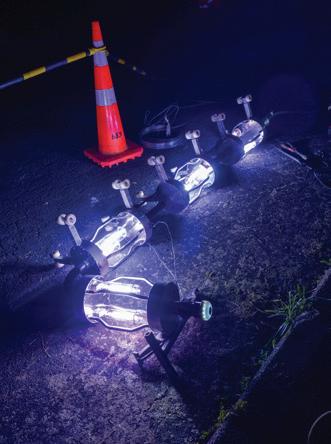
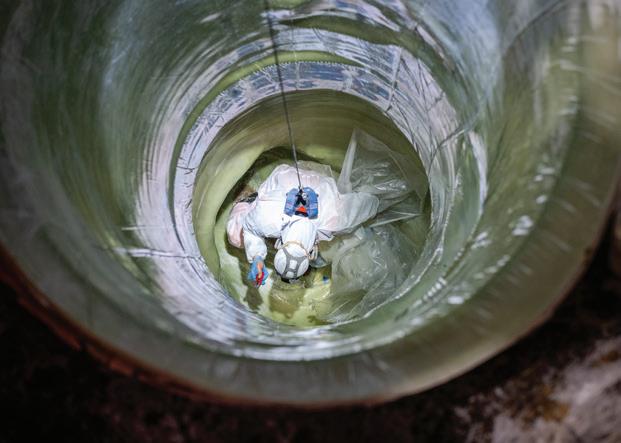
UV liner overcoming the vertical challenge
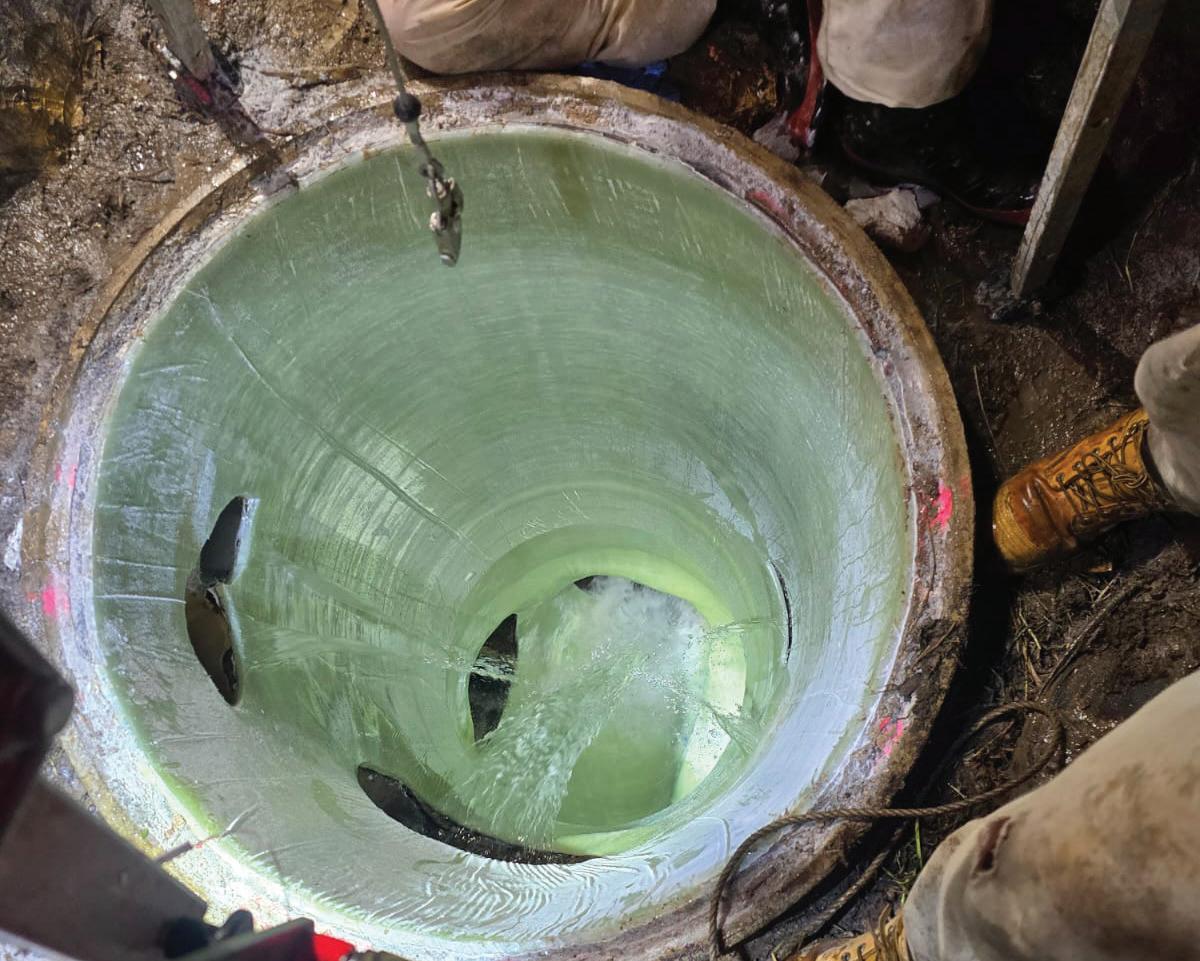
The first UV liner to be used vertically in New Zealand was a blend of technology, innovation, and the expertise of a skilled team. Hayden from the BurrowTech team says a Brandenburger UV liner was used on a complicated manhole remediation job for Auckland City Council. UV liners dramatically reduce time and disruption on jobs; and wastewater, water supply pipes, or manholes (in this case) are good for up to another 100 years.
NZ Lining Director – Operations Manager Ammar Ahmed, and his team were responsible for the smooth delivery of the project. Ammar says despite multiple challenges the project went smoothly. He expects it to be the first of many using the BurrowTech-sourced technology. Among hurdles to be overcome was water entering the manhole, at various points “like waterfalls”, Ammar says. This meant temporarily sealing off a number of outlets for services. The pipe also went from 1,050mm to
1,450mm which made the flexibility of the 1,400mm Brandenburger UV liner critical to the solution.
NZ Lining had been given UV training by specialists from German-based Brandenburger but added their own Kiwi “can-do” twist – adapting usually horizontal UV curing trains for the critical descent down the 4-metre-deep manhole in an industrial area. A second camera on the train ensured everything was thoroughly checked.
Once the manhole had been properly prepared, the lining itself took just 2 1/2 hours to install. The company’s meticulous approach extended to independent testing of the liner used, which passed with flying colours.
Ammar said the company were definitely happy with the outcome.

Award-winning topsoil project redefines treatment waste as a circular asset
A bold reuse initiative has transformed clay spoil and water treatment solids into a valuable topsoil product, the project standing as a leading example of collaboration for circular economy outcomes and long-term sustainability. By Cecilia Harris
During Ozwater’25, the Spoil to Topsoil project won the national R+D Excellence award (sponsored by Water Research Australia) at the Australian Water Awards. The R+D Excellence award recognises projects that challenge current practice and address the need for a sustainable future.
Delivered by Icon Water, Yass Earth Movers, and ACT NoWaste
Transport Canberra and City Services, the project reinvented hard-to-manage waste streams from water treatment and network maintenance operations to generate a valuable product for rehabilitation across the ACT, and potentially Australia.
Icon Water’s James Gibson says the research behind the project is extensive and started about six years ago, with Yass Earth Movers being a key partner as Icon Water’s excavation company, regularly handling burst water mains and dig-ups.
“We used to dump the excavated soil in a paddock, clean it as best we could, and reuse it back into the system. But, in Canberra, our soil is very clay-based. Even when cleaned, it looked fine but would reform into chunky clay lumps again,” James says.
“My team fixes burst water mains, repairs sewer mains – we dig every day. We wanted something more consistent and easier to work with.
“I didn’t know much about water treatment solids, but I started asking around – could we blend something to improve the soil properties? That’s how we landed on using water treatment solids.”
Icon Water’s Nupur Khanna says the project brought various areas of the business together to work towards reducing multiple waste streams.
“My team had been working on finding a reuse for the water treatment solids – a project going on for about 10 years. Water treatment solids are one of our largest waste streams. We generate about 2000 tonnes a year – and all of it was going to landfill,” she says.
“Leading the circular economy plan at Icon Water, my focus was on finding sustainable uses for our waste. When James and I were talking, we realised we had two problems and wondered if we could combine them in the solution.
“It started as just an idea. We weren’t sure it would work, which is why collaboration was so important. We’d already worked with ACT NoWaste on earlier trials – they hadn’t been successful – but we still had strong relationships. That helped us kick this off.
Leading research
Napur says research around water treatment solids has been unfolding over the past decade, and this project leaned into the work of other utilities’ reports and research.
“We had reports from other utilities and universities going back 10 years, looking at national applications for water treatment solids.
Each utility waste has similarities, but differences, too, depending on the influent.”
“The early research led to a more localised project here in the ACT. One of the findings was that water treatment solids could be useful in compost, though we didn’t yet know what it needed to be mixed with.
“There were trials – like making mud bricks, which technically worked, but had no real market. Another trial involved mixing FOGO (food and garden organics) with water treatment solids.
“That compost product came out well and even got some regulatory approval, but due to uncertain FOGO supply, the project didn’t proceed. When I joined Icon Water, we decided to take those learnings and try something new – mixing water treatment solids with soil to create topsoil.”
Magic mix
James says the testing of the product involved many different blends and, in the end, a 50:50 mix was found to achieve the best results.
“We tested 15 different blends in a paddock over three months. A third party monitored it. The best result was a 50:50 mix – water treatment solids and clay spoil.
“Since February, we’ve made three large batches – over 1000 cubic metres reused in the network. Every day, we’re backfilling holes with it. The challenge now is making it consistently. We’ve had teething problems, but it’s going well now.
“We’ve designated an area on our land as a ‘no-waste facility’ –basically our resource recovery centre. All our excavation waste goes there to be sorted. We’re almost putting everything back in the ground now.”
Not to be confused with wastewater treatment biosolids, water treatment solids have great moisture-holding capacity, Napur says. While this makes the material clumpy and slow to dry, mixing it with clay produced a fantastic result.
“The result is really great looking, fluffy topsoil. Plus, it has good organic matter, which is great for plant growth – it retains nitrogen and phosphorus, making it excellent for use in nature strip restoration.”
James says there used to be complaints about subsidence with the reused, unmixed clay, but not any more: “Now we fill entire holes with this product – no need for a second visit. We’ve had no complaints since we started using the new mix.”
Hitting circular goals
Napur says making a difference with reused materials is all about scalability: “If this can be replicated across Australia – or even globally – it’s a win for the environment and for the industry.
“We made our decision on the 50:50 mix based on visual

During Ozwater’25, the Spoil to Topsoil project won the national R+D Excellence award.
monitoring (weeds, weather resilience) and soil testing (organic matter levels). That combination of evidence gave us confidence it could be scaled.”
And when it comes to being recognised for the achievement at a national level? James says the experience of winning at the Australian Water Awards was amazing.
“I was proud just to be nominated for the ACT awards. Winning
the national award was next level, especially considering how massive that category was.
“But the thing that hit home was the criteria – R&D with future implications. We’ve genuinely turned a waste stream into our new normal. For the people who come after me and Nupur, this process will just exist. That’s something to be proud of.”
Reprinted with the permission of the Australian Water Association
Antimicrobial Crystalline Technology
















How to future-proof water treatment plants: Transitioning to a 50 year planning horizon
By Quirien Muylwyk, VP, water quality, Aecom
Traditional facility planning for water treatment facilities has typically focused on relatively short-term infrastructure needs based on updating demand projections, addressing compliance risks, and replacing aging assets. However, this approach is increasingly misaligned with the realities of a changing climate.
When readying treatment plants for the future, there is a risk of failing to properly or fully account for the long-term and compounding impacts of extreme weather, shifting rainfall patterns and rising temperatures on water quality and treatment needs.
As a result, facility plans struggle to manage uncertainty and are often unresponsive to evolving stakeholder expectations. This not only limits solutions for resilience but also heightens financial and reputational risks for utilities.
How do we modernise water treatment facility planning?
Fortunately, there are models for what modern facility planning could look like across the globe. Facility planning for three North American water systems – including a Midwest user, Pacific Northwest user and Central Mountain user – demonstrates how a 50-year planning horizon, combined with a social value lens that considers broad internal and external stakeholder inputs, can modernise facility planning. This approach integrates climate resilience, stakeholder engagement and adaptive planning to provide water systems with the best chance to be ready for the future.
Five steps to modernise water treatment facility planning
We developed this framework through lessons learned from facility planning for the three North American water systems. All three faced conditions of increasing uncertainty, attributable to water quality, hydrology, population dynamics, industrial customers and/or changing attitudes to social value.
Unsurprisingly, they also all faced their own unique set of challenges, from aging infrastructure to the need to augment and diversify the supply portfolio. Due to the different needs we saw in the three case studies, this framework is flexible by design.
Step 1: Define the boundaries
Begin with establishing the boundaries for the facility plan: in addition to the treatment works, should it include the supply and network infrastructure? Extend the planning horizon to 50 years to better align with long-term challenges and opportunities.
As the plan is developed, integrate climate considerations – such as changes in hydrology, water quality and shifting water demand patterns including domestic climate migration – into the analysis.
To anticipate a water system’s needs in the future, we first consider the magnitude of change that has come before us in terms of how we use water, how our cities have grown, workforce dynamics, and 50 years of technology and regulatory advancement. We then consider potential gaps in the existing treatment and supply portfolio, to provide multiple barriers for pathogen control and particulate removal, redundancy in the supplies, as well as different classes of contaminants.
Equally important is embedding social value into the planning process by addressing factors like water affordability, equitable access to safe drinking water and opportunities for local workforce development.
This holistic approach improves the likelihood that the facility is more resilient to future climate impacts and is more responsive to the needs of the communities it serves.
Step 2: Identify and engage stakeholders
The purpose here is to identify the stakeholders that can influence the outcomes, promote the facility plan or represent the community’s values, with the goal of going beyond internal stakeholder engagement.
For the Midwest user, external stakeholders took a lead role in developing and shaping the facility plan through a range of forums:
• Meetings with community members that historically had not contributed to a major infrastructure project, including representatives from low-income households and youth groups.
• Major customers, including wholesale systems, the school board, the university and a watershed steward advocacy group, were invited to participate in the project’s steering committee.
Internal stakeholders should include members of operations and maintenance along with representation from the wastewater, distribution system and water resources departments to provide an integrated water management perspective.
In the Midwest case study, these utility representatives joined the major customers on the project’s steering committee. An executive committee can provide key links to finance and administration departments, whose support is key to securing the budgets necessary for implementation of the facility plan.
Broad representation from both external and internal stakeholders will lead to more creative solutions while also promoting broad support for the facility plan.
Step 3: Collaborate on problem solving
In this step, the needs and boundaries of the facility plan are considered in the context of potential solutions that are framed holistically to leverage synergistic benefits.
For our three water users, we used historical data reviews, scenario modelling and/or demonstration testing to assess the feasibility of
potential solutions. In this step, engagement with operations and maintenance staff is invaluable when defining the needs of the facility plan, as well as the potential solutions.
For our work with the Central Mountain user, the water system identified multiple climate futures and evaluated potential solutions against changing conditions.
For the Midwest user, stakeholder input reshaped both the treatment goals and the infrastructure priorities related to water security and the supply portfolio.
Step 4: Engage the steering committee
Engage the steering committee early in the planning process to provide strategic oversight, foster alignment and support decision making. Be sure to define the committee’s governance, so that all participants understand expectations and the influence of their contributions.
Step 5: Document and promote the plan
The facility plan can be used to document assumptions for risk, infrastructure investment, workforce development and/or financial support.
The governance of the facility plan should consider how it is updated and used when implementing individual projects identified in the facility plan. All three water users documented their plan through a report and easy-to-read executive summary, and some formally presented it to its Council or Board for approval.
Case Study: The Midwest water user’s inclusive planning model
The Midwest user’s facility plan is a model of modern utility planning. As a result of extensive stakeholder input with major customers and broad-based community engagement, including customers underrepresented in the past, the city redefined its treatment goals and expanded the boundaries of its facility plan to improve water security for its customers in the face of drought and contaminant threats.
The facility plan includes indicators to trigger action for contaminants like PFAS and 1,4-dioxane, while prioritising affordability and reliability. We will use this inclusive, forward-looking model that is heavily founded in engagement when working with other water systems.
The final case for modernising water treatment facility planning
No matter where you are in the world, our water systems are facing water security challenges – some more than others – but the uncertainty and unpredictability exist. And to address these, we need to do things differently.
This framework and approach demonstrate that a data-informed and stakeholder-shaped plan will give us the best chance at meeting the needs of the water system well into the future.
Tough outside. Smart inside.
Our new submersible motor pump can be used more flexibly, is smart, cleans itself and saves energy at the same time. Curious? Find out more about the new AmaRex Pro.


AmaRex Pro


Inside Sydney Water’s capital works momentum
Sydney Water’s multibillion-dollar infrastructure programme isn’t just a construction boom – it’s a response to increasing pressure on multiple fronts. Here, Sydney Water’s new head of major project delivery, Deanne McDonald, shares how strategic planning and partnerships are laying the groundwork for long-term resilience. By Cecilia Harris.
Deanne is well positioned to speak about what this investment boom looks like in the pipeline, but also the reasons for the present surge.
“There are four main drivers behind the momentum we’re seeing now. First, there’s aging infrastructure. We’ve benefited from investments made 50 years ago, but much of that infrastructure is now in need of upgrading or expansion,” she says.
“Second, population growth is a key driver. As demand for new homes increases in Greater Sydney, we’re seeing a
rise in greenfield developments and the need for supporting infrastructure to keep pace.
“We work closely with the government to align with their priorities. One of our biggest drivers is housing, supporting the delivery of 377,000 new dwellings under the government’s housing agenda.”
Furthermore, compliance requirements have become far more stringent, especially where water is returned to natural systems like rivers or the ocean.

“Ensuring water and wastewater treatment meets Environmental Protection Licence (EPL) standards is vital. That includes having the right technology at our plants and building adequate reservoir capacity,” McDonald said.
“And finally, we tend to run counter-cyclically to sectors like transport. Every 10 years or so, we have more opportunity to deliver because there’s more capacity in the market.
“That market capacity shift enables us to move forward.”

Sydney Water releases high-quality recycled water for environmental flow at Penrith.

Leading up
Sydney Water has spent the past three years developing strong relationships with contractors, suppliers and vendors, Deanne says, all in preparation for delivering on a dizzying capital works portfolio.
“We’ve introduced relationship contracts and now use NEC4 instead of GC21, focusing on collaboration with our delivery partners. That helps us ensure the market has the capacity to deliver the volume of work we’re planning.
“We also have a Long-Term Capital Operating Plan (LTCOP), which maps out our priorities over the next 10 years across the Sydney Water network.
“We’re working with IPART to shape the capital investment for the next five years, and we’ll continue to work with the community to prioritise projects.”
Significant investments are already committed, including for the Advanced Water Recycling Centre (AWRC): “We’re building the AWRC at Upper South Creek. We’ve put about $1.5 billion into building the networks required to deliver wastewater to that plant. We’re also doing stormwater work in Western Sydney around the Aerotropolis.
“Additionally, we’re upgrading several water resource recovery facilities, what we used to call wastewater treatment plants. These upgrades are necessary due to growing catchments and stricter compliance standards.
“There’s also a separate, dedicated programme focused on renewals and smaller projects delivered through our regional delivery partners across three geographic areas. The volume of work is why building strong market and supply chain relationships has been so important.”
Keeping up
Deanne says that all utilities plan decades in advance, and project delivery prioritisation is always a balance of careful planning and flexibility.
“We plan 20 to 50 years ahead. We build assets that might last 50 or even 100 years, so we need to think long-term and work backwards from there.
“Take the AWRC at Upper South Creek. That’s a project 15 years in the making. Conversations about the area started long before the airport plans were confirmed. Once that was locked in, we planned a scalable advanced water recycling plant. Then we worked out how many people it could service and when it would need to be expanded.”
Deanne says matching capital investment to actual need is a big part of the job.
“We’ve got investment managers focused on funding, planners looking at demand and timelines, and delivery teams working on approvals and construction.
“Across that whole value chain, there’s tight coordination. Affordability is always front of mind; we know people can’t live in houses without water and wastewater services. But we also have to balance that with the cost to customers.
“We work closely with the government to understand zoning and development timelines and try to align our work with their strategy. That can be challenging, especially with dispersed developments or smaller projects.”
In the pipeline
Of the array of various projects planned or already in the delivery pipeline at Sydney Water, Deanne says she is particularly excited about the AWRC at Upper South Creek.
“It’s the first greenfield wastewater treatment plant we’ve built in a long time, and it’s truly innovative. It’s designed to supply recycled water, has a brine pipeline, and returns water to rivers. It’s also a circular economy hub, half-powered by its own solar array.
“We’ve done some really interesting First Nations engagement and revegetation around the site, which was formerly paddocks. The project’s going well, and we have a fantastic team and contractors.
“The networks leading to the plant have also been interesting. We’ve approached them from a systems perspective, looking at five different projects and catchments to see how we could reduce costs and impacts.”
At the core of successful project management is delivering on time, on budget and to scope, Deanne says.
“But beyond that, success is about providing affordable services to customers.
“It’s about pushing the dial, looking at how to make infrastructure more economical, more predictable. How can we reduce impacts during delivery? Things like manufactured components and modular construction help with that.
“We want infrastructure that’s scalable and future-ready, where we can build on the foundation with new technologies. Every decision must come back to customer benefit. They’re paying for it, so the return needs to be there over time.
“But everything has a cost and requires prioritisation. We can’t do everything at once. The key is to narrow the field and keep improving, step by step.”
Article reprinted with the permission of the Australian Water Association.

Sydney Water's Purified Recycled Water (PRW) demonstration plant in Western Sydney.


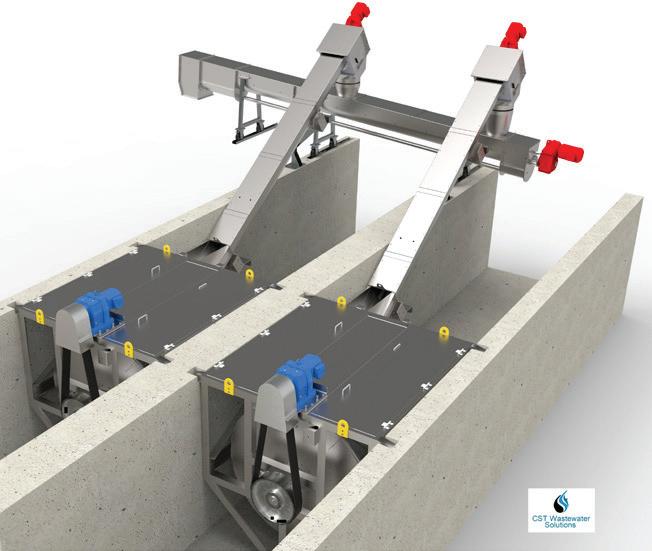

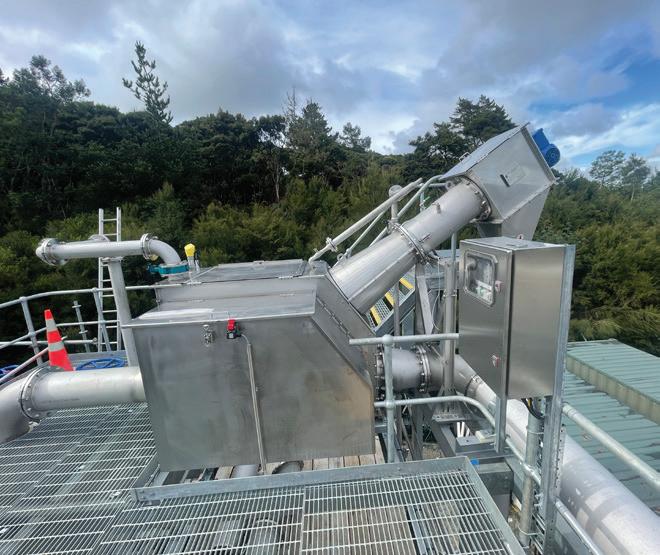

Auckland’s wastewater network to get smarter with sensor rollout
Watercare is rolling out 5000 smart sensors across Auckland’s wastewater network, giving it real time insights into what’s happening in the pipes
The sensors are part of a $12 million Smart Network Programme, which focuses on integrating digital technologies and artificial intelligence software with Watercare’s infrastructure.
Watercare is working with Citycare Water to install the smart sensors.
Watercare smart systems manager Dave Moore says this investment will enable the organisation to collect more realtime data, identify problems and optimise the network to better protect the environment.
“Installing these 5000 sensors across Auckland over the next 12 months will allow us to be more proactive in addressing issues in our network before they escalate into overflows.
“We’re going to have far more data than a human can analyse, so we’re also investing in an AI analytics system that will analyse data from the sensors and our other monitoring systems, as well as things like weather, tide data and groundwater data. It will learn how our system behaves and tell us when something changes.
“We’ll be alerted to areas where stormwater and groundwater enter our system, tidal ingress, blockages developing and the performance of our pumping stations and wastewater network.
“These data driven insights will allow us to become more proactive rather than reactive when looking after our extensive wastewater network. We’ll be able to make more informed decisions about where we need to invest in maintenance and renewals.”
Dave says before committing to the sensor rollout, Watercare undertook a one-year trial to evaluate the technology.
“The trial saw us install 135 sensors in pockets of the city prone to overflows.
“The trial was a success as it provided valuable insights that helped us better monitor the wastewater performance and identify blockages, as well as stormwater or groundwater ingress.
“For example, in Ellerslie, we identified and addressed sediment issues in the Onehunga Branch Sewer, which improved the overall performance of the network.”
Watercare smart network engineer Kevin Ang, who is heading the sensor rollout, says crews are aiming to install 400 to 500 sensors a month.
“Each of the sensors is installed inside a manhole and comes with its own data logger.
“These loggers transmit data to a central monitoring system, allowing us to receive real time information on what’s happening in the network.
“The sensors track sewer levels and can detect irregularities in the network – such as a sudden rise in sewer levels which may indicate a blockage or stormwater inflow infiltration happening close by.”
Kevin says Watercare aims to have all 5000 sensors across Auckland’s 9000 kilometre wastewater network by the end of June next year.
“The sensors are state of the art and highly reliable. They’re built to endure extreme weather conditions, and each one takes about an hour to install.
“Having these sensors installed across the city’s integrated wastewater network will give us more accurate insights into what’s going on and what we can do to improve the performance of the city’s wastewater network.”
Article provided by Watercare.



Empowering councils and communities with waterdriven insights to secure a sustainable water future
Empowering councils and communities with waterdriven insights to secure a sustainable water future
At ADR, we help communities shape a more sustainable water future. Through smart meters, real-time data solutions, and local collaboration, we make water management more transparent, efficient, and future-ready. Talk to our experts today: +64 4 4727614 or visit www.adriley.co.nz to unlock efficiency and water sustainability.




AI in the water sector: opportunities, challenges and what comes next
To celebrate Australia’s National Science Week, the Australian Water Association shared a recent Q+A with SpiralData chief data scientist Dr Ram Balachandran on AI’s role in the water sector. Ram says that while AI’s role in water management is still evolving, its potential to improve resilience and conserve resources is undeniable. By Cecilia Harris.
Tell us how AI is reshaping asset intensive sectors like water.
When we talk about AI, people often think of large language models like ChatGPT, but AI has been around for a long time. Essentially, AI is about pattern matching – identifying patterns in data, validating them and then productionising them to extract value.
In asset-heavy sectors like water, AI improves efficiency in multiple ways – labour efficiency, energy efficiency and water conservation. There’s also the renewal of capital investments, including finding ways of prolonging the life of an asset, ensuring ongoing operations and minimising impacts.
At SpiralData, we focus on transient detection. Transients are pressure surges in pipes; they are a major problem, responsible for about 50-60 percent of asset failures. If we can reduce unexpected failures by even five percent, that significantly shifts the economic outcome.
We detect pressure surges, identify the root causes, measure their impact on pipes, and work to mitigate them to reduce leaks and breaks. This also means fewer emergency callouts for repairs, which is a major operational benefit.
Other companies are also using AI for efficiency gains, including applying AI for asset inspections. Traditionally, engineers would spend hours reviewing footage to identify cracks and leaks, but AI-driven computer vision can automate much of that process.
Energy efficiency is another area where AI has potential. In wastewater treatment, blowers consume significant energy. AI can help optimise energy use by responding to demand, water quality, and other factors.
AI is making its way into the sector, but unlike a simple chat interface, its adoption is still at a technical level. Over time, solutions will become more holistic, helping both capital efficiency and operational efficiency.
Even for end consumers, AI could help prevent issues before they happen, making water management more predictive rather than reactive.

What other operational improvements can AI provide?
AI can help predict asset usage more effectively. Many network assets – such as 100-year-old pipes and valves – are not fully utilised because their state is unknown.
There is significant opportunity for AI-driven network optimisation. Traditional numerical simulations struggle to run complex scenarios, but AI can model these efficiently, helping to optimise how pumps and valves interact.
Currently, most AI work in water focuses on individual assets, but there’s still untapped potential at the network level. By creating digital twins – virtual models of water networks – we can optimise systems holistically rather than in isolated parts. This shift to systemwide efficiency is what I find most exciting about this work.
AI has been criticised for its energy and water footprint, particularly models like ChatGPT. How does the AI used in the water sector compare?
I think the key question is: how much energy or water does AI consume versus how much does it save?
The AI used at SpiralData is not energy intensive. We run it on CPUs (central processing units), rarely needing GPUs (graphic processing units) except for initial training. Most of the processing runs on low energy cycles.
More importantly, the energy savings from extending asset life, preventing leaks and improving operational efficiency far outweigh the AI’s energy consumption. For instance, undetected leaks lead to significant water wastage and unnecessary pumping costs. AI helps mitigate that, reducing both water and energy waste.
Regarding ChatGPT and large AI models: yes, they have high energy demands. There is also a considerable amount of water required for cooling in data centres.
However, improvements are underway – miniature AI models can now run on laptops with far lower power consumption. AI

usage should be judged case by case: what problems does it solve and is it worth the trade-off?
For the water sector, AI provides tangible savings in water, energy and emissions, making it a net positive rather than a drain on resources.
What are the risks and ethical concerns of adopting AI in the water sector?
This is something I think about a lot. There are two major concerns. The first is human oversight. AI does not inherently understand the laws of physics or conservation.
That’s why AI should always be a decision-support tool, not an autonomous decision-maker. The responsibility for final decisions must always rest with a human expert. AI can provide insights, but it should not be making operational control decisions, such as adjusting valves or pumps.
The second is data privacy. Water-use data is incredibly sensitive. It can reveal personal behaviours, and it must be carefully anonymised and aggregated before being used in AI models. Data governance frameworks in Australia and Europe are improving, but they must also evolve to address AI-specific concerns.
In my opinion, the water sector must ensure strong data governance while keeping humans in control of AI-assisted decision-making.
How can AI help water managers anticipate and navigate future challenges, like climate change and resource scarcity?
AI is a powerful forecasting tool. For climate change, AI can model various future scenarios, predicting which areas will be most affected. Sydney Water, for instance, is dealing with salt accumulation in sewer outlets due to salt-water ingress. AI can help forecast such impacts and develop mitigation strategies.
For population growth, AI can simulate how increased demand will stress existing water networks, helping planners optimise infrastructure investment.
There are also advances in AI-driven weather forecasting. Google has developed WeatherNext, which forecasts weather as accurately as traditional numerical simulations, but at a fraction of the computational cost. These improvements will extend to climate forecasting and water planning.
The major challenge isn’t the technology – it’s human collaboration. Different stakeholders need to align on worst-case scenarios and mitigation strategies. The best AI tools are useless if people don’t understand or trust them.
This is why AI literacy across the water sector is essential. AI is just another tool, like engineering models or numerical simulations. The real challenge is getting people to use it effectively.
What steps should the water sector take to ensure responsible AI implementation?
I’d flip the question around: what is the cost of not adopting AI? Water is a conservative sector, for good reason – safety is paramount. But there is also a risk in not adopting new tools. AI will never be perfect, but waiting for it to be 95 percent accurate (like traditional engineering tools) may mean missing out on valuable efficiencies.
The water sector should focus on education and improving AI literacy so that professionals understand its capabilities and limitations. For example, TAFE NSW has created courses to introduce AI to people from all backgrounds.
But incremental adoption is also an important focus. Running small AI trials across different use cases to build confidence and refine best practices is a safe way to work through new approaches. Iterative improvement is another approach that should be kept front of mind in the years to come.
AI implementation should be an ongoing process, continuously refining approaches rather than waiting for a ‘perfect’ solution. The goal isn’t to let AI take over but, to integrate it responsibly, making small, iterative improvements that lead to major efficiency gains over time.
Article reprinted with the permission of the Australian Water Association.

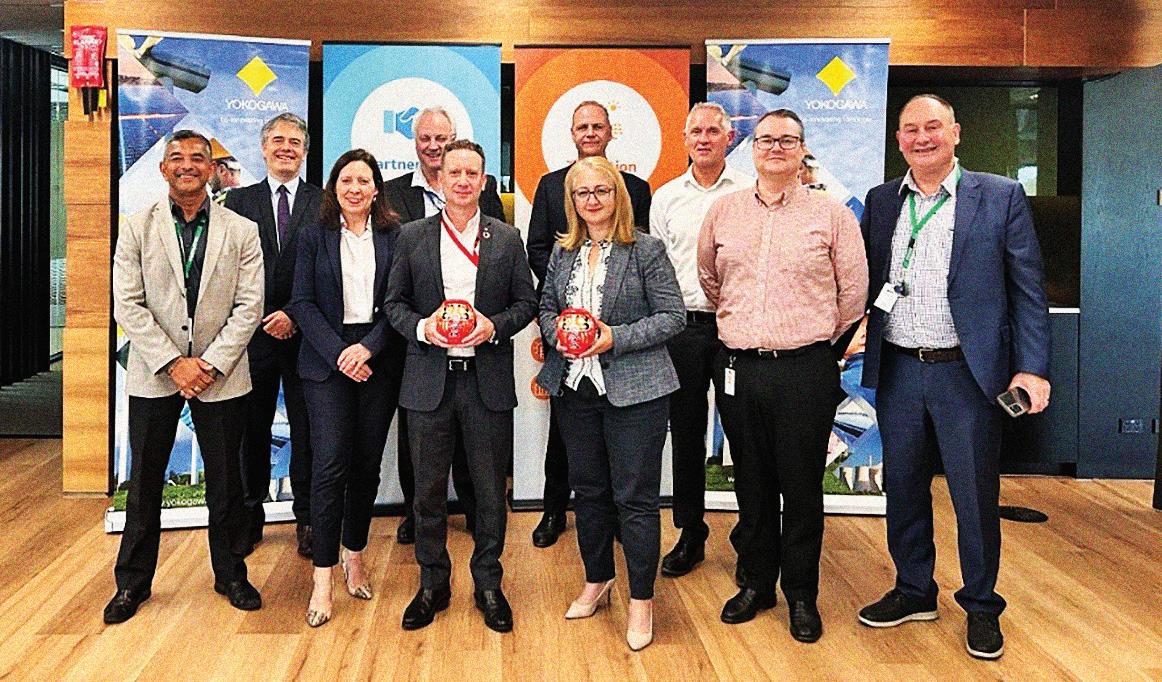

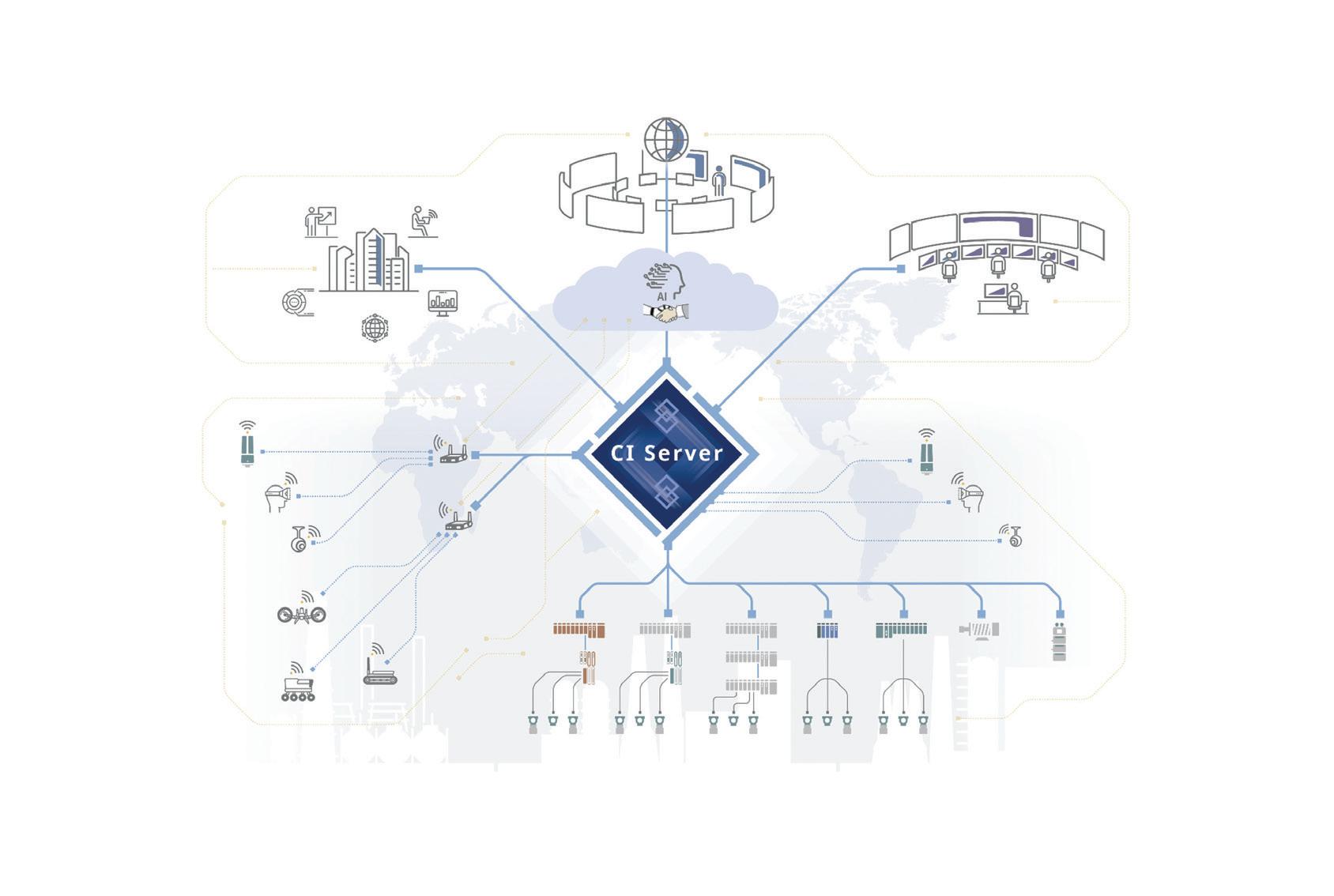

Eastland Port industrial stormwater innovation
By Marty Bayley, Eastland Port, and Stephanie Dijkstra, Storm Environmental
Stormwater quality management is an area of increasing attention, and for good reason. We are seeing more pressure on receiving environments, more intense weather patterns, and rising expectations from regulators, communities, and mana whenua.
But while the spotlight often lands on urban catchment planning, greenfield developments, and municipal stormwater networks, one critical domain remains conspicuously absent from the national conversation: industrial sites.
Industrial sites are often overlooked in the broader stormwater conversation yet are some of the most complex and consequential contributors to stormwater quality.
These are high operational intensity sites, quite often with high and varied contaminant loads due to onsite activities. They have large amounts of hardstand/ impervious surface cover, a high degree of local community scrutiny and, especially within legacy industrial areas, limited space for treatment options to be implemented. In many instances the contaminants represent wastewater, but with the high-volume intermittent and high sediment discharge associated with stormwater.
Industrial sites are also where some of the country’s most innovative solutions to stormwater quality treatment are being developed and tested. Eastland Port in Gisborne offers a case study of an innovative and integrated approach to industrial stormwater management within a confined site.
The Challenge: Complexity on a compact footprint
Eastland Port Limited (EPL) is a regional export port and operates on a limited footprint in the middle of the Gisborne CBD.
There has been an exponential increase in log exports from the region's forestry industries processed through EPL, from 380,000 tonnes in 2005 peaking at 3,000,000 tonnes in 2018. The volumes processed result in approximately 1.5 percent of this mass being left behind on the port as bark and debris.
While the vast majority of this is recovered with loaders and sweepers (450,000 cubic metres recovered annually), a portion of extremely fine particles which can't be mechanically recovered remain in the pavement body and on surfaces. These readily become entrained in stormwater during rain events, which creates a highly visible red-brown discharge plume into the marine environment.
While traditional stormwater treatment systems were adequately addressing all other contaminants entrained in stormwater, they were unable to remove the fines and the plume continued to appear following rainfall events.
The proximity of the local community to the EPL site resulted in significant pressure to improve the site environmental performance. Significant concerns were raised from the community and mana whenua on the potential impact of the port activities on the local marine environment due to an ongoing discharge plume.
Monitoring reports highlighted continual non-compliance due to discolouration in the receiving environment created by the plume.
Integrated systems, iterative learning
Over a decade EPL commenced a largescale development of the port’s landside yards to ensure infrastructure was fit for purpose including the stormwater assets. This included improving operational practices and investigating appropriate stormwater treatment systems.
Early interventions undertaken included upgrading hardstand surfacing, installation of robust kerb and channels, installing accessible catchpits, importing mobile sweeper machinery tailored for heavy debris, along with implementing better debris management practices.
This was a long process of trial and error and lessons were learned along the way.
After the initial (Southern log yard) development was completed in 2012, it became apparent that the hydrodynamic vortex separators installed had not worked as intended. It was discovered that instead
of treating the stormwater as designed, the slot drains and hydrodynamic separators were acting as reservoirs. Sediment was slowly accumulating under light rainfall, but then flushing out into the harbour under heavy rainfall.
The development of the second (upper) log yard in 2015 provided an opportunity to further improve water quality treatment systems and an open water swale with a series of weirs, and lamella clarifiers (also known as inclined plate settlers) were installed. These changes helped intercept material before it entered the stormwater network, significantly improving the quality of stormwater discharges.
Despite these operational improvements, on occasion, the discharges still produced visible plumes and non-compliance with the discharge permit.
Given the fine particle size of the sediment (10 μm) and the density of the bark (0.24 t/ m3), an innovative approach was needed.
Chemical flocculation in conjunction with the pre-existing lamella clarifiers, an approach more commonly utilised to treat drinking water, was trialled and produced fantastic results of 30 NTU.
Challenges in implementation
The adopted treatment process doses the stormwater with aluminium chlorohydrate (a coagulant) and a flocculant to destabilise and bind fine particles allowing them to settle within the existing lamella clarifier. The resulting sludge was then removed into geo-bags to decant excess water.
The dosage rates were actively monitored to minimise residuals that could enter the marine environment.
This concept was first tested in the upper log yard before installation in the lower (Wharfside log yard).
Automation of the chemical dosing and desludging systems was installed in March 2018 and required subsequent trials and adjustments. The first key challenge that needed resolving was adapting the process for variable rainfall events and sediment loads.

Without treatment, stormwater from the port can leave a red-brown discharge plume in the harbour.
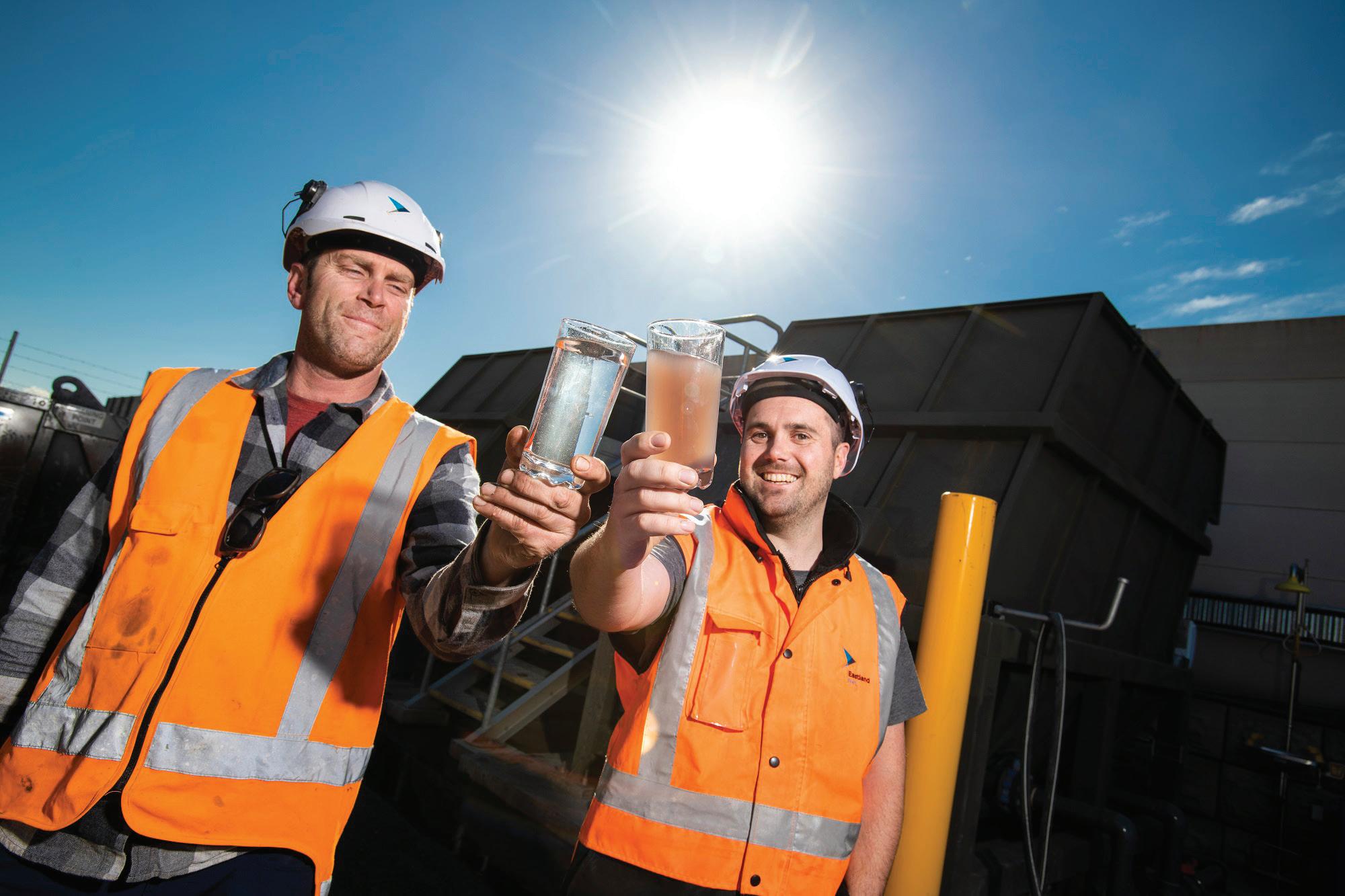
Matt Schmelz and Mark Richards from Eastland Port show the difference lamella clarifiers (shown behind them) are making to stormwater coming off a log yard. The men are happy to drink the cleaned water.

Significant seasonal variability in rainfall occurs at the EPL site, with summer months characterised by short high-volume effects, thunderstorms, and easterly cyclone conditions. Winter months have frequent, prolonged periods of rainfall, with dramatic ranges in intensity.
Sediment loads also vary depending on seasonal patterns, the volume of debris that arrives on the logs, the amount of activity occurring in the yard and the duration of a rain event.
A key adaptation to accommodate this variability was the utilisation of the existing swale as a reservoir to build volume for processing. This buffered the initial sediment flush from storm events and delivered a more consistent inflow product for treatment and better management of chemical dosing ratios.
Another key challenge was the removal of the resultant sludge from the clarifier. Sitting for long periods it became jelly like and would not draw down on its own. This issue was resolved by remobilising the flocculated sludge using progressive cavity pumps in the clarifier to achieve reliable drawdown. The sludge was then pumped in geo-bags to decant off excess water which was channelled directly to the discharge point rather than recirculating it for treatment.
Throughout the trials the volume of chemicals used was monitored to ensure it was affixed to the recovered sediment and not washing out with the discharge. This monitoring has allowed dosage rates to be reduced by 50 percent of those recommended by initial laboratory testing while still achieving the results desired, being a discharge of 30 NTU.
Since system optimisation, discharges from the stormwater treatment plant have produced consistently compliant results of less than 30 NTU, eliminating visible plumes and satisfying regulatory, community and mana whenua expectations.
This system now covers 50 percent of Eastland Port with the remaining areas set

Eastland Port offers a case study of an innovative and integrated approach to industrial stormwater management within a confined site.
to be treated by this process by the end of 2026 (appropriate consents were gained earlier in 2025).
Given the performance of this system these discharge consents were granted for 35 years, the maximum allowable period a consent can be issued for. These consents will also allow for the addition of two more treatment plants, completing coverage of the site.
Reflections for the wider sector
As a result of these works, this innovation has been picked up by other ports including CentrePort, Wellington, and the Port of Tauranga.
Eastland Port’s work offers insight beyond its own boundaries. While every industrial site has its own pressures and constraints, some broader principles stand out:
• Integration is critical: Yard operations, drainage design, and treatment infrastructure need to be considered as a single system, not in isolation.
• Expectations matter: Public perception and community confidence are real drivers of investment. Meeting regulatory limits may not be enough if the outcome remains visibly poor.
• Make the toolbox larger: Industrial
stormwater treatment may require repurposing of solutions from other areas, such as drinking water and wastewater.
• Implementation takes iteration: Field conditions will always reveal gaps in theory. The ability to observe, adapt and rework systems is as important as the initial design.
• Operational commitment is nonnegotiable: Stormwater systems on industrial sites may need much more active management than traditional stormwater treatment. Skilled operators, good data, and regular fine tuning are essential.
The upcoming National Engineering Design Standards and their Codes of Practice provide opportunities in future to reflect good practice approaches in stormwater management and make them business as usual. This will further support innovation and implementation of industrial stormwater solutions.
Share your practice
If you are working on industrial stormwater management, or know of a site doing things differently, we’d like to hear from you. Please contact Nicci Wood at Nicci.Wood@waternz.org.nz to share your experience or suggest a case study.
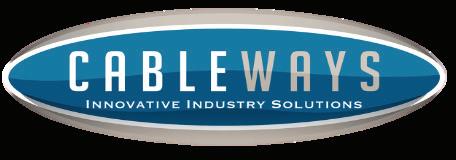






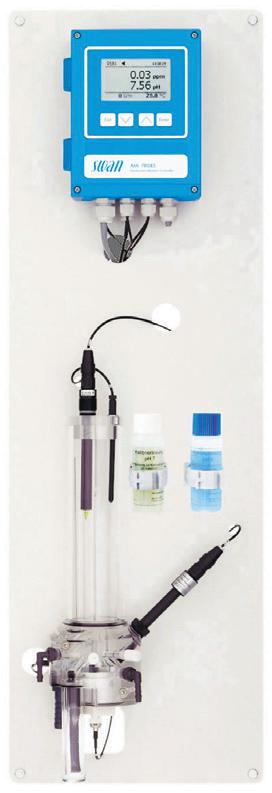
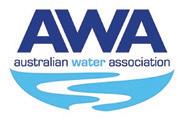










From Ahr Valley to Esk Valley: Lessons in water resilience
When heavy rain turns into disaster, the strength of a region’s water infrastructure is put to the test. The floods in Germany’s Ahr Valley and Aotearoa New Zealand’s Esk Valley were stark reminders how quickly localised rainfall can overwhelm systems and communities. Although geographically distant, both countries are facing strikingly similar challenges.
In July 2021, Germany experienced its largest and deadliest flood disaster in the past 60 years when heavy rainfall caused a catastrophe in Ahr Valley and surrounding areas. In some locations up to 200 litres of rain per square metre fell within hours, causing rivers to rise to levels more than twice the historical records.
The Ahr River and other rivers burst their banks, destroying entire towns and villages. More than 180 people lost their lives, 10,000 buildings were damaged or destroyed, and the damage value was estimated at NZ$30 billion (€15 billion).
The event revealed serious weaknesses in early warning systems, emergency coordination, and infrastructure resilience.
Events like this show how vulnerable even well-developed systems can be. Drinking water supply, wastewater treatment, stormwater networks, and pump stations are at risk. Pipes can be damaged by ground movement and treatment plants can be
temporarily forced to shut down because of flooding or power loss.
Aotearoa New Zealand faced similar devastation in February 2023 during Cyclone Gabrielle, which is described as the country’s most costly non-earthquake disaster. The storm caused an estimated NZ$14 billion in damage, with Hawke’s Bay and the Gisborne region among the worst affected.
In Esk Valley, floodwaters rose so rapidly that homes were submerged within hours. Across the country, 225,000 homes lost power, critical infrastructure was damaged, and entire communities were cut off for days.
These bigger events make the headlines. However smaller, more frequent events are also putting pressure on water systems. Short, heavy rainfalls overwhelm stormwater networks, leading to sewage overflows into rivers, harbours, and coastal areas.
On the contrary, extreme heat and droughts result in dropping


groundwater and river water levels and drinking water supplies can be a risk.
Drinking water safety remains a challenge with small and rural networks being more vulnerable to contamination during floods. The 2026 Havelock North outbreak, caused by contaminated bore water, caused over 5500 of the 14,000 residents to fall ill and serves as a reminder of what can happen when infrastructure, monitoring and emergency response are not aligned.
Although Germany and Aotearoa New Zealand are different in geography and climate, the core problems are comparable. Both are faced with the same question: How can we make our water infrastructure more resilient to cope with the challenges of extreme and unpredictable weather?
Germany has responded with a series of initiatives to combine cutting-edge technologies with integrated planning. One is the WaX
(Water Extremes) programme, which brings together over 80 partners across 12 interdisciplinary projects to develop innovative strategies for managing floods, droughts, and heavy rainfall.
From sponge city concepts that absorb and store rainwater in urban areas, to AI-powered early warning systems and smart water infrastructure, German companies and research institutions are at the forefront of climate adaption in the water sector.
How can Aotearoa New Zealand make sure it does not lag behind but rather learns and benefits from these technologies and solutions?
This November, a group of German companies will visit as part of the project Strengthen Urban Water Resilience with a Focus on Extreme Weather Events, organised by the German-New Zealand Chamber of Commerce Inc (GNZCC) and supported by the German Federal Ministry for Economic Affairs and Energy.
The visiting companies are active in fields such as advanced water
Images: Hochwasser, Ahrtal.
The Ahr River and other rivers burst their banks, destroying entire towns and villages. More than 180 people lost their lives, 10,000 buildings were damaged or destroyed, and the damage value was estimated at NZ$30 billion (€15 billion).
The event revealed serious weaknesses in early warning systems, emergency coordination, and infrastructure resilience.

Although Germany and New Zealand are different in geography and climate, the core problems are comparable. Both are faced with the same question: How can we make our water infrastructure more resilient to cope with the challenges of extreme and unpredictable weather?
treatment and pumping technology, automation and intelligent infrastructure, and precision measurement and control systems.
The visit is not about technology transfer alone, it is about sharing experiences and learning from each other. The German delegation is interested to understand Aotearoa New Zealand’s unique challenges and work with councils, water entities, engineers and local stakeholders to find solutions that are practical, sustainable and future-ready.
As extreme weather becomes more frequent, the need for resilient water systems grows more urgent. But with challenge also comes opportunity. Combining international expertise with local




knowledge enables us to create solutions tailored to Aotearoa New Zealand’s unique landscape, values, and regulatory environment. Solutions that will help protect our communities and waterways for generations to come.
For more information about the project, Strengthen Urban Water Resilience with a Focus on Extreme Weather Events, and how to get involved, contact Kathrin Curtis, Wellington regional manager at the German-New Zealand Chamber of Commerce, kcurtis@germantrade.co.nz.
Article provided by German-New Zealand Chamber of Commerce

Hochwasser, Ahrtal.






Moving forward to improve flood resilience in Wairau
Auckland Council continues to progress its planning for the Wairau flood resilience project to restore part of AF Thomas Park to act as a flood storage wetland and reduce the risk of flooding for the wider Wairau area.

Northern Busway, Auckland Motorway, during the Auckland Anniversary floods in January 2023
“The Auckland Anniversary floods in January 2023 had a devastating impact on Tāmaki Makaurau and many of those who were severely affected are still dealing with the impacts. Wairau was one of the hardest hit areas and tragically saw the loss of lives. This project, co-funded with central government, is about preventing a tragic situation like this from happening again,” says Barry Potter, Auckland Council director resilience and infrastructure.
In August, Auckland Council met with North Shore Takapuna Golf (Takapuna Golf Course), and the technical reference group they have been working with, to discuss its latest alternative option.
“We met with North Shore Takapuna Golf and their technical reference group today and presented to them the final decision on the concept option that the council plans to implement,” says Barry.
“We have assessed the alternative option of a diversion to Shoal Bay, engaged independent consultants to peer review our findings, and spoken with our iwi partners and agencies including the New Zealand Transport Agency Waka Kotahi. On the basis of these considerations, the council is progressing with the wetland and dry detention option it has previously signalled.
“We understand that this news is challenging to the golfing community and especially those in Takapuna.”
Barry emphasises that the primary considerations have always

been the protection of people, property and infrastructure, and to deliver a solution for the community that manages costs within the available budget.
“Our communities have made it clear that this work cannot be delayed – this is about saving lives, protecting homes and businesses, and strengthening Tāmaki Makaurau against flood risk.
“With this in mind, there will be no further consideration given to alternative options. The concept phase is now complete, and our work continues to progress to the preliminary and detailed design phase.”
Auckland Council completed feasibility studies of two proposals, both looking to restore part of AF Thomas Park to a flood storage wetland while keeping the much-loved green space available for Aucklanders to use when the park is not flooded.
The confirmed design concept allows for both flood resilience and recreation to coexist in one blue-green space, including potentially golf, if that’s what the community and local board decide.
Now that there’s a confirmed design concept, the project can move forward.
The project aims to significantly reduce downstream flood flow through Wairau Creek, reducing flood risk to over 250 homes and three residential care homes in Milford. It will also protect critical infrastructure and access to key facilities such
Heavy-Duty AUMA Actuators for Water Treatment
Reliably Manage the Flow of Water
Auma electric actuators deliver reliable valve automation for potable water, wastewater and pump station applications. With quarter-turn models for butterfly valves and multi-turn options for penstocks and knife gates, they offer true versatility.
Variable-speed control ensures smooth operation and protects against water hammer, while flexible power supply options (24 VDC, single- and three-phase) suit any installation.
Submersible Version
The SA-UW submersible series provide enhanced ingress protection up to 15m immersion, plus remote operation up to 100m via AC 01.2 starter—a clear advantage over standard IP68 ratings.
Tailored Solutions Engineered for Endurance
CSE WAF delivers cost-effective solutions designed to safeguard individuals, protect valuable assets and optimise performance with leading actuators.
With a team of specialist engineers harnessing over 90 years of experience, CSE WAF delivers specialised solution design, integration and installation to New Zealand’s water industry. Paired with tailored training and demonstration units, CSE WAF enhances operational efficiency and solution lifecycle.
Robust Design and Protection
SA and SAR series provide IP68-rated ingress protection, high corrosion resistance, wide torque ranges and operate across -40°C to +120°C
Smart Control with PROFOX Range
Support common communication protocols, variable-speed control, soft-start/soft-stop and corrosion protection.
Field-Proven Reliability
Significant install base worldwide, built to last.





as North Shore Hospital and Westlake Boys’ and Girls’ High Schools, as well as Eventfinda Stadium.
The work in AF Thomas Park is a critical first step in reducing the significant flood risk across the Wairau catchment and will enable wider flood resilience works in and around Nile Road, and the commercial areas of Wairau Valley.
A detailed process
After council staff evaluated more than 100 flood mitigation options, the Transport, Resilience and Infrastructure Committee endorsed a business case in April to integrate flood storage with recreational facilities at AF Thomas Park.
At the same April meeting, the committee requested that the
proposed concept be reviewed alongside an alternate proposal put forward by the existing leaseholders of AF Thomas Park, Takapuna Golf Course. The alternative proposal explores if an 18-hole golf course can be retained on the land while providing the same level of flood storage.
The golf club’s initial proposal, creating a large number of smaller stormwater storage ponds throughout the park, was soon found to be unfeasible due to cost and maintenance requirements. The council granted the golf course a onemonth extension to provide an alternative option. A subsequent design was submitted by the golf club which is a very similar approach, both in land formation and stormwater detention, to the Auckland Council design.
Pak'nSave supermarket, Wairau Valley Road, Auckland, during the Auckland Anniversary floods in January 2023.
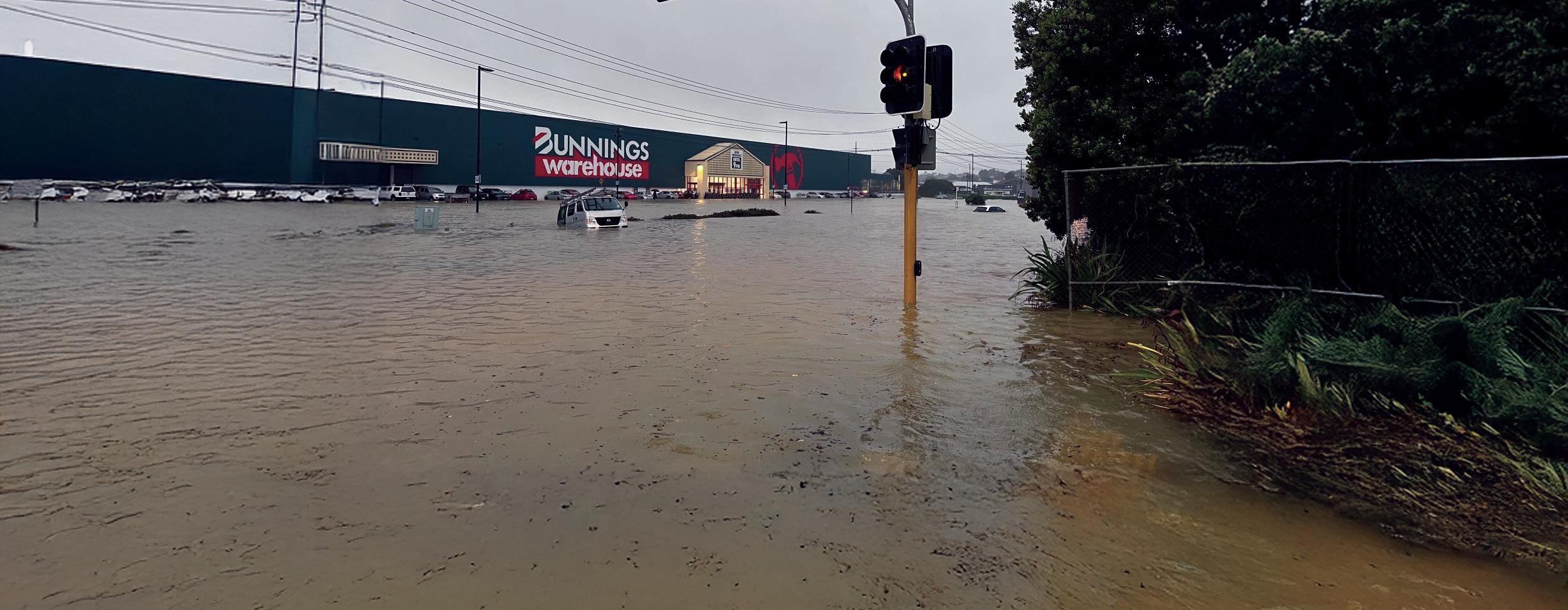
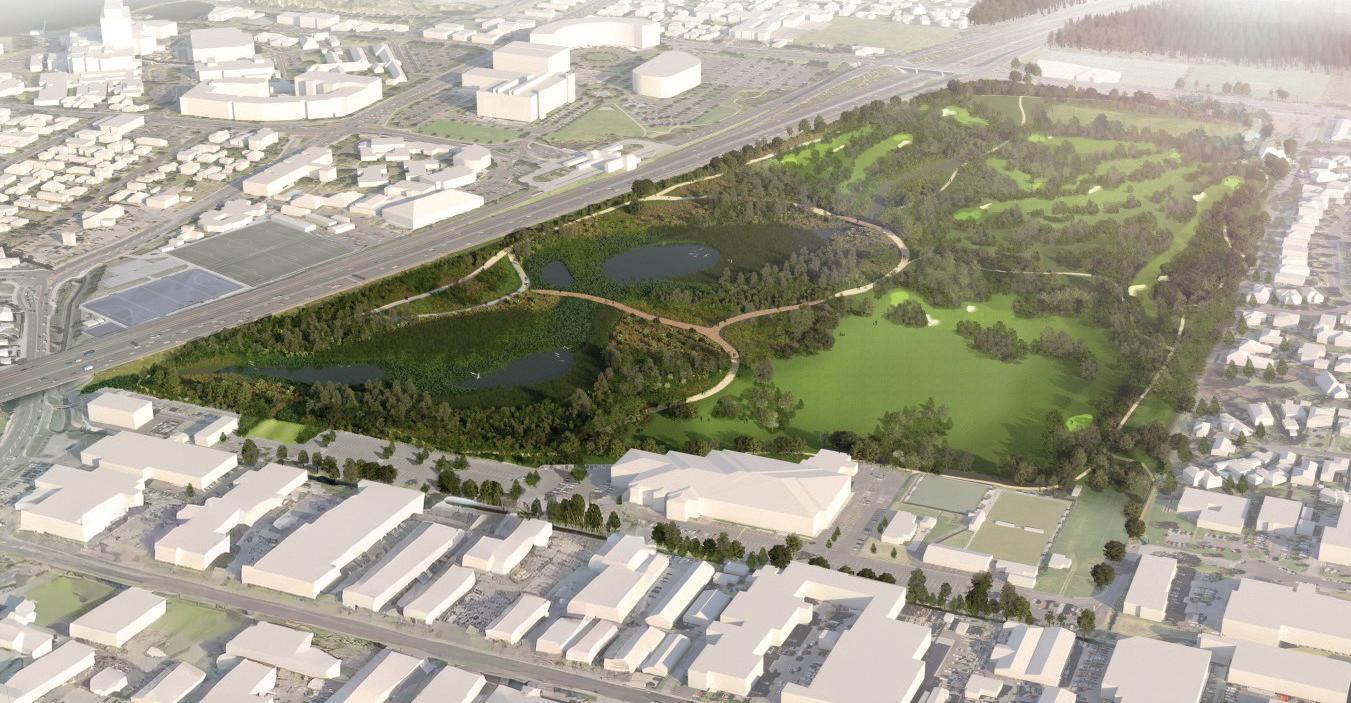
“Both the council proposal and the golf course’s revised proposal have similarities in terms of placement and the method of storing stormwater on the site. We’re confident in the single design concept that’s come out of the feasibility assessment and are ready to move this project forward for our communities,” explains Tom Mansell, Auckland Council’s head of sustainable partnerships (healthy waters & flood resilience).
While this confirmed design concept could allow for a 9-hole golf course and a driving range on the site, how golf may be incorporated into the future use of the park is still to be determined. This will be decided by the Kaipātiki Local Board in consultation with the community, mana whenua, and advice from council staff.
Any additional costs for sport or recreation come at a cost and are currently unfunded and would be subject to Long-term Plan and alternative budget availability.
Additionally, a Community Advisory Group has been established for the project, with representatives from local community groups, rōpū Māori, schools, and the local board to provide ongoing input and help guide decisions that reflect local needs and aspirations.
Consultation with the wider community is planned for later this year to gather ideas and gain feedback into what potential recreational activities could be accommodated in the green areas surrounding the new wetland in AF Thomas Park. All users of AF Thomas Park, local and from further afield, will be encouraged to have their say.
Auckland Council render of proposed Wairau flood resilience project at AF Thomas Park.
Commercial area of Wairau Valley under floodwater.

Frequently asked questions
How was the Shoal Bay diversion option assessed?
Auckland Council’s Healthy Waters and Flood Resilience department has reviewed the Shoal Bay diversion option, as have our design consultants, WSP NZ. To ensure robust analysis, WSP’s report has also been peer reviewed by Tonkin & Taylor.
The assessment and subsequent peer review found that this is not a viable option to address flooding to the community due to construction risks, unaffordability, and an increased risk of downstream flooding.
The council also engaged with iwi partners and with the New Zealand Transport Agency Waka Kotahi to seek their views on the alternative proposal. They were both unsupportive and NZTA Waka Kotahi emphasised the increased risk to one of the country’s most important transport assets, State Highway 1.
Why is this alternative solution not viable?
It is expected to cost about $10-20 million more than the approved approach, it uses a pipe that would introduce the further risk of blockages, which could reduce the system’s ability to prevent flooding during major storms.
Flood modelling indicates that it will increase the risk of flooding to important transport routes downstream. It would require complex and costly maintenance, which could pose safety risks to workers.
It could also cause environmental damage that might not obtain regulatory approval. The design depends on appropriate ground conditions, which have not been tested and are uncertain. If the ground is less stable than expected, particularly under the motorway
structure, the consequences could be serious and resulting in significant cost overruns.
How did the council reach a conclusion so quickly?
Auckland Council had already looked into alternative options, four of which involved diversion of flows to Shoal Bay.
Each included construction of a similar open channel as proposed in the latest alternative proposal. These diversion options were discounted due to significant consenting issues and high estimated costs.
However, the council undertook further analysis to review the proposed option to determine whether there are any notable differences or new considerations not previously assessed. Following this analysis, it was still found to be not viable.
How many options have been considered?
During 2024 and early 2025, over 100 flood mitigation options were assessed to develop the options assessment which was included in the business case endorsed in April by the Transport, Resilience and Infrastructure Committee.
The council also worked closely with North Shore Takapuna Golf to complete a feasibility assessment of an alternative proposal put forward by them as the existing leaseholders of AF Thomas Park, alongside assessing the council’s own proposal.
A single design concept for stormwater detention came out of the feasibility assessment, one that allows for both flood resilience and recreation to coexist in one bluegreen space – and is the one that the council is moving forward with.
Content provided by Auckland Council




DN50-80-100-150 (200-300 in 2026)
R1000 – Extremely low flow registration (DN50 12l/h)
0U / 0D – Installation flexibility
Extensive communications options:
Sensus RF / wMbus / NBIoT Hub / Pulse out
Long asset life – 20 year internal batteries
Exceptional accuracy for leak detection / monitoring
12 user configured alarms
Integrated pressure logging And so much more - talk with us




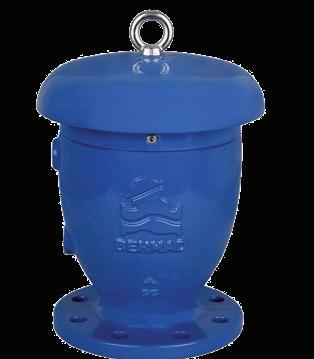


Gabrielle’s intense rainfall made landslides inevitable
Cyclone Gabrielle was one of the most extreme landslide-triggering events ever recorded globally.
It is estimated that more than 800,000 landslides were caused by the extreme weather event, cumulatively covering an area of around 100 square kilometres –about the same size as the city of Napier.
A thorough analysis of the Cyclone Gabrielle landslides led by Earth Sciences New Zealand, reveals that the ground was so saturated by the amount of rainfall, it didn’t matter how wet ground conditions were beforehand – landslides were going to happen.
Study lead author, Earth Sciences New Zealand (formerly GNS Science) engineering geologist Chris Massey, explains that a major factor influencing landslide triggering is how much moisture is already in the soil compared to the amount it can absorb before reaching a critical point and failing.
“In the case of Cyclone Gabrielle, the intense rainfall over a short period overwhelmed the natural drainage systems, and many of the affected slopes were inevitably pushed past their tipping point regardless of the pre-existing soil moisture conditions,” Chris says.
Dr Trevor Carey-Smith, climate scientist at Earth Sciences New Zealand (formerly NIWA), was a co-author on the study, contributing rainfall data and analysis.
“The quantity of rainfall in many locations was unprecedented; inland from Esk Valley 500mm fell in 24 hours –over 50 percent higher than the previous record,” Trevor says.
“Rainfall is typically one of the more important factors influencing likelihood of landslides, so the huge quantity of water that fell over a short period of time meant we weren’t surprised that landslides occurred during the event –however the sheer number triggered was astonishing.
“We already know from attribution studies that climate change contributed to the intensity of rainfall during Cyclone Gabrielle and that this is likely to increase further in future.”
The study, published in Landslides Journal, found that, aside from rainfall, the most significant factors influencing landslide locations were geology type,
vegetation type and, of course, the steepness of the slope. Chris says areas covered in scrub and grassland were much more prone to landslides than those with forest.
“In regions like Tairāwhiti-Gisborne and Hawke’s Bay the density of small and shallow landslides occurring in areas with scrub and grassland was extremely high – up to 327 landslides per square kilometre. Such landslide densities are typically much higher than those associated with rainstorms overseas.
“Interestingly, indigenous forests offered better protection than exotic forests.”
Chris notes that places where vegetation had been lost in recent years (three to five years preceding Cyclone Gabrielle) were more likely to experience landslides.
This finding demonstrates a clear link between deforestation and increased landslide triggering. We hope this research can support informed decisions about land use in the future to help mitigate these disruptive events.
ESNZ engineering geologists Chris Massey and Kerry Leith survey Cyclone Gabrielle landslides in Hawke's Bay.
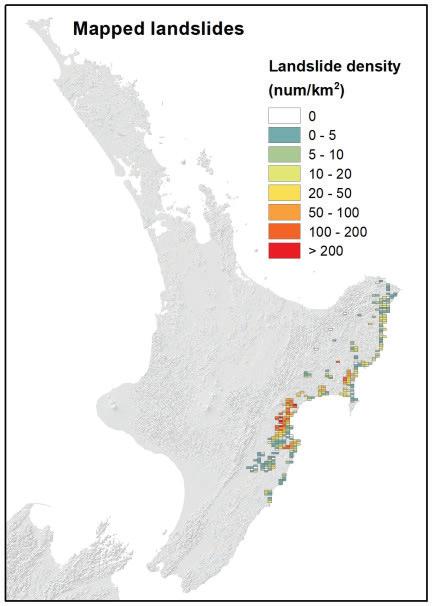


“And with climate change increasing the frequency and intensity of cyclones, there has never been a more pressing time to use science to adapt to our changing conditions and support people, industry and government to be more resilient.”
Contributing author, University of Canterbury senior lecturer in disaster risk and resilience Dr Tom Robinson, led a group of students who mapped most of the landslide data over a nine-month period for the study.
The data and findings from Cyclone Gabrielle research will support the development of national-scale landslide models to forecast areas where rapid and dangerous landslides may occur and what their impacts could be.
“As far as we are aware, this is the largest number of landslides ever mapped for a single storm, certainly in New Zealand, and provides a valuable source of information for future landslide modelling,” Tom says.
“This research has given UC students a unique opportunity to be part of core research that will better inform our understanding of landslides during major storms and how the community can adapt to our changing climate conditions.”
Article provided by Earth Sciences New Zealand (recently formed by the merger of NIWA and GNS Science). To read the paper, visit tinyurl.com/3fp34ppj
VISIT US AT THE WATER NEW ZEALAND CONFERENCE
ENGINEERED PUMPING SOLUTIONS
BORE HOLE | FLOOD | PRESSURE BOOSTERS | BOTTOM INTAKE
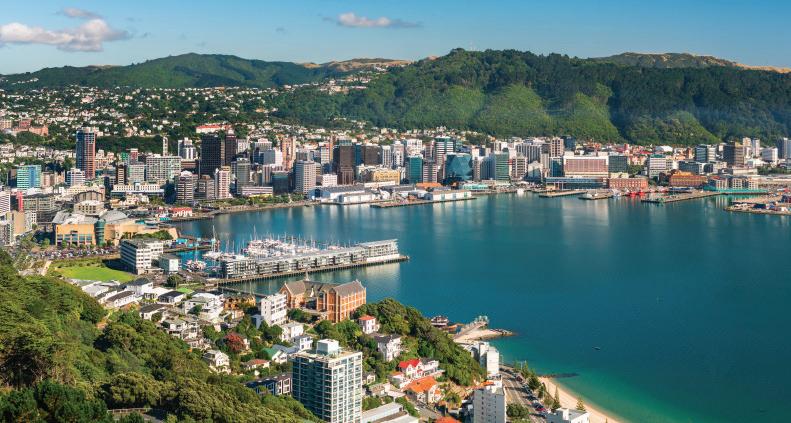



Left: Landslide densities per square kilometre using the mapped landslides within priority areas that were mapped. Middle: Maximum 24-hour rainfall across the North Island for the Cyclone Gabrielle event. Right: Soil moisture content across the North Island one day ahead of Cyclone Gabrielle.

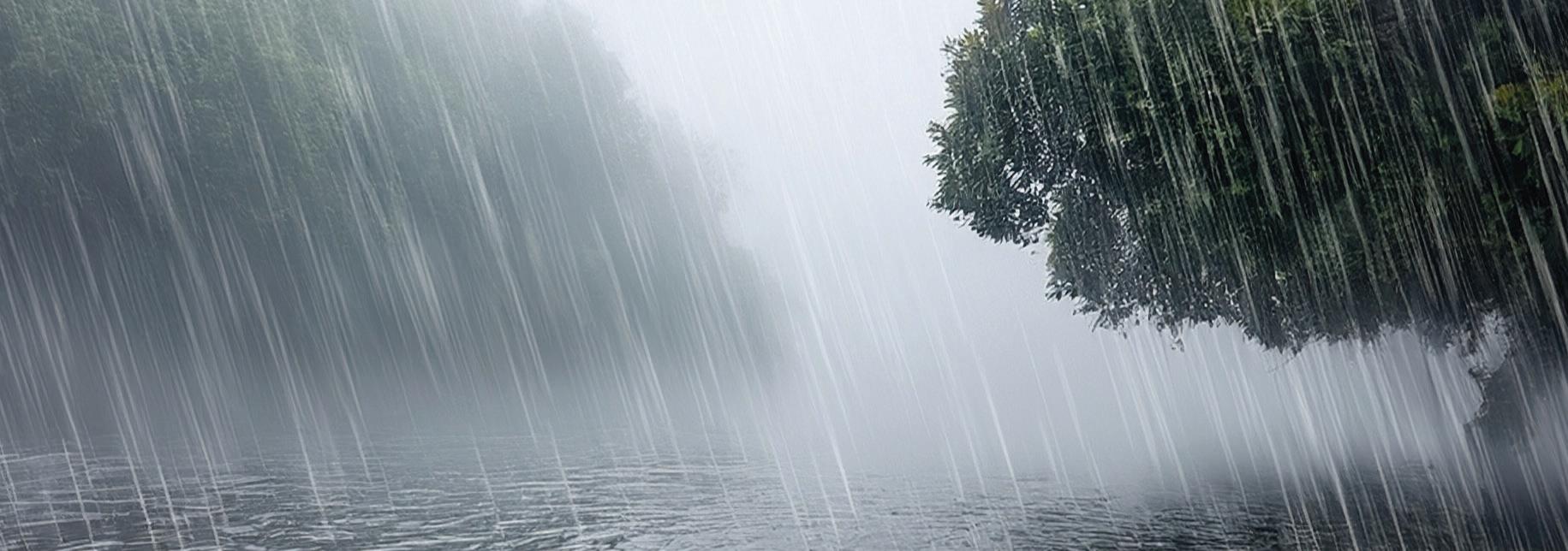
Rain from tropical cyclones to increase under warmer climate
New high-resolution modelling predicts that rainfall from tropical cyclones will significantly increase under global warming.
Earth Sciences New Zealand and the University of Waikato found that, under a high emissions scenario, extreme rainfall from cyclones could rise by up to 35 percent across the southwest Pacific, including for ex-tropical cyclones impacting Aotearoa New Zealand.
Researchers used the latest climate change projections released last year by Earth Sciences NZ (then NIWA) with the Ministry for the Environment.
Study lead and climate scientist Dr Peter Gibson says they simulated more than 1800 years of data from different climate models and levels of greenhouse gas emissions.
“We wanted to assess how the frequency and severity of tropical cyclones in the southwest Pacific may change by the end of the century. Under the full range of climate scenarios examined there was an increase in tropical cyclone rainfall. This was proportional to the rate of emissions, with the most pronounced rise in extreme rainfall occurring under the highest emissions.
“If that scenario plays out, we can expect around 30 to 35 percent more extreme rainfall during tropical cyclones than we experience today. Even under the best-case scenario, we will still see an increase proportional to the warming experienced. Extreme windspeeds are also likely to increase, but not to the same extent.”
The more greenhouse gases that are emitted, the higher temperatures get, with a high emissions scenario representing around a 3°C increase by the end of the century. A warmer atmosphere holds more water – so when storms develop, they have access to more water vapour that can be released as heavier rainfall.
And while the model simulations didn’t show an overall increase in the total number of cyclones by the end of the century, there is compelling evidence that the strongest (category 4 and above) will become more frequent.
“One or two ex-tropical cyclones typically affect New Zealand each year. However, it’s the really big, much rarer events that cause the most damage. And the difference between a river
flooding or not can often be small, so any increase in rainfall is significant and potentially very impactful.”
The February 2023 Cyclone Gabrielle, which at its peak reached Category 3, and the Auckland Anniversary weekend event, resulted in total estimated costs of $14.5 billion, with the total insured losses for both events totalling $3.8 billion, with $1.8 billion from Cyclone Gabrielle claims, and $2 billion from the Auckland anniversary weekend event – most of the claims were because of widespread flooding.
Until now, most projections of tropical cyclones have relied on global climate models, which have a relatively low spatial resolution. This work refines those models to a regional scale that can zoom in closer and get a much more accurate picture.
“The eye of a cyclone is fairly compact, at only tens of kilometres across. Global climate models are coarse, with each pixel going down to around 100km, meaning they miss much of the crucial detail and small-scale physics of a storm.
“Our refined regional model goes down to around a 12km resolution, making it a state-of-the-art dataset for assessing extropical cyclones that impact New Zealand.”
These findings, published in the Journal of Geophysical Research: Atmospheres (agupubs.onlinelibrary.wiley.com/ doi/10.1029/2025JD043833), are consistent with other studies around the world, highlighting the potential for more intense tropical cyclones and heavier rainfall in the future. This indicates increasing risks for vulnerable communities across the southwest Pacific and Aotearoa New Zealand.
“It’s clear that if we reduce emissions, we reduce warming, and we mitigate the worst impacts of severe weather events. As computing capabilities improve, newer, high-resolution models will become available to create even more accurate and reliable long term climate projections of cyclones and their impacts.
“More research is being undertaken by Earth Sciences NZ into specific weather and climate hazards in the projections, to provide clarity on the future climate New Zealanders are likely to face in the decades to come.”
Article provided by Earth Sciences NZ





Casting for cores to strengthen lakes’ resilience to extreme climate events
Layers of mud on the bottom of Hawke’s Bay’s lakes are a hidden archive of the impacts of Cyclones Gabrielle and Bola on the lakes’ ecosystems, holding vital insights to shape lake management and restoration in the face of increasing extreme weather.
Scientists from the Our Lakes, Our Future research programme are studying sediment from Lakes Tūtira and Waikōpiro, to understand the response and recovery of lake ecosystems to the cyclones, and potential land-use strategies to buffer future impacts.
Lake ecosystems choked by cyclone silt and mud
When extreme events, such as Cyclone Gabrielle in 2023, lash the landscape with heavy rain, landslides and erosion in the hills carry a huge volume of silt and mud into surrounding streams. This sediment eventually washes into lakes, causing large disturbances to the aquatic plants, animals and organisms living there.
As well as smothering important māhinga kai populations, such as kākahi (freshwater mussels), the sediment brings nutrients from the landscape – nitrogen and phosphorous – that can cause algal blooms and severe environmental effects.
The flow of sediment into lakes can be prolonged, with the landslides that were triggered in the surrounding catchments continuing to provide a source of increased sediment during rainfall, long after the cyclone has passed.
With the frequency and severity of storms projected to intensify under climate change, understanding how these events impact lake ecosystems is key for safeguarding lakes, so that we can continue to enjoy them for recreation, gather food from them, and protect their cultural value into the future.
Tracing cyclone impacts back through time
Lakes Tūtira and Waikōpiro sit side-by-side in north-eastern Hawke’s Bay and provide a unique case study for research into extreme climate impacts. In addition to Cyclone Gabrielle, the lakes were also impacted by Cyclone Bola in 1988, with the record of the lakes’ response to this historical event preserved in the lakebed sediment.
Our Lakes, Our Future team members from GNS Science, Victoria University of Wellington, Otago University, and Waka Tuarua carried out fieldwork at the lakes in April. They retrieved 10 sediment cores, ranging between 1.5 to six metres in length, and collected sediment samples from automated traps that sit on the lakebed collecting monthly samples.
A range of analytical techniques such as sedimentary eDNA (environmental DNA) and examination of the remains of organisms trapped in the sediment, will be used to build an understanding of the organisms that were present, from bacteria through to algae, insects, fish and plants, and how the populations have changed through time.
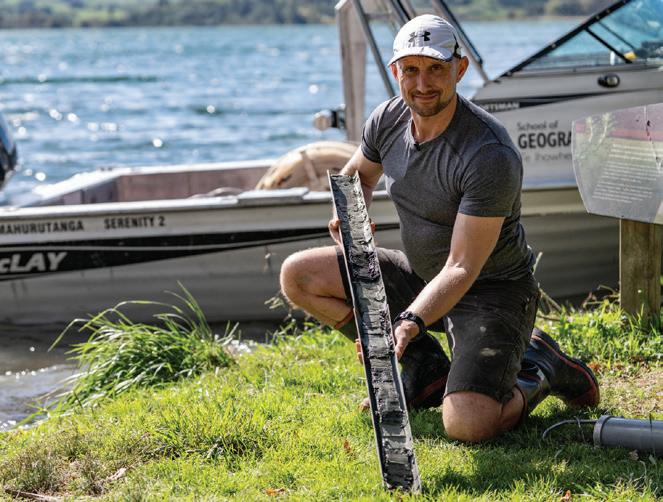
Howarth, Our Lakes Our Future researcher and associate professor at Victoria University, says that when sediment is mobilised and washed into the lake during an extreme storm, it forms an easily identifiable deposit in the sediment core.
“We look at the sediment that accumulated before and after the weather event, and what was happening in the lake ecosystem. Through this comparison we can understand how long the lake ecosystem remains disturbed, and how long it takes to recover.”
Informing future lake restoration and management
Initial observations from the cores underscore the importance land-use practices can play in mitigating or amplifying the effects of extreme climate events.
The cores show that during Cyclone Bola, a similar amount of sediment accumulated in both Tūtira and Waikōpiro. However, during Cyclone Gabrielle much less sediment entered Waikōpiro in comparison to Tūtira.
The team suspect that this difference is due to changes in the catchment around Waikōpiro – while Tūtira remains largely in pasture, in the years following Cyclone Bola, Waikōpiro was planted in Manuka, and wetlands were restored where the stream enters the lake. These actions may have helped trap the sediment and prevented it entering Waikōpiro in such large amounts or dissipated the impact of extreme rainfall on the soils.
The team will use the data gleaned from the sediment cores to help test and refine models, to forecast how lakes ecosystems will fare in our changing climate.
“The models will be a really vital management tool for understanding what restoration practices we need to do to ensure that these taonga, these amazing lakes, are resilient into the future,” says Jamie.
Article provided by Earth Sciences New Zealand (formerly GNS Science).
Jamie
Jamie Howarth with a sediment core from Lake Tūtira, split open to reveal the silt deposited by Cyclones Gabrielle, Bola and earlier storm events (lighter grey layers). Photo courtesy of:




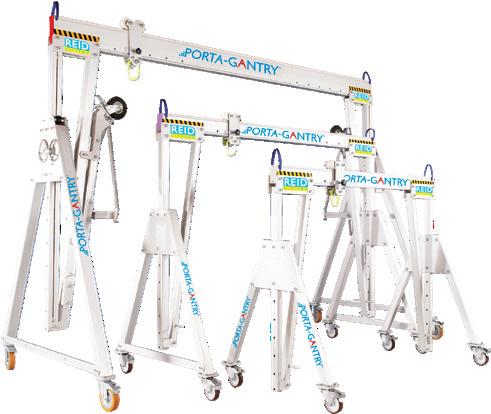

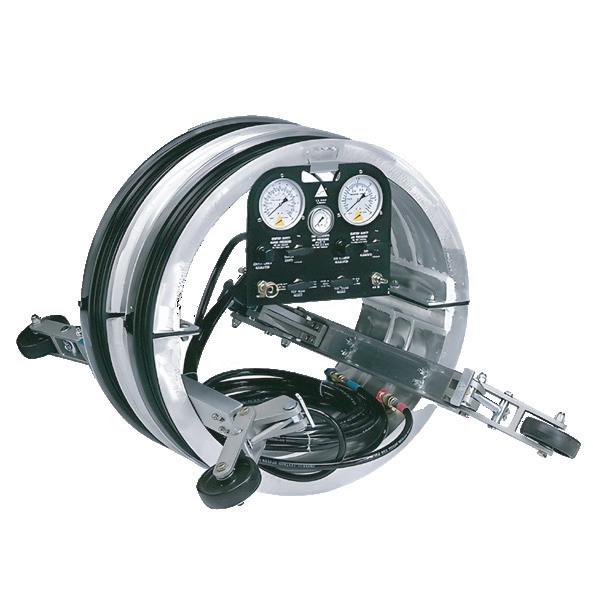
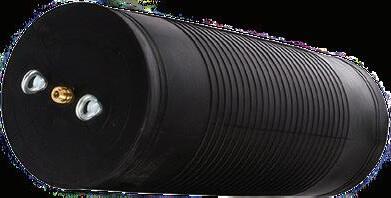



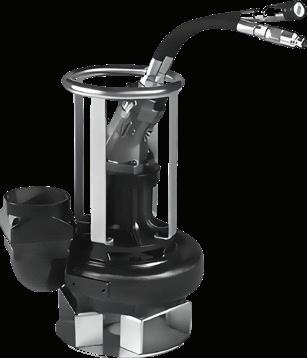



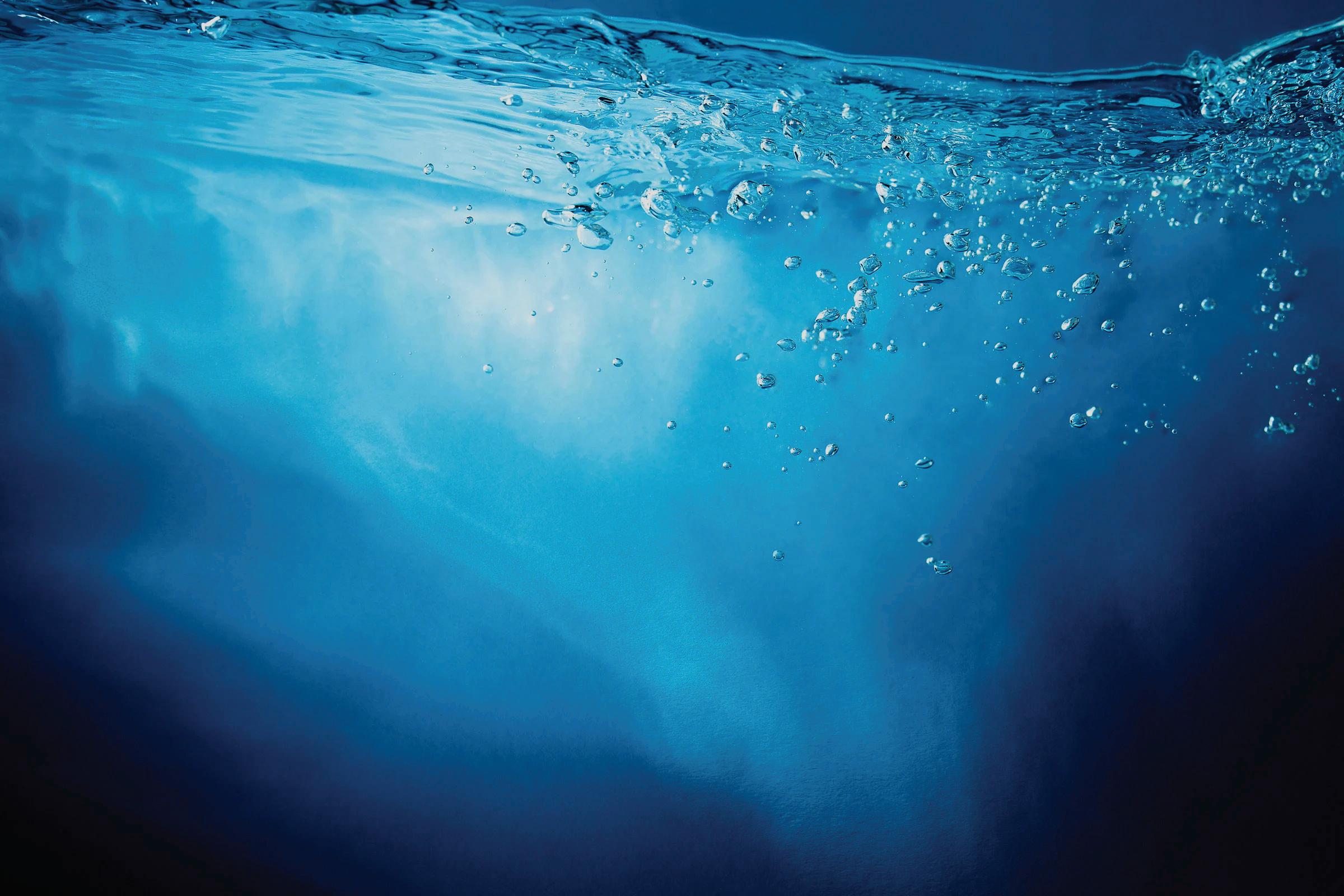




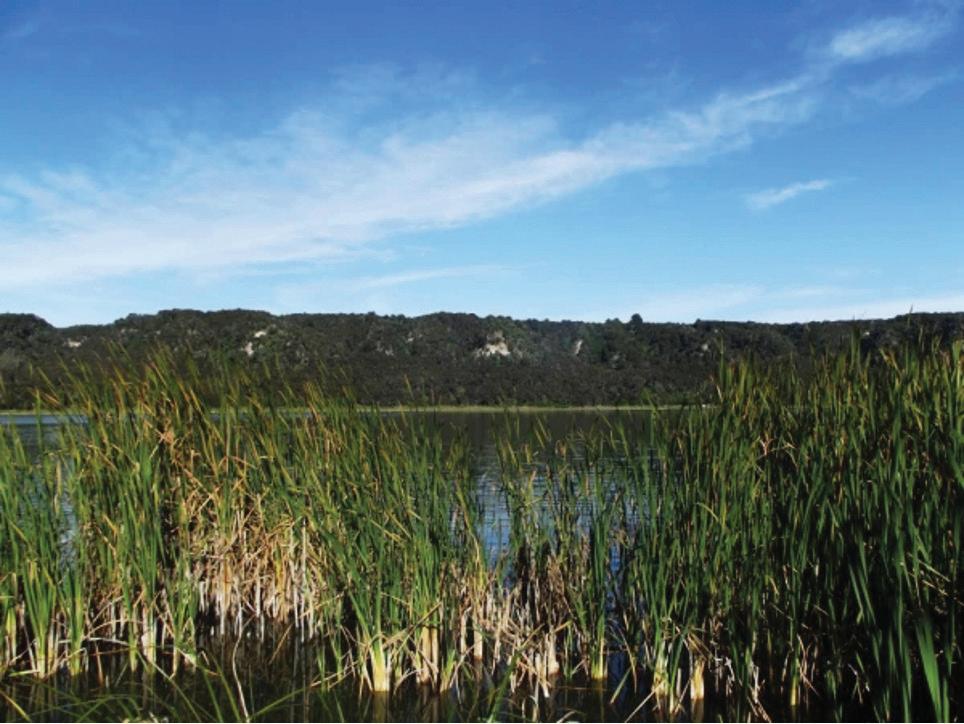
Experts highlight challenges and priorities for restoring Waikato lakes
Waikato’s lakes urgently need better management and restoration with many of the hundreds of lakes in the region significantly degraded.
Waikato is home to a diverse range of lakes, and experts say they urgently need better management and restoration. University of Waikato freshwater scientist Dr Deniz Özkundakci says “a lot, if not most” of the hundreds of lakes in the region are significantly degraded and in urgent need of action to protect and restore their health.
“At the same time, we have some truly hidden gems – lakes that rank among the best in the country. The region includes the full spectrum of lake condition, from outstanding lakes to some of the most degraded,” he says.
The findings are part of a newly released book, a joint venture by the University of Waikato and the Waikato Regional Council. Lakes often hold strong emotional value for people, whether it be childhood memories of learning to swim, fishing or water skiing,
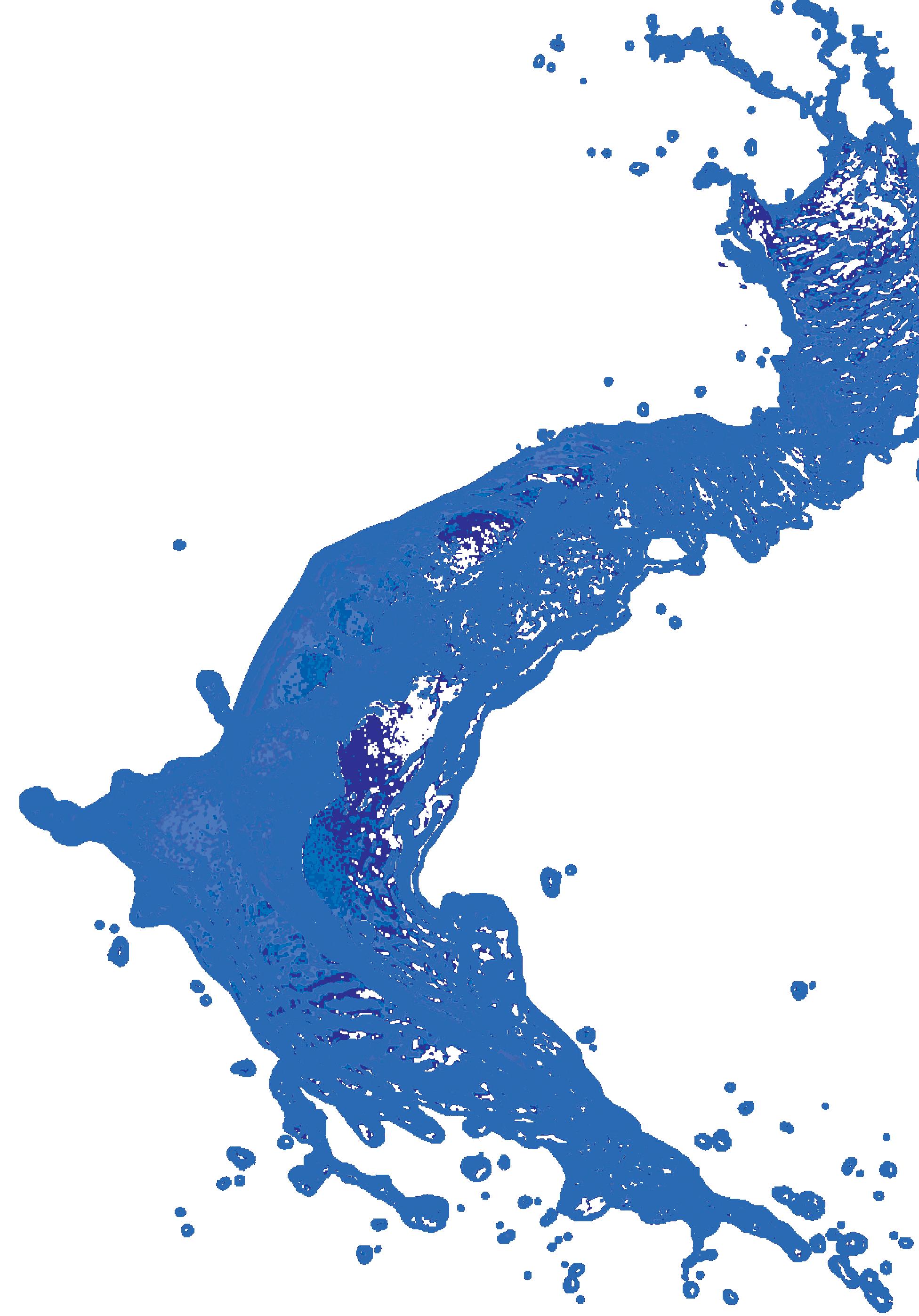
to summer holidays with family, Deniz says. However, farming and urban development has resulted in several lakes being much smaller and shallower than they were in the early 1900s.
Water quality remains one of the biggest concerns.
“Most of the lakes are all enriched in nutrients, particularly phosphorus and nitrogen from farmland runoff, causing algae bloom and turning the water a bright green and making it smell bad.
“In some lakes, aquatic plants have disappeared entirely. Where plants remain, they’re often overrun by invasive species. We’ve also lost many lake birds that relied on native plants and the food they provided.”
But it’s not all doom and gloom, says Deniz, who noted that many community groups have started to get involved in restoration efforts.
Lake Rotongaio as pictured in the newly published book,
However, he says that “while promising efforts are underway, scaling them up will be essential to deliver the widespread impact that is urgently needed”.
Deniz also notes that many of Waikato’s hidden lake treasures are tucked away on private land and far from major roads or access points, making them largely unknown and inaccessible to the wider public.
“People often don’t even know these lakes exist, and many of the really beautiful ones are located on private property.
“This makes it very difficult to access them and work on protecting these valuable ecosystems.”
He says there are examples where lake health has improved when the right work has been done.
“Improvements are always possible if enough resources are put in. But often the limiting factor is the lack of resources like people power and money. At some point though, we need to have honest conversations about priorities.
“Every time we come to a lake, and we talk to the local community, they say that giving up is not an option for us – I know that. At the same time, several contributors to this book have made it clear just how difficult it will be to restore all of the lakes.”
“In some lakes, aquatic plants have disappeared entirely. Where plants remain, they’re often overrun by invasive species.“
He emphasised the importance of ongoing dialogue and collaboration, while also acknowledging the challenges.
“There is recognition that restoring ecosystems requires both scientific insight and inclusive governance.”
The book, ‘Hidden Gems of the Waikato’, brings together contributions from 82 authors from a range of disciplines and organisations. It includes chapters on lake geology and formation; plants and animals found in lakes and lake restoration. It looks at policy and economic considerations and includes personal reflections from contributors.
Co-editor Natasha Grainger, Waikato Regional Council’s team leader – biodiversity, says she is thrilled the book has been published and is proud of the collaborative effort of the authors.
“It has been a big task to compile all of the information in a way that will be engaging and useful to readers, but we are satisfied we have done exactly that.”
‘Hidden Gems of the Waikato’ will be available for purchase by the public. Free copies will be provided to schools, libraries, and community groups active working in this area.
Article provided by the University of Waikato.

'Hidden Gems of the Waikato'.

Three types of drought, and why there’s no such thing as a global water crisis
By Filippo Menga, visiting research fellow, professor of geography, University of Reading.
Hosepipe bans have been announced in parts of England this summer. Following the driest spring in over a century, the Environment Agency has issued a medium drought risk warning, and Yorkshire Water introduced restrictions.
It’s a familiar story: reduced rainfall, shrinking reservoirs and renewed calls for restraint: take shorter showers, avoid watering the lawn, turn off the tap while brushing your teeth.
These appeals to personal responsibility reflect a broader way of thinking about water: that everyone, everywhere, is facing the same crisis, and that small individual actions are a meaningful response. But what if this narrative, familiar as it is, obscures more than it reveals?
In my new book, ‘Thirst: The global quest to solve the water crisis’, I argue that the phrase ‘global water crisis’ may do more harm than good. It simplifies a complex global reality, collapsing vastly different situations into one seemingly shared emergency.
While it evokes urgency, it conceals the very things that matter: the causes, politics, and power dynamics that determine who gets water and who doesn’t.
What we call a single crisis is, in fact, many distinct ones. To see this clearly, we must move beyond the rhetoric of global scarcity and look closely at how drought plays out in different places.
Consider the UK, the Horn of Africa, and Chile: three regions facing water stress in radically different ways.
UK: A crisis of infrastructure
Drought in the UK is rarely the result of absolute water scarcity. The country receives relatively consistent rainfall throughout the year. Even when droughts occur, the underlying issue is how water is managed, distributed and maintained.
Roughly a fifth of treated water is lost through leaking pipes, some of them over a century old. At the same time, privatised water companies have come under growing scrutiny for failing to invest in infrastructure while paying billions in dividends to shareholders. So calls for households to use less water often strike a dissonant note.
The UK’s droughts are not just the product of climate variability. They are also shaped by policy decisions, regulatory failures and eroding public trust. Temporary scarcity becomes a recurring crisis due to the structures meant to manage it.
Horn of Africa: Survival and structural vulnerability
In the Horn of Africa, drought is catastrophic. Since 2020, the region has endured five consecutive failed rainy seasons – the worst in four decades. More than 30 million people across Ethiopia, Somalia and Kenya face food insecurity. Livelihoods have collapsed and millions of people have been displaced.
Climate change is a driver, but so is politics. Armed conflict, weak governance, and decades of underinvestment have left communities dangerously exposed. These vulnerabilities are rooted in longer
histories of colonial exploitation and, more recently, the privatisation of essential services.
Adaptation refers to how communities try to cope with changing climate conditions using the resources they have. Local efforts to adapt to drought (such as digging new wells, planting drought-resistant crops, or rationing limited supplies) are often informal or underfunded.
When prolonged droughts strike in places already facing poverty, conflict or weak governance, these coping strategies are rarely enough. Framing climate-induced drought as just another chapter in a global water crisis erases the specific conditions that make it so deadly.
Chile: Extraction and exclusion
Chile’s water crisis is often linked to drought. But the underlying issue is extraction. The country holds over half of the world’s lithium reserves, a metal critical to electric vehicles and energy storage.
Lithium is mined through an intensely water-consuming process in the Atacama Desert, one of the driest places on Earth, often on indigenous land. Communities have seen water tables drop and wetlands disappear while receiving little benefit.
Chile’s water laws, introduced under the Pinochet regime, allow private companies to hold long-term rights regardless of environmental or social cost. Here, water scarcity is driven less by rainfall and more by law, ownership and global demand for renewable technologies.
Framing Chile’s situation as just another example of a global water crisis overlooks the deeper political and economic forces that shape how water is managed – and who gets to benefit from it.
No single crisis, no single solution
While drought is intensifying, its causes and consequences vary. In the UK, it’s about infrastructure and governance. In the Horn of Africa, it’s about historical injustice and systemic neglect. In Chile, it’s about legal frameworks and resource extraction.
Labelling this simply as a global water crisis oversimplifies the issue and steers attention away from the root causes. It promotes technical solutions while ignoring the political questions of who has access to water and who controls it.
This approach often favours private companies and international organisations, sidelining local communities and institutions. Instead of holding power to account, it risks shifting responsibility without making meaningful changes to how power and resources are shared.
In “Thirst”, I argue that the crisis of water is a cultural and political one. Who controls water, who profits from it, who bears the cost of its depletion: these are the defining questions of our time. And they cannot be answered with generalities. We don’t need one big solution. We need many small, just ones.
This article first appeared in The Conversation, theconversation. com/three-types-of-drought-and-why-theres-no-such-thing-as-a-globalwater-crisis-260723.
Armatec Environmental: FROM CONCEPT TO CONSTRUCTION
The Central Interceptor is the largest wastewater project in New Zealand history and Armatec Environmental is the Odour Control System partner for Watercare and Gella Abergeldie JV at the May Road Air Treatment Facility in Tāmaki Makaurau / Auckland.
The May Road Air Treatment Facility (May Rd ATF) is on a small site with complex geology. It is in the wind shadow of Puketāpapa / Mt Roskill and has residential and light commercial neighbours close by.
Starting with these challenging constraints, Armatec led the design of the May Rd ATF from concept through to the construction of a highly innovative Odour Control System (OCS) – that met and added value to the original brief.
This complex system is at the mid-point of the 16.2km, 4.5m diameter Central Interceptor tunnel, running from Pt Erin to Māngere. It is positioned where two key flows combine, the main tunnel and the branch Link Sewer C tunnel.
Sewer gases are extracted here at automatically varying flowrates by the OCS, based on changing sewer conditions. The plant is engineered to exacting standards and treats between 9,000 m3/hr32,400 m3/hr of odour.
It has two stages of odour treatment with vessels and ducting both above and below ground, arranged to minimise
the site footprint. Stage one, the Biological Trickling Filter (BTF), harnesses naturally occurring bacteria to remove the vast majority of incoming odour.
Stage two, the polishing stage, utilises activated carbon to remove any remaining odours, before discharging at height via two stacks.
The facility has an innovative, low-profile, false-façade design to blend in with the surrounding light industrial buildings. It features extensive noise controls to minimise impact on the community.
The system was designed and built at the Armatec factory in Taranaki with installation and commissioning being undertaken onsite. Ongoing operational and maintenance support is also being provided.
Proudly locally owned and operated, Armatec has been working to reduce emissions to the environment for over 43 years in Aotearoa New Zealand and abroad.
For any odour control challenge, need or operation phone: +64 6 755 0410 or email: enquiries@armatec.co.nz






Alpine springs under threat from fastspreading weeds
Fast-spreading lowland weeds are invading high-country springs, but University of Canterbury (UC) researchers are working to protect these once-pristine biodiversity hotspots.
Professor Angus McIntosh and Dr Helen Warburton from the university’s School of Biological Sciences are supervising research into the sudden spread of aquatic weeds in the upper Waimakariri.
The study, led by master’s student Saskia Brown, is examining how these typically lowland species – monkey musk and watercress – are now establishing in highcountry waterways. Recent growth observed at UC’s Cass Field Station near Arthur’s Pass has provided an opportunity to better understand their presence and potential impact in these alpine ecosystems.
“These aquatic weeds are well-known for overtaking lowland waterways but are now appearing at alarming rates in alpine spring systems,” Helen says.
“The springs are biodiversity hotspots, a refuge for native species with cold, clear water and rich invertebrate life, but that’s rapidly changing.”
“Some springs are still untouched, and others are already overwhelmed. We have a window of opportunity to act; either we manage this now, or we risk losing these habitats for good.”
Saskia has drawn on UC student data from 2004 to track ecological changes over time.
“These invasive weeds are now widespread, even in remote areas. Our data shows that the changes are relatively recent and rapid, and they are reshaping stream life by reducing invertebrate diversity,” she says.
The research has ruled out nutrient enrichment as a driver, and the team is now exploring other possible causes, including rising temperatures, grazing by introduced animals, and human or animal-assisted seed spread.
Angus says while the Department of Conservation has begun controlling some weed outbreaks, Saskia’s research is designed to drive broader regional responses and advocate for effective, practical strategies to support long-term weed removal.
“Springs that once supported distinct and diverse invertebrate communities are now becoming increasingly uniform, dominated by species like the invasive mud snail. Slowed water flow and dense weed growth are replacing the rocky streambeds that many native species rely on,” he says.
The UC research team stresses that long-term success depends on collaboration with local landowners, agencies, and communities to develop cost-effective, ecologically sound solutions that also recognise cultural values, including the role of watercress as a traditional food source.
Brown’s research is supported by the University’s Cass Field Station and builds on earlier undergraduate summer projects, reinforcing the long-term value of studentled science in protecting the country’s unique environments.
Article provided by the University of Canterbury.
SMART INFRASTRUCTURE .

Councils,











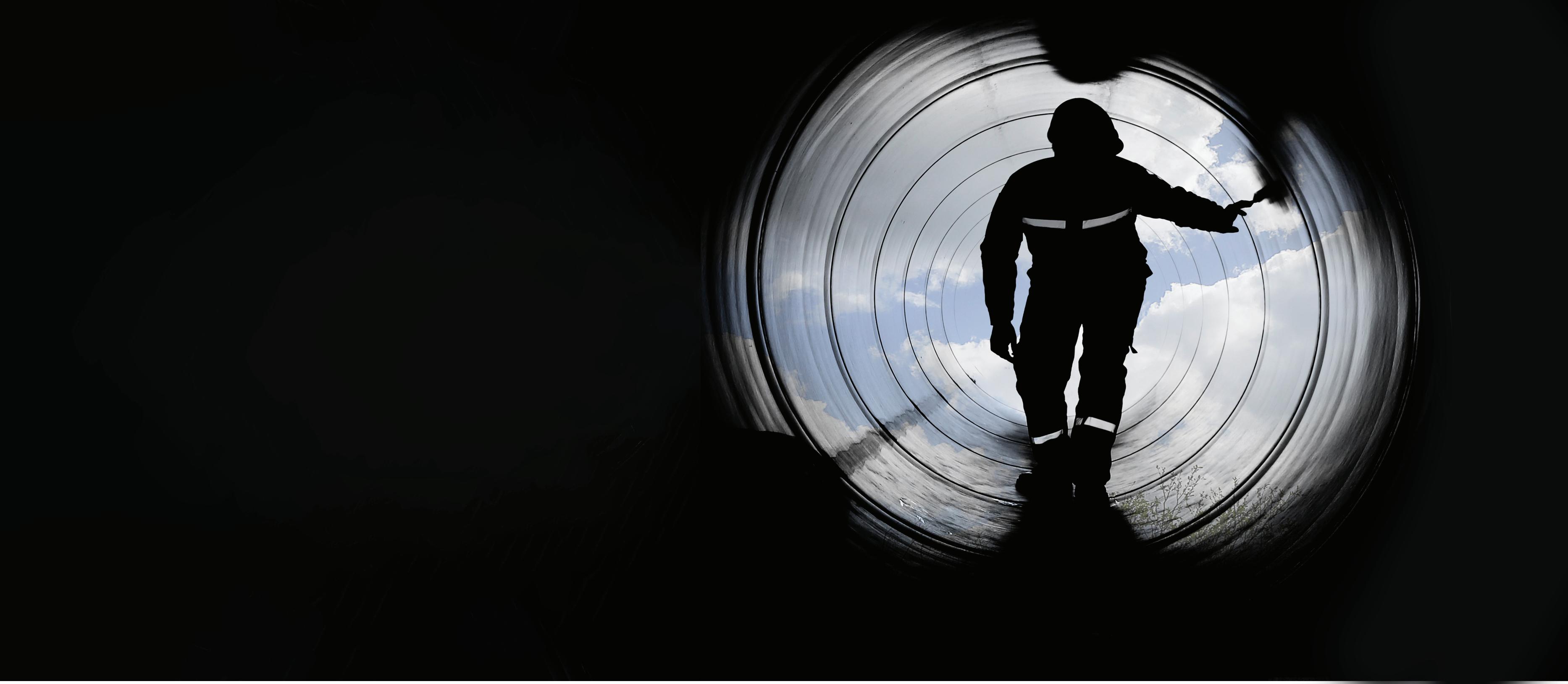








A Threatened Frog Index for Australia
Frogs are key bioindicators of waterway health and the overall condition of freshwater ecosystems. Australia is home to over 250 frog species, many of which occur nowhere else in the world. These species face many significant threats including disease, climate change, habitat loss, introduced species and pollution.

Many of Australia’s frogs were hit particularly hard by the introduction of chytrid fungus back in the 1970s, though there have been reports of some species recovering in recent years.
So, what is the current status of Australia’s threatened frog species? Up until recently it would have been impossible to answer this question but now, thanks to Australia’s Threatened Species Index (TSX), we have a much clearer picture.
Here, Geoffrey Heard, Sarah McGrath and Tayla Lawrie explain how the TSX is helping us understand the parlous state of our threatened amphibians – imperilled frogs continue to decline and very steeply in some cases. However, the TSX helps focus our efforts on the best ways to save our precious frog fauna.
Last year, or any year before that, you would have been unable to provide a simple answer to this simple question: Are Australia’s threatened frogs still declining or have they recovered? This year, you can.
If we step back a little, a question like this would be an obvious thing for a politician, a government agency or a funding body to ask. The reason is that while many of Australia’s frogs were hit hard by the introduction of chytrid fungus to the continent in the 1970s, there have been promising reports of species recovering in recent years.
The beautiful Fleay’s barred frog from the rainforests of southeast Queensland and northern New South Wales is a key example. Populations of this species have grown markedly over the past two decades, and the species has even recolonised locations from which it was extirpated by the fungus.
But what about others, and what of the collective trend?
Have Australia’s threatened frogs rebounded after chytrid’s full impact, or is the pathogen – or other threats – driving ongoing declines?
Enter the TSX
Questions such as these are the reason the Threatened Species Index (TSX) exists. Established in 2016 at the Centre for Biodiversity and Conservation Science at the University of Queensland –through the Herculean efforts of professor Hugh Possingham, Dr Elisa Bayraktarov, associate professor Ayesha Tulloch and Dr Micha Jackson – the TSX collates monitoring data for Australia’s
threatened and near-threatened taxa and estimates abundance trends.
The TSX seeks to be an objective measure of change in the populations of Australia’s imperilled species, as well as a repository for all the hard-won monitoring data collected over recent decades. It is the only infrastructure presently available to do either of these things and is now a key biodiversity metric for the country.
It is used in the Australian Government’s ‘State of the Environment’ report and is also the biodiversity metric for Treasury’s ‘Measuring What Matters’ initiative – Australia’s first national well-being framework.
Today, the TSX is a key product of the National Collaborative Research Infrastructure Strategy (NCRIS)-enabled Terrestrial Ecosystem Research Network (TERN), cofunded by the Australian Government’s Department of Climate Change, Energy, the Environment and Water.
The TSX continues to grow. The index first covered birds (2018), then integrated mammals (2019) and then plants (2020). From 2021 to 2023, the index remained at this coverage, although the team were working hard behind the scenes to update existing datasets and bring in new ones.
A leap to frogs
Through 2023 and 2024, the TSX team sought to expand the taxonomic coverage of the index and it was agreed that bringing in frogs was the logical next step.
knew the drastic historical declines of amphibians were a crucial element of biodiversity trends in Australia. Second, amphibians have the highest rate of imperilment among Australian vertebrates, with around 30 percent of taxa listed as threatened or nearthreatened. Third, we knew there was extensive monitoring data available and we wanted to secure it as soon as possible.
To this end, we completed a literature review of frog monitoring in Australia and compiled a list of known monitoring programmes and relevant contacts.
Across 2024, we reached out to numerous herpetologists and ecologists across the country, asking whether they would be willing to share their data. Thankfully, many were receptive.
When combined with data we mined to extract from publications – using the expert coding skills of Alex Bezzina – the datasets started to accrue.
We pulled the trends together in November 2024 and launched Australia’s first Threatened Frog Index in December at the annual conference of the Ecological Society of Australia in Melbourne. In total, we amassed 587 eligible monitoring datasets for 27 taxa.
Hence, we can now return to the opening question: “Are Australia’s threatened frogs still declining or have they recovered?”
Sadly, the data we compiled suggest that Australia’s imperilled frogs continue to decline and very steeply in some cases.

Ageing and unsafe assets?
Safe Access Audits
Safe Access Upgrades
Safe Access Design Engineering
Operator Safety Equipment

Tracking declines
Beginning with the earliest reference year of 1985, the estimated decline in the relative abundance of Australia’s imperilled frogs

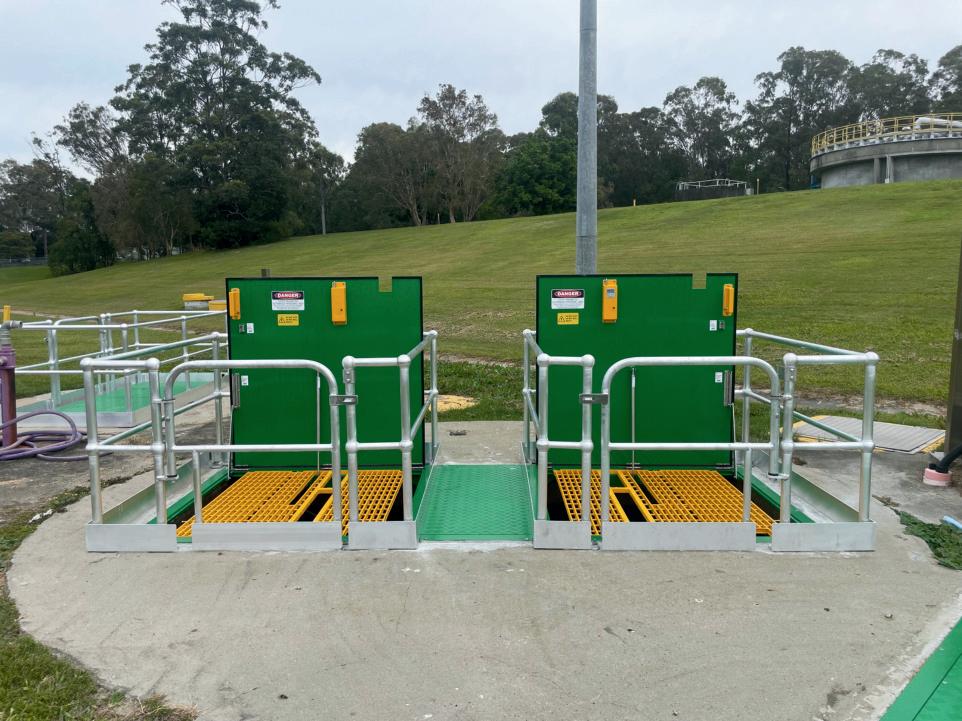

up to 2021 was immense, at 97 percent. This is the largest decline among the species groups included in the TSX to date.
It stems from: 1. the collapse of numerous frog populations due to chytrid fungus in the late 1980s and 1990s; 2. the numerical dominance of taxa impacted by chytrid fungus in the early monitoring datasets; 3. the lack of recovery of many of these taxa; and 4. continued decline of others in more recent years.
But what of threats over more recent decades, after chytrid epizootics dissipated? Unfortunately, the data we collated suggest declines continue.
With a reference year of 1995, the estimated average decline to 2021 was 78 percent. With a reference year of 2000, the average decline was 64 percent. These are still very significant declines.
A range of threats
A crucial element of these more recent trends are declines among taxa thought to be largely unaffected by chytrid fungus.
Among nonchytrid-impacted taxa, declines are related to habitat loss and fragmentation, exotic pests and the cumulative impacts of climate change – including heat waves, deepening droughts and increased fire frequency and severity.
For example, significant declines were evident in the key longterm monitoring data we received for the Wallum sedge frog (Litoria olongburensis), collected since 2009 by Harry Hines of the Queensland Parks and Wildlife Service and consultant Dr Ed Meyer. This species is not known to be impacted by chytrid, but the severe drought of 2018-20 in southeast Queensland caused significant declines for some populations.
Monitoring through time
A key limitation of the current dataset is its temporal coverage. In 1985, data were available for only four taxa (16 percent of the total) from 29 time series (five percent of the total). The number
of taxa and datasets grew rapidly during the 1990s as monitoring of chytrid-impacted taxa increased, with some dropoff in more recent years.
An important additional factor that must be considered when interpreting the national trend is that all data acquired before 1992 were for chytrid-impacted taxa, particularly those showing rapid population crashes in eastern Australia, such as in northern Queensland. Very steep declines early in the frog index reporting period reflect this and produce the very significant overall decline of 97 percent when using 1985 as a reference year.
Our new frog index suggests that, overall, declines outweigh stabilisations and recoveries. While crucial information, it also presents a disheartening reality.
Yet, the frog index – and the TSX more broadly – includes various datasets that highlight our capacity to recover threatened taxa.
For frogs, key examples include the southern bell frog (Litoria raniformis) in New South Wales and the armoured mist frog (Litoria lorica) in Queensland’s Wet Tropics. Longterm monitoring by Prof. Skye Wassens of Charles Sturt University confirms that significant investment in environmental watering has been a boon for southern bell frogs in western New South Wales.
In the Wet Tropics, recent translocations led by associate professor Conrad Hoskin of James Cook University are helping secure the armoured mist frog – a species for which all populations except one appear to have succumbed to chytrid, and which was thought to be lost forever until its rediscovery in 2008.
In 2025, we will seek to finalise the frog index, pursuing key datasets from Queensland, New South Wales, Victoria and Western Australia. Some of these datasets have been amassed over decades and are crucial to fully understanding how our threatened frogs are tracking. However, all monitoring data are valuable for projects such as this.
Article first published in Global Water Forum , globalwaterforum. org/2025/07/17/a-threatened-frog-index-for-australia/

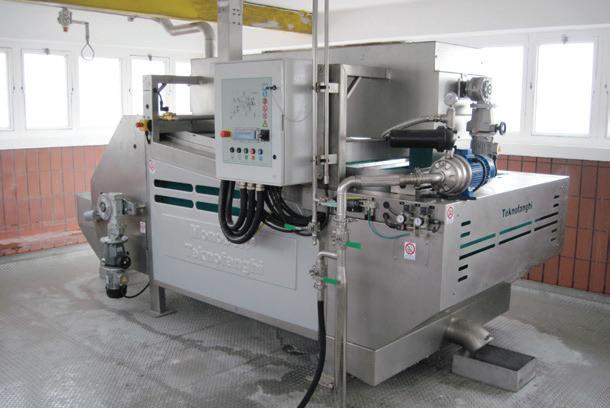
www.brickhouse.co.nz



Modern Screening Local Solution Solves Chronic Blockages
With rising maintenance costs and outdated equipment, Timaru District Council implemented a locally built screening solution that improved safety and reduced manual handling and disposal.
Timaru District Council recently addressed a long-standing issue at the Geraldine Wastewater Treatment Plant, where an old screw/auger inlet screen was no longer fit for purpose.
Old System Clogged Weekly
The council’s original screening system, a standard product designed decades ago for a very different waste stream, struggled with modern loads. Back then, rags were burned and items like wipes or nappies were rarely flushed. Today, hundreds of similar outdated units remain in use across New Zealand.
At Geraldine Wastewater Treatment Plant, the system clogged up to three times a week as fibrous material bound at the top of the auger. Operators had to manually cut tangled rags and hand-load them into a wheelie bin, a time-consuming task with significant health and safety risks. The auger tube had also failed multiple times under mechanical strain.
Cleaner Output With Reduced Disposal Frequency
The solution was a fully automated escalator screen, locally fabricated to fit the existing 500mm-wide, 1200mmdeep channel. Its 5mm perforated plates lift, and separate solids, which
Features & Benefits ESCALATOR SCREEN
• High capture rate: 79% average screening efficiency at 5mm.
• Flow-responsive: VFD-controlled motor adjusts speed to match inflow.
• Low-maintenance design: No flow-contacting parts; all mechanics mounted above coping level. Optimised screening: 45° installation angle with tines to prevent rag rolling and lift larger matter.
are macerated and transferred to a Haigh Lisep unit. There, a rotating sieve removes 98% of organics and returns them to the downstream process. Remaining solids are compacted into a low-odour plug, reducing disposal from weekly to once every two–three months.
With all mechanical parts above slab level, the design avoids confined space entry and motor flooding. Maintenance is simplified with easy-to-remove panels, cartridge rollers, and a deluge backwash system.
Designed, fabricated and delivered in under six weeks, the new system offers a safer, cleaner, and more efficient inlet works which is purpose-built for the realities of modern wastewater treatment.
For more details and the full case study, scan the QR code.





Renewed focus on protecting marine systems
Our marine environments are vital to our way of life. Kiwis not only live along coastlines but also depend on the ocean for food and their livelihoods. Professor Chad Hewitt of Lincoln University is calling for renewed attention to our marine systems, highlighting the need to adopt modern tools to manage invasive non-native species and mitigate the effects of climate change.
While non-native marine species related to fisheries have been studied, there is a growing awareness that the impacts of biological invasions – bioinvasions – on the greater marine environment needs to be better understood.
Non-native invasive species are predominantly introduced to Aotearoa New Zealand waters through biofouling (microorganisms, plants, and animals attaching to submerged surfaces on boats) and vessel ballast water. To date, while significant progress has been made in managing non-native species entering our waters, further action is needed, Chad explains.
“Since the 1980s, there has been a massive explosion in research exploring how non-native marine species are introduced into native communities. More recently, Australia and New Zealand have led the world in investigating interventions to prevent bioinvasions.
“Today, as a maritime nation facing climate change and numerous other challenges, our dominant focus on invasive species and their impact on our land-based production systems is preventing us from allocating the funds needed to ensure we keep protecting our aquatic ecosystems.”
One of the most significant challenges looming is the impact of climate change on our coastlines and oceans.
“We’ll experience warmer waters, so traditionally cold-water ports will start experiencing temperature increases. Species that couldn’t survive previously will now be able to, and this applies to Antarctica and the Arctic too. Additionally, with warming waters, transport networks will likely alter with the opening of the Northwest Passage through the Arctic, resulting in changed shipping routes.
“With greater storm activity and the potential for sea level rise, to protect coastal areas, barriers and other structures will continue to be installed along coastlines. As these installations are attractive to non-native species, they will alter our coastal habitats, leading to a greater presence of non-native species in competition with native communities.”
To assist policymakers with strengthening support for marine biosecurity, Chad proposes a greater emphasis in policy creation on the values the public attaches to coastal areas.
In Environmental Science and Policy, professor Marnie Campbell, Dr Chi Thai Uyen Le, and professor Hewitt co-authored the article “Critical coastal values impacted by marine bioinvasions: What the public value about marine and coastal areas and what is at stake?” (sciencedirect.com/science/article/abs/pii/S1462901124001205), In it, they identified an extensive range of values, beliefs and expectations held by Kiwis for coastal environments.

“The traditional categorisation framework used by policymakers doesn’t capture all the values held. Our sample of 1000 New Zealanders demonstrates that people attach values to, for example, access, connection, and a desire for a clean environment.
“Each of these values is affected by the presence of non-native species and any mitigating action taken to manage them. If you close an area to undertake eradication, people will experience a loss of access to it.
“By understanding the values New Zealanders attach to coastal areas that non-indigenous species could potentially impact, policymakers would be better equipped to design actions that will support positive social responses to marine biosecurity interventions. By doing so, we’ll be able to strengthen biosecurity in New Zealand.”
This revised focus in policymaking is important to adopt, says Chad, if we are to minimise marine invasions of non-native species, extending this work beyond the primary points of entry of commercial and recreational vessels and oil and gas exploration zones, to reach other coastal areas of significance.
“We have a solid baseline of knowledge, understanding the species present in our waters, the mechanisms non-native species use, and implementing the necessary interventions.
“Now, marine research needs to move forward by implementing an updated marine biosecurity model that differs from the one adopted 25 years ago. It should benefit from advancements in AI and robotics, utilising them to help identify species, along with environmental DNA. These are more powerful tools than we’ve had before.”
Article provided by Lincoln University


Ancient sea creature’s DNA links oceans around the world
A world-first study of marine life, including sea creatures found in Aotearoa New Zealand’s dark, cold, pressurised ocean depths, has revealed that deep-sea life is surprisingly more connected than previously thought.
The research, led by Australia’s Museums Victoria Research Institute and just published in Nature (nature.com/articles/s41586-02509307-1), found that while marine life in shallow waters is regionally unique, deeper ocean life shows more global connectivity, with some deep-sea species found across vast distances, even on opposite sides of the world.
A previous lack of global data meant that the connections of deep-sea species weren’t fully known, but the researchers from 19 different institutions, including Earth Sciences New Zealand (formerly NIWA), were able to discover how marine life is connected across the sea floor.
The landmark study mapped the global distribution and evolutionary relationships of brittle stars (Ophiuroidea), an ancient, spiny animal found from shallow coastal waters to the deepest abyssal plains, and from the equator to the poles.
In the most comprehensive study of its kind, brittle star DNA from four dozen institutions, including from Earth Sciences New Zealand’s invertebrate collection in Wellington, was examined. By analysing over 2500 DNA samples collected from over 300 research voyages in all oceans and at various depths, the researchers were able to uncover how the deep-sea invertebrates have evolved and migrated across the oceans over the past 100 million years, linking ecosystems from Iceland to Tasmania.
“You might think of the deep sea as remote and isolated, but for many animals on the seafloor, it’s actually a connected superhighway,” says study lead Dr Tim O’Hara, senior curator of marine invertebrates at Museums Victoria Research Institute.
“Over long timescales, deep-sea species have expanded their ranges by thousands of kilometres. This connectivity is a global phenomenon that’s gone unnoticed, until now.”
The brittle star was chosen because the animals, which have lived on Earth for over

480 million years, are found on all ocean floors, including at depths of more than 3500 metres, says Tim.
“These animals don’t have fins or wings, but they’ve still managed to span entire oceans. The secret lies in their biology; their larvae can survive for a long time in cold water, hitching a ride on slow-moving deep-sea currents.”
With the yolk-rich larvae able to drift on deep ocean currents for extended periods, the brittle stars have been able to colonise farflung regions. Unlike marine life in shallow waters, which is restricted by temperature boundaries, deep-sea environments are more stable and allow species to disperse over vast distances, the study found.
“The research shows that deep-sea communities, particularly at temperate latitudes, are more closely related across regions than their shallow-water counterparts. This may be due to historic ocean currents and temperature patterns that allowed species to spread over time. For example, marine animals found off southern Australia share close evolutionary links with those in the

North Atlantic, on the other side of the planet.”
However, the deep sea is not uniform, and while species can spread widely, factors such as extinction events, environmental change, and geography have created a patchwork of biodiversity across the seafloor.
Deep-sea ecosystems are more connected than first thought, says study co-author Sadie Mills, invertebrate collection manager at Earth Sciences New Zealand.
“Understanding how species are related and their connections in the ocean at different depths and different latitudes is key to protecting marine biodiversity across the entire planet. These global links should be taken into account in planning,” says Sadie.
As threats from deep-sea mining and climate change increase, this new appreciation of how life is distributed and moves through this vast environment is essential if we want to protect it, says Tim.
“It’s a paradox. The deep sea is highly connected, but also incredibly fragile.”
Article provided by Earth Sciences New Zealand (formerly NIWA).
Ophiactis abyssicola, a common deep sea species of brittle star distributed throughout New Zealand waters and in temperate regions in the Pacific, Indian, and Atlantic Oceans.
Photo courtesy of: Owen Anderson, Earth Sciences New Zealand.


Better together: How relationships can transform infrastructure delivery
ACE New Zealand chief executive Helen Davidson issues a call to action for the water sector to embrace the value of collaboration for more efficient and effective infrastructure planning and delivery. The kaupapa is clear: how can we use our influence to collectively build a highperforming infrastructure system?
The delivery of water infrastructure is under increasing pressure. Regulatory reform, aging assets, climate change, population growth, and rising community expectations are converging to create a complex and urgent challenge. Yet amid these pressures, one powerful lever we often overlook when solving these challenges is the quality of relationships between consultants and clients.
Good relationships are essential to successful infrastructure planning and delivery, not just a ‘nice to have’. When consultants and clients work together with trust, clarity, and mutual respect, they unlock better outcomes for projects, the environment and the communities we serve.
Signs of progress and hope
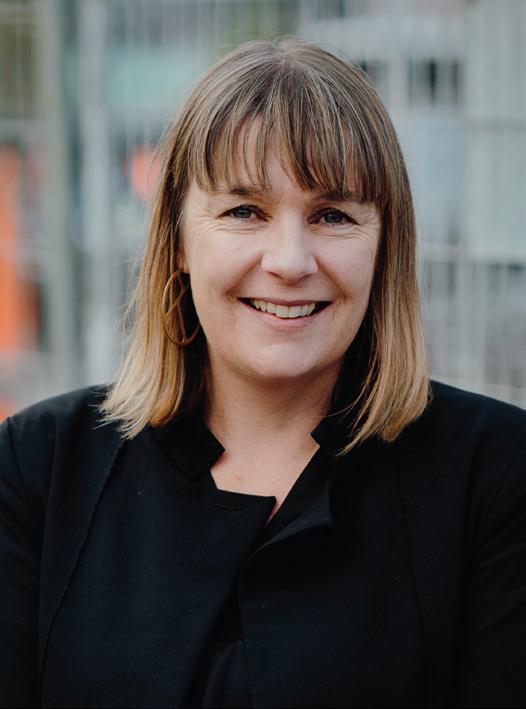
While the past couple of years have been incredibly hard for our sector, it’s been heartening to see businesses and the government galvanise around the need to address systemic challenges to fix our infrastructure deficit in a planned and co-ordinated way.
There’s optimism that the structures and systems being put in place will lead to better long-term planning and smooth delivery of projects that transcend political cycles. And there’s hope these efforts will help us avoid the boom-and-bust cycles we’ve seen plague the sector for so long and impede our progress as a country – economically and socially.
Leadership and behaviour drive real change
But the structures that allow for better funding, financing, planning and workflows will only be as good as we enable them to be – and that comes down to how we interact with them. It’s the behaviour and leadership of the people that plan, procure, deliver, and maintain infrastructure that will really move the needle. That’s us. And it’s time to step up.
That’s why ACE New Zealand has developed a new framework, ‘Six engagement principles for consultants and clients’. These principles create understanding, respect, and trust in areas like governance, vision, risk management, scope, and decisionmaking. They offer a practical guide to building stronger partnerships across the infrastructure lifecycle and overcoming the barriers that hold us back from being great.
If we use these principles together consistently, we can save significant amounts of time and money, and deliver better outcomes for New Zealanders.
The eye-watering cost of inefficiency
We’ve all heard about projects delayed for months due to miscommunication, budgets ballooning from unclear scopes, and trust eroded by siloed decision-making. In some cases, the lack of shared understanding has led to rework, reputational damage, and even legal disputes.
These failures are not isolated incidents –they’re symptoms of a system that needs to prioritise partnership. They often stem from avoidable issues like unclear roles, inconsistent governance and decision-making frameworks, or a lack of transparency. When consultants and clients operate in silos, they miss opportunities to align on purpose, manage risk collaboratively and make timely informed decisions. The result is inefficiency, frustration, and lost value.
Procurement is a missed opportunity
Procurement is an area that is crying out for improvement here in Aotearoa New Zealand and across the Tasman. Research by Consult Australia uncovered the costs associated with poor procurement practices.
The study revealed that in 2015, poor procurement practices cost the Australian government around $239 million. It showed that with improvements in briefs, delivery models, and contracts, project costs reduced by 5.4 percent, delays were reduced by seven percent, and the quality of projects improved by seven percent.
These improvements all track back to how we choose to work together.
Imagining a better way forward
Imagine the savings we could make by focusing on strong relationships. If consultants and clients engaged early, communicated openly, and shared a clear vision, they could anticipate challenges, resolve issues quickly and adapt to change. This would create the conditions for success.
The six principles developed by ACE New Zealand are
Better together – ACE CEO Helen Davidson
grounded in real-world insights from our consultants and their clients. They reflect what works and what doesn’t when it comes to engagement. Importantly, they are designed to be practical and adaptable across different project types and organisational contexts.
For the water sector, these principles offer a timely opportunity to lift performance. Whether we’re upgrading treatment plants, improving stormwater systems, or planning for future droughts, the way we engage matters. By embedding these principles into our everyday practice, we can build a sector that is collaborative, resilient and ready to meet the challenges ahead.
This is a call to action
We are committed to supporting our members and their clients to bring these principles to life. We know better engagement leads to better outcomes for projects, people, and places.
We invite everyone involved in the water infrastructure –consultants, clients, contractors, regulators, and community leaders – to reflect on how you engage and consider how these principles might support your work. Let’s move beyond transactional relationships and build partnerships that deliver real value.
Together, we can transform the way infrastructure is planned and delivered here. Let’s start with relationships.

Six engagement principles for consultants and clients
• Engage with integrity and respect: Relationships based on integrity, respect, honesty, and humility lead to better project outcomes. Appreciate and respect each other’s context, constraints, business drivers and expertise.
• Ensure strong governance, leadership, and decision-making: Clear governance, leadership and decision-making increases productivity and efficiency. Adopt accountability frameworks and define roles and responsibilities.
• Expect change and plan for it: Changes are inevitable and should be planned for. Evaluate the potential impacts of changes and create processes for approving, documenting, and communicating the changes.
• Clarify purpose and outcomes: Having a shared vision, well-defined purpose and clear outcomes brings stakeholders together and creates a good working environment. Define and communicate them.
• Balance risk while creating space for innovation: Managing risks while fostering innovative mindsets is an important lever for positive engagement. Implement valuebased risk assessment and outcomes-based procurement.
• Communicate transparently: Honest, timely and transparent communication is key to successful relationships. Share information openly and establish clear expectations for information flows.

Engineered for Safety. Built to Perform
Our HazSure solutions offer: 500L to 100,000L capacity Full documentation pack to support compliance (design & fabrication test cert ) Intelligent sophisticated NZ designed and manufactured Accordance with Engineering Standards EN1778 and BS EN 12573 Materials expertise - PE, PP, PVC, HDPE
All HazSure chemical Tanks are designed for a 25 year life, are EPA approved and HSNO test-certifiable for almost all class 5,6,8 and 9 chemicals.
From concept to commissioning, our tanks are backed by decades of engineering excellence

Contact our team for more information


Turning the tide: smarter procurement for the water sector
As the water sector reforms take shape, Mair Brooks, partner at KPMG New Zealand, stresses the importance of smart procurement.
The water sector is entering a new chapter – one defined by scale, urgency, and opportunity. With the introduction of Local Water Done Well, the country is shifting from a fragmented model of local delivery to a more unified approach, establishing new water service entities to deliver safe, reliable, and sustainable infrastructure.
But this isn’t just a governance change. It’s a call to rethink how we plan, procure, and deliver billions of dollars’ worth of water assets. And the scale of what’s coming is unprecedented.
Across 58 councils, long-term plans forecast $38.6 billion in spending on three waters infrastructure between 2024 and 2034—a 57 percent increase from the $24.6 billion planned for 2021–2031. That’s a step change in investment, and it demands a step change in how we do business.
To meet this moment, the sector must embrace smarter procurement, build delivery capability, and foster collaboration across councils, suppliers, and regulators. Fortunately, we’re not starting from scratch. Lessons from the UK’s water AMP8 (asset management plan 8), insights from Water New Zealand’s Pulse Survey March 2025, and reviewing the country’s approach to local government procurement offer a clear roadmap for reform.
The pressure is real
The Water New Zealand Pulse Survey March 2025 reveals a sector under strain. Nearly half of respondents reported deteriorating business conditions. Over a quarter of contracts were paused, deferred, or cancelled. And 55 percent of organisations had active vacancies, mostly in mid- and senior-level roles.
Despite councils signalling increased spending, the industry continues to struggle with delivery. Historically, only 75 percent of long-term plan budgets have been spent. That’s not just a missed opportunity, it’s a warning sign.
If we’re going to scale up investment, we need to fix the foundations. And that starts with procurement.
Learning from AMP8: four focus areas
The UK’s AMP8 programme offers valuable lessons. Faced with similar pressures – rising investment, tighter regulation, and public scrutiny – British water companies and suppliers developed a framework for change built around four key focus areas:
1. Market capacity. The supply chain must be ready to deliver more work, more consistently. But visibility of future projects is poor, and procurement practices often discourage participation. Suppliers need confidence in the pipeline to invest in people, equipment, and innovation.
2. Client capability. Many councils and new entities lack the scale
and expertise to manage complex infrastructure programmes. Building capability, through training, shared services, and strategic partnerships, is essential to ensure projects are delivered on time and on budget.
3. Operational efficiency. Legacy systems, siloed teams, and fragmented governance slow down delivery. Streamlining project management, enabling early contractor involvement, and adopting modern delivery models can unlock significant efficiencies.
4. Regulatory alignment. Performance targets are tightening, and funding is increasingly tied to outcomes. Contracts must align with strategic objectives, and suppliers need to be part of the solution, not just the delivery mechanism.
Procurement: From process to practice
Procurement is often seen as a technical function, a series of steps to select a supplier and sign a contract. But in a sector facing transformation, procurement must become a strategic practice. It’s not just about buying services; it’s about shaping outcomes.
Here, traditional procurement has relied heavily on competitive tendering and lowest-cost selection. These approaches, while familiar, often fail to deliver long-term value. They discourage innovation, push risk onto suppliers, and create adversarial relationships.
Lessons from AMP8 show that a different approach is possible, and necessary.
Rather than presenting suppliers with rigid specifications, councils should involve them early in shaping the scope and delivery model. Early contractor involvement (ECI) improves buildability, reduces risk, and fosters trust. It also helps suppliers bring forward innovations that might otherwise be missed.
Instead of procuring isolated projects, councils should group works into coherent programmes. This creates scale, reduces transaction costs, and allows suppliers to plan and invest with confidence. It also helps smooth delivery profiles, avoiding the boom-bust cycles that have historically plagued the sector.
Contracts should allocate risk to the party best able to manage it. AMP8 has shown that pushing all risk onto suppliers leads to inflated prices and reduced participation. A collaborative approach to risk, supported by clear mechanisms for joint problem-solving, can improve outcomes and reduce costs.
Transparency and pipeline visibility
This is where we have a real opportunity to lead. By providing clear, consistent visibility of upcoming work – across councils, regions, and years – the sector can give suppliers the confidence to invest, scale
up, and meet demand. Transparency isn’t just good governance, it’s a growth strategy.
Local government Water Service Delivery Plans, due by September 2025, will offer the first comprehensive view of sector-wide priorities, investment profiles, and the project pipeline across all of local government, providing the transparency needed for suppliers and contractors to invest, scale up, and meet the growing demand.
Building supply chain capability
The scale of investment ahead requires a supply chain that’s not only ready, but resilient. That means supporting suppliers to grow, innovate, and deliver. It means creating the conditions for long-term partnerships, not short-term transactions.
Agile procurement practices, like open-book contracting, collaborative delivery models, and outcome-based evaluation, can help. But councils also need to invest in their own capability. Procurement teams must evolve from process administrators to strategic advisors. That means training, tools, and a culture shift.
It also means working together. Shared services, regional alliances, and national coordination can help councils pool expertise, reduce duplication, and speak with one voice to the market.
Innovation and agility: The new norm
Innovation is critical to achieving long-term resilience. Yet, the British Water Supply Chain Taskforce, established in response to a stated desire from British Water members to try and secure a better deal for the supply chain by addressing blockers to prosperity, found that most water companies operate in silos, with slow trial processes and limited collaboration.
The £600 million Ofwat Innovation Fund, an England and Wales Water Services Regulation Authority 10-year (2020-30) Innovation Fund to grow the water sector’s capacity to innovate, has helped, but its scale is insufficient to meet urgent challenges like Net Zero 2030.
To unlock innovation, councils must create shared trialling platforms, define success criteria, and foster a culture of openness and tolerance for failure. They must also align incentives, so that suppliers are rewarded

for delivering better outcomes, not just lower costs. New Zealand’s transport sector offers a useful precedent for coordinated procurement.
The New Zealand Transport Agency (NZTA), through regional alliances like the Northland Transportation Alliance (NTA), has demonstrated how councils can work together to develop shared procurement strategies. By aligning investment priorities, bundling contracts, and engaging the market collectively, the NTA has improved supplier confidence, attracted more competition, and delivered better value.
Implementation: Challenges and opportunities
Water reform won’t be easy. Councils face funding constraints, competing agendas, and limited procurement capacity. Cultural inertia and legacy practices can slow progress. But the foundations are in place.
Aotearoa New Zealand’s procurement rules are flexible. Agencies like Te Waihanga, the New Zealand Infrastructure Commission, and the Ministry for Business, Innovation and Employment (MBIE) actively support agile, collaborative approaches. And the sector has shown it can adapt, through initiatives like the SCIRT Alliance Agreement in Christchurch and Eastern Busway for Auckland Transport.
What’s needed now is leadership. Councils must commit to longterm planning, invest in capability, and work together to build a stronger, more resilient water sector.
A call to action
Local Water Done Well offers a once-in-a-generation opportunity to reshape our water sector. With $38.6 billion in planned investment over the next decade, the stakes couldn’t be higher.
By adopting agile procurement practices, building supply chain capability, and providing transparency to support investment and growth, councils and new entities can deliver safe, sustainable, and affordable water services.
The time to act is now. Standing still is not an option.
The views and opinions expressed herein are those of the author and do not necessarily represent the views and opinions of KPMG.
CELEBRATING 20 YEARS OF TRUSTED VACUUM & DRAIN SERVICES
Now with four branches: West Auckland, South Auckland, Wellington & Canterbury!
Expert stormwater/drain maintenance, hydro‑excavation, wastewater/sewer, grease traps & converters, CCTV inspections, and spill/flood response.

Meet the Commerce Commission
As part of the Government’s Local Water Done Well, the Commerce Commission has been appointed the economic regulator for water supply and wastewater services. This marks an expansion of the Commission’s responsibilities.
The Commerce Commission is an independent competition, fair trading, consumer credit, and economic regulator. Our role includes overseeing economic regulatory regimes for certain infrastructure services like electricity lines companies, gas pipeline companies, fibre, water networks and the main international airports. These are sectors that are important to people’s lives and where there is insufficient competition.
Starting with transparency: Information disclosure
Our primary tool will be information disclosure. We will require regulated suppliers to publicly report information about their performance that we specify. We set rules on what key performance information regulated suppliers will need to publicly share (information disclosure requirements).
We will take that information, analyse it and publish it in a manner that makes it easier to compare between regulated suppliers, and to look at trends over time.
Why is this important? By ‘shining a light’ on performance issues, stakeholders gain a better understanding of supplier performance, how this compares to past performance and other suppliers, and what improvements are expected in the future.




What’s next?
We are required to set initial requirements within six months of the Local Government (Water Services) (LGWS) Bill being enacted. We will be consulting on our draft information disclosure requirements in the spring.
We will continue to publish more information about our mahi, key documents, consultation dates, and opportunities for engagement on the economic regulation of water services section of our website.
If you’d like to be kept up to date with our latest updates you can join our mailing list for commission-wide updates, including our newsletter or any of our industry-specific updates.
10th IWA-ASPIRE and Water New Zealand Conference & Expo 2025
Some of our water regulation team will be attending the conference. We know there is a lot of change and information to digest. We encourage you to come and see us for a chat at stand #203 right next to Water Services Authority, Taumata Arowai.
Article supplied by the Commerce Commission


1. Andy Burgess, general manager infrastructure regulation
2. Emily Botje, principal water engineer, water regulation
3. Frances Dagg, water manager, water regulation
4. Tim Hewitt, principal adviser, water regulation
5. Loretta Lovell, associate commissioner
6. Zoe Moffat, chief advisor, water regulation
7. Josh Riley, analyst, water regulation



Fittings
Outstanding
Highest
Global

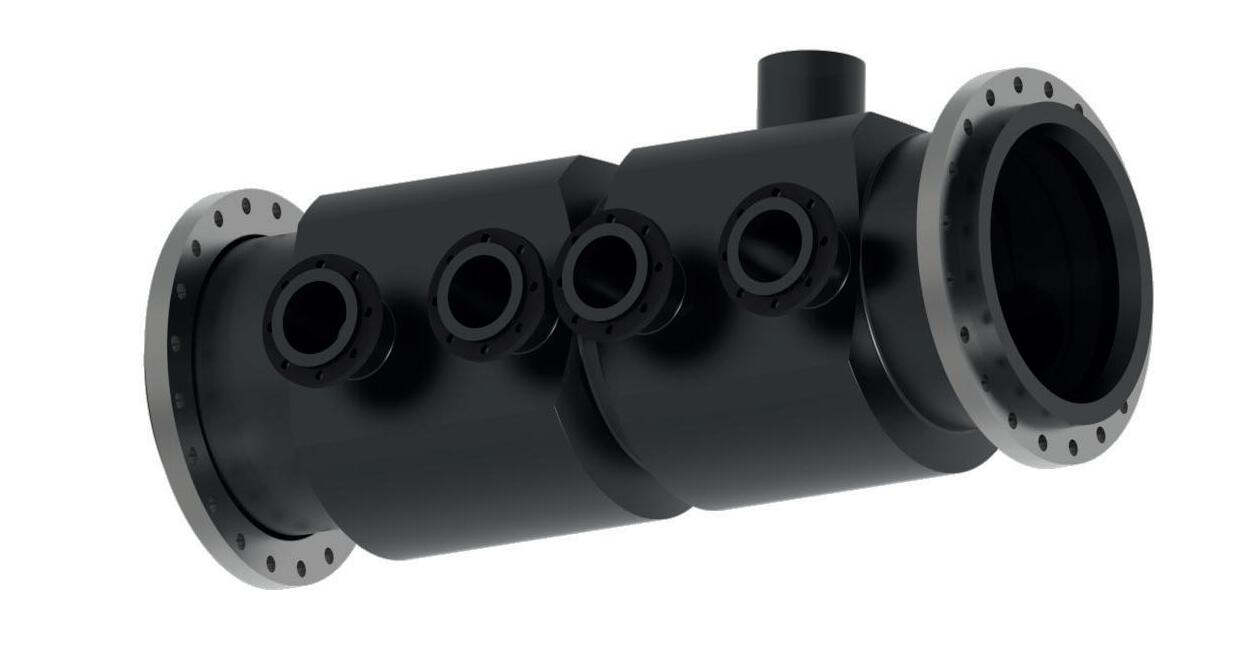


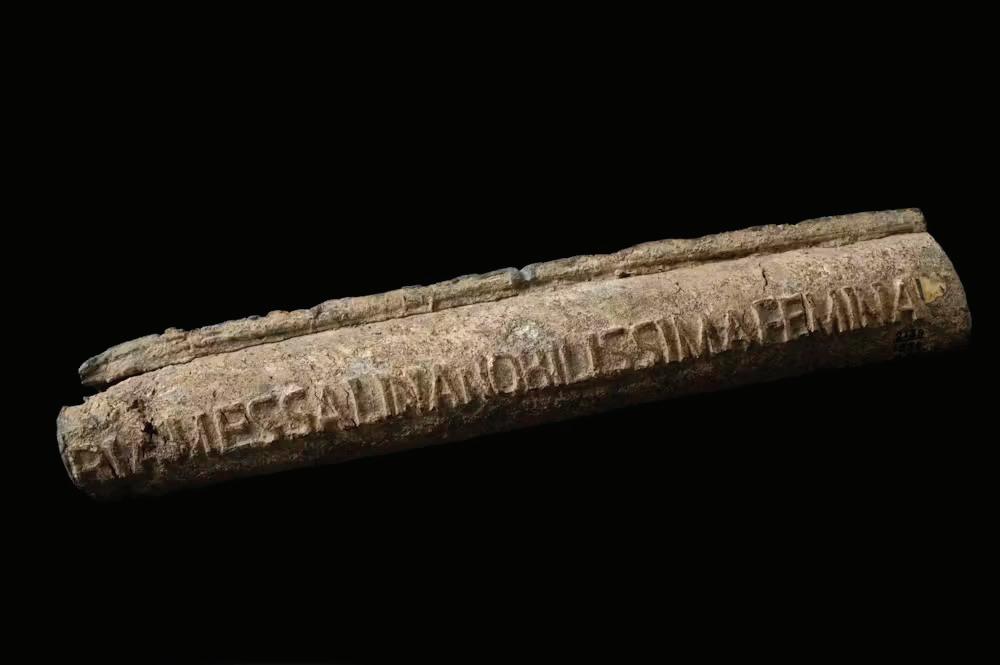
From Roman drains to ancient filters,
these artefacts show how solutions to water contamination have evolved
By Rosa Busquets, associate professor, School of Life Sciences, Pharmacy and Chemistry, Kingston University
A new exhibition in London (open until February 2026) called ‘Thirst: In search of freshwater’ highlights how civilisations have treasured –and been intrinsically linked to – safe, clean water.
As a chemist, I research how freshwater is polluted by modern civilisation. Common contaminants in rivers include pharmaceuticals, microplastics (which degrade further when exposed to sunlight and wave power), and forever chemicals or per- and polyfluoroalkyl substances (PFAS) (some of which are carcinogenic).
Synthetic toxic chemicals are introduced into the environment from the products we make, use and dispose of. This wasn’t a problem centuries ago, where we had a totally different manufacturing industry and technologies.
Some, such as PFAS from stain-resistant textiles or non-stick materials such as cookware, can be particularly difficult to remove from wastewater. PFAS don’t degrade easily, they resist conventional heat treatments and can easily pass through wastewater treatments, so they contaminate rivers or lakes that are sources of our drinking water.
Testing for pollutants is even more critical in developing nations that lack sanitation and face drought or flooding. Having to protect and conserve drinking water and its sources is as relevant today as it always has been.
For this exhibition, curator at the Wellcome Collection in London, Janice Li, has selected 125 historical objects, photographs and feats of engineering that link to drought, rain, glaciers, rivers and lakes. The following three artefacts from ‘Thirst’ illustrate how our relationship with water contamination has evolved.
Ancient water filters
Made from natural materials such as clay, water jug filters have been used for hundreds of years in every continent by ancient civilisations. They show that purifying water for drinking was commonplace. The sand and soil particles that naturally get suspended in water and removed by these filters would have carried microbes.
But in ancient times, pharmaceuticals and other drugs, pesticides, forever chemicals and microplastics would not have been a problem. Those filters could work relatively well despite being made of simple materials with wide pores.
Today, those ancient filters would no longer be effective. Modern water filters are made using more advanced materials which typically have small pores (called micropores and mesopores). For example, filters often include activated carbon (a highly porous type of carbon that can be manufactured to capture contaminants) or membranes that filter water. Only then is it safe for people to drink.
Roman water pipes
Lead water pipes (known as fistulae) were useful parts of a relatively advanced plumbing system that distributed drinking water throughout Roman cities. They are still common in water systems in our cities today. In the US, there are about 9.2 million lead service lines in use. Exposure to lead causes severe human health problems. Lead exposure, not necessarily from drinking water only, was attributed to more than 1.5 million deaths in 2021.
It’s now understood that lead is neurotoxic and it can diffuse or spread from the pipes to drinking water. Lead from paints and batteries, including car batteries, can also contaminate drinking water.
To protect us from lead leaching or flaking off from pipes, some government agencies are calling for the replacement of lead pipes with copper or plastic pipes. Water companies routinely add phosphates (mined powder that contains phosphorus) to drinking water to help capture potential lead contamination and make it safe to drink.
The horror of unhealthy water
One caricature titled The Monster Soup by artist William Heath (1828) is part of the Wellcome Trust’s permanent collection. The graphics read “microcosms dedicated to the London Water companies” and “Monster soup, commonly called Thames Water being a correct


representation of the precious stuff doled out to us”. The cartoon shows a lady so terrified at the sight of microbes in river water from the Thames that she drops her cup of tea.
Even today, many people remain shocked at the toxic contamination in rivers and sewage pollution prevents people from swimming.
By 2030, two billion people will still not have safely managed drinking water and 1.2 billion will lack basic hygiene services. Drinking water will still be contaminated by bacteria such as E. coli and other dangerous pathogens that cause waterborne diseases. So advancing technologies to filter out contamination will be just as crucial in the future as it has been in the past.
Article provided by The Conversation, theconversation.com/fromroman-drains-to-ancient-filters-these-artefacts-show-how-solutions-towater-contamination-have-evolved-253876
Anthony Acciavatti’s ‘Groundwater Earth’ interrogates the impact of groundwater over-extraction around the world. This installation draws attention to the excessive use of tube wells, mechanised technologies for extracting water from rock, which has startlingly altered the Earth’s tilt by 80 centimetres between 1993 and 2010.
4. Humanity’s thirst for water drove early civilisations to set territorial boundaries and inspired creative solutions to secure water supplies. This Old Babylonian clay tablet from present-day Iraq, thought to be around 4000 years old, forms a fragment of the Sumerian poem the ‘Epic of Gilgamesh’. This story of two kings at war, Gilgamesh and Aga, is the earliest account of conflict over water.
Monitoring, Measuring and Locating Underground
We have worked with Utility organisations and municipalities to monitor their water and underground networks for over 30 years.


1. Monster Soup by William Heath.
2. A Roman lead water pipe that dates back to 1-300CE.
3.

Stalagmites in Mexican caves reveal duration and severity of drought during the Maya collapse
A drought lasting 13 years and several others that each lasted over three years may have contributed to the collapse of the Classic Maya civilisation, chemical fingerprints from a stalagmite in a Mexican cave have revealed.
A detailed analysis of oxygen isotopes in the stalagmite allowed a team of researchers, led by the University of Cambridge, to determine rainfall levels for individual wet and dry seasons between 871 and 1021 CE, which overlaps with the Terminal Classic period of Maya civilisation. This is the first time it has been possible to isolate rainfall conditions for individual wet and dry seasons during the Terminal Classic, the time of societal decline historically referred to as the Maya collapse.
During the Terminal Classic, limestone Maya cities in the south were abandoned and dynasties were ended, as one of the ancient world’s great civilisations shifted north and lost much of its political and economic power.
The data contained within the stalagmite, from a cave in the Yucatán, showed there were eight wet-season droughts that lasted for at least three years during this period, with the longest drought lasting for 13 consecutive years.
This climate data aligns with existing historical and archaeological evidence: construction of monuments and political activity at several major northern Maya sites, including the famous city of Chichén Itzá, stopped at different times during this period of climate stress.
The accurately and precisely dated droughts provide a new framework for fine-grained analysis of the timing and dynamics of human-climate interactions in the region.
What happened to the Maya?
“This period in Maya history has been a cause of fascination for centuries,” says lead author Dr Daniel H. James, who conducted the research while a PhD student at Cambridge’s Department of Earth Sciences.
“There have been multiple theories as to what caused the collapse, such as changing trade routes, war or severe drought, based on the archaeological evidence the Maya left behind. But in the past few decades, we’ve started to learn quite a lot about what happened to the Maya and why, by combining the archaeological data with quantifiable climate evidence.”
Starting in the 1990s, researchers began to piece together climate records with those left by the Maya, such as the dates they recorded on key monuments, to show that a series of droughts during the Terminal Classic was a likely contributor to the massive sociopolitical upheaval in Maya society.
Photo courtesy of: Mark Brenner

Now, James and his co-authors from the UK, US, and Mexico have used the chemical fingerprints contained in stalagmites from a cave in the northern Yucatán to bring those droughts into much sharper focus.
Stalagmites form when water drips from the ceiling of a cave, and the minerals contained in the water grow into large deposits on the cave floor. By dating and analysing the layers of oxygen isotopes within the stalagmite, the researchers extracted highly detailed information about the climate in the Terminal Classic period.
Earlier research has measured the oxygen isotopes contained in lake sediment to determine the severity of drought, but lake sediment does not contain enough detail to pinpoint climate conditions in any given year at a particular site.
“It hasn’t been possible to directly compare the history of individual Maya sites with what we previously knew about the climate record,” says James, who is now a postdoctoral researcher at University College London (UCL). “Lake sediment is great when you want to look at the big picture, but stalagmites allow us to access the fine-grained detail that we’ve been missing.”
Earlier research on stalagmites has determined annual average rainfall amounts during the Terminal Classic, but the Cambridge-led team have now been able to go further, and isolate information from individual wet and dry seasons, thanks to relatively thick (about 1mm) annual layers in the stalagmite used in this study. The specific oxygen isotopes in each layer are a proxy for wet-season drought.
Piecing a puzzle together
“Knowing the annual average rainfall doesn’t tell you as much as knowing what each individual wet season was like. Being able to isolate the wet season allows us to accurately track the duration of wet season drought, which is what determines if crops succeed or fail.”
According to the information contained in the stalagmite, there were eight wet-season droughts lasting for at least three years

between 871 and 1021 CE. The longest drought of the period lasted for 13 years. Even with the water management techniques that the Maya had, a drought that long would have had major impacts on society.
The climate information contained in the stalagmite lines up with the dates inscribed by the Maya on their monuments. In periods of prolonged and severe drought, date inscription at sites such as Chichén Itzá stopped entirely.
“This doesn’t necessarily mean that the Maya abandoned Chichén
1. ‘Dome of the Cathedral’, the largest chamber in the Grutas Tzabnah cave system (Yucatán, Mexico).
2. Daniel H. James, Ola Kwiecien, and David Hodell (L-R) install a SYP drip water autosampler in Grutas Tzabnah (Yucatán, Mexico) to analyse seasonal changes in drip chemistry.
3. Daniel H. James installs a drip rate monitor in Grutas Tzabnah (Yucatán, Mexico).
Photos courtesy of: Sebastian Breitenbach
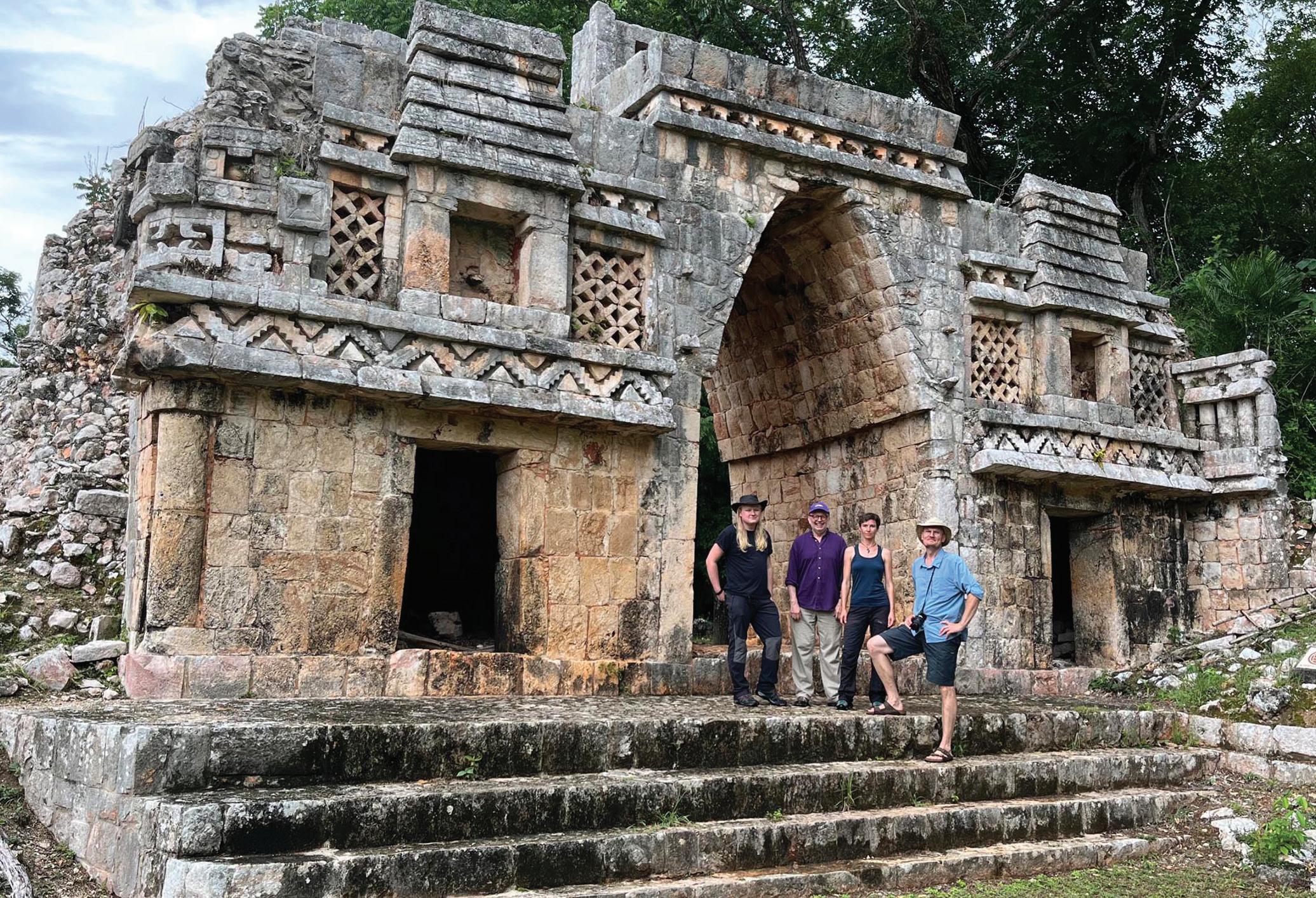
Itzá during these periods of severe drought, but it’s likely that they had more immediate things to worry about than constructing monuments, such as whether the crops they relied on would succeed or not.”
The researchers say that stalagmites from this and other caves in the region could be vital in putting the puzzle of the Terminal Classic period together.
“In addition to what stalagmites can tell us about this period in Maya history, they might also be able to tell us about the frequency and severity of tropical storms, for instance. As a case study for fine-grained comparisons between climate and
historical data, it’s exciting being able to apply methods usually associated with the deeper past to relatively recent history.”
The research was supported in part by the National Geographic Society and the Leverhulme Trust.
Article provided by the University of Cambridge. See Daniel H. James et al. ‘Classic Maya response to multiyear seasonal droughts in Northwest Yucatán, Mexico.’ Science Advances (2025). DOI: 10.1126/sciadv.adw7661


The research team at the Maya site of Labna in the Puuc region (Yucatán, Mexico).
Photo courtesy of: Mark Brenner
Industrial. Fluid. Conveyance.
Tailored solutions keeping New Zealand in Motion.
New Zealand’s most trusted industrial brands – SAECOWilson, Seal Innovations, HCD Flow Technology, Bay Engineers Supplies, Hose Supplies, and more – are now united under one name: Motion.

With end-to-end solutions across bearings, power transmission, we reduce downtime, boost performance, and keep critical industries moving.
www.motion.co.nz

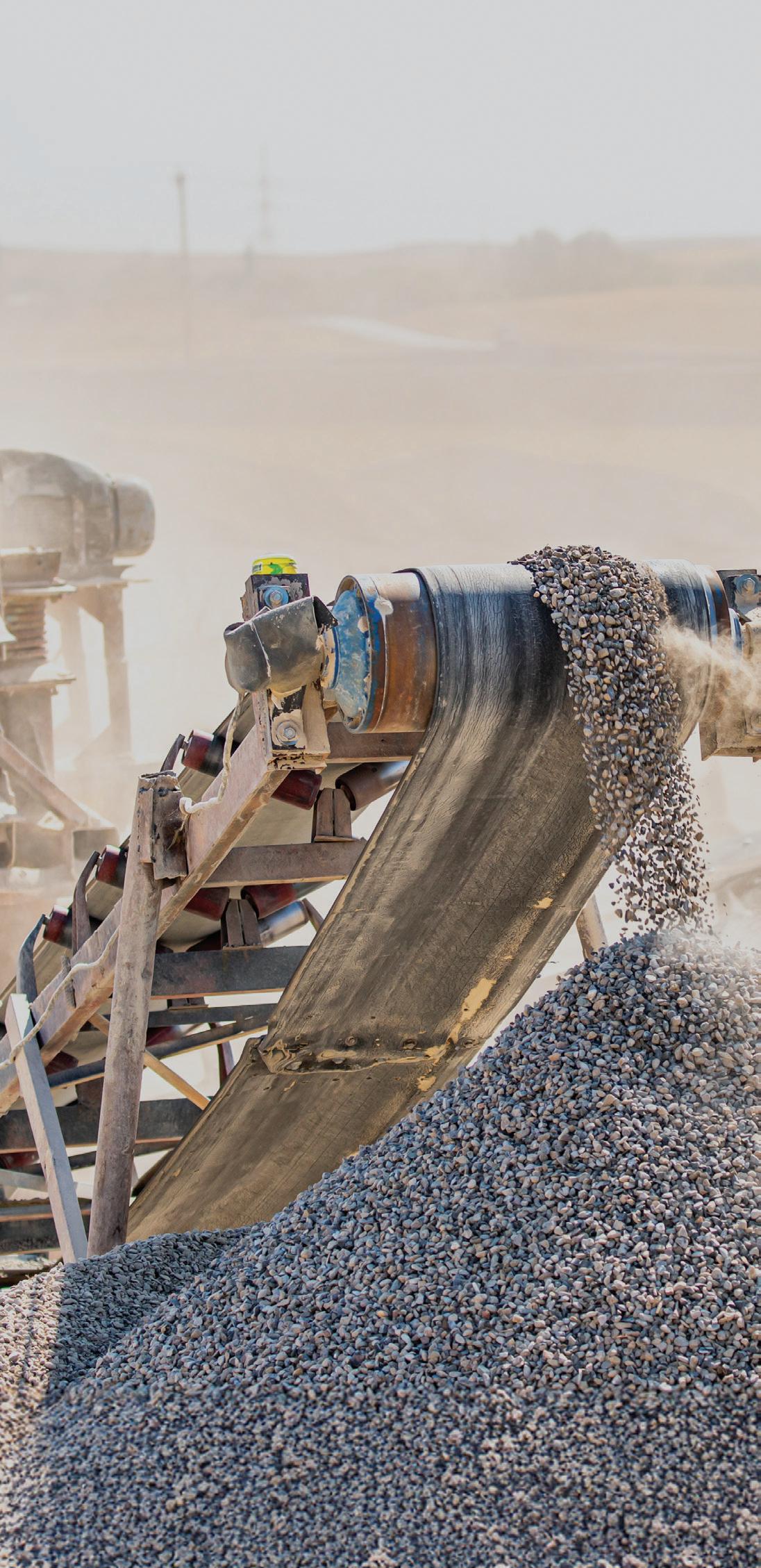

origin of water on Earth Scientists find evidence that overturns theories of the
University of Oxford researchers have helped overturn the popular theory that water on Earth originated from asteroids bombarding its surface. Instead, the material which built our planet was far richer in hydrogen than previously thought.
A team of researchers at the University of Oxford have uncovered crucial evidence for the origin of water on Earth. Using a rare type of meteorite, known as an enstatite chondrite, which has a composition analogous to that of the early Earth (4.55 billion years ago), they have found a source of hydrogen which would have been critical for the formation of water molecules.
Crucially, they demonstrated that the hydrogen present in this material was intrinsic, and not from contamination. This suggests that the material which our planet was built from was far richer in hydrogen than previously thought.
Without hydrogen, a fundamental elemental building-block of water, it would have been impossible for our planet to develop the conditions to support life.
The origin of hydrogen, and by extension water, on Earth has been highly debated, with many believing that the necessary hydrogen was delivered by asteroids from outer space during Earth’s first approximately 100 million years. But these new findings contradict this, suggesting instead that Earth had the hydrogen it needed to create water from when it first formed.
The research team analysed the elemental composition of a meteorite known as LAR 12252, originally collected from Antarctica. They used an elemental analysis technique called X-Ray Absorption Near Edge Structure (XANES) spectroscopy* at the Diamond Light Source synchrotron at Harwell, Oxfordshire.
A previous study led by a French team had originally identified traces of hydrogen within the meteorite inside organic materials and non-crystalline parts of the chondrules (millimetre-sized spherical objects within the meteorite). However, the remainder was unaccounted for – meaning it was unclear whether the hydrogen was native or due to terrestrial contamination.
The Oxford team suspected that significant amounts of the hydrogen may be attached to the meteorite’s abundant sulphur. Using the synchrotron, they shone a powerful beam of X-rays onto the meteorite’s structure to search for sulphur-bearing compounds.
When initially scanning the sample, the team focussed their efforts on the non-crystalline parts of the chondrules, where hydrogen had been found before. But when serendipitously analysing the material just outside of one of these chondrules, composed of a matrix of extremely fine (sub-micrometre)
material, the team discovered that the matrix itself was incredibly rich in hydrogen sulphide.
In fact, their analysis found that the amount of hydrogen in the matrix was five times higher than that of the non-crystalline sections.
In contrast, in other parts of the meteorite that had cracks and signs of obvious terrestrial contamination (such as rust), very little or no hydrogen was present. This makes it highly unlikely that the hydrogen sulphide compounds detected by the team originated from an Earthly source.
Since the proto-Earth was made of material similar to enstatite chondrites, this suggests that by the time the forming planet had become large enough to be struck by asteroids, it would have amassed enough reserves of hydrogen to explain Earth’s present-day water abundance.
Tom Barrett, DPhil student in the Department of Earth Sciences at the University of Oxford, who led the study, says: “We were incredibly excited when the analysis told us the sample contained hydrogen sulphide – just not where we expected! Because the likelihood of this hydrogen sulphide originating from terrestrial contamination is very low, this research provides vital evidence to support the theory that water on Earth is native – that it is a natural outcome of what our planet is made of.”
Co-author associate professor James Bryson (Department of Earth Sciences, University of Oxford) adds: “A fundamental question for planetary scientists is how Earth came to look like it does today. We now think that the material that built our planet – which we can study using these rare meteorites – was far richer in hydrogen than we thought previously.
“This finding supports the idea that the formation of water on Earth was a natural process, rather than a fluke of hydrated asteroids bombarding our planet after it formed.”
The study ‘The source of hydrogen in earth’s building blocks’ has been published in the journal Icarus (sciencedirect.com/ science/article/pii/S0019103525001356?via%3Dihub).
Article provided by the University of Oxford
* X-ray Absorption Near Edge Structure (XANES) spectroscopy is a technique that is used to identify what elements are in a material and what their chemical state is. It works by shining X-rays onto a sample, causing the atoms to absorb energy in a way that depends on what the element is, the chemical form it is in (e.g., an oxide, a sulphide, etc), and how the atoms are bonded with others.

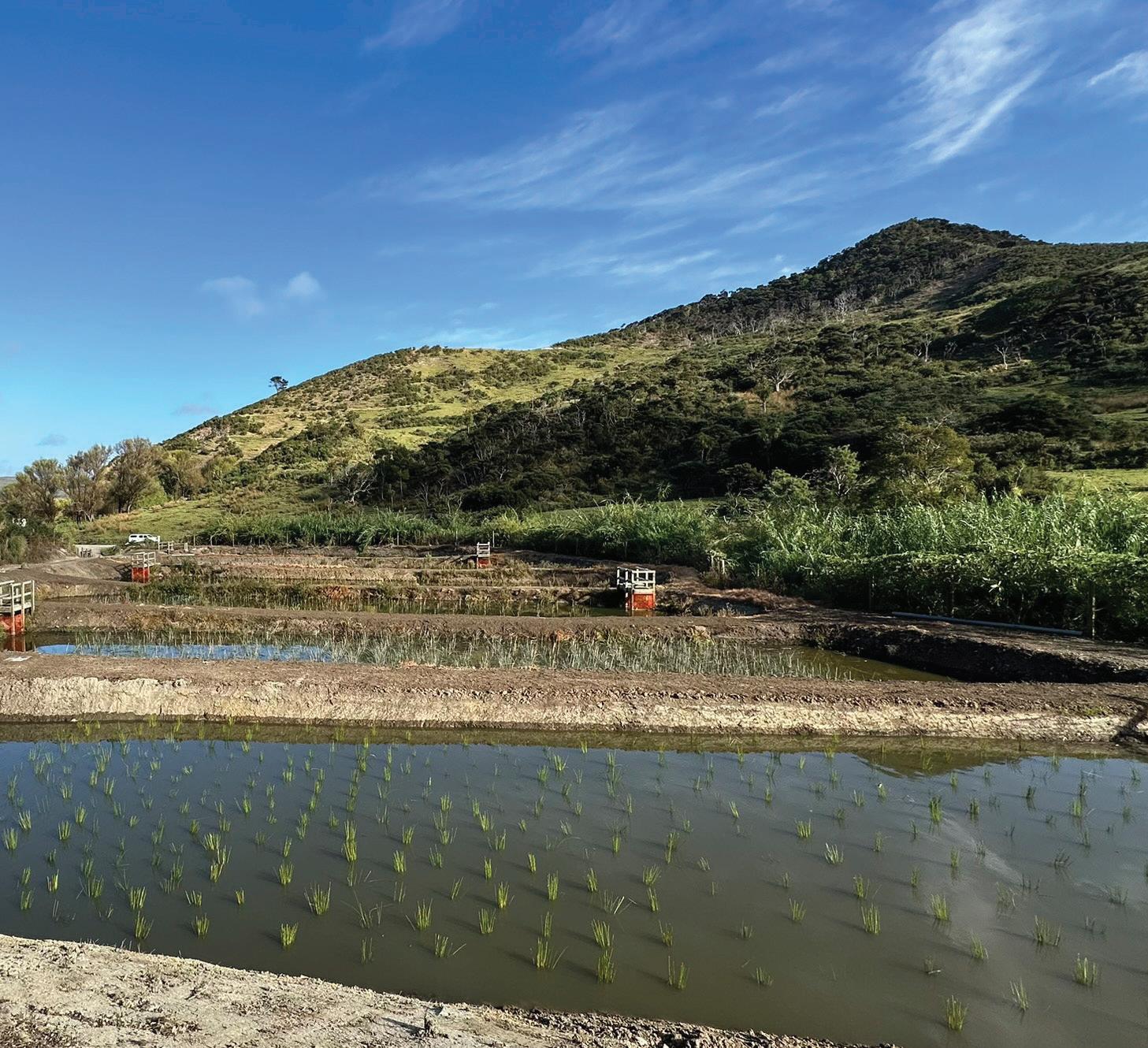









When Earth froze, early life may have survived in Antarctic-style meltwater ponds
When the planet was locked in ice more than 700 million years ago, small meltwater ponds may have offered refuge to early complex life.
That’s the finding of a new international paper published in Nature Communications, which included research from the University of Waikato’s Dr Ian Hawes, one of New Zealand’s leading polar scientists and part of an international team uncovering clues to life’s survival during global ice ages.
The team examined modern-day meltwater ponds on Antarctica’s McMurdo Ice Shelf, a region first described by Robert Falcon Scott’s 1903 expedition as the ‘Dirty Ice’. These ponds form when dark sediment and marine debris rise to the surface of the ice, absorb sunlight and cause small areas of ice to melt.
Each pond contains a self-sustaining ecosystem of simple microscopic life, forming colourful ‘microbial mats’ on the pond floors. These mats are like tiny forests, where photosynthetic bacteria (cyanobacteria or ‘blue-green algae’) take the roles of trees and provide food and shelter for other simple microorganisms.
Using genetic fingerprinting and other molecular markers specific to different types of organisms, the researchers found a surprising range of bacteria and microscopic eukaryotes, such as algae, protists, and tiny animals, that together formed simple but intricate food webs. No two ponds hosted the same community, and pond salinity was important in determining who lived where.
The findings support the hypothesis that ponds like these acted as surface refuges during the Cryogenian Period, between 635 and 720 million years ago, when average global temperatures may have dropped to around minus 50 degrees Celsius and the planet iced over (known as a ‘Snowball Earth’). These results help explain how early complex life could have survived during one of the most extreme chapters in Earth’s history.
As one of the researchers who collected samples in Antarctica and has studied these environments for decades, Ian says the findings offer powerful insight into how even extreme polar environments can support life.
“One of the reasons why Antarctica is of such value to science is that it gives us windows into how life works in environments unlike the ones that we are used to. The absence of dominance by large, complex organisms allows us to use Antarctic habitats as analogues for how life worked in earlier stages of life on earth
ecoLogical Solutions

and how organisms survived critical moments.
“We’ve shown that meltwater ponds are valid candidates for where early eukaryotes could have sheltered during these planetwide glaciation events,” adds lead author Fatima Husain, a graduate student at MIT’s Department of Earth, Atmospheric and Planetary Sciences. “This shows us that diversity is present and possible in these sorts of settings. It’s really a story of life’s resilience.”
The research involved MIT, the University of Waikato, Cardiff University, the Natural History Museum in London and other institutions, with support from NASA and the Simons Foundation.
To read the paper, go to: nature.com/articles/s41467-025-60713-5
Article provided by the University of Waikato.
A. Pustular microbial mat section collected from New Pond;
B. A mound of relict microbial mats; C. A fossil sponge on the landscape surface atop pinnacle ice; D. A fossil bryozoan.
Bigger, Better, Stronger TOGETHER
NZPGS and Pump Hire have officially joined forces to become

New Zealand’s leading experts in pumping and power solutions. This exciting evolution marks a bold step forward as we expand our national presence and elevate the delivery of high-performance services across the country.
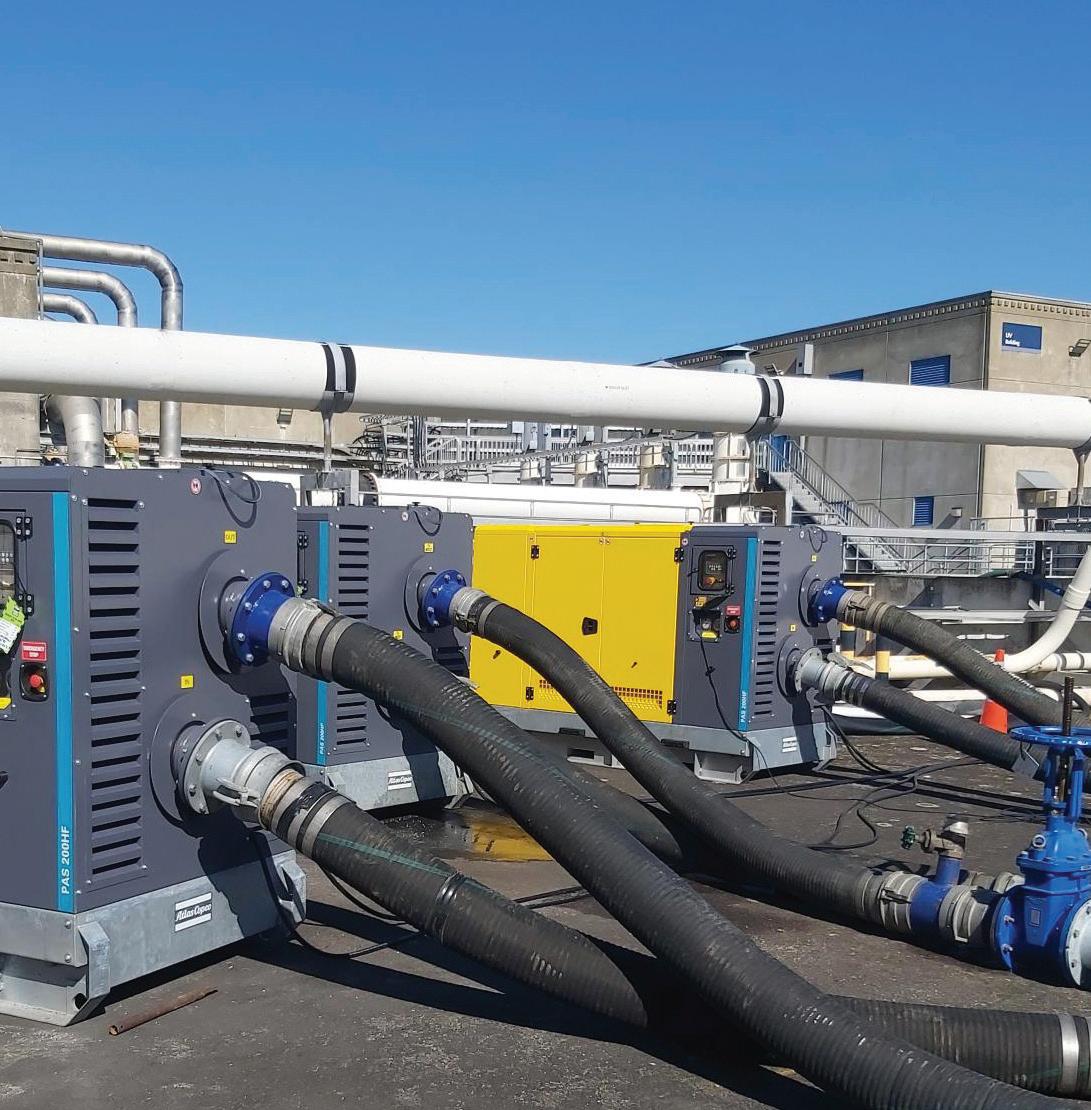
While our name and branding have changed, our dedication to quality, reliability, and customer satisfaction remains the same.
Leading Provider of Dewatering, Pumping & Energy Solutions – we solve problems
Hire and Sales of Bespoke Turnkey Solutions, including: – Dewatering and water transfer systems
– Sewage bypass management and flood response
– Water treatment solutions
– Emergency power response
– HDPE pipeline installation and support
24/7 Rapid Response Team delivering guaranteed results
Nationwide Coverage strategically located depots across the North and South Islands to minimise response times
Extensive Knowledge Base Strong knowledge base across the company
Environmentally Conscious Approach offering sustainable and alternative solutions
Latest Cutting-Edge Equipment ensuring maximum performance and reliability
Onsite and Remote Monitoring for real-time system oversight and control
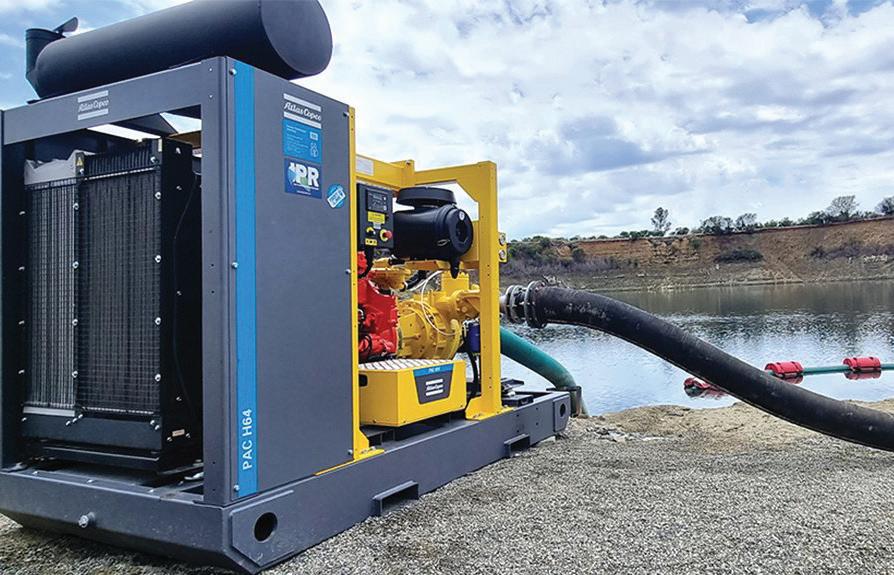


Recycling water in space
Water recycling is paramount for space stations and long-duration missions.
Berrin Tansel, professor of civil and environmental engineering at Florida International University, explains how the ISS does it
When you’re on a camping trip, you might have to pack your own food and maybe something to filter or treat water that you find. But imagine your campsite is in space, where there’s no water, and packing jugs of water would take up room when every inch of cargo space counts. That’s a key challenge engineers faced when designing the International Space Station.
Before NASA developed an advanced water recycling system, water made up nearly half the payload of shuttles traveling to the ISS. I am an environmental engineer and have conducted research at Kennedy Space Center’s Space Life Sciences Laboratory. As part of this work, I helped to develop a closedloop water recovery system.
Today, NASA recovers over 90 percent of the water used in space. Clean water keeps an astronaut crew hydrated, hygienic and fed, as it can use it to rehydrate food. Recovering used water is a cornerstone of closed-loop life support, which is essential for future lunar bases, Mars missions, and even potential space settlements.
NASA’s environmental control and life support system is a set of equipment and processes that perform several functions to manage air and water quality, waste, atmospheric pressure and emergency response systems such as fire detection and suppression. The water recovery system − one component of environmental control and life support − supports the astronauts aboard the ISS and plays a central role in water recycling.
Water systems built for microgravity
In microgravity environments like the ISS, every form of water available is valuable. The water recovery systems on the ISS collect water from several sources, including urine, moisture in cabin air, and hygiene – meaning from activities such as brushing teeth.

On Earth, wastewater includes various types of water: residential wastewater from sinks, showers and toilets; industrial wastewater from factories and manufacturing processes; and agricultural runoff, which contains fertilisers and pesticides.
In space, astronaut wastewater is much more concentrated than Earth-based wastewater. It contains significantly higher levels of urea – a compound from urine – salts, and surfactants from soaps and materials used for hygiene. To make the water safe to drink, the system needs to remove all of these quickly and effectively.
The water recovery systems used in space employ some of the same principles as Earth-based water treatment. However, they are specifically engineered to function in microgravity with minimal maintenance. These systems also must operate for months or even years without the need for replacement parts or hands-on intervention.
NASA’s water recovery system captures and recycles nearly all forms of water used or generated aboard the space station. It routes the collected wastewater to a system called the water processor assembly, where it is purified into safe, potable water that exceeds many Earth-based drinking water standards.
The water recovery and treatment system on the ISS consists of several subsystems.
Recovering water from urine and sweat
The urine processor assembly recovers about 75 percent of the water from urine by heating and vacuum compression. The recovered water is sent to the water processor assembly for further treatment. The remaining liquid, called brine, still contains a significant amount of water. So, NASA developed a brine processor assembly system to extract the final fraction of water from this urine brine.

A close-up view of the water recovery system’s racks – these contain the hardware that provides a constant supply of clean water for four to six crew members aboard the ISS. NASA.
Japan Aerospace Exploration Agency astronaut Koichi Wakata next to the International Space Station’s water recovery system, which recycles urine and wastewater into drinking water. As Koichi humorously puts is, “Here on board the ISS, we turn yesterday’s coffee into tomorrow’s coffee.”
In the brine processor assembly, warm, dry air evaporates water from the leftover brine. A filter separates the contaminants from the water vapour, and the water vapour is collected to become drinking water.
This innovation pushed the water recovery system’s overall water recovery rate to an impressive 98 percent. The remaining two percent is combined with the other waste generated.
The air revitalisation system condenses moisture from the cabin air – primarily water vapour from sweat and exhalation – into liquid water. It directs the recovered water to the water processor assembly, which treats all the collected water.
Treating recovered water
The water processor assembly’s treatment process includes several steps.
First, all the recovered water goes through filters to remove suspended particles such as dust. Then, a series of filters removes salts and some of the organic contaminants, followed by a chemical process called catalytic oxidation that uses heat and oxygen to break down the remaining organic compounds. The final step is adding iodine to the water to prevent microbial growth while it is stored.
The output is potable water — often cleaner than municipal tap water on Earth.
Getting to Mars and beyond
To make human missions to Mars possible, NASA has estimated that spacecraft must reclaim at least 98 percent of the water used on board.
While self-sustaining travel to Mars is still a few years away, the new brine processor on the ISS has increased the water recovery rate enough that this 98 percent goal is now in reach. However, more work is needed to develop a compact system that can be used in a space ship.
The journey to Mars is complex, not just because of the distance involved, but because Mars and Earth are constantly moving in their respective orbits around the Sun.
The distance between the two planets varies depending on their positions. On average, they’re about 225 million kilometres apart, with the shortest theoretical approach, when the two planets’ orbits bring them close together, taking 54.6 million kilometres.
A typical crewed mission is expected to take about nine months one way. A round-trip mission to Mars, including surface operations and return trajectory planning, could take around three years.
In addition, launch windows occur only every 26 months, when Earth and Mars align favourably.
As NASA prepares to send humans on multiyear expeditions to the red planet, space agencies around the world continue to focus on improving propulsion and perfecting life support systems. Advances in closed-loop systems, robotic support and autonomous operations are all inching the dream of putting humans on Mars closer to reality.
This article first appeared in The Conversation, theconversation.com/water-recycling-is-paramount-for-spacestations-and-long-duration-missions-an-environmentalengineer-explains-how-the-iss-does-it-260171



Are drug-resistant bugs in the water?
Rising levels of drug-resistant pathogens pose a serious threat, says University of Auckland professor of civil and environmental engineering Naresh Singhal.
The threat from drug-resistant pathogens is increasing in Aotearoa New Zealand.
“I’m concerned by the levels of drug-resistant pathogens in the natural environment, because they’re not properly managed or monitored,” says Naresh, who works within the university’s Centre for Climate, Biodiversity and Society, and is director of its Water Research Centre.
Globally, more than 1.27 million people die of drug-resistant illnesses a year and that’s projected to increase to 10 million deaths per year by 2050. Here, infections linked to drug resistance cost about $226 million a year and cause about 330 deaths annually, Naresh says.
Health organisations have warned doctors to prescribe antibiotics only when necessary, to reduce the risk of bacteria adapting so that antibiotics no longer wipe them out. Farmers have also been advised to reduce antibiotic use on livestock, reducing the risk of antibiotic-resistant pathogens passing from animals into humans.
Viruses, fungi and parasites can also develop resistance to antiviral drugs, antifungals, and antiparasitic medicines.
“Drug resistance – known in scientific terms as antimicrobial resistance – has become a much bigger threat, because it’s not just a matter of using less antibiotics on people and farm animals.
“Drug-resistant microbes are spreading through the natural environment.”
People excrete antibiotics and other medicines they have taken, so these drugs enter sewerage systems. Drugs in animal urine and excrement also enter the environment.
“Microbes can develop resistance to antibiotics and other drugs through being exposed to medicines in wastewater treatment plants and waterways.
“When pathogens adapt so they can survive treatment with antibiotics and other medicines, it makes it much harder to treat ordinary infections.
“Diseases can then spread more rapidly and it increases the risk of epidemics.”
In Aotearoa New Zealand, about 20 percent of wastewater systems lack valid consents. Some regularly overflow, pouring
raw sewage into the sea and other waterways, he says.
“There’s an urgent need to improve its wastewater treatment systems.
“Our water management organisations need to adopt technologies that prevent high concentrations of antibiotics and other drugs from entering waterways.”
He says we need regulations that set safe limits on drugresistant microbes in wastewater systems and waterways. More monitoring of drug-resistant microbes in wastewater and waterways is also required.
“Poorly managed wastewater systems pose a serious risk of discharging drug-resistant pathogens into lakes, rivers and the sea.
“Mapping hot spots with high levels of antimicrobial resistance would help us predict the risk of drug-resistant pathogens spreading to humans or other animals.
“If people or animals ingest drug-resistant microbes in contaminated water, there’s a much higher risk of them developing a drug-resistant infection.”
Due to climate change, temperatures are rising in wastewater and waterways, creating ideal conditions for drug-resistant pathogens to thrive.
“One of the worrying things is a drug-resistant epidemic could sweep through New Zealand and we’re not properly prepared to deal with it.
“There are far too many gaps in our understanding of this threat.”
Naresh and University of Auckland environmental scientist Dr Sam Trowsdale have been granted $20,000 from the university to create a working group of experts from universities, government agencies, Māori environmental organisations, and the wider community to look at ways to tackle drug resistance in New Zealand ecosystems.
Naresh is also applying for funding to study whether suddenly changing the levels of oxygen in wastewater might kill drugresistant microbes. Experts interested in joining the working group on antimicrobial resistance can email n.singhal@auckland.ac.nz.
Article provided by the University of Auckland




Is mineral water ‘natural’ if it’s filtered?
Daniel Gettings, sessional tutor, Department of History, University of Warwick, shares why the debate gripping France today has raged since the 18th century.
A year ago, French newspaper Le Monde and Radio France broke a big scandal in water – Perrier was filtering its product. The filtering began due to worries about water contamination linked to climate change and pollution of spring sources.
It was also revealed that executives at parent company Nestle and French government ministers tried to keep it all quiet. They allegedly covered up reports of contamination and changed the rules to allow micro-filtration.
Under EU law, for a brand to market their products as ‘natural mineral water’ it has to remain unaltered. French mineral water companies are now awaiting a ruling on what level of filtration is considered illegal ‘treatment’. The result could mean that, after 160 years, Perrier will no longer be able to be call its product ‘natural mineral water’.
Strikingly, the same issue was debated extensively by scientists during the 18thcentury European spring water boom. These men considered the effects of human intervention on the product and what was lost in the process.
A spa boom
In the 17th and 18th centuries, medical interest, in addition to factors like travel for leisure, resulted in the proliferation of new spa towns across Europe.
In England, Buxton and Tunbridge Wells developed in the 1620s and 1660s respectively, while Harrogate, Cheltenham and Leamington came in the 1710s, 1750s and 1790s. Historical surveys place the number of spas and wells offering healing mineral waters at around 350 in the 18thcentury heyday.
Spas like Bath, Buxton and the Bristol Hotwell were thermal, offering hot bathing. However, other spa sources in England were not heated. This meant that those who wished to bathe had to do so in the cold, which was both undesirable, and at that time, considered dangerous. This was due to fears that the English cold climate, when combined with bodily exposure to cold water, could disrupt bodily rhythms and cause illness.
As a result, many of the cold spas focused on offering health benefits through drinking their waters. When
hailing the qualities of the newly discovered waters at Scarborough in 1660, Yorkshire doctor Robert Wittie declared they had “gained such credit” that people: “Come above an hundred miles to drink of it, preferring it to all other medicinal waters they had formerly frequented.”
He later described the health benefits he gained from drinking them: “I had lost two pound and a half of my weight… I found after it better agility of body, and alacrity of spirit then before.”
In 1654, the doctor Edmund Deane had similarly described the effects of the waters of Knaresborough: “Those waters at the Spaw doe presently heal, and (as it were) miraculously cure diseases, which are without all hope of recovery.”
Testing the waters
As the number of spas grew, so did the options for consumers. As a result, the 18th century saw increasing attention and experimentation on mineral waters by scientists. Rather than questioning the health benefits, they instead compared waters to one another, experimenting
Left: Public Bathing at Bath, or Stewing Alive, by Isaac Cruikshank, 1825. Wikimedia.
Above: An example of a glass bottle that would have held English mineral water between 1801 and 1900. The Board of Trustees of the Science Museum, CC BY-NC-ND.
on them to determine processes that produced and changed healing properties.
For example, British doctor George Turner, who translated and expanded upon a German work about the spa of Bad Pyrmont, in 1733. His work discussed experiments on the waters of the spa and the minerals that could be determined within. It noted that if left standing, the carbonated water lost its potency: “Whence it is, that so spiritous a liquid does so easily turn to a flat insipid water.”
He also suggested that boiling caused mineral waters to lose some invisible element important to its proper function. “Why so many globules of air arise out of mineral waters when it is warmed?” he asked, only to conclude that when “spirits fly out of any liquid” they go “incognito without any tumult”. As they “flew”, so too did whatever gave these waters healing properties, making chemical recreation in a lab impossible.
Historians of science have suggested that works like this foregrounded the concept of ‘gas’, which came more
conclusively later in the century.
During experiments on the Scarborough waters, doctor Peter Shaw and natural scientist Stephen Hales each sought to determine the nature of the ‘subtle sulphurous spirit’ in which they felt the “principal virtue of the Chalybeate (flavoured with iron) Waters resided”.
Similar experiments also involved extensive filtering, with physician John Nott in 1793 adding solutions to the waters of Italy’s Pisa and France’s Verdun before filtering them and performing further tests on “what remains in the filter”.
Scottish physician, Thomas Short, had concluded previously that filtering waters was both an important natural process. He described “the several strange alterations that water undergoes, by being strained through different strata of minerals”. But also that the body inherently filtered “raw” mineral waters through its skin when bathing, allowing only those smaller minerals in to provide the health effect, he claimed.
These scientists used their burgeoning
chemical understanding to conclude that processes performed on waters fundamentally changed them, going from ‘spiritous’ cures to ‘flat insipid water’. Even lacking the full knowledge or vocabulary to express why, they felt their processes and tools were incapable of recreating the waters of nature.
Legacies of these ideas can be seen in our changing attitudes to food and drink. Modern branding and consumer value is placed on a lack of processing. We are increasingly concerned with capturing and consuming the natural as it is, before human intervention has muddied it.
In so doing, we continue the ideas of those concerned with mineral waters all that time ago. By filtering their waters, no matter how little Perrier claim it affected them, we feel as though some spirit of the natural has perhaps been lost.
This article first appeared in The Conversation, theconversation.com/ismineral-water-natural-if-its-filtered-thedebate-gripping-france-today-has-ragedsince-the-18th-century-263149

Visit us at the Water NZ Conference and Expo Stand 233, 234 & 235, by registration – you can’t miss us.
DURABLE, RELIABLE PUMPING POWER
MMP 6 ÷ 10 Series
Permanent Magnet Submersible Motors
DRINKING WATER CERTIFICATIONS
MAXIMUM ENERGY SAVINGS
LOW OPERATING COSTS
Caprari’s patented designs and engineering excellence ensure pumps built for lasting reliability and strength. With market-leading performance, they deliver maximum energy savings and low operating costs.
Certified for drinking water and available in a range of materials and configurations, they feature PE2+PA windings ideal for hot water and inverter applications.

Series
The ENDURANCE series features DEFENDER®. A smart device designed tested and patented by Caprari to protect the electric pumps from electrochemical corrosion and galvanic currents. Passivating the stainless steel so as to create a further safety barrier.
K+ Series
High-Efficiency Electric Submersible Pumps for Raising Wastewater


Designed for residential and industrial wastewater applications, including drainage lifting stations and treatment plants. Available with single or double channel hydraulics or a retracted open impeller, it efficiently handles liquids with high solid content. Features include; anti-clog impellers, a double mechanical seal with oil chamber, and a conductivity probe for reliable motor protection and long-lasting performance.



Driving a step change in drinking water safety
The Water Services Authority – Taumata Arowai – came into existence in November 2021 with a vision of ‘safe water every day, for everyone’. We were, and still are, a small regulator with a big job. And while there is still much to do, real progress is being made.

Over the next three years, with the launch of the Compliance, Monitoring and Enforcement Strategy (CME) 2025-28, drinking water suppliers and the public can expect to see a shift in our regulatory approach. We will be moving from a focus on establishing the foundations of a regulatory system to ensuring the system drives real improvements in the delivery of safe drinking water.
Our Water Services and Community Supplies teams work at the frontline of drinking water safety for the authority. They engage with drinking water suppliers, public health units, laboratories, other stakeholders, and the public. These teams work with suppliers across the country to help ensure that the communities they serve have safe, reliable drinking water. They also take compliance action when public health could be at risk.
Today we’re talking with our two Water Services Managers, Neil Shaw in the North Island and Rachel East in the South Island. Their teams are connected with the suppliers that provide drinking water to the majority of people in the country.
What are you seeing out there on the current state drinking water? What are the main challenges that impact the supply of safe drinking water?
Rachel: I’d say we are still seeing too many E. coli notifications. It’s critical that all suppliers get basic treatment barriers in place and then take steps to keep them working effectively all of the time.
More focus is also needed on identifying and addressing the risks posed by chemical contaminants, as well as more effective source water monitoring and protection. The healthier the source water, the easier and more cost-effective it is to make it safe for people to drink.
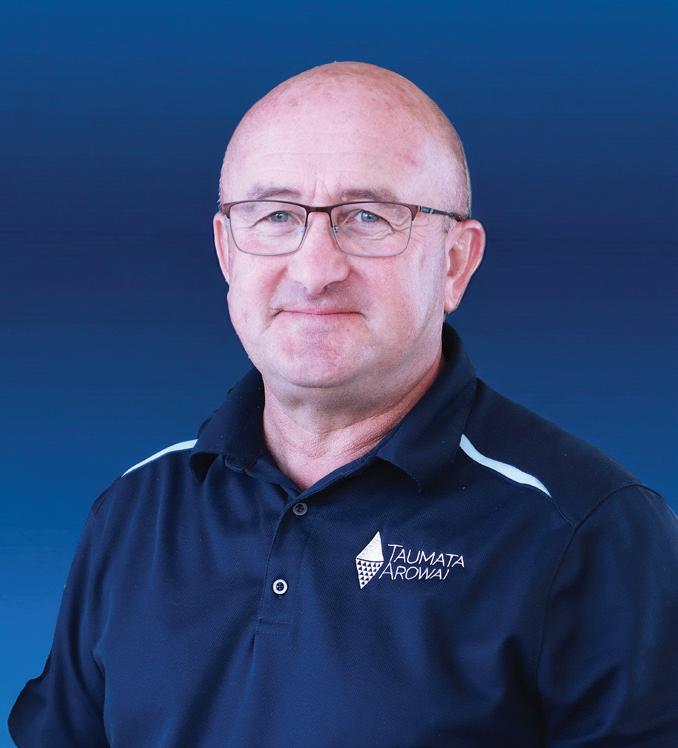
Neil: When we talk with suppliers, we see dedicated people focused on providing safe drinking water to their communities. Infrastructure and funding issues are two of the main roadblocks for these people in their daily work to ensure the water they produce is safe.
When risks to the safety of drinking water are identified and notified to us, we are seeing a reluctance by some suppliers to use boil water advisories as an immediate step to protect public health. Often these suppliers cite a suspected sampling error as a reason not to take action, and then carry out additional testing. This means if contamination is confirmed, the community has had several days of being supplied with unsafe water while being unaware of the risk.
Suppliers have a responsibility to tell the people they serve, and us, about risks to drinking water safety. Where there is a risk, it’s critical they take prompt action to appropriately inform communities so that they can take steps to ensure their water is safe to drink.
The main risks I see to safe drinking water are source water that is not adequately protected and deferred maintenance of infrastructure. We also need more training for operators to build their skills and knowledge.
Where do you think progress is being made?
Rachel: Suppliers are getting basic treatment barriers installed. It’s great to see this progress.
Neil: We’re seeing good progress getting basic treatment barriers in place (bacterial, protozoa and residual disinfection) as part of a multi-barrier approach to drinking water safety. The suppliers we work with have a good understanding of our role as drinking water regulator.
Rachel East, water services manager, South Island
Neil Shaw, water services manager, North Island
Where do you think improvements are needed?
Rachel: Getting the basics right. This includes monitoring that fits the requirements and the supply, reporting, installing basic barriers and making sure those barriers are working effectively.
Suppliers need to investigate to find the root cause when something goes wrong and make improvements to resolve issues over the long term to improve the overall safety of drinking water. It would be great to see more people sharing their water knowledge and expertise to support a culture of drinking water safety across the sector.
Neil: A greater focus is required on ensuring that treatment barriers are operating consistently and effectively, and on understanding and managing risks to source water. Improved source water management is a must for long-term sustainability in many supplies, especially those that don’t have alternative sources available. Suppliers also need to be more transparent with the people they supply when their drinking water may be unsafe.
Taumata Arowai recently launched its CME Strategy 2025-28. What are the authority’s expectations of drinking water suppliers over the next three years?
Neil: By 2028, we want to see all council, central government and commercial supplies providing safe, reliable drinking water to their communities – that means water that’s protected against microbial and chemical contamination every day, supplied from a source that’s actively monitored and protected.
Rachel: All of the council, central government and commercial water supplies we work with will have appropriate processes and treatment barriers or Acceptable Solutions in place. Boil water advisories will only be used sparingly to manage immediate risks to consumers and not as a replacement for effective and reliable treatment. And, most importantly, safer water supplied to communities.
What benefits do you think the CME Strategy will bring at the front line?
Neil: The CME enables our teams to have clear, open conversations with the people responsible for supplying communities with drinking water on the next steps to get us all closer to our shared goal of safe drinking water. It sets out what we expect suppliers to do to address the most significant risks to public health from the drinking water they provide in a way that is proportionate to the scale and complexity of their networks.
Rachel: Suppliers are telling me it is an easy to understand, useful document. I can see my team using it to help everyone understand why we do what we do and provide clarity on our focus for the next three years.
If you’re attending the 10th IWA-ASPIRE and Water New Zealand Conference & Expo 2025, keep an eye out for Steve Taylor, head of operations at Taumata Arowai, who is presenting in more detail on the CME Strategy 2025-28 and what suppliers can expect. We will also have a stand at the conference, so come and talk to us.
Article provided by Taumata Arowai.

Benchmarking water efficiency: A new era for office buildings
In a significant leap forward for sustainable building operations, the New Zealand Green Building Council (NZGBC) has launched the NABERSNZ Water tool – a first-of-its-kind benchmarking system designed to assess and improve water efficiency in office buildings.
NABERSNZ has been used to benchmark the energy efficiency of office buildings since 2014 – providing facilities managers and building owners with a rating of up to six stars. The launch of the NABERSNZ Water tool marks the first expansion of the rating system since its introduction and it couldn’t come at a more critical time.
With increasing pressure on water resources due to climate change, urban growth, and aging infrastructure, the need for robust, data-driven water management has never been greater.
Why water efficiency matters
We all know water is one of our most precious and increasingly vulnerable resources. In commercial buildings, inefficient water use can lead to unnecessary costs, increased carbon emissions, and reduced resilience in the face of droughts or infrastructure failures.
By benchmarking water performance, building owners and managers can identify inefficiencies, detect leaks early, and implement targeted improvements – all while contributing to broader sustainability goals.
“Saving water isn’t just about conservation,” says NZGBC chief executive Andrew Eagles. “It’s about reducing our impact on the planet, lowering infrastructure costs, and building resilience.
“The NABERSNZ Water tool aims to empower building owners to take meaningful action, backed by data and independent verification.”
How the tool works
The NABERSNZ Water tool enables office buildings to measure and benchmark their water use in a consistent, transparent, and independently verified way. It builds on the NABERSNZ framework, which over 170 buildings already use annually to assess energy performance.
It is recommended that office buildings have their NABERSNZ Energy and Water ratings done at the same time as there are efficiencies with the evidence required.
The water tool evaluates key metrics such as total water consumption, intensity per square metre, and performance relative to similar buildings. Ratings range from 0 to 6 stars in half star increments, with higher scores indicating better water efficiency.
Industry collaboration and pilots
The development of the NABERSNZ Water tool was a multi-year effort led by NZGBC in partnership with the Energy Efficiency and
Conservation Authority (EECA), technical experts, and industry stakeholders. The methodology was adapted from NABERS Australia, with testing and consultation to ensure it meets local needs.
Early adopters have already demonstrated the tool’s potential. Precinct Properties received ratings for several buildings, including Charles Fergusson Building (4.5 stars), Defence House (5 stars), and 8 Tangihua Street (5 stars). Argosy also achieved high ratings for 8 Willis Street (5.5 stars) and 105 Carlton Gore Road (5 stars), showcasing leadership in water stewardship.
“These pilot ratings show what’s possible,” says Bobby Shen, senior manager at NZGBC. “They reflect a growing commitment across the sector to manage water more effectively and futureproof our built environment.”
Upskilling and integration
With the tool now live, NABERSNZ assessors can begin offering water ratings for office buildings and training is underway to get our community up to speed and across the detail. Only NABERSNZ assessors can undertake a NABERSNZ rating on an office building. See NZGBC’s professional development webpage for more information.
For water professionals – including engineers, sustainability consultants, and facility managers – the tool offers a new avenue to support clients in achieving measurable improvements. It also aligns with global best practices, reinforcing Aotearoa New Zealand’s position as a leader in sustainable building performance.
Looking ahead
The launch of the NABERSNZ Water tool is more than a technical milestone. It’s a cultural shift in how we value and manage water in our buildings. Importantly, we believe it signals a move toward holistic resource efficiency, where energy, water, and carbon are considered together in the pursuit of better outcomes for people and the planet.
As the tool gains traction, NZGBC plans to expand its application and explore integration with other building types and resource areas. For now, office buildings are the starting point — and the opportunity is clear.
“Water efficiency is no longer a nice-to-have,” says Andrew. “It’s a must-have. And with NABERSNZ Water, we now have the means to measure, improve, and lead.”
Article supplied by the New Zealand Green Building Council

Make sustainable
iwith EcoStruxure™ solutions for water and wastewater
Transform Water & Wastewater Operations with EcoStruxure Automation Expert
Unlock smarter, more efficient water management with Schneider Electric’s EcoStruxure Automation Expert. This next-generation automation platform delivers real-time monitoring, predictive maintenance, and seamless system integration—empowering operators with actionable insights and greater control.
Designed to support operations of any scale, EcoStruxure Automation Expert provides the flexibility and performance needed to meet evolving industry demands—enhancing efficiency, reducing downtime, and improving service delivery.
Future-proof your operations — start your digital transformation today.
Discover our EcoStruxure Automation Expert
Discover our EcoStruxure solutions for Water and Wastewater


Why increased demand for supply and water efficiency forces a rethink on pipeline condition assessment.
Demand-driven stress and aging infrastructure is accelerating pipeline risk, prompting water managers to revisit how asset condition is assessed and prioritised.
By Colin Kennedy, Integrated Pipeline Solutions Alliance
As councils face increased populations and pressure to better manage water, buried infrastructure is showing new and unpredictable signs of stress. But while demand increases pressure on the resilience of water networks, many replacement decisions are still being made without testing the actual condition of assets on the ground.
That is a growing concern, says Christopher Miller, business development manager at Assetlife Alliance, a specialist inspection and condition assessment provider.
Assetlife Alliance is a founding member of the Integrated Pipeline Solutions (IPS) Alliance. Alongside ProjectMax, Pipeline & Civil, and Intergroup, the alliance delivers end-to-end planning, inspection and renewal services across three waters infrastructure.
“We’re seeing a growing number of councils now questioning the traditional assumption that a pipe’s age is enough of a basis for renewal plans and budgets,” says Christopher. “But what’s new is an increased focus of justifying renewal costs based on actual condition and future asset health that theoretical models alone simply can’t capture.”
From stable assumptions to a dynamic environment
Historically, the condition of long-life infrastructure like pressure mains, rising mains and large diameter stormwater lines has been managed based on manufacturer lifespan guidance and desktop deterioration models. But the lived environment these assets occupy is dynamic. Climate, utilisation and even traffic loads have a significant impact.
A 2024 Trellis article warned that “aging water pipes and wastewater treatment facilities are under even more threat because of climate change-induced heat extremes and floods”. It notes that both pipe materials and surrounding soils are vulnerable to drying, movement, corrosive change and highhumidity fluctuations, none of which are typically modelled in conventional replacement planning frameworks.
A 2024 academic study published in Environmental Science & Policy found that relying on outdated climate assumptions can lead to ‘drastically underestimated flood risks’, recommending safety buffers of 40 to 70 percent in stormwater asset design. Yet most buried infrastructure renewal schedules have no such adaptive margin.
Christopher says the consequences are already visible: “We’ve seen pipes that should have lasted 100 years fail early due to unexpected external corrosion. And in other cases, pipes assumed
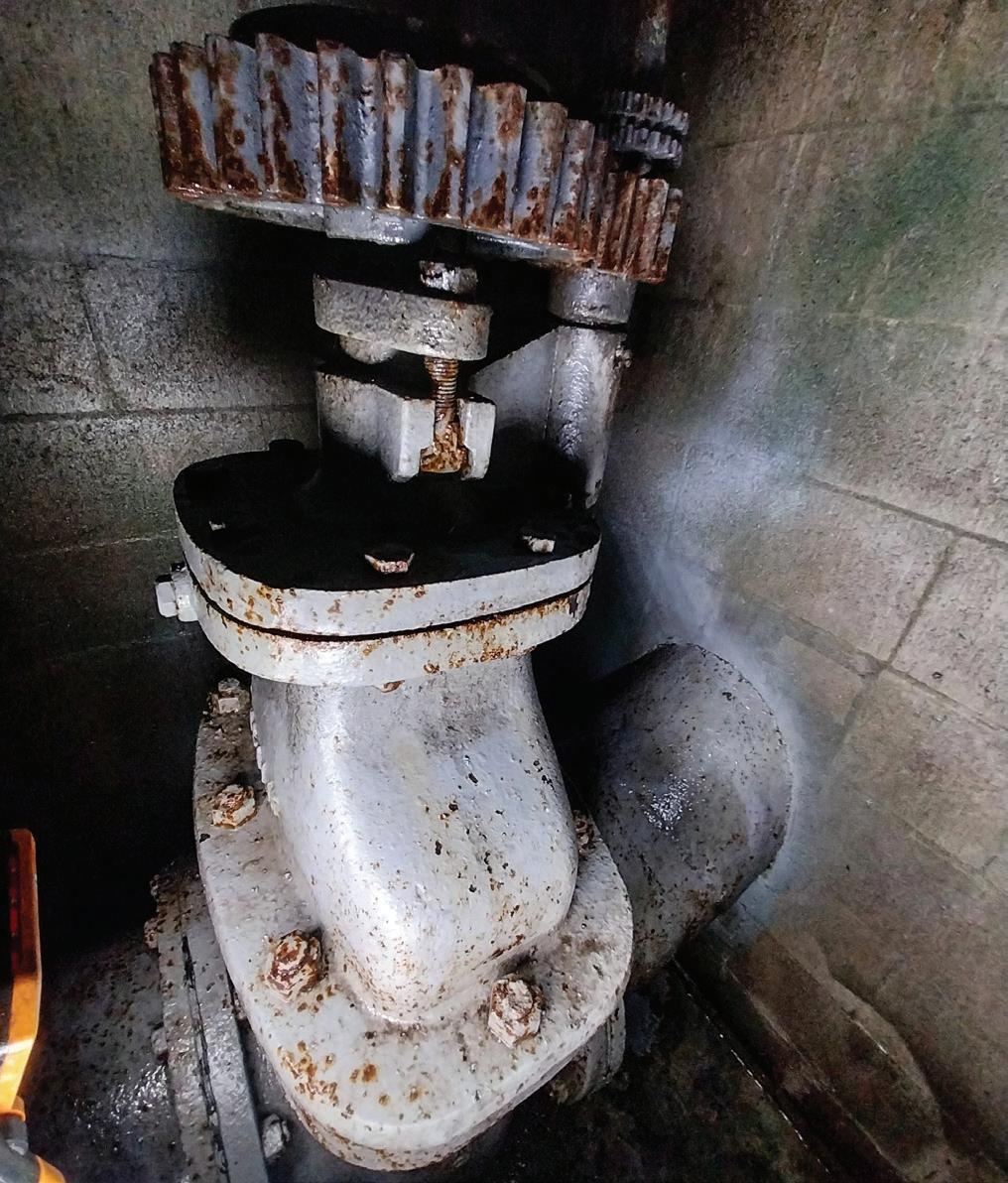
to be near end-of-life are shown to be structurally sound after 80 years, because the assumptions simply didn’t fit local conditions.”
A new approach to asset confidence
Christopher advocates for a more direct approach: If the condition of a critical asset is uncertain, measure it.
That message underpins the work of the IPS Alliance, particularly partner ProjectMax’s contribution to the New Zealand Pressure Pipe Inspection Manual Rev 1 for Water New Zealand, developed by ProjectMax and WRC with collaboration from multiple councils.
“The manual gives councils a structured framework for evaluating their asset condition knowledge, deciding where to test, how to test, and how to interpret what they find. It helps avoid the two extremes: Replacing assets that don’t need it, or having high-risk assets fail because the data wasn’t accurate enough to support intervention.”
That assessment doesn’t rely on a single test. IPS teams use a range of physical and chemical investigations such as coupon sampling, transient pressure monitoring, ultrasonic wall
thickness scanning, and local soil or water chemistry analysis to build a complete picture of an asset’s real-world condition.
In high-criticality networks like wastewater rising mains, IPS has used under-pressure tapping (UPT) to safely extract 84mm core samples from live pipes without service interruption. One such programme for a major utility revealed that an asbestos cement pipe, originally flagged for renewal, had a lower than average deterioration rate and no immediate risk factors, delaying costly replacement by at least a decade.
Another project, currently underway in a neighbouring location, involves sampling multiple points along a 1960s reinforced concrete pressure main. The inspection includes corrosion analysis, chloride and carbonation depth measurements, and ongoing monitoring of internal pressure transients.
“Every sample gives the asset owner another level of confidence. The more we measure, the better we can match capital investment to actual need.”
Climate implications for infrastructure
Few water networks were designed with today’s climate in mind. Rising water tables, saline intrusion, soil shrinkage and seismic variability now overlay legacy systems that assumed stable longterm performance.
This is especially important for materials like steel, asbestos cement, and reinforced concrete, all of which are sensitive to environmental and chemical stressors.
“A pipe that looks the same on the as-built may have experienced completely different loading, chemistry or corrosion depending on where it’s buried.”
IPS sampling has shown clear regional differences even within the same asset type. Pipes exposed to marine environments, or installed in reactive clay soils, can degrade significantly faster

than those in stable inland conditions, even when laid to identical specifications.
Three practical steps for climate-aligned asset management
1. Map asset climate exposure. Use council or NIWA climate overlays to identify buried assets in zones exposed to flood, salinity, or temperature extremes. Prioritise inspection efforts in these areas.
2. Use test-based renewal triggers. Replace age-based triggers with verified indicators such as loss of wall thickness, internal coating failure, or aggressive wastewater chemistry to inform renewal plans.
3. Integrate condition data into future modelling. Feed results of condition testing into capital planning tools. Updating assumptions based on real-world findings ensures long-term strategies remain adaptive and cost-effective.
From reactive to strategic
Christopher says the shift to measured condition assessment won’t solve every problem. But it does allow councils to spend more wisely, replacing what needs replacing, and maintaining what still has safe service life.
“Unplanned failure will always cost more than planned renewal. Condition assessment helps avoid emergency works, service outages, and reputational risk. In a climate-stressed environment, that matters more than ever.”
He emphasises that condition assessment is not just a technical task but a strategic one.
“It’s about confidence. Confidence in the asset, confidence in your planning, and confidence investing ratepayer funds in the right place at the right time.”

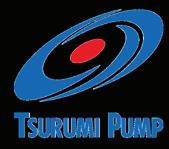


Submersible Smashing Cutter Pump

Innovation under pressure
Auckland Council’s Healthy Waters team has turned a major infrastructure emergency into a milestone in sustainable engineering, with the successful rebuild of the Greville Road stormwater culvert, right beneath one of Auckland’s busiest roads.
When severe storms hit in early 2023, part of the stormwater culvert under Greville Road collapsed. This vital link to the Northern Motorway carries around 19,000 vehicles each day, and urgent work was needed to protect the road’s structural integrity and restore safe stormwater flow.
But this wasn’t just a patch-up job.
Auckland Council’s general manager healthy waters Craig McIlroy says the team’s focus from day one was not just repair, but resilience.
“This project moved beyond temporary, quick-fix solutions,” says Craig. “It delivered a robust and sustainable system designed to manage larger stormwater flows and support the growing needs of the Albany area.
“And the team achieved incredible results under emergency conditions, while not further disturbing the community.”
The project, which ran from December 2023 to May 2025, cost $19.6 million and was fully funded through Auckland Council’s Healthy Waters capital budget. Despite the complexity of laying a 275-metre pipeline near a historic landfill, the job came in under budget at $1.4 million for key components and delivered environmental benefits well beyond expectations.
One of the most innovative aspects was the use of low-carbon concrete pipes, a first for this size of stormwater infrastructure in Auckland. This reduced emissions by 16 percent, cutting over 60 tonnes of CO₂.
Efficiency and sustainability went hand in hand. The team reused equipment from other projects, including a 2.1 metre tunnel boring machine from the Ports of Auckland. Concrete waste and aggregates were also recycled or reused, keeping over 95 percent of waste out of landfill.
During tunnelling, 650,000 litres of stormwater were reused onsite, eliminating 22 heavy vehicle trips to landfill and saving more than 360 kg of CO₂. Even solar-powered monitoring systems –saving over $1 million and avoiding the emissions that come with manufacturing new machinery – were deployed, cutting reliance on diesel generators.
The environmental benefits of the Greville Road project will continue long after the last pipe is laid including 7000 native trees that are being planted along the site to control erosion, improve habitats, and contribute to Auckland’s Urban Ngahere Strategy –a city-wide effort to restore the urban forest.
The project was delivered in collaboration with McConnell Dowell, Hynds, AWA Environmental, and local planting teams including Wai Ora Partnerships.
“This is the kind of forward-thinking infrastructure work Aucklanders should be proud of,” Craig says. “It shows that even in emergency conditions, we can deliver sustainable, future-ready solutions.”
Article provided by Auckland Council.



Tasman Tanks has set the benchmark in designing, fabricating, and constructing bolted steel tanks and reservoirs across New Zealand, Australia, and the Pacific for 30 years.
Our liner and non-liner tanks have consistently delivered three decades of trusted, lowmaintenance performance and reliability all backed by Tasman’s proven expertise and our dedicated team.


TS600 Liner Tanks – Proven liner life exceeding 20 years, providing one of the most costeffective, durable, and reliable storage solutions, engineered with full seismic compliance.
TS700 Non-Liner Tanks – The same Tasman quality and reliability, for clients requiring nonliner options, available in Lean Duplex, Stainless Steel, Glass Fused to Steel, or Fusion Bonded Epoxy.
Additional Solutions – A complete range of Rectangular Tanks and Galvanized Dairy Effluent Tanks.

We look forward to seeing you at Stand 110 - Water New Zealand Conference and Expo

Tasman Turnkey Solutions – Engineered for Quality, Built for Reliability.

Making water, sanitation, and hygiene more inclusive
In Timor-Leste, access to safe water and sanitation remains an ongoing challenge, especially in rural areas, where close to 20 percent of the population lacks basic water services, and more than 50 percent lack access to basic sanitation.
The impacts of climate change, including prolonged droughts, heatwaves and flooding, have already affected many rural communities and continue to exacerbate existing challenges, placing additional pressure on fragile water, sanitation and hygiene systems.
Women and other vulnerable groups often face more barriers accessing water and sanitation services due to entrenched gender roles, discriminatory social norms, and limited inclusion in decision-making processes.
Women and girls are primarily responsible for collecting water and maintaining household hygiene, but climate related weather hazards, inadequate storage facilities and reliance on small containers often force them to make repeated trips to water sources. This added burden can prevent girls from attending school and places extra strain on women, especially those caring for young children.
Despite playing a central role in household water management, women often have limited roles in public decision-making processes related to water, sanitation and hygiene. Men are typically recognised as heads of households and are more likely to participate in community meetings, training sessions and planning activities.
Under the national water policy, rural communities manage these services through Water User Groups (GMFs), which promote local ownership, however women often require permission or formal invitations to participate.
While women’s roles in these structures have been improving, they are still limited by traditional gender norms. In Manufahi and Liquiçá Municipalities, 41 percent of GMFs had women in leadership positions. However, women’s participation is predominantly concentrated in the role of treasurer, a position commonly perceived as more suitable for women, as it is considered easier to manage.
This demonstrates how ongoing gender stereotypes limit women to certain roles and overlook their potential as leaders. When women’s voices and perspectives are excluded, water, sanitation and hygiene programmes miss out on valuable input that’s needed for fair and lasting solutions, especially as climate challenges grow.
To help break down these barriers, WaterAid worked with local authorities and Rights-Holder Organisations (RHO) in Timor-Leste to take a structured approach to gender and social inclusion in water, sanitation and hygiene.
Together, they built evidence, strengthened local capacity and embedded gender equality, disability and social inclusion principles into planning processes to tackle the root causes of social exclusion.
A scoping study was conducted to explore how gender inequality and other forms of marginalisation affect access to water, sanitation and hygiene in a changing climate.
When working with communities to map climate risks, WaterAid and partners looked at how these risks affect different groups

including women, men, people with disabilities, older adults and other marginalised people in different ways.
The process looked at factors like gender roles, access to resources and decision-making power to better understand the specific challenges and strengths of different community members.
These insights were important for guiding efforts to embed gender equality, disability, and social inclusion throughout the project, especially in local planning.
Local authorities and RHOs used the evidence to strengthen gender equality, disability and social inclusion outcomes in municipal water, sanitation and hygiene planning. It directly informed the revision of key tools and plans, including climate hazard mapping profiles, municipal water, sanitation and hygiene plans and the role of women and people with disabilities in planning.
A notable improvement was the revision of the Community Scorecard approaches and indicators, which now include indicators to measure women’s participation in community meetings and decision-making within GMFs, as well as the application of universal design principles for inclusive water, sanitation and hygiene infrastructure.
As a result, six villages in both Manufahi and Liquiçá developed action plans that included steps to improve disability inclusion and promote women’s leadership in water, sanitation, and hygiene governance. This work also led to the appointment of gender focal points in every administrative post, who were actively engaged in planning.
To make sure the changes would last, the project focused on embedding gender equality, disability and social inclusion knowledge and tools into the entire water, sanitation and hygiene system. A reference guide was created to show how local gender equality, disability and social inclusion tools can be used in planning, budgeting, service delivery and monitoring.





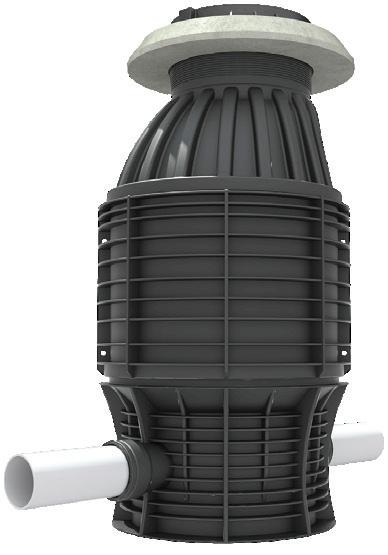




Training sessions helped build skills in using the tools, and regular learning sessions with key staff at the municipal level supported ongoing use and a shared understanding of gender equality, disability and social inclusion.
In conclusion, gender awareness sessions at the community level played a key role in shifting attitudes toward shared household responsibilities. Follow-up monitoring showed these sessions not only sparked open conversations about gender norms, but also led to early signs of more equal sharing of household waterrelated tasks, highlighting the potential for lasting change when communities are meaningfully engaged.
Article provided by WaterAid.












